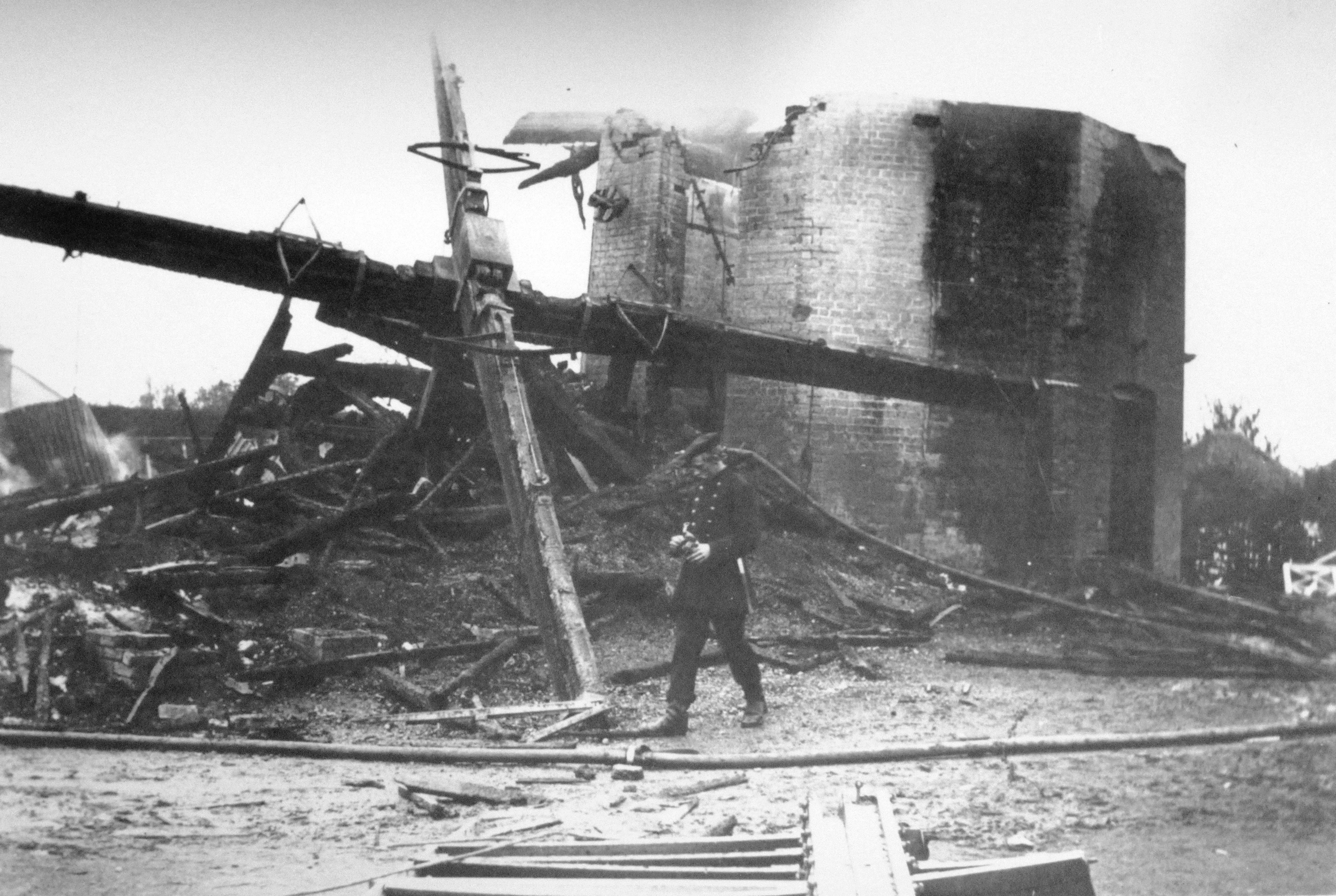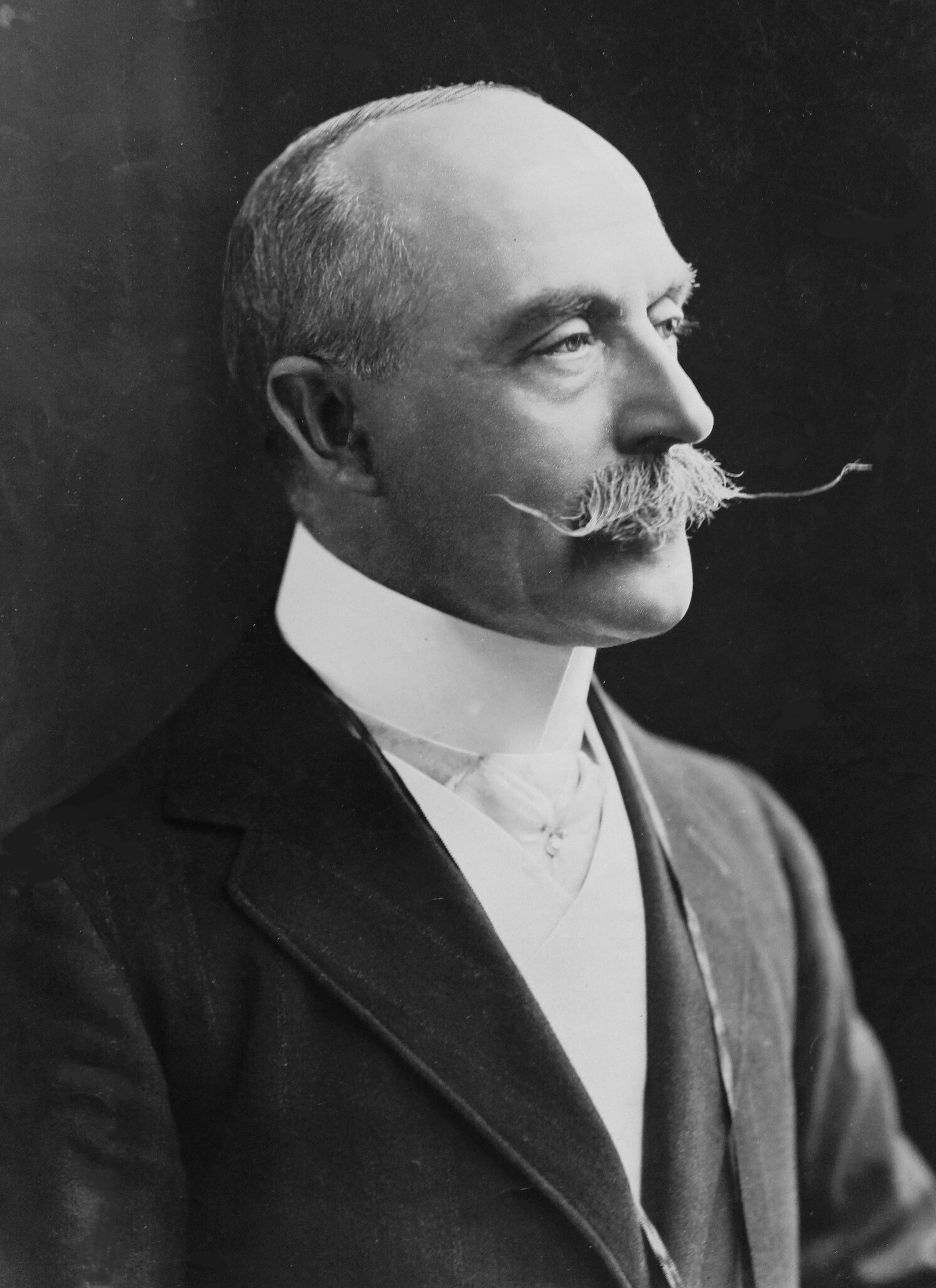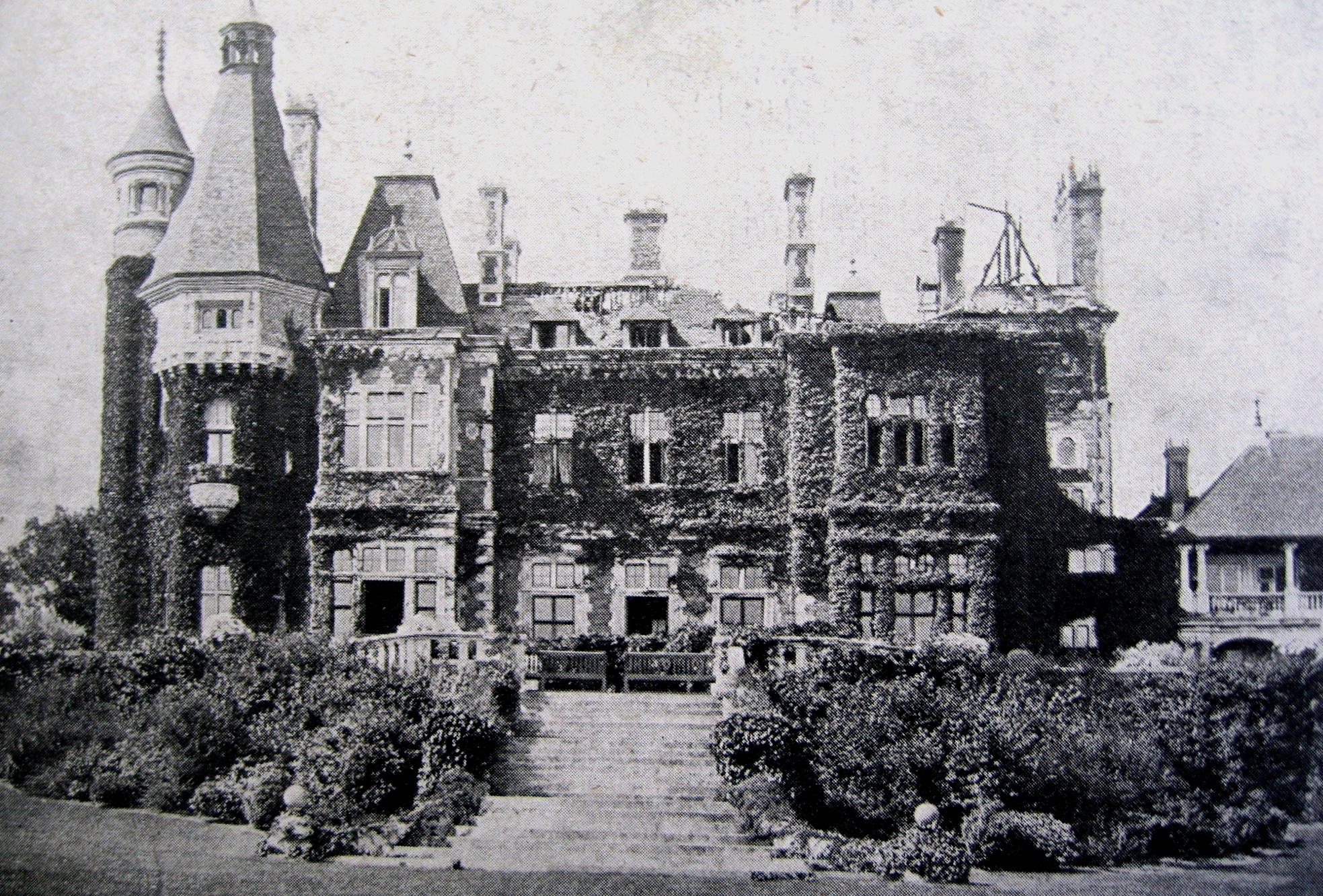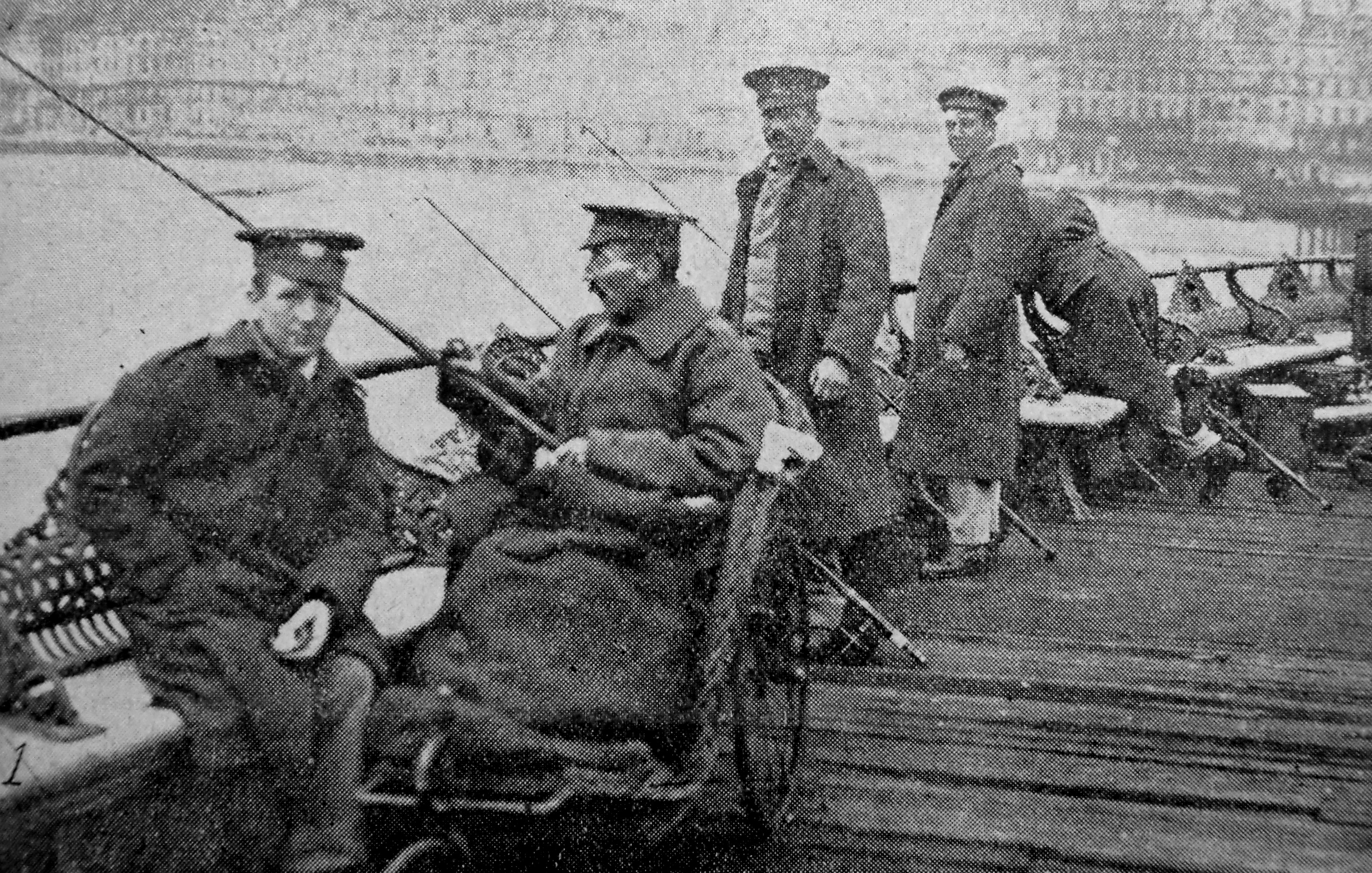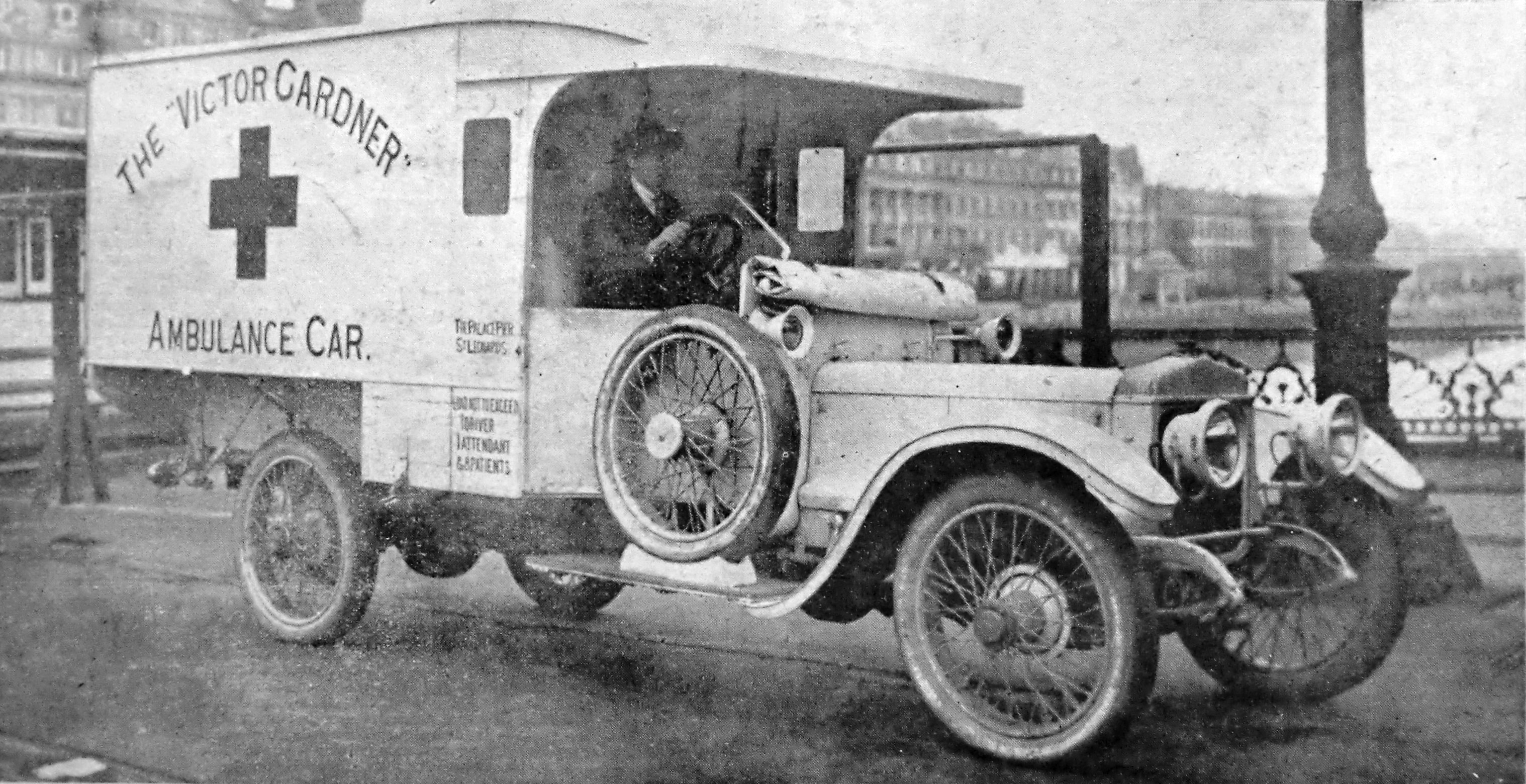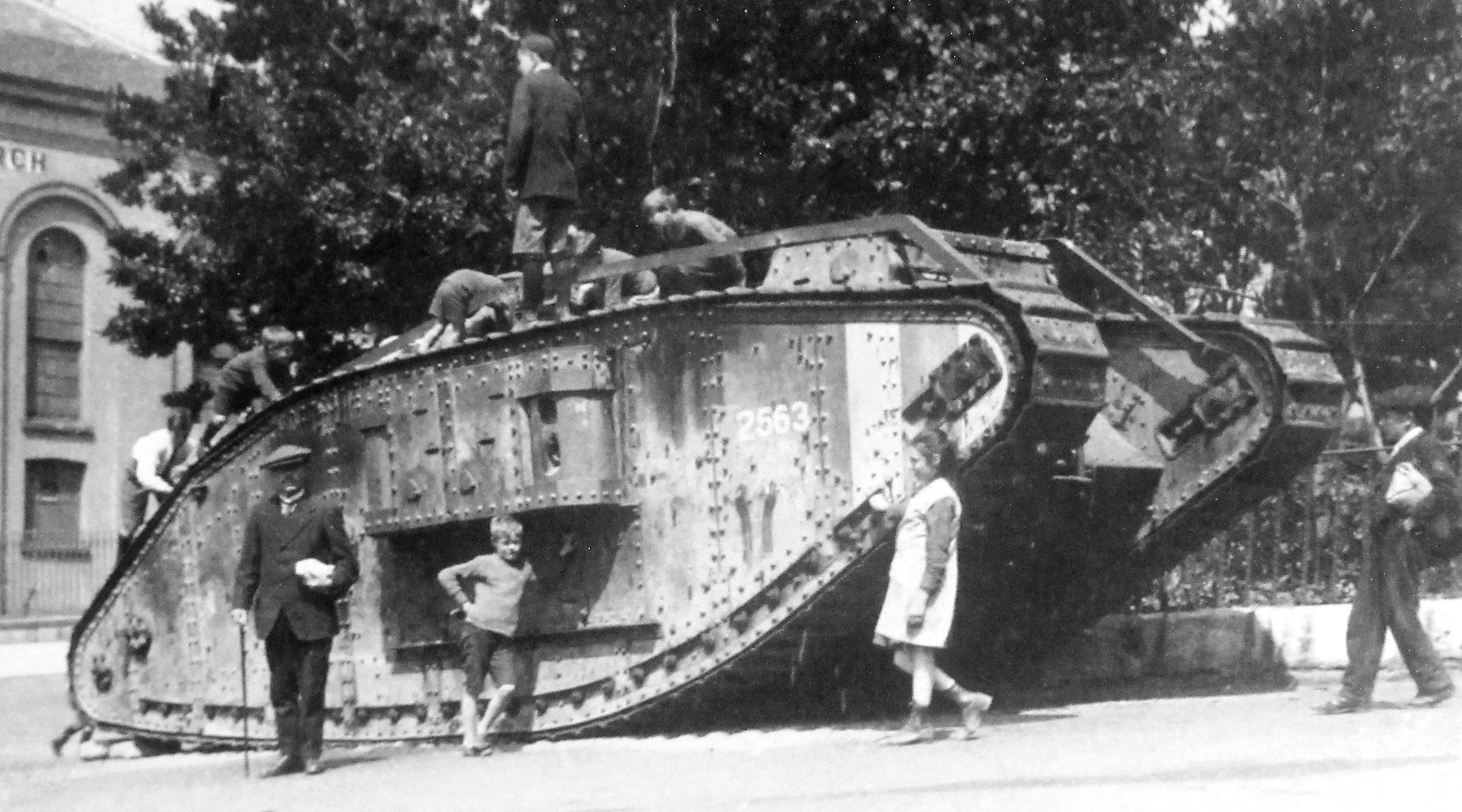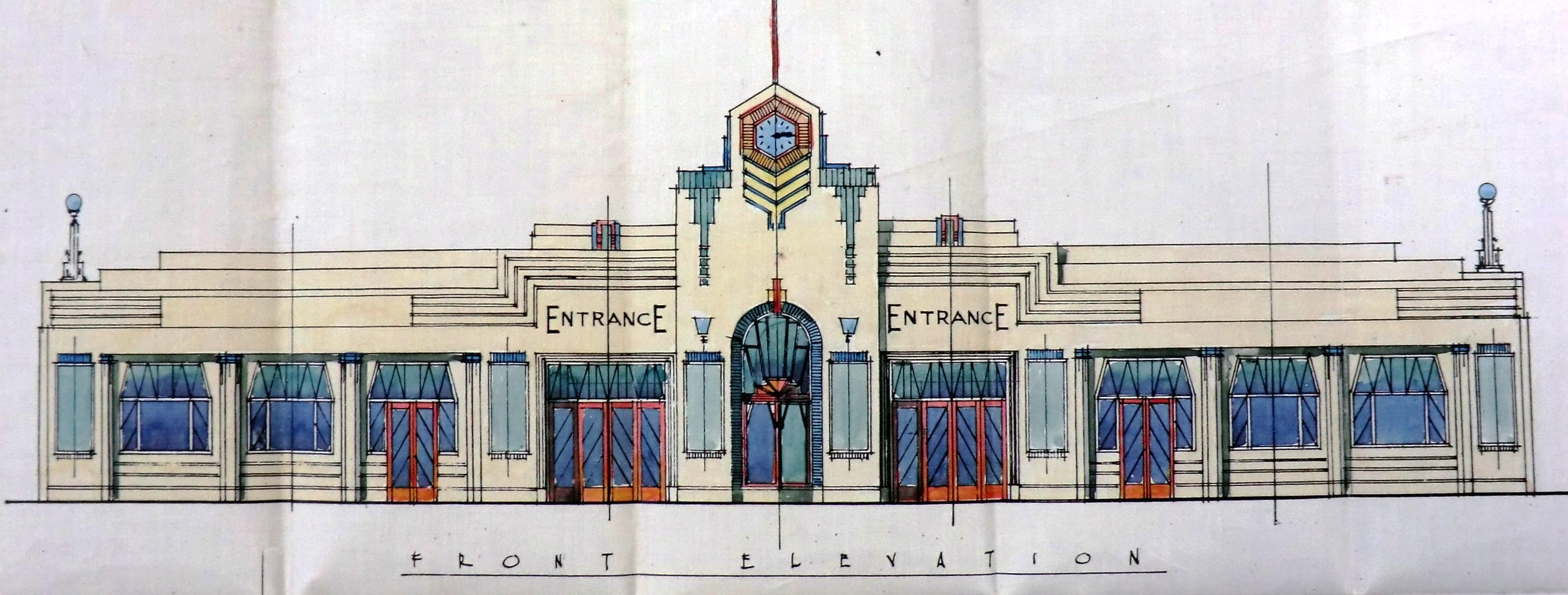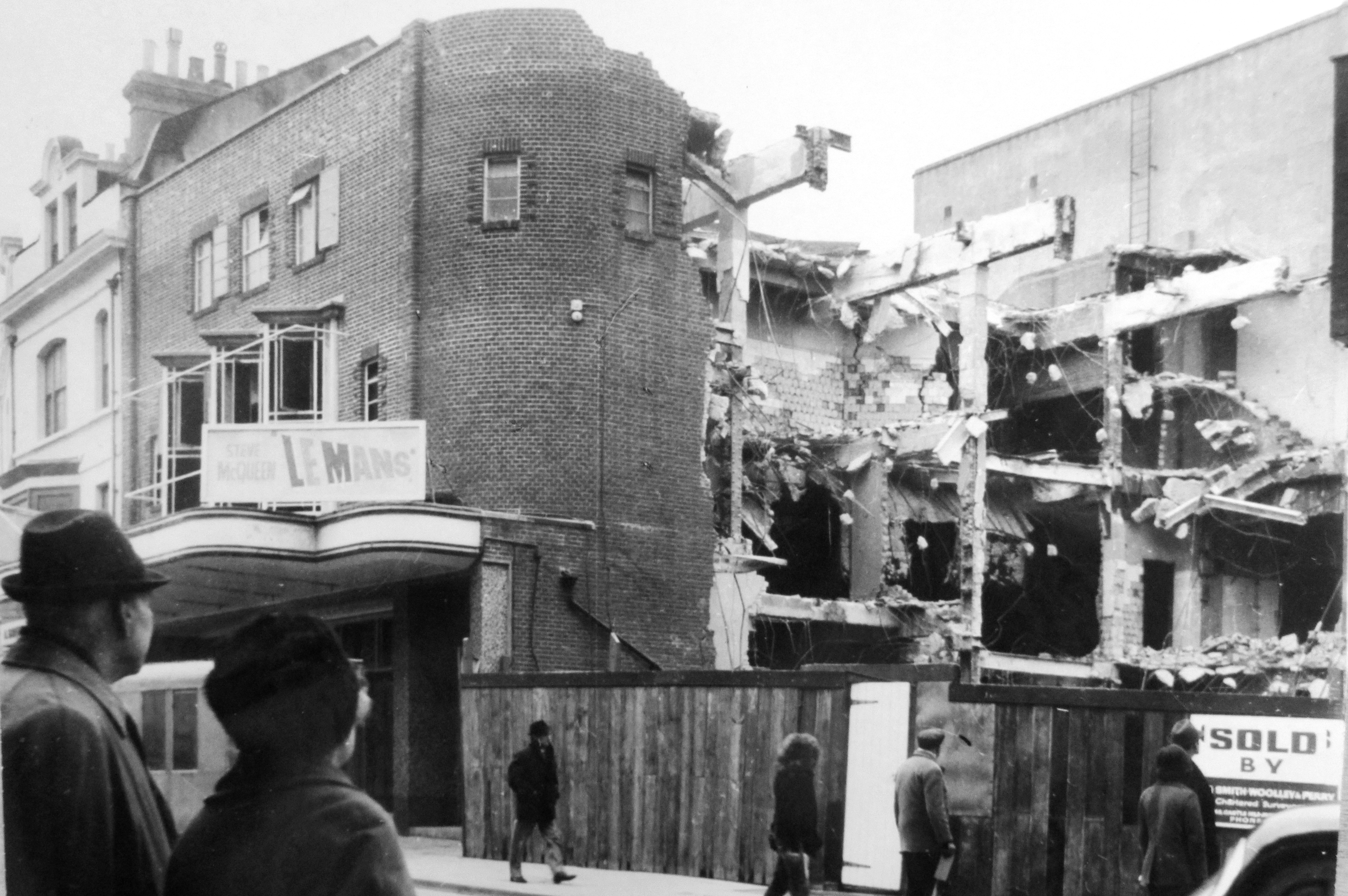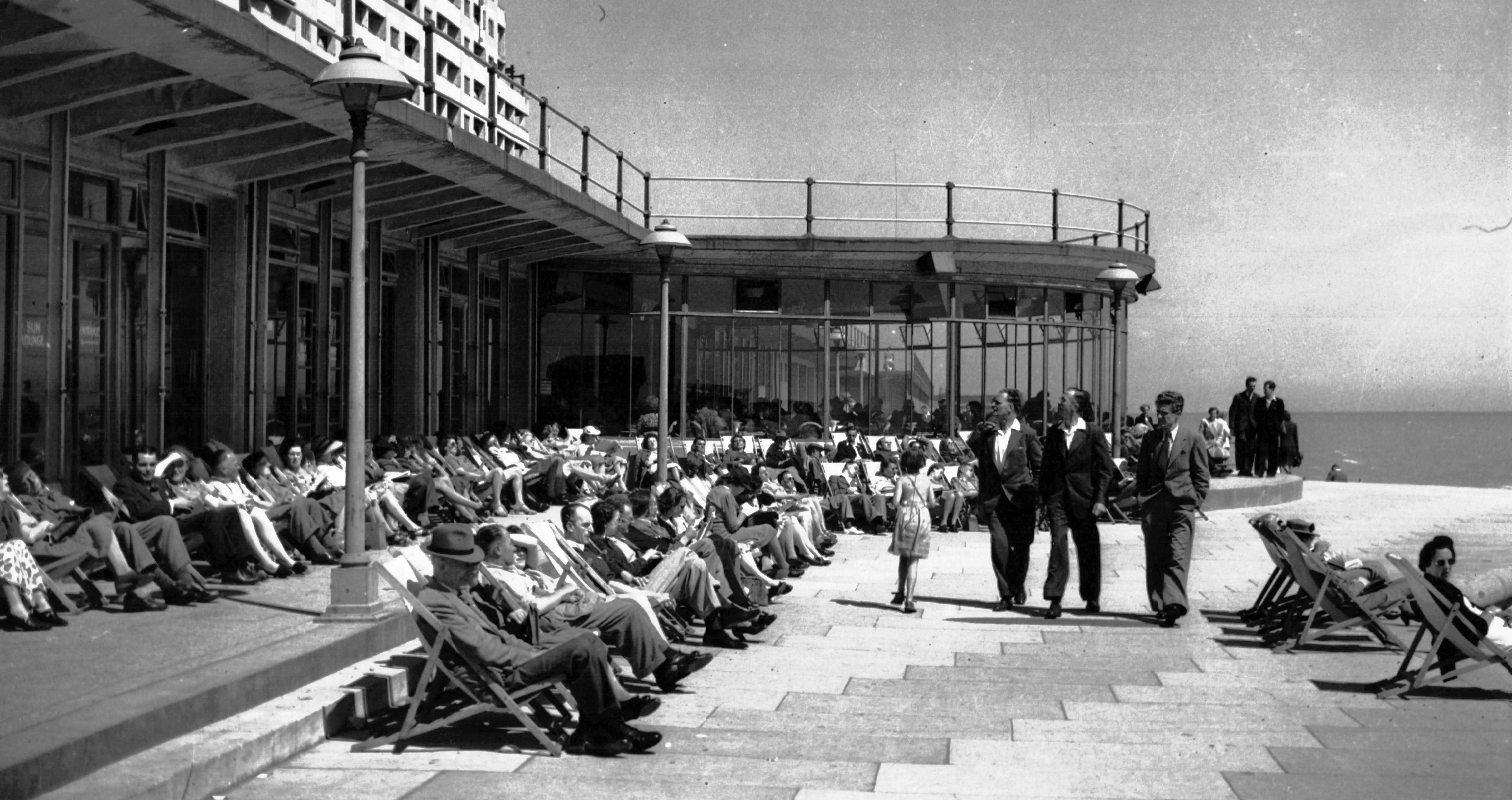1900-1949
1900 Jan 21 - Death of Frederick Parsons, aged 55, who had turned the Hastings Observer into the most influential newspaper in the town from the 1870s onwards. He was born in Rye on 6 October 1844, the eldest son of Isaac Parsons, a newspaper proprietor and printer. In 1864 Frederick moved to Hastings where his father had started publishing the weekly Hastings Herald in 1861. The Observer was bought from its founder Mr JH Knight in 1866 and merged with the Herald, being called the Observer from 1873. Over the following years he created a big business, centred in Hastings, but with ramifications extending along the south-east coast. When he died, he owned the newspaper and the large printing and stationery business in Claremont, and was director of many other companies, including the Albany Hotel (of which he was chairman), Skinners, the Hastings Bus Company, the Electric Light Company and the Steamboat Company. He was 'an orthodox Conservative' and freemason. He lived at Cumberland House, Laton Road, next door to Blacklands Church.
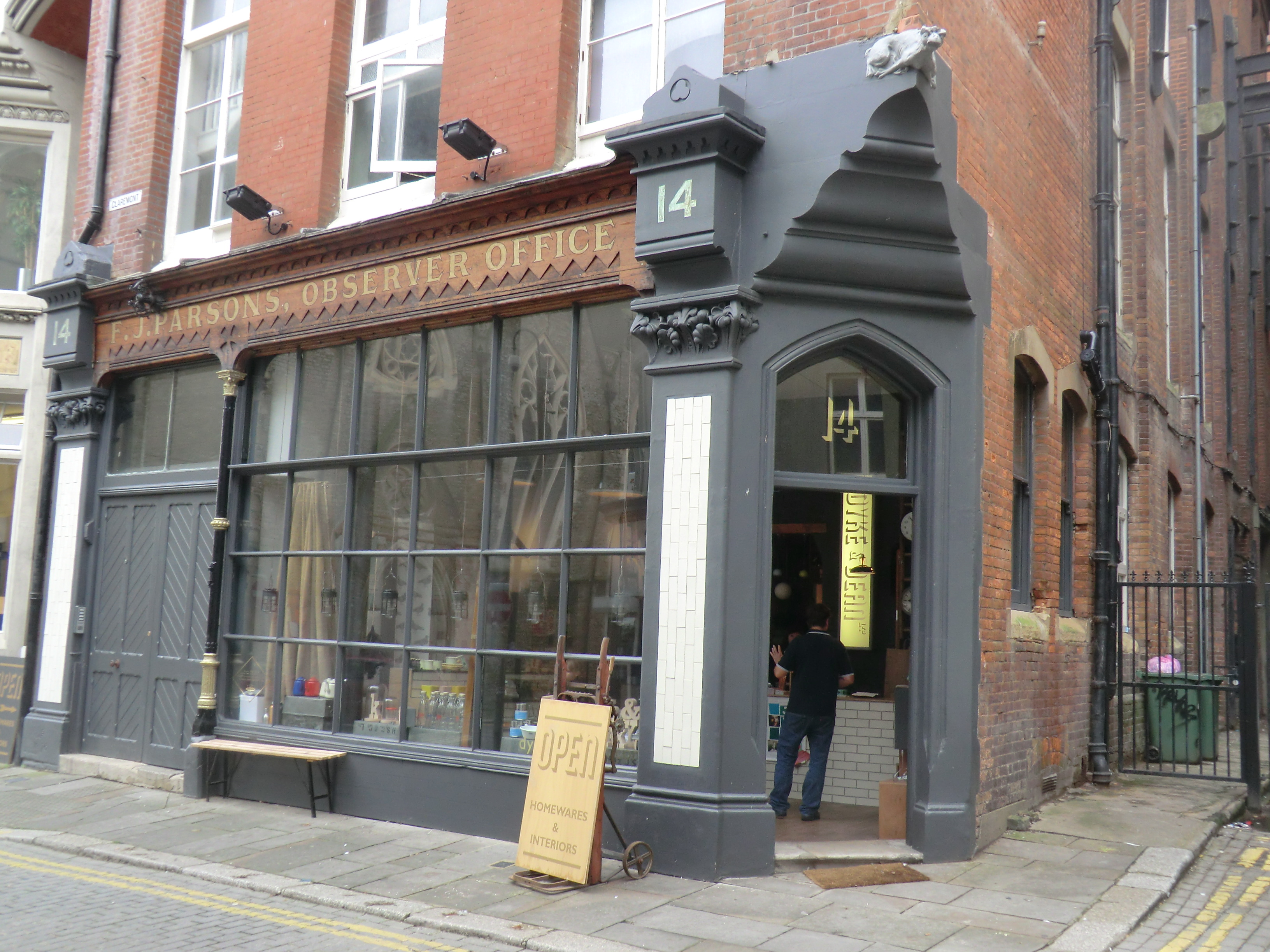
14 Claremont, the headquarters of the businesses run by Frederick Parsons.
1900 Jan 22 - Hastings Council advertised for people to apply for licences 'to run two motor cars to be ready for plying for hire by Easter next'. The cars had to be built in such a way as to comply with the regulations of the Locomotives on Highways Act 1896. These were to be the first Hastings taxis. The first two started work that Easter. On 28 June 1901 the Council agreed to allow more than two cars to have licences.
1900 Jan 27 - The Observer of this date reported that the Council had given the Grammar School £1,000 towards the cost of creating a laboratory for science. This followed correspondence between the Charity Commissioners and the Magdalen and Lasher charities which owned the school. The Observer asked why this had been so delayed. Almost from its inception the Grammar School had been short of funds. In its early years there was a 'strong prejudice' against the school because of its association with charities, and this feeling had not yet disappeared. Until recent years 'a considerable number of Hastings parents fought shy of the school on social grounds'.
1900 March 21 - Death of Joseph Tendall, born 1840, owner of the Hastings News, at his home, 144 Marina. The News said: 'From a humble beginning Mr Tendall by sheer industry and perseverance fought his way to the forefront amongst local men and gained and enjoyed the esteem of a very wide circle of his fellow townsmen.' He was born in 1840, went to Halton National School and Parker’s Endowed School (predecessor of the Grammar School). At 13 he became an office boy for the Hastings Chronicle, at 28 Robertson Street. He had bought the pro-Liberal News in 1872, doubling its size and cutting its price. The News was always the main rival of the Observer.
1900 April 14 - Norman Road Methodist Chapel burnt down.
1900 April 23 - The annual meeting of the Lord’s Day Observance Society was held in Central Hall, Bank Buildings. There were many complaints about the failure to observe the Sabbath across the town. There was 'wholesale desecration' by 'steamboats plying for hire, wagonettes running, the public houses and tobacconists’ shops open', plus fishing, amusements, exhibitions etc. The annual report said: 'The work of our society during the past year has been of an arduous nature, with very little visible result.' The society applied pressure to the Council, but with minor results.
The White Mill burnt down.
1900 May 16 - The White Mill, the smock windmill on the Ridge close to Winchelsea Road, was burnt down in a spectacular blaze. It had been a well-known landmark. It was not rebuilt. The base has survived and has been roofed in; it is next to Sandown School.
1900 July - The Hastings Tramways Company was set up, following the passing of the Hastings Tramways Act in this month. The act authorised routes in Hastings and St Leonards with overhead power lines. Another act in 1903 authorised routes to and from Bexhill, but not with overhead lines along the seafront, and this was to cause major technical difficulties for many years. There was also considerable disagreement about how the system would be built, and by whom, which concluded in 1904, and a new company, the Hastings and District Tramways Company. was set up. Construction began in December 1904.
1900 July 6 - The Ice House, the new ice-making plant in Rock-a-Nore Road, was opened. It was the first of its type in the Hastings area, making large blocks of ice for many sectors of the food trade, including fishing. It was demolished in 2007 and replaced by a much larger block of flats and other uses.
1900 Aug 16 - Fisherman William Button was drowned when catching whelks near St Leonards Pier, leaving a widow and five children.
1900 Oct 2 - In the general election, the Liberal, Freeman Freeman-Thomas won, with 3,399 votes against Conservative Edward Boyle’s 3,191, a majority of 209. Born 1866, the ex-cricket captain for Eton College had married Marie Adelaide, daughter of Baron Thomas Brassey (1836–1918) in 1892. At the 1906 general election he lost his Hastings seat, but soon won a by-election for Bodmin.
1900 Nov 30 - The News of this date reported that famous local gymnastic instructor Alfred Moss, of 31 Devonshire Road, appeared before the Bankruptcy Court, as did WT Makey and William Arnold, drapers of Norman Road, St Leonards. Photos of Moss, wearing only a few tight-fitting clothes, often appeared in many places.
1901 - The St Leonards Golf Club was set up, with an 18-hole course at Filsham Valley. It was taken over for the war effort in the First World War, resulting in the loss of nine holes on the west side, but these were re-instated in 1922. Hastings Council took over the course after the Second World War, and it was closed in 1960, with the land being used for housing.
1901 Jan 2 - The recently-formed Anchor Musical and Charitable Society gave tea to 600 poor children the Market Hall, George Street. They were given bread, butter and jam; mixed sweet and plum cakes; and tea. Musicians from the Empire Theatre on the seafront played music. 'It was a touching sight of so many poor children enjoying themselves to their hearts content.' Tickets had been given out 'irrespective of the political or religious creed of their parents'. As they left, each child was given a bag containing an orange, nuts, cake and sweets. The Mail of 5 January hoped other people would follow the example: 'As we have often pointed out, the amount of poverty in the town is appalling, and the distress amongst the working classes is acute.'
1901 Jan 7 - Opening of the new St Helens Mixed and Infants Schools, opposite the cemetery on the Ridge. It was set up here because of the growth of the district. The old Infants School at St Helens was transferred to the new building. In 1912 it was redeveloped as Hastings Secondary School for Girls, and became the Hastings High School for Girls in 1929. From 1940-43 the school was evacuated to Ware in Hertfordshire and the building was used as an ATC drill hall and a community feeding centre. The original school buildings were demolished in 1967. The existing premises are part of what used to be called Helenswood School.
1901 March - A large new bread factory, said to be the biggest for miles around, opened at 10 Earl Street.
1901 March 13 - Winston Churchill MP, correspondent for the Morning Post during the Boer War, gave two lectures at the Royal Concert Hall, Warrior Gardens, on 'How I Saw the War'. It was illustrated by limelight views. He stayed at the Grand Hotel.
1901 March 15 - The Council agreed there should be a new bandstand for the White Rock Baths Promenade, to replace the existing disgraceful structure, which was too small. The cost would be £248, which some councillors felt to be mean. The new bandstand was completed on 17 July, and the old one was put up in Alexandra Park in mid-August.
1901 May 6 - A new volunteer riflemen’s rifle range opened in Warren Glen. The site was provided on long lease at a nominal rent by the Rev WC Sayer-Milward. The firing points were on the west side of the valley, facing due north at two targets standing in front of a high bank. The point for the longest range (600 yards) was only a few yards over the bank by Lovers Seat, while the 200 yard point was considerably raised, forming the roof of a magazine and store. The site was almost that of what had been an artillery range. The Ecclesbourne Glen rifle range had become crowded.
1901 May 15 - A public meeting on Housing the Working Classes was held at Central Hall, Bank Buildings, organised by the Hastings District Housing Council. There was poor attendance. Clem Edwards spoke about the large number of empty houses in Hastings, mainly of a higher rental than the working classes could pay. There was overcrowding in Hastings. He urged the Council to adopt part III of the 1890 Housing Act and provide artisan dwellings. Mr Lamb, a painter, described his close acquaintance with some of the 'filthy dens' in which working people were obliged to live. Following that meeting, the News of 23 May reported that a councillor had described several houses in the eastern wards where half a dozen families were living in one tenement. The News said there was little doubt about the terribly crowded state of many tenements in the Borough. 'The stupendous difficulty is how to deal with the question in a place like this, where the rents are very high and land for new habitations is decidedly scarce. When the tram lines run round the suburbs a practical difficulty will probably be removed, for the Corporation might secure land on the outskirts, at its present agricultural value.'
1901 June 5 - The new Norman Road Wesleyan Church was dedicated; the previous one, on the same site, having burnt down in 1900.
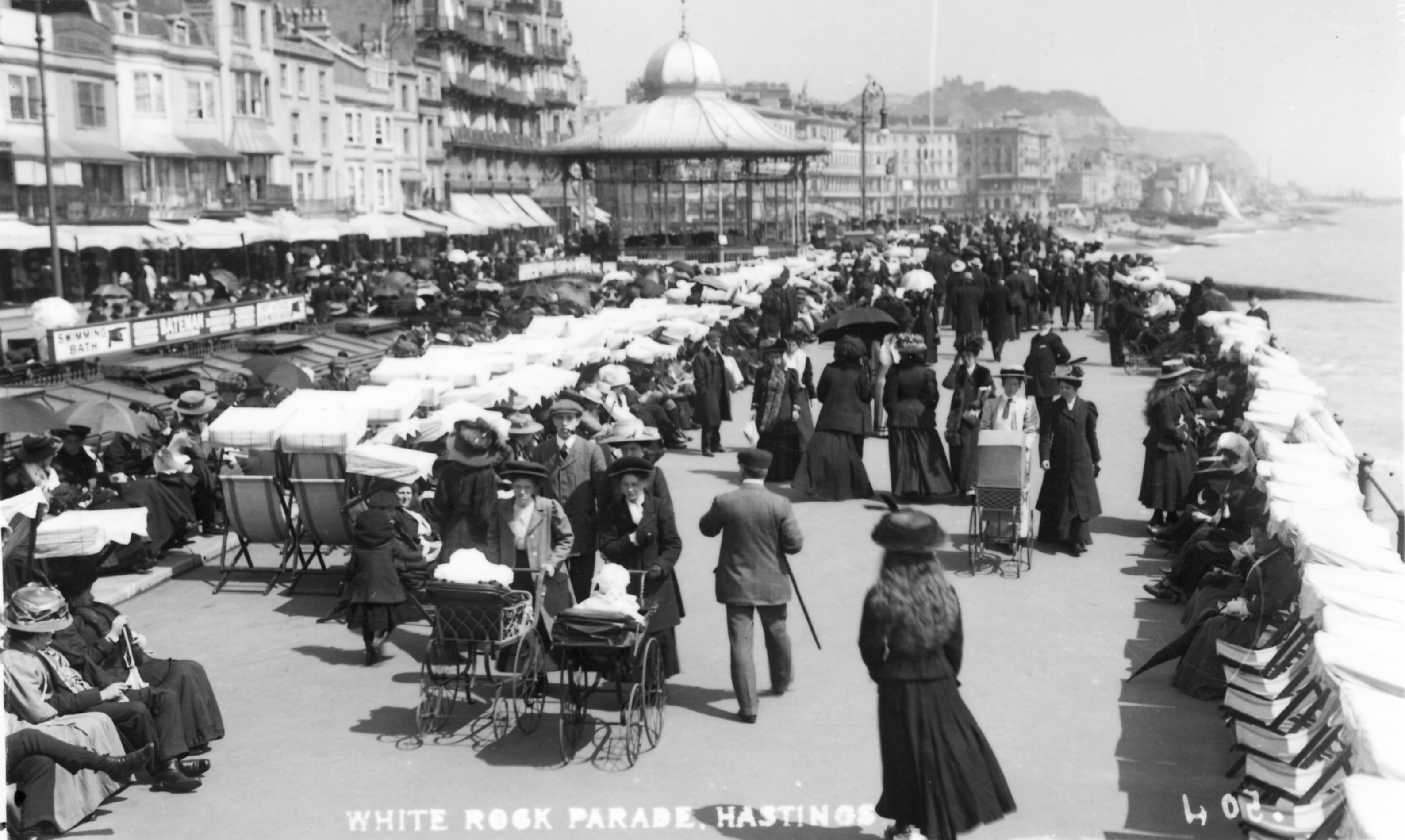
The new bandstand at White Rock.
1901 June 21 - The News of this date reported that the removal of the 'dilapidated and discarded' White Rock bandstand to the Marina in St Leonards had aroused great indignation. But the new bandstand was completed at White Rock on Wednesday 17 July, and it was considered to be an ornament to the Front. The old bandstand was moved to Alexandra Park on Wednesday 14 August, with the move taking place at 4 am to avoid disturbances. The News of 23 August said that there had been an alleged plot to burn the old bandstand if it had stayed at Marina. It had been repainted by the end of September.
1901 June 28 - The News of this date reported that the 1901 census showed the inhabited houses of Hastings at 11,429 and the population at 65,528, an increase of 3.9% since 1891.
1901 July 8 - The Council on 8 July discussed the Harbour question in detail. Its history was outlined by the News. The Commissioners had failed to raise the money needed to complete it, despite their most extraordinary exertions with financiers and the Public Works Loan Commissioners. The limited guarantee was insufficient security for the advance of the money. Their only course now was to make a new application for a perpetual guarantee to the Council, but the motion was defeated, 11 votes to nine. Cllr Chesterfield called the whole enterprise a deception. But they agreed to consider the advisability of the Council taking over the concern. The unopposed Act of Parliament cost the ratepayers about £800 and contained a provision under which the Council could take it over. In the debate strong words were said against the whole scheme and everyone connected with it.
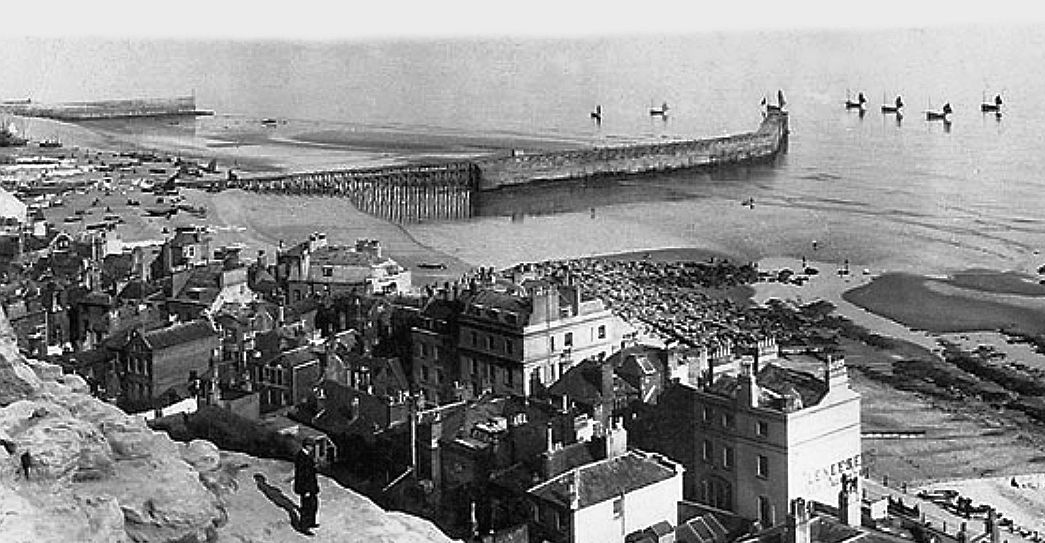
The harbour in 1901, when construction had stopped.
1901 July 22 - The 14-year old Hastings and St Leonards Co-operative Society went into liquidation. It had been running its Co-operative Stores at 41-42 Salisbury Road, Bohemia, since late 1889. For many years this had been successful, and it still had 275 members, but by late 1901 trade had fallen away, partly because of rival neighbouring shops.
1901 Sept 9 - Mrs W Slade spoke on women’s suffrage at the Central Hall, Bank Buildings.
1901 Sept 11 - The foundation stone for the new Mission Hall at Halton was laid by Mr Beck of Hastings and Ald Kemp of Lewes. It opened in February 1902.
1901 Sept 27 - The News of this date reported that gold was found in George Street. Some 500 gold coins, chiefly George III sovereigns, were discovered during some alterations at 56 George Street. Two workmen, Mr Brunton and Mr Poole, found them in some old sacking. They came to the knowledge of the authorities when they were presented to a local bank. An inquest later declared them treasure trove.
1901 Oct 11 - The new Hastings lifeboat, the Charles Arkcoll II, took over from the 20-year old Charles Arkcoll. She was an open rowing boat with sails, but no engine, and 35 feet long, with a beam of eight feet six inches. The cost for her was paid from the remainder of the £2,000 legacy from Charles Arkcoll. Her normal crew was 13. She was replaced by the engine-driven Cyril and Lilian Bishop in April 1931, having been launched 25 times, saving 28 lives.
1901 Oct 18 - Hastings Council gave planning permission for Mr GT Kellog-Jenkins to build 110 houses on the Halton House estate which he had bought in December 1900. The estate had been 'a desolate and dreary waste for some time' (cf 1895). The Observer of 22 December 1900 said that the houses would be low rent, and aimed at 'artisans'. They 'will be admirably suited for acquisition by artisans under clauses of the Housing of the Working Classes Act 1890 ... and will be of great advantage to the working classes generally. It will, indeed form quite a model colony.' Work began in late 1901 and by mid-1902 houses were to let in the new roads Rotherfield Avenue and Hardwicke Road. The plans for laying out this estate had been approved on 7 June 1895, and since then the roads had been shaped and kerbed, and sewers laid.
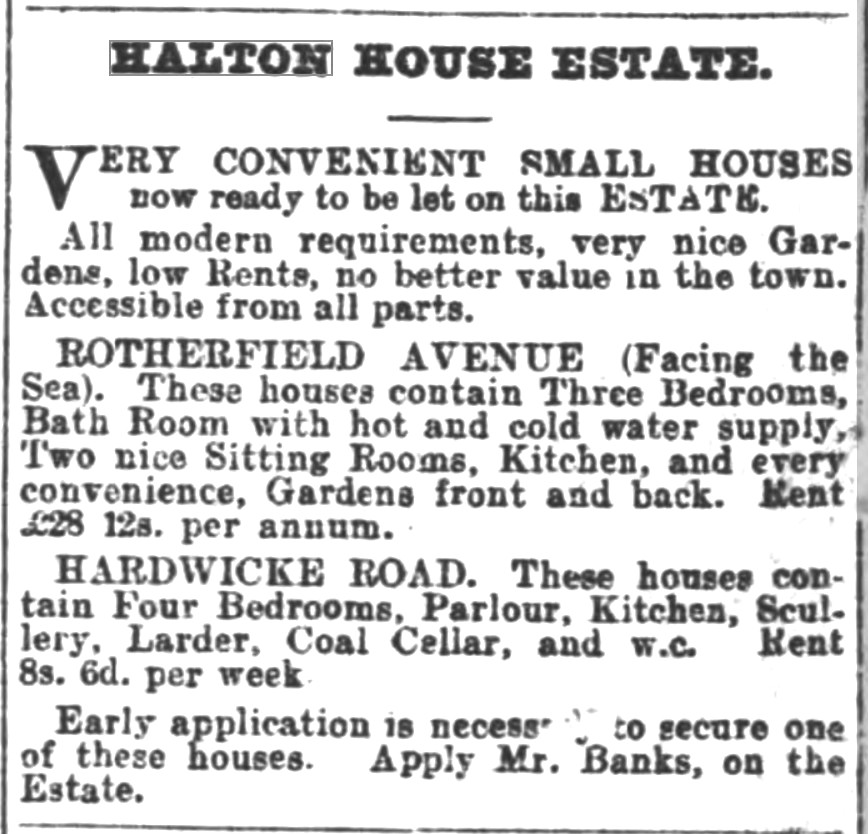
An advert in the Hastings Observer of 2 August 1902.
1901 Nov 1 - The News of this date reported that there was talk of ugly predictions for the prospects of the local working classes during the coming winter, with 'visions of relief funds and soup kitchens'. The News said many artisans were out of work, with 'painters, as usual, being the chief sufferers'. A fortnight later, the News of 15 November reported that there were already signs of distress amongst the labouring people of Ore. Last winter between eleven and twelve thousand dinners were given to poor children attending Ore Board Schools and it was now feeding several hundred little ones a day.
1901 Dec 6 - The first public meeting of the newly formed St Leonards Public Interests Association took place, presided over by local architect Mr CA Pigott. It’s duty was to consider if trams were in the interest of St Leonards. The St Leonards roads were said to be in a disgraceful condition, and Hastings Council was St Leonards’ most deadly enemy.
1901 Dec 12 - The large new underground public toilets in Harold Place opened for business.
1901 Late - Robert Tressell (1870-1911), the future author of the highly influential working class novel The Ragged Trousered Philanthropists, arrived in Hastings, which he was to make the setting of his book, which was published in 1914. He was a painter and decorator, and had to come to Hastings from South Africa with his young daughter Kathleen, who he had to support. They lived first at 1 Plynlimmon Road, then 115 Milward Road until about 1906. He worked for about a year with builders Bruce & Co in York Place, then for for undertakers and painters Burton & Co in Stonefield Road. In 1906 he went to work for builders Adams & Jarrett in Norman Road, and soon after went to live in a flat at 241 London Road. It was while living and working in St Leonards, from c1906-1909, that he wrote most of the book, much of which is set in large St Leonards houses. The full story of Tressell and his book are in the book Mugsborough Revisited which can be read elsewhere on this website.
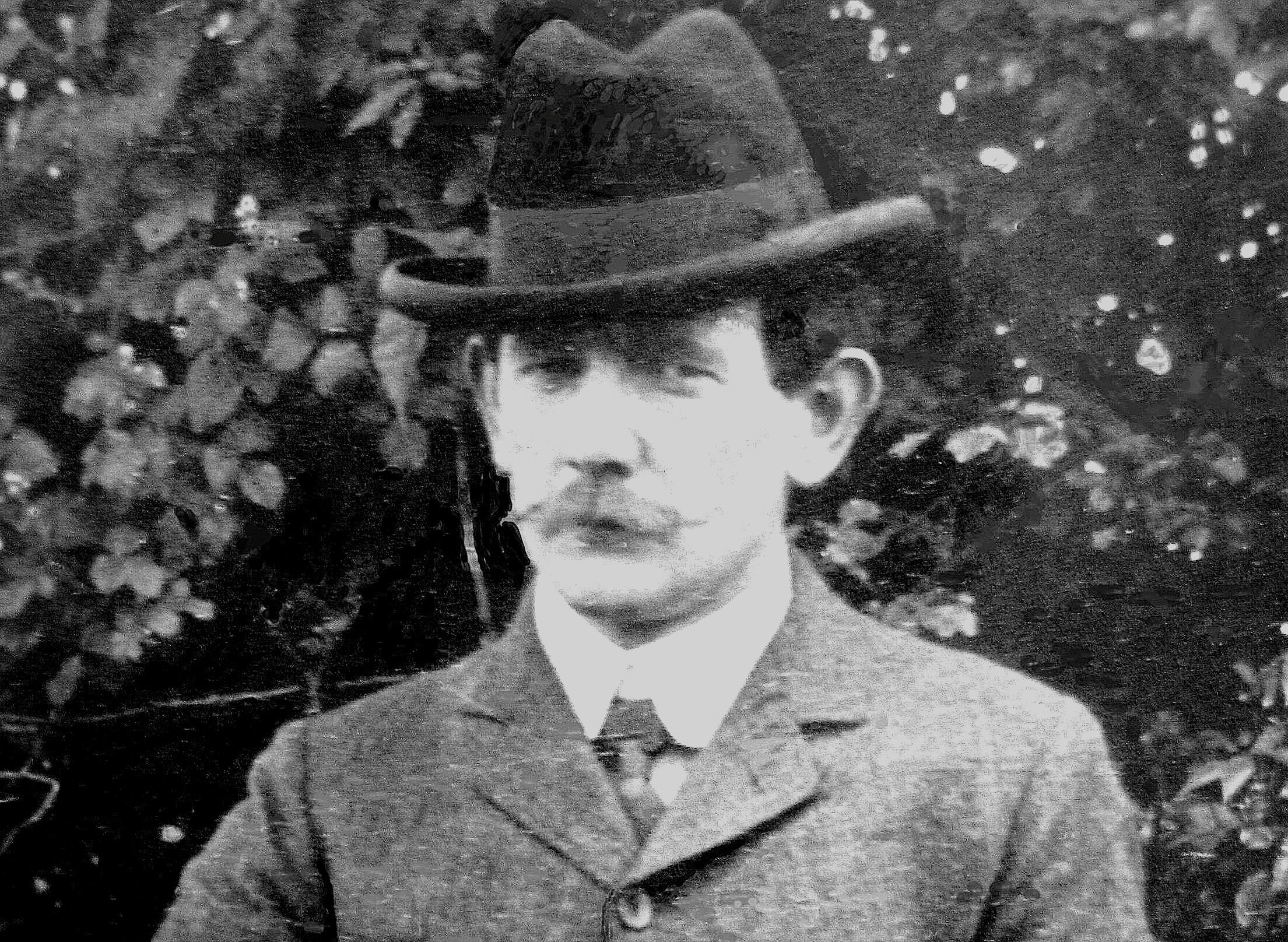
Robert Tressell.
1902 - Fred Judge, aged 29, moved to Hastings from Wakefield, and set up what was to become his world-famous postcard business, initially at 21a Wellington Place. Probably the first of his c60,000 different cards showed the storm of 10-11 September 1903. In 1905 he moved to larger premises at 42 White Rock, recently Marriotts Photo Stores, which closed in 2022,
1902 - The Hastings District Nursing Association was formed to supply nurses to poorer people. It was based at 2 Halloway Place, at the bottom of Old London Road, with a branch in St Leonards.
1902 Early - Hastings Golf Club gave up the use of the six holes on the public portion of the East Hill. Six new holes were made off Barley Lane so that the whole course was then on private ground. The new 18 hole course opened on 18 May 1902.
1902 Feb 1 - The annual meeting of the Charity Organisation Society heard that the number of applications for assistance more than doubled in 1901 compared with 1900 – up from 612 to 1,291. Aid was given in 808 cases, nearly twice 1900. Spending was £454 14s on aid and £161 15s on admin (36% of total spending), £100 of that being the secretary’s salary. Mr LH Elford, the secretary, denied that 'too much is spent on office expenses'. The society handed out 736 bread and grocery orders, 77 coal orders, 85 nourishment orders, 29 railway fares, 17 items of clothing and 31 pairs of boots. A member said the figures showed 'there was a great deal of distress in Hastings and St Leonards'.
1902 Feb 26 - The Friendly Societies held a parade of members and supporters to aid the societies at present helping to feed the unemployed in the borough. Started at 7pm, going through the Old Town, along the seafront to London Road, down East Ascent, then back to Wellington Square. Unfortunately there was heavy rain. Collected £18 14s 2d.
1902 March 8 - Poultry rearing had become a new industry for Hastings, said the Hastings Mail. A 'thriving poultry farm' at the Hawkwood Poultry Farm was started a year ago in Hollington by Mr Eliot Schneider 'who is determined to create an industry in home-grown birds and English eggs'. The birds 'are looked after with a care that is well-nigh fatherly. … In such ways are the birds cared for, and treated more as living creatures than unfeeling objects, as is too often the case.' [The house Hawkwood is now 11 Upper Glen Road.]
1902 March 8 - The Liberal League held a major rally in the Royal Concert Hall, off Warrior Square, to hear a speech by Mr Herbert Asquith. The hall was filled to overflowing.
1902 May 31 - The new railway line linking Bexhill to the Hastings-Charing Cross line at Crowhurst opened. The four and a half mile track ran from Crowhurst via a massive 17-arch brick viaduct across the Crowhurst Marshes to a station at Sidley and then to the new Bexhill West station. This new line was separate from the Hastings-to-Brighton Bexhill station and line because of the intense rivalry between the owners of the Brighton and Charing Cross lines. The new Crowhurst railway service gave Bexhill faster trains to London, turning the town into a desirable residence for commuters, and thereby adding to the prosperity of the town in the coming decades. The siting of the Bexhill West station opened up that area of the town for development. The closure of the Crowhurst line in June 1964, a victim of the Beeching axe, did much damage to Bexhill, losing its role as a commuter town and turning it into more of a rest home for the aged. It was demolished in 1969.
1902 July 18 - A Council meeting was informed that the Eversfleld Estate bordering on the north side of Alexandra Park’s Shornden Reservoir and Harmers Reservoirs was to be developed for building. [This was the Beaufort Road area.] The estate’s surveyor had asked the Council to fence off all that part of the park from the estate, and to build a road connecting Park Road with the east end of the main Harmers Reservoir [today an unmade access area], which was to connect there with a new road [never built] running along that park northern boundary to Silverhill. These had all been part of original leases and convenants with the estate, of 1877/8. The Council agreed to go-ahead.
1902 July 18 - In the Divorce Court, the Countess de la Warr was granted a decree nisi for the desertion and misconduct of her husband, the Earl, with an actress named Miss Turner. In court were the Countess’s father Lord Brassey, Mr Freeman-Thomas MP and Mrs Freeman-Thomas (another daughter of Lord Brassey). 'Counsel stated that notwithstanding the Earl’s infidelity before 1898, the Countess generously stood by him and assisted him with money in his financial troubles in connection with Mr Hooley.' In September 1901 he had written an apology. But in Christmas week Miss Turner was brought to the Bexhill theatre which was under the Earl’s control, and it was that outrageous matter that had brought the case to court.
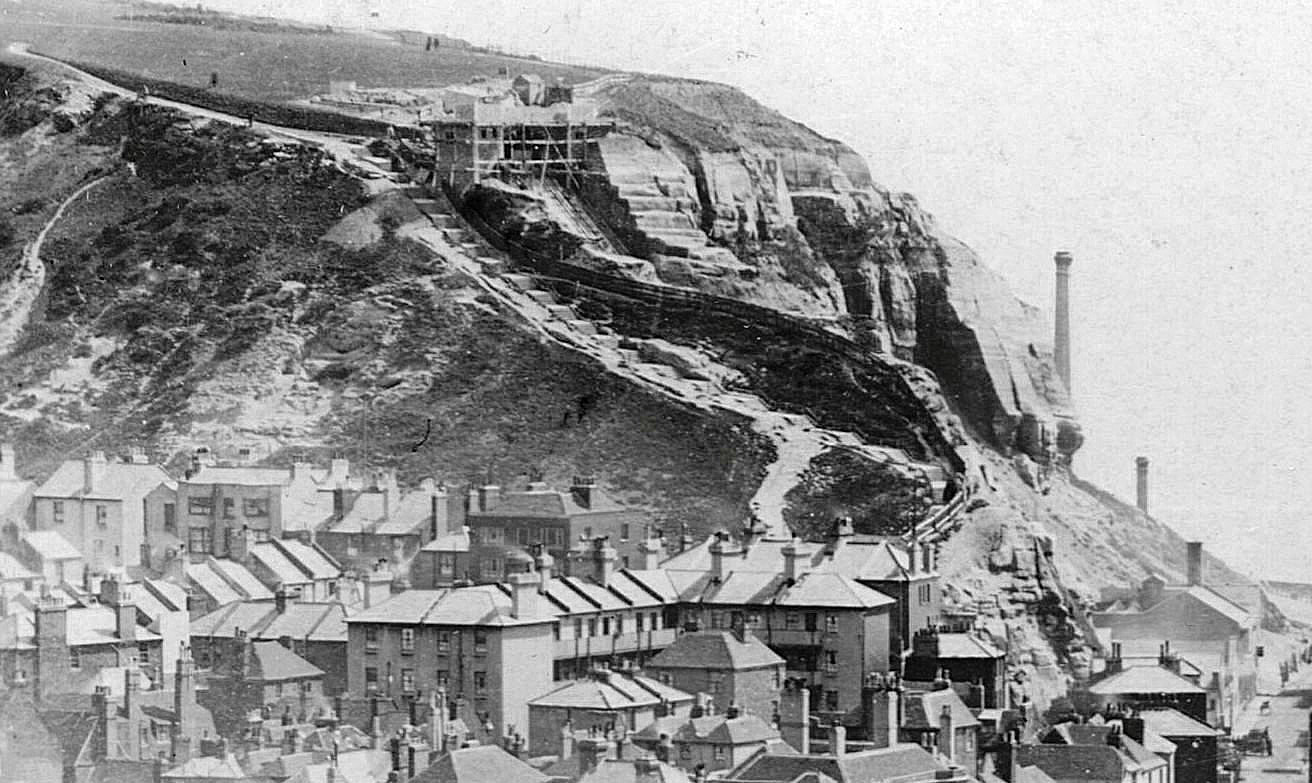
The East Hill Lift being built in 1902.
1902 Aug 10 - The new East Hill Lift opened to the public. The Council had given it the go-ahead in February 1901, saying it would rise 148 feet vertically, with its rails covering 258 feet, at a gradient of 1 in 1.66. It would be run by water balance, with the pumping fuelled by the Dust Destructor at Rock-a-Nore. It would run beside the steps going up from Tackleway. The cars would hold 20 people and would take a minute and a half to run. The total cost would be £5,100. The landowner, the Rev WC Sayer-Milward, had been generous over the matter. Some councillors doubted that it would pay for itself. Others wanted it not to run on Sundays for religious reasons, although that would be its busiest day. Human bones were found during the lift's excavations. On 22 September 1902 there was a serious accident when the two carriages failed to stop because of the failure of the braking system. Thirteen people were hurt. The lift was then closed until re-opening on 9 April 1903, then taking 41,000 passengers in the first 16 weeks.
1902 Aug 19 - Death of Maurice Sarsfield Walsh JP, editor of the Hastings Observer in its early years. He died at his home, 4 St Helens Terrace, aged 59. 'He was a power in the local Conservative world, and many of the triumphs of that Party in Hastings have been attributed to his influence.'
1902 Oct 1 - The Holy Trinity parish hall opened.
1902 Oct 2 - The Council decided to purchase the 6½ acres of Alexandra Park nearest Queens Road from the Rev Sayer Milward for £1,800. This land was then being held on lease for 56 years, at a rent of £35 pa.
1902 Oct 25 - The Weekly Mail of this date reported that the Financial Times had commented on the still unresolved Harbour project. It said the works had about as much chance of developing into a respectable harbour as the few people who had already subscribed for bonds had of getting their money back. Even if the work were ever finished, accommodation could only be afforded for fishing boats and shallow draught steamers for trippers, so to imagine the venture would ever be a commercial success was to dream the vainest of vain dreams.
1902 Nov 1 - The Weekly Mail of this date reported that a new association was formed to protect the interest of dogs. The Canine Association for Hastings and St Leonards and East Sussex was inaugurated at the office of accountant Mr Ernest E Fox, 37 Havelock Road.
1902 Nov 13 - A Hastings lifeboat inquiry was held regarding the failure to launch on Saturday 8 November. It had been deemed impossible to launch because of the heavy sea and a wind ‘dead on’ the shore. It was an error of the coxswain in not taking the boat to Bopeep to attempt to launch it there. The inquiry decided to appeal to the Parent Society to provide a slipway or a convenience at one of the Piers.
1902 Dec 6 - The Weekly Mail of this date reported that there was a heavy fall of of snow on 4 December. 'Winter, in all its sternness, is upon us now. Throughout Kent and Sussex – to go no further – farm and building work has been suspended. … In Hastings the snow was several inches thick in some parts. … Accounts of poverty and necessity reach us from every side.' The treasurer of the Ore Relief Fund said 'there is a great amount of distress and sickness in Ore just now'. The Mail printed a letter from G Gilbert Muir, pastor of Wesley Church, Bourne Street, on the alarming state of the Old Town: 'It is heart rending to be in the position in which I am placed as minister of the poorest congregation in Hastings, face to face with those who are at the door of starvation, and yet to be unable to help except to the smallest possible extent. I insert no plea for the indolent poor, my church is no resting place for worthless vagrants whose poverty is the result of their inherent and continuous disinclination for work. I plead only for those who are in desperate circumstances of need through no fault of their own; their worthiness is beyond all dispute. There are members of my congregation whose sole income, and that is from the parish, is four shillings per week; two and sixpence goes in rent and the remainder is ALL that is left for light, firing and food. I have reason to believe that all over Hastings there is a desperate amount of poverty made no easier by the frantic efforts to keep up appearances, but let it be remembered that in Old Hastings the only appearance which is kept up is that which corresponds to the grim reality of poverty and hunger. At this moment I am visiting those who are sick; the doctors urge nourishment; they might as well urge the Moon.'
1902 Dec 13 - The Weekly Mail of this date reported that 'the widespread poverty and suffering which the present period of severe weather is entailing' brought together the religious denominations of Hollington, Silverhill and Bohemia at a meeting on 8 December. They set up an overall committee, split into three districts. They would not give out money but tickets for coals, groceries, meat etc, and they had already opened three soup kitchens. Not for seven or eight years has the scarcity of work been so deplorable as within the past few months. On the West Hill, the Rev Sholto Newan (Emmanuel Church) said his parish was 'very large and poor, and the distress and illness at the present time was terrible'.
1902 Dec 30 - The Empire Theatre laid on a 'colossal' Christmas dinner for the poor, reported the Weekly Mail. Over 600 people crowded into the Drill Hall in Middle Street. 'The menu consisted of roast beef, roast mutton, cabbage, sprouts, carrots, turnips, potatoes and plum pudding to be washed down by ginger beer, lemonade and beer.' After this there was a 'first-rate musical programme'. On 1st January Mr Griffiths, the theatre manager, arranged for over a thousand quarts to soup to be given out from the Hall. 'It was a sight that will not soon be forgotten to see the faces of the eager youngsters who crowded round the hall, some with bedroom water jugs, others with garden cans.'
1902 Dec 31 - Following the death of Queen Victoria in 1901, a bronze statue of her as she looked at the time of her 1887 jubilee was unveiled in Warrior Square. It is still there, with a Second World War bullet hole from a German bomber in the front skirt, knee height.
1903 Jan-Feb - Hastings Council decided to split Sedlescombe Road into Sedlescombe Road South and Sedlescombe Road North, as they are today. Also: Park Road became Lower Park Road and Upper Park Road; Castle Road and Castle Hill became Castle Hill Road; Union Street became part of Courthouse Street.
1903 Jan 13 - Hastings fishermen were entertained as guests of Mrs Freeman-Thomas at the Market Hall, George Street. The 400 fishermen and their wives were invited to a substantial meat tea. The large banner of the Hastings Fishermen's Society was hung up.
1903 March 2 - During three hours, just over an inch and a third of rain fell, with the fall for the complete day being 1.62 inches. 'With such an extraordinary downpour it is only to be expected that extraordinary scenes were witnessed.' Sewers soon filled up and many parts of the town saw flooding from out of the drains. Filthy water poured into many houses, especially in upper Queens Road and Stonefield Road. Priory Street was worst hit, with four feet of water. The Cricket Ground looked like a large lake. 'The storm was practically unprecedented in Hastings.'
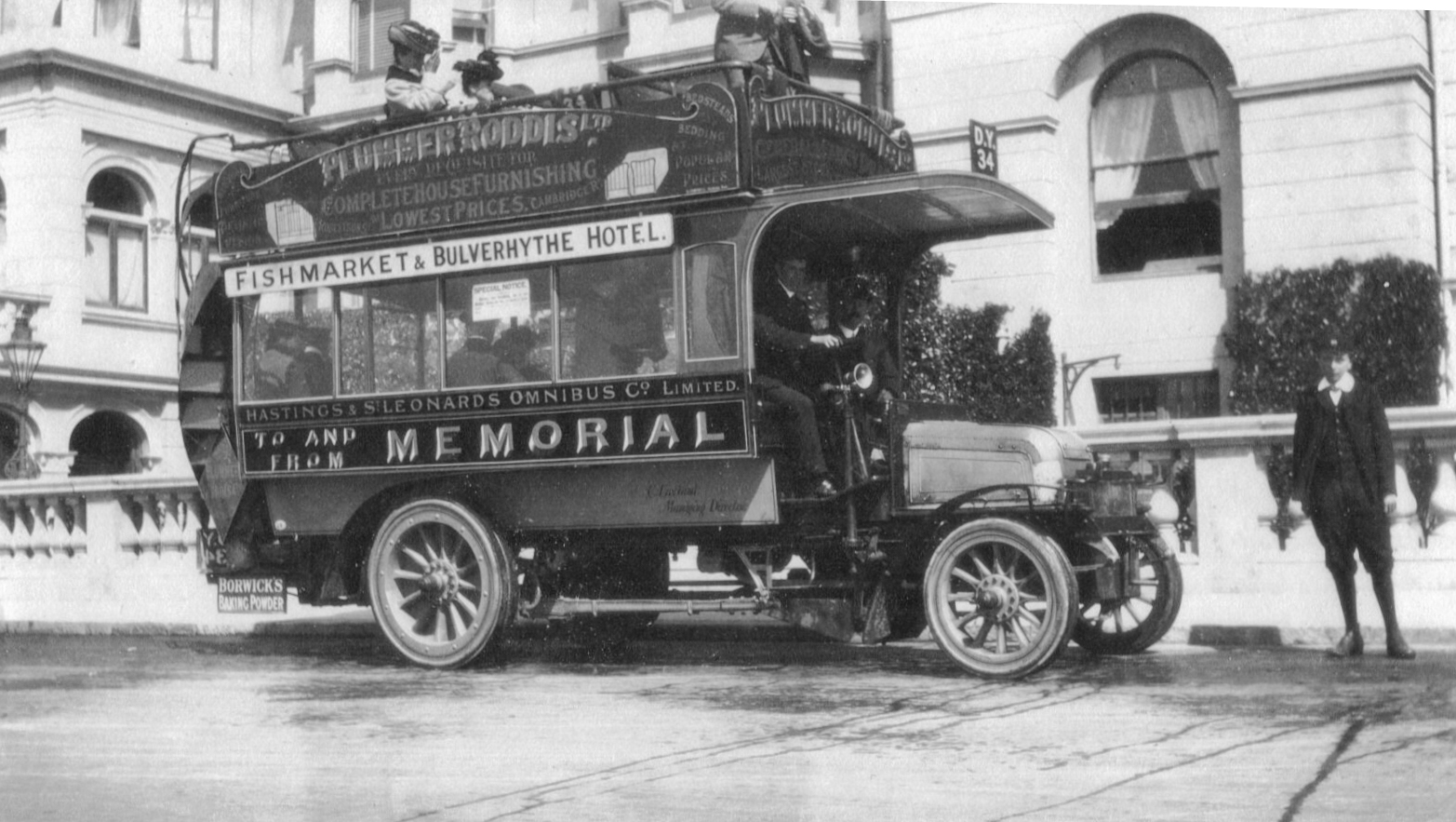
One of the first motor buses, on the run along the seafront.
1903 March 12 - The first Hastings motor bus started in service, between the Fishmarket and West Marina. The first bus was an open-top double-decker Milnes-Daimler, and it was the basis of what developed into the first fleet of double-deckers to provide a regular and more-or-less reliable double-decker service anywhere in the country. The second bus started operations on 20 or 21 July 1903, and another six by late September. Many local authorities sent representatives to examine the successful Hastings service. The Daily Express of 29 August 1903 said: 'The superb ride on top of a rubber-tyred motor omnibus from one end of the three-mile seafront to the other is one of the attractions of Hastings.'
1903 April 22 - The new Hastings Workhouse was declared open at a big ceremony. The ‘Palace of the Poor’ building occupied a 9½ acre site in Frederick Road on the west side of the road, opposite the old 1837 workhouse, which continued in use as part of the new set-up. Work had started on the new building in April 1900. A 240-yard subway connected the two. There were 66 cell-like rooms for men, a dining room 70 feet by 40 feet and a kitchen with a 63-gallon tea boiler. 'The men leave the dining room by different doors from the women, whose quarters are entirely separate.' There were then 258 inmates, with 90 in the infirmary. The scheme cost £55,000. The Local Government Board since c1869 had been criticising the existing workhouse, and the board of guardians had unsuccessfully explored several other schemes.
1903 April 25 - The Financial Times again castigated the Harbour, 'that hopeless enterprise'. The Commissioners throughout 'never seemed to know what they were doing or what they wanted. Already they have had four Acts, and the present Bill, if it goes through, will make a fifth, and all there is to show for this great activity and the £118,400 squeezed out of the public and the £20,000 of debts, is an ill-used groyne and a desolate wall of concrete that even the sea no longer respects. The idea of the Commissioners in getting the 1890 bondholders to waive their prior claim to interest and repayment is because they desire to make a fresh issue of bonds – to the extent of about £231,600 – in order to obtain more money to throw into the Channel. … The bondholders are told in effect that unless they agree to the present proposal their bonds will be valueless, as unless fresh funds are raised the harbour will remain uncompleted. We do not believe the bonds will ever be worth anything. … But even a bondholder with a barren security should have some pride, and there is a great difference between being killed and committing suicide.'
1903 May 6 - Unveiling of the South African War Memorial stone on the promenade at White Rock, commemorating the 46 men of Hastings and St Leonards who died in the 1899-1902 Second Boer War. It was an obelisk standing 22 feet high, of Peterhead granite, and costing £325.
1903 Aug 15 - A report from the Hastings Board of Guardians meeting on 15 August said there was a record number of tramps, the majority of them artisans (carpenters, bricklayers, blacksmiths etc), not ‘neer-do-wells’. There were over 200 during the last week, compared with 118 before.
1903 Aug 20 - Buffalo Bill's Wild West Show drew thousands to Buckshole Field, St Helens Road. Colonel WF Cody introduced a grand review, his ‘Congress of Rough Riders of the World’ and the US Artillery. A prairie emigrant train drove in and was attacked by Indians. Colonel Cody gave unrivalled feats of shooting from horses and Johnnie Baker, the celebrated young American marksman, showed his ability as a splendid shot. 'Altogether it was a gorgeous spectacle. … Never before has anything of such magnitude and value been conceived or executed.' The show claimed to have ‘Four special trains, 800 people, 500 horses’. Tickets 1s to 7s 6d.
1903 Aug 23 -Three men sailed a 15-foot open boat to Boulogne for a wager. It took about 24 hours.
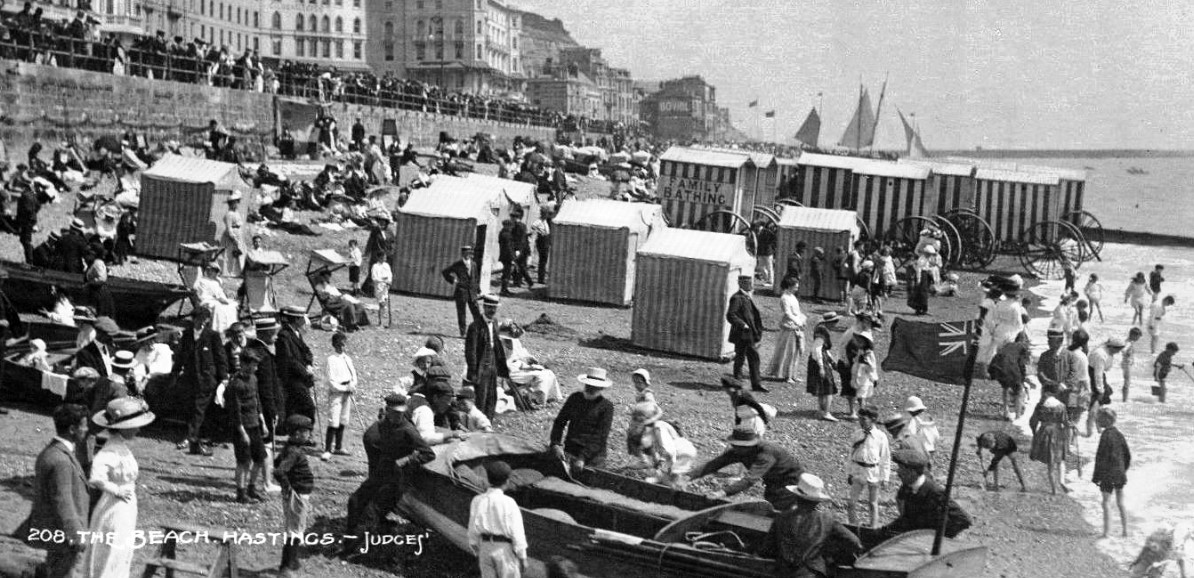
Bathing machines on the beach.
1903 Sept 10-11 - A disastrous gale took place. Fifty bathing machines were lost, houses and a chapel were flooded and steamboats were in a terrible plight. The greatest sufferers were Messrs Hutchinson Bros, proprietors of the bathing machines near St Leonards Pier and at Marine Parade, and Miss Saigeman, proprietress of the machines at the west end of Eversfield Place. The pile driving apparatus at the end of the harbour gantry was swept away.
1903 Late - The first postcard published by Fred Judge (1872-1950), founder of the nationwide postcard publishers Judges that was to be based in Hastings, showed the September 10-11 gale. He had moved to Hastings in 1902 and had taken over the business of A Brooker, a 'photographic chemist', at 21a Wellington Place. Judge was already a skilled photographer, and in 1904 began publishing postcards in large numbers. Only the small local professional Angus Croyle, and Frederick Broderick from the Isle of Wight, are known to have sold Hastings photographic cards a few months before Fred Judge in 1903. In 1905 he moved his successful business to larger premises at 42 White Rock, living over the shop with his family. From 1910 he moved his printworks and retailing to other premises, ending up in 1927 in the large new factory in Bexhill Road where the firm is based today.
1903 Sept 12 - A motor boat trial took place in the harbour. Councillor Blackman and friends engaged in giving a trial to a new petrol motor boat, built by Mr Duffie. The run took place in the smooth water between the harbour arms.
1903 Sept 18 - The borough engineer reported to a Council meeting the very defective condition of the upper part of the Albert Memorial. The stonework appeared rotten and the joints were open. The top part of the tower above the clock needed to be taken down and rebuilt. The work was recommended to be carried out.
1903 Nov - The annual report for the Ore Penny Dinner Fund for 1902/3 said: 'The majority of the population of Ore is poor, and in winter work is very scarce, and the children generally suffer.' The voluntary fund was started in 1882. Last winter it gave 13,738 dinners to the poor children attending the Ore Board schools, costing £87 18s 7d, slightly over 1½d per dinner. This was the largest-ever number, 484 more than 1901/2. They were given for 15 weeks. The dinners were given every school day at Sandown School, at 12.00. “The children receive every day an unlimited supply of good soup and bread, with a second course of bread and jam.' The Weekly Mail of 21 November said that the poverty and unemployment in the coming winter could be worse than last winter.
1903 Dec 4 - There was an appeal from Mr G Gilbert Muir to help the distress in east Hastings. He talked of distress made keener through lack of employment because of aged parents helpless with paralysis, and where some were struggling for a living out of dressmaking and struggling with death by consumption at the same time.
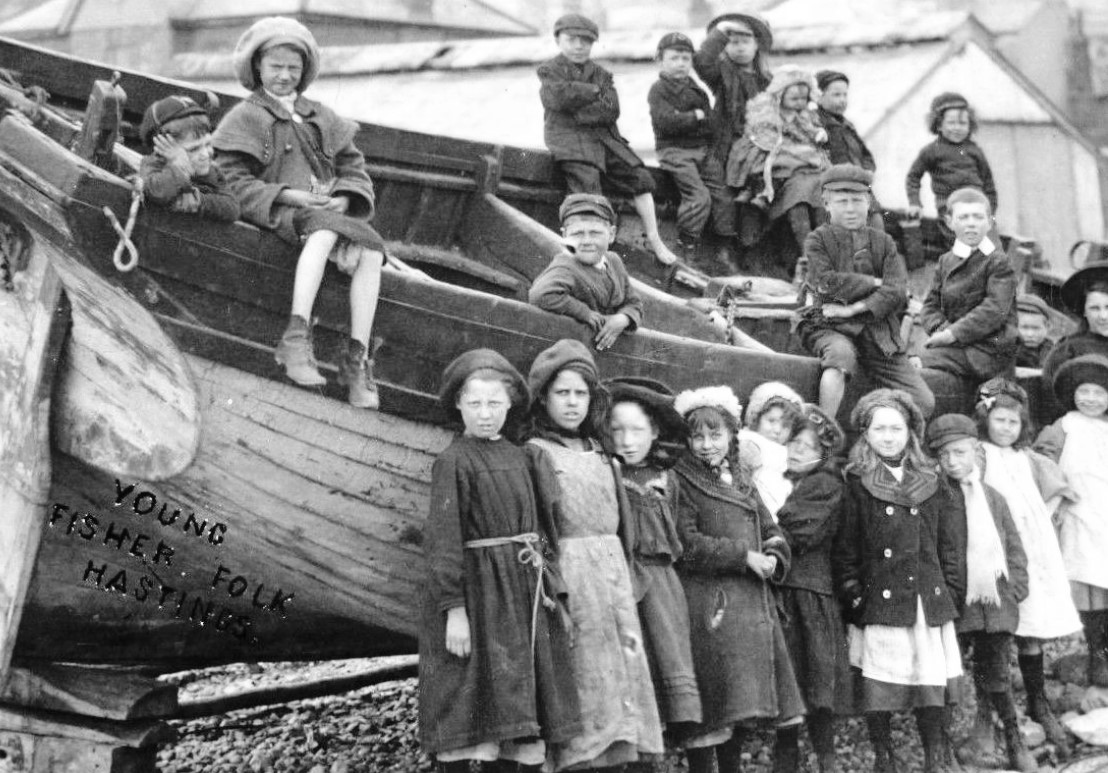
"Young fisher folk" on the Stade at east Hastings.
1903 Dec 29 - A dinner for the poor was organised by Mr FR Griffiths, manager of the Hippodrome, Pelham Place, at the Drill Hall in Middle Street. Over 600 of the poorest people were present, some of whom had not enjoyed a substantial meal that winter. Thousands were served on the three following days with hot soup. A lot of hungry-looking children were to be seen with jugs and cans anxiously waiting for the kitchen to open. At the appointed hour each day a large number congregated around the Hippodrome. On 30th about 120 hearty out-of-works were admitted in batches and given a good basin of soup; on 31st 1,500 children were served with soup. On 2 January Mr Griffiths distributed bread to the poor. On 1 January, a substantial New Year’s dinner of roast beef, vegetables and plum pudding was given to the Hollington and Silverhill aged poor, in the schoolroom of the Silverdale Mission Church, 175 Battle Road.
1904 - Hastings Council renamed Cackle Street as Frederick Road, in honour of Alderman Frederick Tuppenney, chairman of the workshop’s board of guardians, who had been the driving force in building the new extension to the workhouse. All the workhouse later became St Helens Hospital.
1904 - The Fairlight Coastguard Station was rebuilt on its existing site. It formed the terrace of houses still there today, with lookout facilities on the seaward end of the block. At about this time, and in immediately following years, the government cut down the size of the national Coastguard service, and this seems to have resulted in the closure of the Haddocks and Ecclesbourne Stations.
1904 Jan 1 - The Motor Act 1903 came into force, requiring all motor vehicles to display registration letters and numbers. Hastings Council was given the letters DY, and the first applicant was Mr Jules Mastin, a partner in Mastins drapery store, who was awarded DY 1.
1904 Jan 1 - A new mayor’s Relief Fund was set up to alleviate the distress in the borough. The committee running it met for the first time on 5 January at the Town Hall. It was effectively a Council sub-committee, chaired by the mayor Alderman Ben HW Tree, with councillors and other people as members, and clerical assistance from Council staff. Ald Tree launched an appeal, which by the time of the second meeting, on 11 January, had raised £238.
1904 Jan 16 - The Weekly Mail of this date described the St Peters Labour Yard, in Cornfield Terrace, Bohemia, and the unemployed. Unemployed men of St Peters parish sawed and then chopped up sleepers for firewood. At the moment 29 were doing it. The yard was part of premises owned by Mrs Vinall [36 Cornfield Terrace?]. It was started in December by the Charity Organisation Society.
1904 Jan 19 - A Weekly Mail reporter at the Grove Road Mission Hall in Ore saw 'the enormous amount of poverty prevalent in this part of town, the spectacle of a long procession of a variety of individuals, mostly women, with haggard faces, poorly clothed, and some with little children toddling beside them, and wearing boots and shoes which had not for a long time kept out the wet'. Each was examined at considerable length by the Committee. 'Large numbers of the applicants had neither coal nor food in the house.'
1904 Jan 20 - A parade was organised by the Friendly Societies to aid the unemployed and relieve the acute distress prevailing in the town. There was a torchlight procession, marshalled in Wellington Square, with bands and banners, and many in fancy dress. It was initiated by the Hastings Bonfire Boys. The parade collected £14 12s 5d. The News said this was 'the worst winter for 38 years'.
1904 Feb 27 - The Weekly Mail editorial said: 'There is still in the borough an extraordinary degree of poverty arising from scarcity of work. … There is, unhappily, no immediate prospect of increased commercial prosperity.' For several coming weeks assistance was needed. 'The ability of a considerable number of the inhabitants to subscribe may be less, at the present moment, than for some years past, but there is, notwithstanding, plenty of money in the town. The sum spent in the course of a few days at the Conservative bazaar … serves to show that money is plentiful.'
1904 March 8 - The Royal Victoria Hotel re-opened 'after undergoing almost complete reconstruction'. It had the 'latest labour-saving devices and appliances'. There was a billiard room with two full-size tables on the left of the main entrance. It had been closed for nearly a year, and £10,000 had been spent on it.

The Royal Victoria Hotel in 1947.
1904 April 16 - A meeting was held in the Princess Room of the Royal Concert Hall, Warrior Gardens, to establish a branch of the Central Society for Women’s Suffrage, supporting the moderate National Union of Women's Suffrage Societies. The Liberals and Tories united and a society was formed.
1904 May - In the earliest days of motorised road vehicles, Hastings Council decided to set up its first traffic warning signs: red triangles at 18 locations 'denoting dangerous corners, cross roads and precipitous places'. This was in compliance with the 1903 Motor Car Act. The first Hastings case under the Motor Car Act 1903 was heard at Hastings Magistrates Court on Thursday 19 May. A visitor, Mr Ralph F Dickerson, was charged with ‘driving to the danger of the public’. PC Wallis 'saw the defendant driving furiously through Robertson Street on Sunday, 24 April, at from 17-18 miles an hour. He was driving eastward.' He went as far as the Memorial and then came back. There was a large number of pedestrians. The PC shouted for him to stop, but he did not, and increased his speed to 20. As he had a previous similar conviction elsewhere, he was fined £10, plus £1 3s 6d costs. But in November he won his appeal.
1904 May 5 - The AGM of the Omnibus Company was held at the Queens Hotel. The annual report said that 12 months ago they had bought one motor bus as an experiment. It had been such a success that five others had been added and they wanted more. The income was up £1,700 to £27,562 as a result in the year to 26 March 1904. Expenditure was £25,494. 'Alderman Bradnam said the past year had been one of the most satisfactory they had yet had. … What they had to do in Hastings was to fight the tramways.' A 15% dividend was paid.
1904 May 7 - A cat belonging to William Tapsell of 29 Brewery Cottages, High Street, gave birth this week to a kitten with two bodies but only one head. It was put down.
1904 May 11 - The funeral of George Gaze took place, in his 73rd year. He had been a director of the Royal Victoria Hotel since it was built. At one time he owned the Castle Hotel. He sold the Castle lease and then built the Gaiety Theatre, making it a successful business as managing director. He was part of the Gaiety for 22 years. Since 1875 he had been a member of the Derwent Lodge of Freemasons. He lived at 2 Wellington Square.
1904 May 21 - A letter in the Weekly Mail complained of the way women watched men bathe at their naked bathing area at Rock-a-Nore. 'The bathing attendants should be instructed to see that the privacy of the men’s free station is not intruded upon by brazen-faced women, who have no shame, but sit and loll about the beach in full view of the bathers.'
1904 May 28 - The Hastings fishing boat William and Maria, owned by John Gallop, struck a submerged pile near Hastings harbour and foundered. The crew had a very narrow escape and, but for the conduct of ‘Biddy’ Stonham, the skipper would have perished. On 30 May the vessel was dragged from the harbour mouth and beached, very badly damaged. The National Lifeboat Institution awarded a medal for the heroism shown by Biddy Stonham in rescuing the skipper. Biddy later became famous as ‘Biddy the Tubman’.
1904 July 16 - 'Now that motor cars have to bear an index mark and number', the Mail printed a list of all UK indexes, including: Hastings – DY, East Sussex – AP, West Sussex – BP, Brighton – CD and Kent – D.
1904 Aug 20 - The Weekly Mail of this date reported that two hermits were living in Ecclesbourne Glen and probably several others not so far traced. One lived in a cave and was asked when discovered for a nominal rent from the landlord the Rev Mr Milward. He paid 22s 6d rent and half a crown to the tax authorities for his little allotment and cave dwelling. He had been given a modern stove.
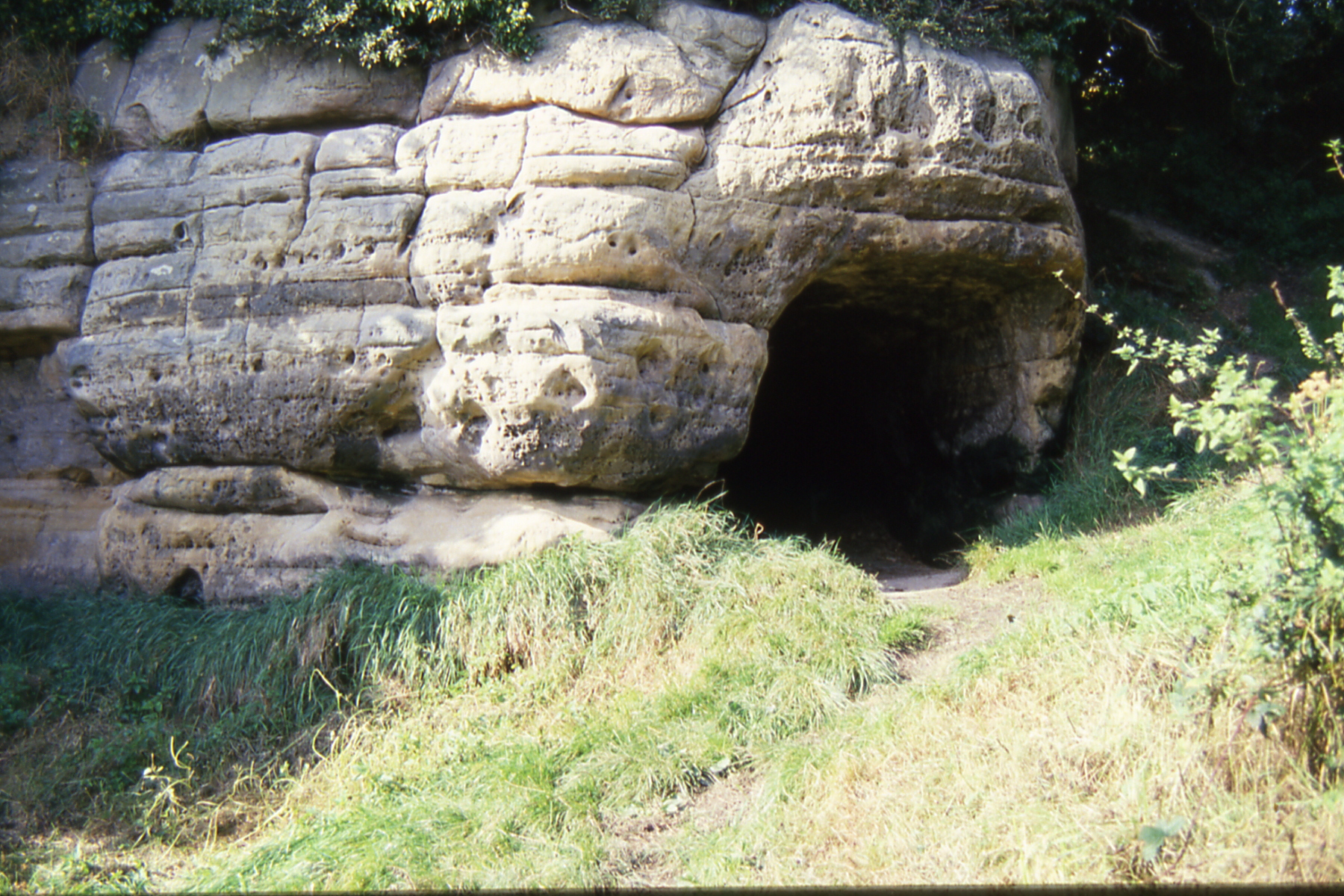
The hermit's cave in Ecclesbourne Glen.
1904 Aug 27 - The ‘smallest car in the world’ took part in a motor gymkhana meeting at Horntye Field, Bohemia. The six feet long car, with a 2½ hp engine, was driven by Master George Du Cros, aged five. The event started with a procession of 30 vehicles along the seafront from Warrior Square. Official figures showed that in England and Wales on 1 April 1904 there were 13,302 cars and 14,771 motor bikes.
1904 Aug 28 - Motor omnibuses ran to all parts of the town for the first time. They were on the road between 10 and 11 o’clock in the morning and in some instances ran until half past ten the same evening. All buses were fairly well patronised.
1904 Sept 1 - A meeting of the Workhouse Board of Guardians was told that a tramp had been sent to prison for 14 days for refusing to work. 'The Master … explained that the tramp was put to stone pounding because they had so many tramps in. Last week the tramps numbered about 250, the most since he had been at the Union. … They did not give them stone pounding unless they were able to do it. The men always saw the doctor first. The prisoner was found to be fit to do the work, but he said he would not do that or anything else.' Tramps were discharged at 10am. 'If they had tried to do their work, but could not finish it they were allowed to go.'
1904 Sept 3 - The White Rock Gardens, on the hill opposite Hastings Pier, were formally opened. The area, the former Brisco Estate, had been controversially acquired by the Council in 1902 for about £20,000, but it was to take until 1920 to completely re-landscape it.
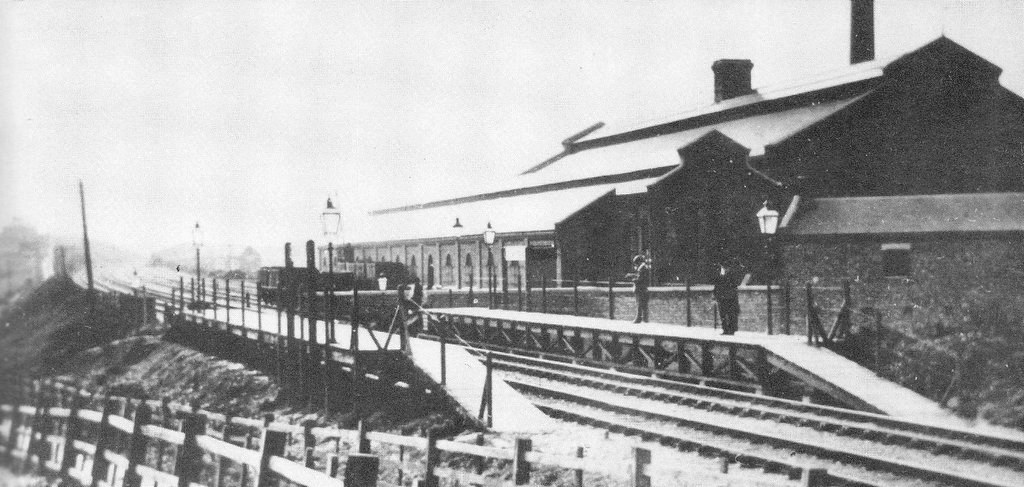
Glyne Gap station; opened 1905, closed 1915.
1904 Oct - Trial production took place at the huge new Hastings gas works at Glyne Gap. Work on the 14 acre site had started in 1900, and the works were brought into full use in 1907. Gas was made from coal, and the works were built just outside the borough boundary in order to avoid paying the high tax on the import of coal into the town. From 1830 gas had been manufactured where Morrisons supermarket is today, off Queens Road; work ceased here on 6 June 1907. A new railway station opened at Glyne Gap, being a small halt just to the east of the pedestrian tunnel under the line; it closed in 1915. The Ravenside shopping centre is now on the site of the gas works. The gas company was nationalised in 1948.
1904 Nov 3 - Mary Ann Petit Chetwynd, a 33-year old trained nurse, was found dead on a cliff ledge, 300 yards east of Ecclesbourne Coastguard station. She had committed suicide following the recent death of her mother. And on the same day Frank James Foster, 26, assistant master at Halton Boys School, was also found dead, at the foot of the cliffs at Fairlight. He had been suffering from nervous exhaustion.
1904 Nov 22 - The Winter Orchestra for St Leonards made its inaugural performance at St Leonards Pier’s new Kursaal (the former Pavilion, turned into a fashionable lounge). But the concerts in the Kursaal were not a financial success, and they were ended on 12 February 1905.
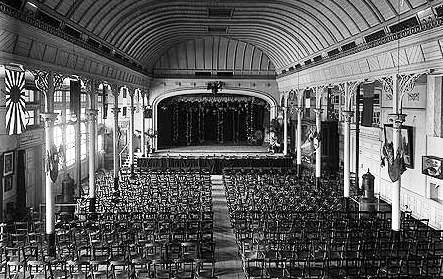
St Leonards Pier's Kursaal.
1904 Dec - Hastings Council decided that, as the whole of Alexandra Park had been enclosed by an 'unclimbable iron fence', the park should be closed at night and all the footpaths in it discontinued.
1904 Dec 2 - Hastings Council on 2 December decided to take full control of the museum from the Museum Association because the museum was running at a loss. The upkeep of the museum was £130 per annum and the number of visitors per year was 28,000.
1904 Dec 7 - Work began at Baldslow on constructing the town’s first tramway tracks. The Hastings and District Electric Tramways Co Ltd was to construct 19 and a half miles of tramway. The 1903 Act authorising the construction said the controversial Front Line (seafront) section should not have overhead power cables, and work should not start on it until the rest of the system was open. From 1,500 to 2,000 men were to be employed in excavating the roads. Local men were to be preferred for the unskilled work. The trams came into service on 31 July 1905.
1904 Dec 9 - Most of the large drapery store Mastins, in Breeds Place (where Iceland is today), was destroyed in the largest fire ever faced by the Volunteer Fire Brigade. Nearly £12,000 of damages was caused. The drapery establishment was partially ruined. This was the first time in the history of the Hastings fire brigade that all the men were called out, and the scene was captured by Judges on their postcards. Mastins had opened in 1872, and it remained the leading family business in the town until it closed in 1969. It stood empty until 1972 and was then demolished.
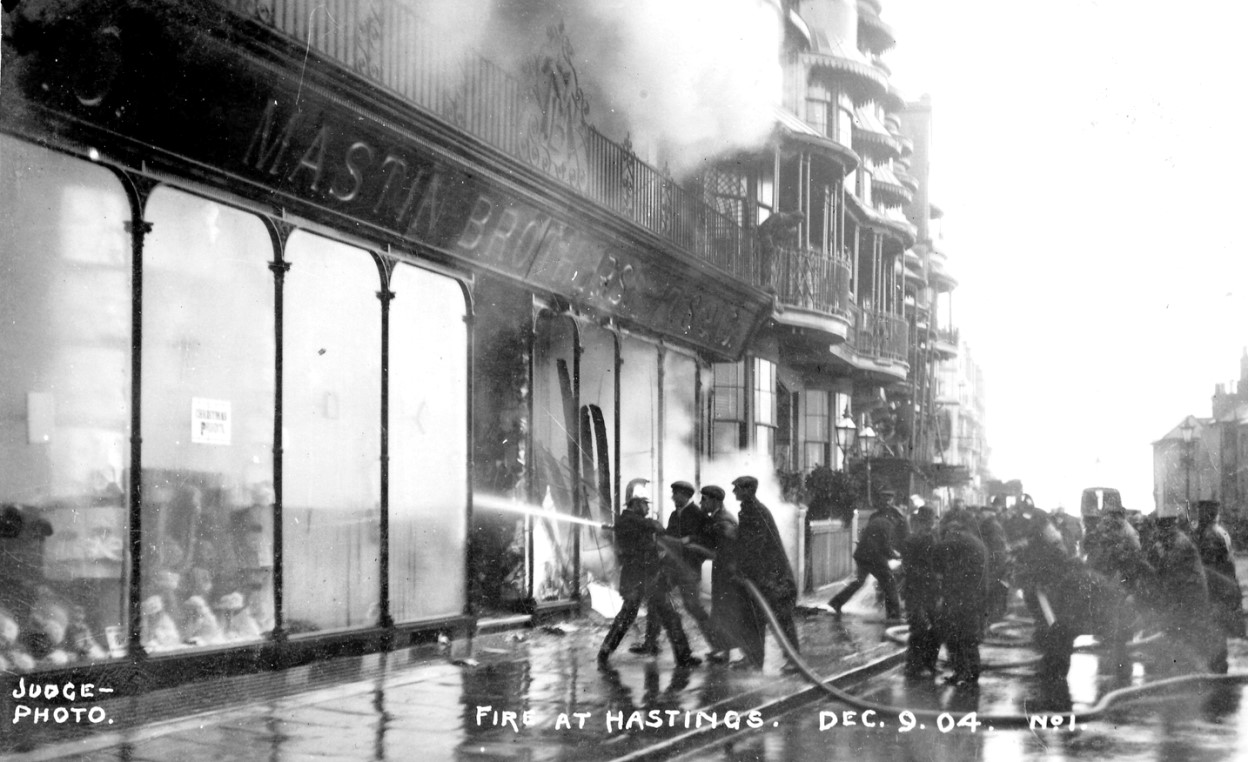
The disastrous fire at Mastins.
1905 Early Jan - The inaugural meeting of the Hastings and St Leonards branch of the Typographical Association was held in the Clarence Hotel, Middle Street. They hoped to have 30-40 members in three months.
1905 Jan 5 - Miss Edith Rhodes, a sister of Cecil Rhodes, founder of Rhodesia, died at her residence in Maze Hill. She was well-known in the town. Some of the Rhodes family also stayed at Fairlight Place in earlier years.
1905 Jan 7 - The Weekly Mail of this date reported that the tramway work was proceeding rapidly at Ore and Hollington. At Ore the construction was rapidly approaching the centre of Hastings, having reached Mount Road. All through Baldslow the work had been finished and the roads had resumed their natural appearance. There were many strangers in the town.
1905 Jan 27 - Two thousand children were given teas by Mr and Mrs Delevanti in the Market Hall in George Street, this being the fifth year in which Mrs Delevantl had organised this treat for the poor children 'to provide a few hours happiness'. They were given crackers, bonbons and paper hats. After tea there was music, a magic lantern, a magician, a ventriloquist and punch and judy.
1905 Feb 4 - The 14th annual report of the Hastings and St Leonards Association for Organising Charitable Relief said there were 2,963 applications for assistance in 1904, up 1,203 (68%) on the 1,760 in 1903. There were 2,222 bread and grocery orders, 423 coal orders. The early period of 1904 was of 'great distress. … Owing to lack of employment the distress continued during the rest of the year, and there seems to be little hope of improvement.' During the year there was a 'great stride' in the unification of the various relief agencies: distress committees in the Old Town, Ore, West Hill; soup kitchens in West Hill, Clive Vale, Halton, Ore, St Peters and the coffee tavern; committees also in Hollington, Silverhill and Bohemia.
1905 Feb 10 - Charles Weller, the verger of Christ Church St Leonards, was killed in a cycling accident. He was cycling along Robertson Street with his hands in his pockets, a growing fashion amongst cyclists. He fell off and fractured his skull.
1905 Feb 18 - Five hundred tramway workers sat down to a hearty meat tea in the Drill Hall, Middle Street, organised by the Central Wesleyan Church congregationists. It was an amiable gathering, though there was naturally considerable bitterness between the natives and the 'importers' as to which should have priority in work.
1905 March 1 - Hastings Council took over the ownership and running of Hastings Museum in an elaborate ceremony led by the mayor, before a large and influential gathering. Collecting exhibits had started in 1889, and the Museum Association was formed in 1891. The museum was given to the Council by the association because it had been running at a loss. There were 28,000 visitors in 1904.
1905 March 15 - A meeting was held in Christ Church parish room, Ore, to establish a creche and children’s cottage hospital for Ore and Clive Vale. The meeting was convened by neighbourhood practitioner Dr AH Huckle, who said that one of the first things to appeal to him when he started his work in the district was the utter destitution and poverty of the poor. ... The poor of the town were poorer and more destitute than in the worst parts of London in which he had practised. The Rev WC Cooper, vicar of Christ Church, said 'the suffering the children had to put up with was really indescribable. … If it were not for the women working it would mean starvation for many families.'
1905 March 18 - Opening of a new small fire station in Seaside Road (now demolished).
1905 April 21 - Death of Dr T Trollope at his residence, 9 Maze Hill. He was a highly rated physician, aged almost 80, who came to Hastings in the early 1860s and was lately the chief honorary surgeon at Hastings Hospital. He had a stroke a few months before. He was said to be the best friend of the poor. He was also a senior Freemason, having been a past Grand Deacon of England and holder of many other top posts. His imposing funeral on the 27th was masonic, with 40 carriages following the hearse along the seafront to the cemetery. There was a very large turnout of masons.
1905 July 5 - The first three tram cars arrived at the Hastings goods railway station. They were then taken to the car station at Silverhill by a traction engine pulling them up Cambridge Road. Each was built to carry 42 passengers, 22 outside and 20 inside, and were painted pale yellow and brown. The words 'Hastings Tramways' appeared on the sides. The current was put on the lines on the night of the 13th.
1905 July 15 - There was a successful trial trip of the tramcars through Hastings. A very large crowd assembled at Silverhill depot, with cameras. The car was cheered by spectators as it passed Beaufort Road, through Bohemia to the Memorial, and was surrounded by people. The car then went along St Helens Road by Alexandra Park, and round the town. The Board of Trade inspection took place on 20 July.
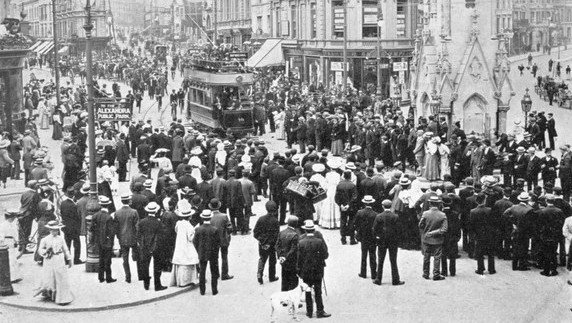
The first-ever tram in Hastings coming down Cambridge Road, 15 July 1905.
1905 July 31 - The town’s first tram service started, with 19,000 people using them on the first day. 'The struggle for seats was astonishing in the vicinity of the Memorial.' The fare was considerably cheaper than the motor buses. An electricity-generating power station for the trams had been constructed in Parker Road, with a sub-station at Silverhill. Initially there was just a circular route from the Silverhill depot, via Sedlescombe Road North, the Ridge, Ore, Mount Pleasant, Blacklands, Queens Road, the town centre and Bohemia Road to Silverhill, with a branch line from Silverhill up Battle Road. Much of the circular route was rural, and the tram system encouraged large scale development in the northern part of the town. A branch from Ore to the bottom of Harold Road opened on 24 August 1905. Another branch from Silverhill down London Road opened on 28 July 1906, and the separate Bopeep-Bexhill line opened 9 April 1906. But the final section, along the seafront from Bopeep to the Memorial, did not open until 12 January 1907 because the power had to come from studs buried in the roadway, not overhead lines. The Hastings Omnibus Company had both motor buses and horse-drawn buses running in July 1905, but by the end of the year most of the buses had been withdrawn. In June 1906 the company was wound up and most its vehicles were sold to the London and Westminster Omnibus Company, which ran intermittent services around the town until it went bust itself in 1907.
1905 Nov 1 - Seven boys (one aged nine, one 10, three 11, two 12) were each sentenced to six strokes of the birch at the magistrates court for stealing six bottles of lemonade the evening before from Samuel Goldstein, confectioner, 34 George Street. 'The chief constable said it was becoming a practice now for small boys to go about in gangs, taking things from shops.' Two were convicted the previous Friday of stealing herrings. But they were all said to behave themselves at school.
1905 Nov 8 - The first meeting of the Unemployed Distress Committee appointed under the Unemployed Workmen’s Act 1905 was held in the Council Chamber. A sub-committee was set up to enquire into the condition of labour and make a register of the borough’s unemployed. On 4 December the UDC was told there were 904 registered unemployed, 215 of them in Ore and 145 in the Old Town. But the unemployed had to fill in a complicated form to be on the register, which some were known to refuse to do. Last winter 18,569 dinners were provided for the poor school children of Ore from the Ore Penny Dinner Fund. There were 900-1,000 children in Ore schools.
1905 Nov 26 - The worst storm since 1877 struck the town. The town centre and George Street were flooded and much damage was done to the seafront and many buildings around the town. Boats rowed round the Memorial.
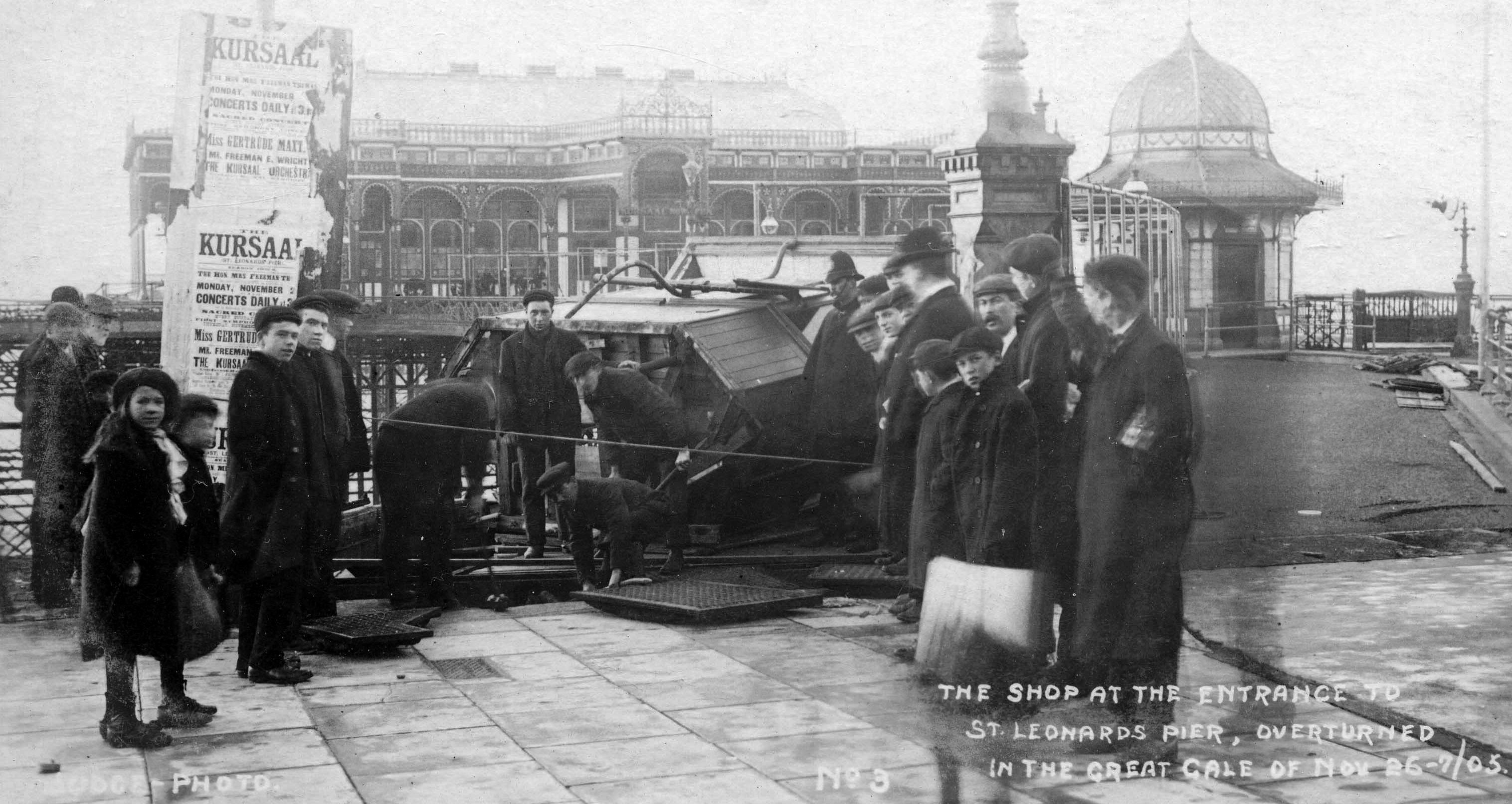
Storm damage to St Leonards Pier on 26 November.
1905 Nov 30 - The workhouse guardians agreed to stop giving the inmates the free pint of beer they had been given every Christmas. This was a result of the temperance movement. In early December the number of workhouse inmates was 369 (334 in 1904), plus 190 vagrants (119 in 1904).
1906 Jan 8 - The renovated old Halton Boys School in Albion Street opened, with room for 104 boys.
1906 Jan 15 - In the general election, where the Conservative government was swept aside by a landslide Liberal vote, Hastings was one of only a handful of seats in the country which the Tories took from the Liberals. The sitting Liberal MP Freeman Freeman-Thomas lost by 413 votes. The winner was millionaire Harvey Du Cros, the Dublin-born founder of the Dunlop tyre business, making his fortune from a near-monopoly of the car tyre trade. His Hastings house was 106 Marina. It was believed that he had won because of false promises he had made to working people of more work and prosperity, at a time of widespread poverty. A letter in the Hastings Mail said 'the poor have never before been duped in such a fashion'. On 21 January the Reverend John Bailey said in a service: 'I knew there were some fools in Hastings, but I was unaware that they were so numerous. … Poor, deluded, benighted, infatuated and demented Hastings.' It is believed that this election of the rich by the poor was the spark for Robert Tressell to start writing his highly influential working class novel The Ragged Trousered Philanthropists.
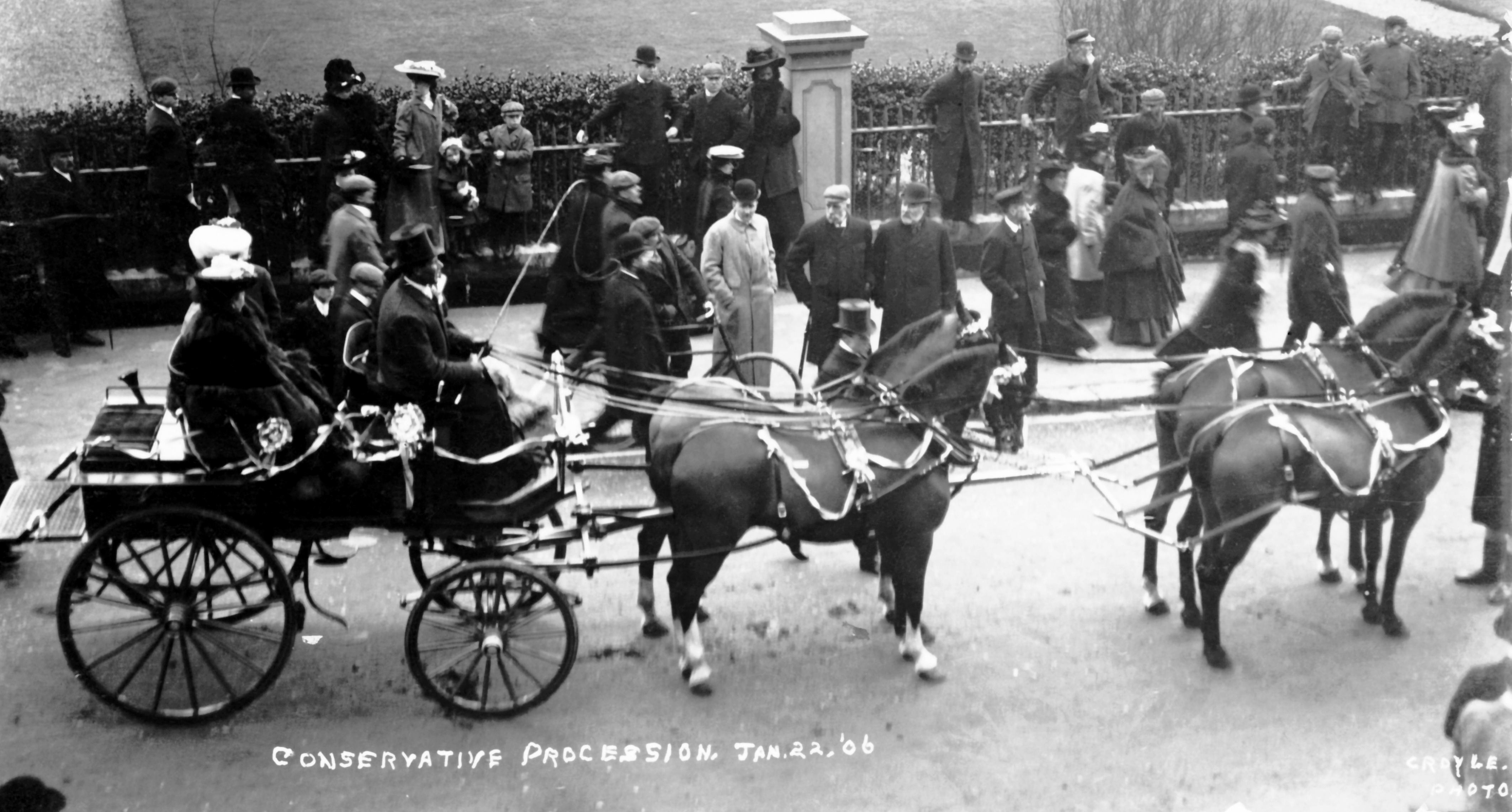
The Conservative victory procession along the seafront, 22 January 1906.
1906 Feb 7 - A new political goup, the Hastings and St Leonards Democratic Association, was set up at a crowded public meeting in Ore. Its committee included Radical Socialists, and members of the Independent Labour Party and the national Democratic League. The Liberal-supporting Weekly Mail commented: 'The movement for the organisation of the democratic forces of Hastings and St Leonards has made a decided advance this week. ... There is every prospect of a most successful future.'
1906 Feb 17 - There was a meeting at the Brassey Institute to reorganise the constitution of the Museum Association after the Hastings Museum had been taken over by the Town Council.
1906 March 3 - The Weekly Mail of this date reported that Harvey Du Cros MP had obtained a large local residence: Levetleigh – 35 Brittany Road, on the corner with Dane Road. In the meantime, he was living at 106 Marina, which his son Arthur moved into in mid-1907.
1906 March 10 - The Weekly Mail of this date reported that the Grand Hotel (at Verulam Place, opposite the west side of Hastings Pier) was in an unfortunate financial position. At it’s annual meeting, the Grand Hotel Company was told depression was bringing about a crisis. The Grand finally closed towards the end of October 1906. This was followed in November by an extensive sale of all the furniture. This was bought in one lot for £2,000 by Mr John J Butler, of Butler’s Emporium in George Street, paying the £2,000 in cash to the auctioneer! He claimed he went to the auction with no hard plans to buy it, and happened to have the money in his pocket. By the end of the following day he had disposed of his suspicious bargain to a Mr Cavie, of Milward Crescent, an old acquaintance.
1906 March 22 - There was stormy criticism of the Magdalen and Lasher Charity at the annual vestry meeting in the parish of All Saints, held at All Saints Infants School. Several working men, mainly fishermen, led by Mr Mann, condemned the way the working people of All Saints and St Clements parishes had no representatives on the board that ran Magdalen. Its trustees were appointed for life, and the accounts of the charity were unintelligible. The rector chairing the meeting, the Rev PJT Blakeway, fully supported many of the complaints in the meeting, but said the parish had no power over the charity. There was uproar several times, especially over the distribution of relief by the charity in the form of coal tickets. It was clear certain undeserving people were receiving generous supplies, while deserving people received little, if any. The meeting also believed charity money had been used in the recent election. The solicitors handling the charity were Young, Son and Coles; Mr Du Cros’ election agent was Mr FW Coles.
1906 April 4 - Death of Thomas Brandon Brett, aged 89, the famed local historian and newspaper owner. He was born in George Street in May 1816. His father was a smith. Thomas had several jobs while young. In 1855 he launched, wrote and edited the St Leonards and Hastings Gazette, which he produced weekly until c1896.
1906 April 9 - The first section of the new tram line from the Bopeep Hotel to Bexhill opened to the public, just in time for forthcoming Easter. The service was based in the Bulverhythe Depot, on Bexhill Road 200 yards of Filsham Road. The depot survives today as a mineral water store. The line was extended to Cooden Beach on 28 July 1906.
1906 April 21 - Death of William Ransom, father of the local press. He died at his residence at 13 Githa Road, Clive Vale. He was the founder and first editor of the Hastings and St Leonards News, first published on 5 May 1848, the first long-living Hastings newspaper, and the model of those to come. Aged 83. He was helped by his father William (who died November 1855) and then his uncle John until the selling of the News in 1870. William remained editor until 1884. After that he contributed much material to the News and the Mail. He was a strong Liberal, greatly helping the local party.
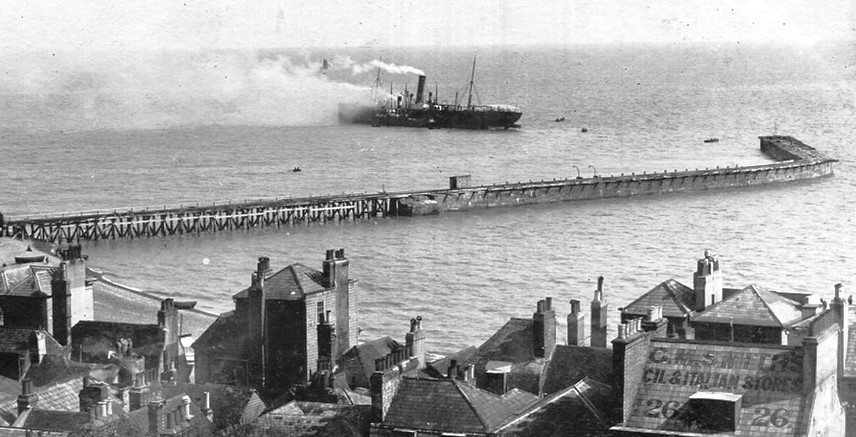
The steamer Lugano on fire off Hastings.
1906 April 26 - The 6,700 ton steamship SS Lugano caught fire off Hastings. The blaze in the forward cargo hold was very serious, and the vessel was run ashore just to the east of the harbour where tugs and other craft could play hoses on it. The SS Lugano was a tramp on charter to the German Lloyd Steamship Company, and was on voyage to Hamburg with a full cargo. The fire lasted three days, and large crowds gathered on the seafront to watch the attempts to bring the spectacular blaze under control. The ship survived and was towed away on 5 May by three tugs.
1906 May 23 - The laying of the foundation stone of the new Church Hall in Croft Road, close to St Clements Church, was carried out by the Archdeacon of Lewes. The hall was then in the course of construction.
1906 June 9 - The Weekly Mail of this date reported that a new ambulance van was almost complete for the Hastings division of the St John Ambulance Brigade. It was being built by Messrs Davis and Son, coach builders at Battle. It was a horse van, which was a 'distinct improvement' on the former two wheeled stretcher.
1906 June 9 - The Weekly Mail of this date reported that the two local football companies had just merged. The Hastings and St Leonards Football Company and the St Leonards United Football Company had amalgamated to become the Hastings and St Leonards United Football Company Ltd. 'At the outset of the negotiations there was one aim – the advisability of closing up the broken ranks of local professional football.' St Leonards United was £300 in debt, Hastings £200. The new company would have £2,000 share capital, and six directors from each of the old companies. The St Leonards United Club would be wound up, and the new club would be called Hastings and St Leonards United. The chief playing ground would be the Central Recreation Ground, Queens Road. It was hoped that some of the Brisco Estate (off Bohemia Road) could be used for training. There would be three teams: first and second, plus a reserve.
1906 June 14 - The Hastings Omnibus Company should be wound up, an extraordinary general meeting at the Queens Hotel decided. Two of the 11 motor buses had been sold for £450 each and sent to Aldershot. But they had only been able to obtain £300 each for remaining nine, a great disappointment. The names on sides of the nine had been already been changed to ‘London and Westminster Motor Omnibus Company’, although they were still in Hastings. The company’s 'motor stables' and offices were being rented to 'the new company', and the other stables to the proprietor of the two horse buses. The winding up would take place in a fortnight. There had been a startling trading loss of £1,373 over the year.
1906 June 21 - A large motor mail van arrived at the Central Post Office. It was to run from London to Hastings and vice versa with the parcel post, commencing on July 2. The vehicle, which is of considerable proportion, was loaded up with blocks of stone for a trial run.
1906 June 28 - A hospital matron was killed in a motor car accident. Miss Ranford, the respected matron of the Buchanan Hospital, died in an accident at Cripps Corner while with a pleasure party on an outing to Hawkhurst. The large car overturned when the driver lost control down a decline and the occupants were precipitated into the road. She was killed instantly and many others were seriously injured. The car was on hire from Skinners, of St Leonards, and writs for damages as a result were a key factor in causing the company to be closed down that November.
1906 July - The strong anti-Tory movement in the town began to break up in a confusing manner, following the election of Mr Walter Jones, a plumber, to be a candidate for Hollington and Silverhill in the autumn local elections. He was a candidate for the Trades and Labour Council. But the liberal Democratic League was not happy with his selection, while socialists wanted a more radical anti-capitalist movement in the town. By October the various anti-Tory parties had fallen out with each other.
1906 July 28 - The London Road and Cooden tramway extensions opened. The London Road extension ran the full length of the road, from Silverhill to Grand Parade. The Cooden extension was on the Bopeep-Bexhill line, which was separate from the Hastings and St Leonards lines, and it ran from Bexhill to Cooden Beach. But the line was still being laid along the Hastings and St Leonards seafront, as it had to be 'Dolter' powered, ie, by a difficult system of studs laid in the roadway (overhead lines and poles were seen as unattractive). A public opinion poll on 28 July found a majority of people (4,109 for, 1,420 against) were in favour of having trams running on Sundays, and this was approved by the Council on 3 August.
1906 Aug 16-17 - Lord John Sanger’s Royal Hippodrome and Menagerie came to the Central Cricket Ground. The circus was visited by large crowds.
1906 Sept 6 - Hop field tragedy: A Hollington woman, Emma Jones, hop-picking at Robertsbridge, was found dead with her face in a bowl of water and tape tightly round her neck. There had been many suicides in recent months.
1906 Sept 20 - A new Church of England chapel was opened at the Hastings Workhouse. All inmates were expected to attend, with the threat of having their diet reduced to bread and water if they did not.
1906 Oct 12 - The first meeting took place of the new Hastings branch of the Marxist-oriented Social Democratic Federation. It had been set up in response to the Tory winning of the Hastings seat in the January 1906 general election. By late 1906 there were socialist and Labour groups all over the town, with the SDF the most active. Author Robert Tressell supported the Hastings SDF, which generated much political activity over the coming years, mostly inspired by its leader, Alf Cobb, a local street trader.
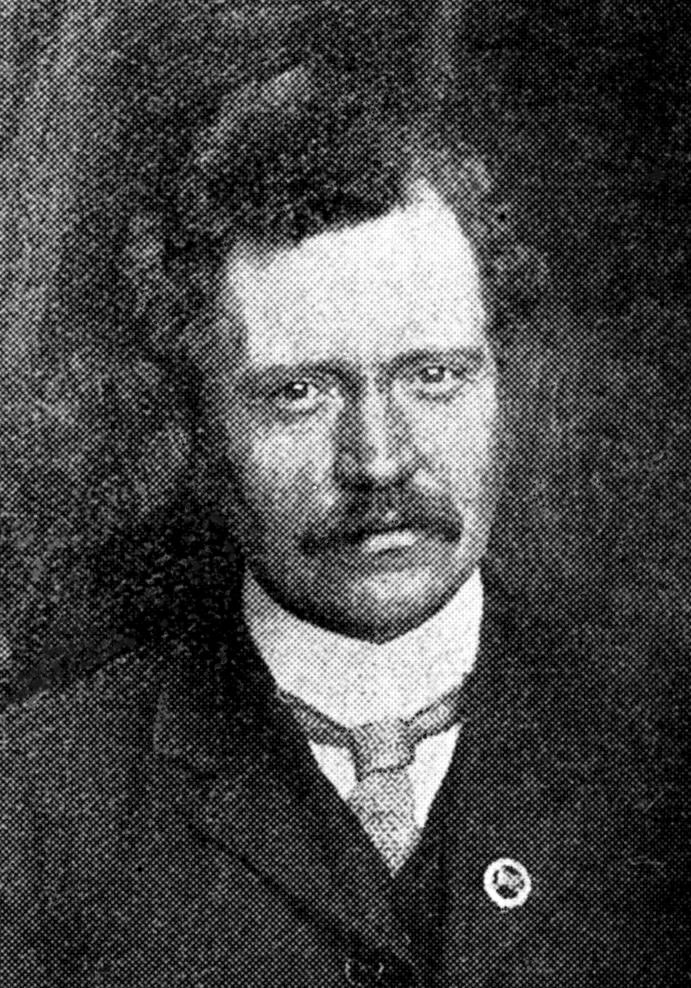
Alf Cobb in 1910.
1906 Oct 15 - The Clive Vale and Silverhill police stations opened. The Clive Vale station was on the corner of Clive Avenue and Mount Road, next to the fire station.
1906 Late Oct - The Grand Hotel, at Verulam Place opposite Hastings Pier, closed because of financial problems. This was followed in November by an extensive sale of all the furniture. This was bought in one lot for £2,000 by Mr John J Butler, of Butler’s Emporium in George Street, paying the £2,000 in cash to the auctioneer! He claimed he went to the auction with no hard plans to buy it, and happened to have the money in his pocket. By the end of the following day he had disposed of his suspicious bargain to a Mr Cavie, of Milward Crescent, an old acquaintance. Butler said he bumped into Cavie in the street soon after the auction, told him about it and sold it almost on the spot.
1906 Nov 1 - Municipal elections took place in three wards. In Silverhill and Hollington, the Labour candidate Walter Jones withdrew, after a summer of much activity, so Liberal councillor James Pelham held the seat, by 468 to 335 for the Independent Conservative Mr S Stevens. The 67% turnout in the three wards was described by the Mail as 'one of the most apathetic elections in Hastings on record'.
1906 Nov 5 - Dissatisfied shareholders of the long-established motoring business Messrs Skinner and Co decided they had to wind up the company. This followed the suicide of its manager Henry Holcombe Brown on 29 September. He was found dead in a pool of blood by some children playing in Warrior Square Mews, having shot himself through the head with a revolver. The firm Skinners was based at 18 Western Road. Brown was 44 and lived at 57 Springfield Road. He had been manager for 15 months. A large majority of shareholders criticised the management of the business in recent years. and said they had no option but to wind up immediately because of large outstanding debts. A solicitor admitted that it was possible to believe the business “an extremely good one” but the debts were high. There were very large and unnecessary expenses on the accounts. Brown was appointed on a salary of £275, but his predecessor was only on £150. Alderman Bradnam said the trams had done them serious injury with regard to their motor cars, which had to be written down in value. He said there were bad debts, some bad spending and other problems, unspecified. Another major factor in the closure was the death of a hospital matron, killed in a motor car accident on 28 June 1906 (cf).
1906 Nov 11 - A monster skate was caught by Daniel Martin, fisherman. It was seven feet in length and five feet across. It was purchased by Messrs Walton and Co, fish merchants of Queens Road.
1906 Nov 20 - The new parish room for St Clements was declared open.
1906 Nov 26 - There were more by-elections in four wards, and Walter Jones stood as a candidate for the Trades and Labour Council, and was effectively the first Labour Party candidate at a Hastings election, although he was actually representing the Liberal wing of the complicated Hastings politics. But he lost, and the Tories won all seats. Jones's vote may have been lost by the lack of support from the socialists. Over the past few months a big split had developed between the Trades Council (just focusing on trade unionists) and the Social Democratic Federation, which had few trade unionists as members. The Hastings SDF had been become a very active and vocal body, under the leadership of Alf Cobb, and supported by Robert Tressell.
1906 Dec 18 - The first tram ran on the extended seafront route, from Bopeep to Hastings.
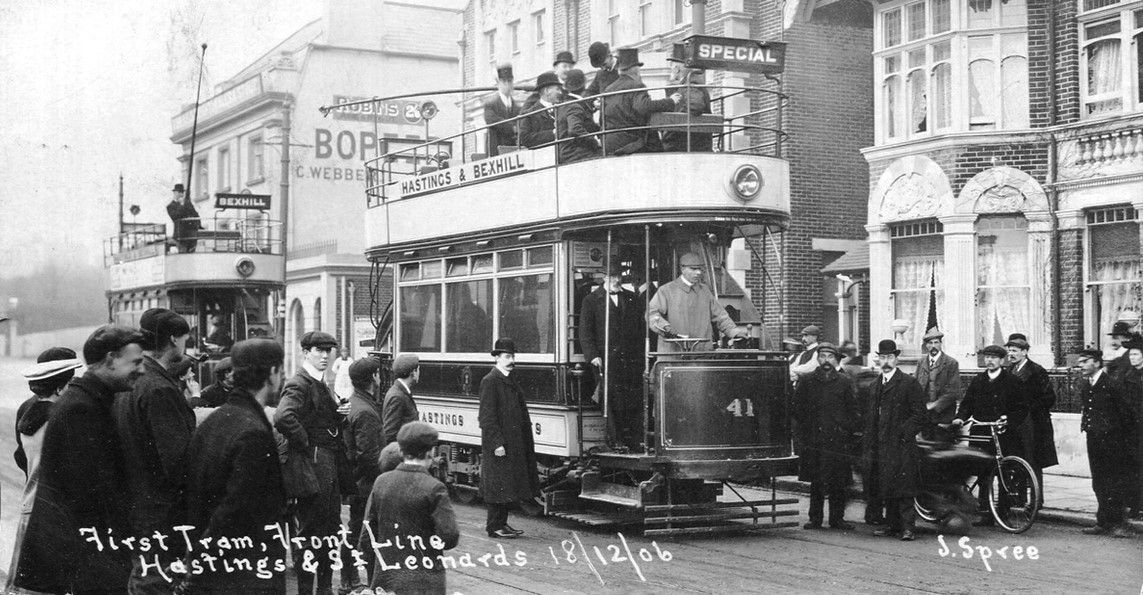
The first tram sets off from Bopeep on the new extended route.
1907 - It was in this year, and in 1908, that Robert Tressell was drafting his highly-influential working class novel The Ragged Trousered Philanthropists. He was living in the top-floor flat at 241 London Road, with his daughter Kathleen. He was still working as a painter and decorator in the local building trade, but was suffering from tuberculosis, which was eventually to kill him in February 1911.
1907 - Small steam railcars were introduced on the Hastings-Ashford railway line, allowing the opening of small halts at Snailham (which closed in 1957), Doleham and Three Oaks.
1907 Jan 6 & 13 - The national newspaper Lloyds News exposed a ‘coal ring’ in operation in Hastings, which resulted in coal costing about 10% more per ton in Hastings than in Bexhill or Brighton.
1907 Jan 12 - The tram service started along the seafront. Twenty cars were being adapted for the Dolter underground system. About forty thousand passengers used the seafront trams in the first week. The system was by no means perfect yet – the lights had been constantly going out and the flashes as the cars passed over the studs had been rather startling. The cars had been frequently stuck on dead studs and had to be shifted to live by crowbars. There were so many problems with the system that in March 1914 it was abandoned and trams using the seafront were equipped with Tilling-Stevens petrol-electric generator sets that provided electricity for the tram motors.
1907 Jan 14 - The Weekly Mail said that on this and the following days there were the first-ever organised processions of unemployed people in the history of Hastings - 'a human picture sorrowful in the extreme'. Several hundred people marched each day round different parts of the town collecting money from passers-by. This was a time of great unemployment and poverty in the town. On 24 January over 270 men besieged the Hastings Workhouse in Frederick Road where a meeting of the board of guardians was taking place. A deputation was heard. The processions and other events ended about three weeks later when prospects for the future looked better, but they resumed at the end of November when conditions were even worse.
1907 Feb 4 - A large grocery establishment in London Road was gutted by fire. The shop at 257 London Road, occupied by George Ockenden, was totally destroyed by fire. It was in the block between Tower Road and Lower South Road.
1907 Feb 27 - A women’s conference and mass meeting at the Public Hall, Robertson Street, were organised by the Home Counties Union of Women’s Liberal Associations and the Hastings Women’s Liberal Association, with a speech by Mr Ackland MP.
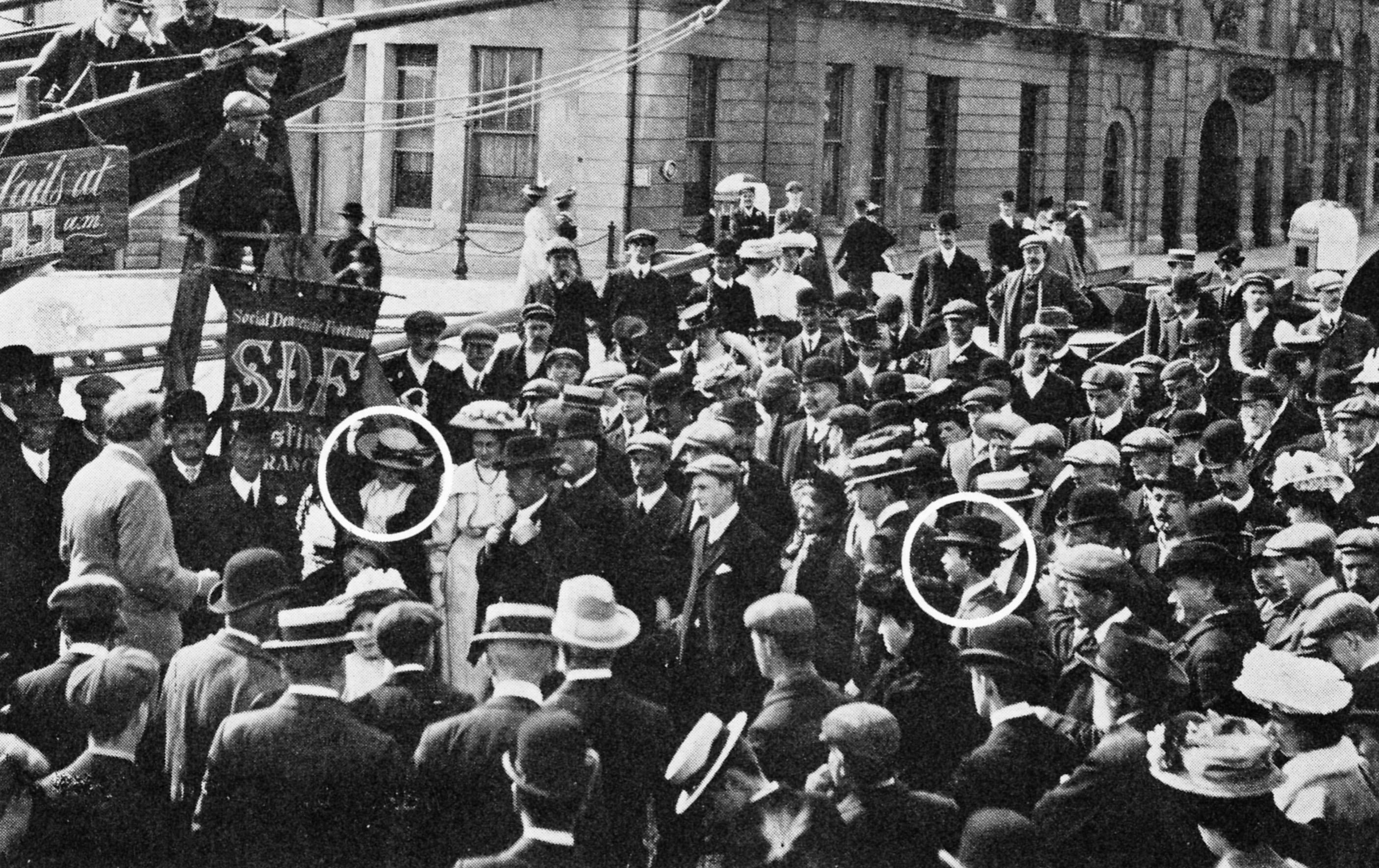
A meeting of the Social Democratic Federation at Harold Place on 20 June 1907. Ringed are Robert Tressell and his daughter Kathleen.
1907 April 16 - The Hastings Labour Party was formed at a meeting in a café at 28 Havelock Road. Leading members of the Marx-oriented Social Democratic Federation supported and joined in the setting up of the party. The Mail said that since February 1906 three parties had been created in the town. 'First we had the National Democratic Federation, which began well but ended feebly; then there was and, we suppose, remains, the SDF, the creation of a company of young enthusiasts who found the milk of the Democratic Federation somewhat watery. ... The latest recruits to the ranks of labour or socialist organisations breathed existence [on the 16th] in the shape of a branch of the Independent Labour Party, and which most of us understand has been created because the SDF milk was too strong for the liking of some of the social ‘upheavers’.' The party’s first candidates to stand in a Hastings Council election, in two wards on 1 November 1907, were unsuccessful.
1907 April 16 - The Weekly Mail of this date reported that the small Hastings fishing boat Our Dick RX 206 was sunk in collision with a torpedo boat destroyer. It was run into by HMS Adventure while anchored about 6 miles to SSW off the coast of Fairlight. Richard Breeds, the owner, was picked up by the Adventure and was disembarked at Eastbourne. Commandant Corbett compensated Breeds for his loss.
1907 June 26 - Hastings and St Leonards were invaded by motor cars and motor men who came from every part of England for the long talked of and eagerly expected automobile meeting arranged by the borough entertainments association in conjunction with the AA and the Motor Club.
1907 July 6 - The Weekly Mail of this date reported that Arthur Du Cros took up residence in St Leonards at 106 Marina, the residence for two years of his father, Harvey, the MP. The Mail warned that this could be a sign of Harvey preparing to stand down as MP. There had been frequent rumours that he would not be the candidate at the next election. This was because he was not a young man, he had made it known he was very tired of Parliament and he was extremely busy with his business interests. 'He has been keeping the seat warm for his son', despite Arthur claiming to be nursing Bow and Bromley.
Harvey Du Cros, MP 1906-1908.
1907 Sept - The last paddle steamer to be owned in Hastings and run from Hastings Pier, the Cynthia, was sold to an Irish company, bringing to an end 23 years of locally-owned steamers. However, steamers continued visiting the pier.
1907 Nov 2 - In the first-ever Hastings Council elections where official Labour candidates took part, the two Labour men (one of them Walter Jones) failed to win. For many weeks before the elections the SDF had held meetings at many places around the town, arousing a lot of interest, but not necessarily support.
1907 Nov 30 - Several processions of the unemployed took place on this day and in early December.
1907 Dec 4 - The Council ‘s Education Committee decided to adopt the Education (Provision of Meals) Act 1906. A ‘Canteen Committee’ was set up, whose duties were to supervise the supply of meals to underfed school children. There were varying views on the extent of the distress, and some councillors questioned the statistics in head teachers’ reports.
1908 Jan 4 - The Weekly Mail said: 'The Winkle Club has not been in existence more than two years and yet already has a membership numbering 100. The club was originally formed with the idea of fishermen holding a jovial New Years Eve together, but with its growth a larger object is to provide a meal for some 300 or 400 children. Mr John Hart is at present the secretary and John Webb the treasurer. A hundred hungry men were served with dinner in the Harbour Shed, decorated with bunting, on Tuesday (31 Dec), while an estimated 750 children were given a good square meal dinner on Wednesday.'
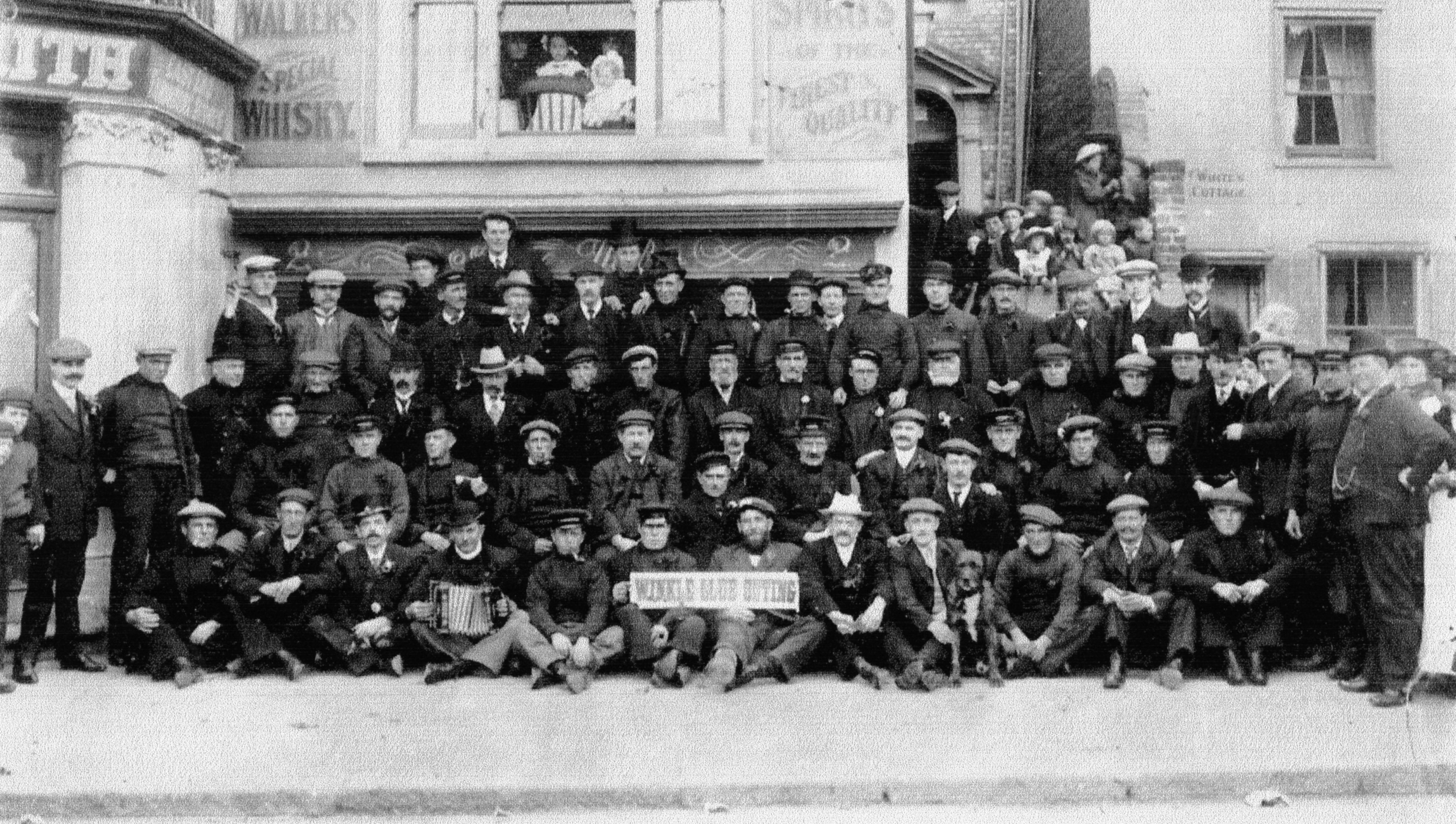
Getting ready for a Winkle Club outing, outside the Prince Albert pub in Rock-a-Nore Road, the Winkle Club's HQ.
1908 Jan 16 - The Hastings magistrates appointed their first-ever probation officer, implementing the Probation of Offenders Act 1907.
1908 Feb 3 - For the first time, Hastings schools started giving out free breakfasts to all children in need, under the Education (Provision of Meals) Act 1906. 'Necessitous' children were being given breakfast at 8am every day of the school week, and this was due to continue until 3 April 1908, starting again on 2 November. Centres had been established at Ore, Halton, Old Town, Silverhill and Hollington. Canteens had been established at Sandown mission room, the Fishermen’s Institute, Halton parish room and Silverdale mission hall. An 'exhaustive record' had to be kept at every school of the numbers of meals, and the number given to each child, and the name, address, income and occupation of the parents, and the dates when meals were given to their children. Forms with this data had to be returned weekly to the Education Committee. Head teachers gave tickets to eligible children at the end of the previous day.
1908 Feb 25 - A lively and hostile suffragette meeting took place in Hastings in the run-up to the Parliamentary by-election on 3 March. The suffragette speakers were the leading national figure Miss Christabel Pankhurst (daughter of Emmeline), Mrs Drummond and Mrs Martel. The Pankhurst family were the leading figures in the militant Women's Social and Political Union (WSPU), called the 'suffragettes', formed in 1903 by Emmeline Pankhurst because of her disillusionment with the moderate National Union of Women's Suffrage Societies (NUWSS), who were known as the 'suffragists'. The suffragettes first meeting prior to the election was at 7.30 on the 25th in Wellington Square. 'Unparalleled scenes occurred.' Hundreds of small boys and youths, together with uniformed and plain clothed police, awaited them when they drove up in a cab, in the rain. There was a large crowd all around the square. When Miss Pankhurst, the third speaker, stepped onto the speech box the crowd surged forward and she was dragged off. A near-riot then broke out and the police had to fight a pathway through the mob to enable the speakers to take refuge in the nearby Castle Hotel. There were two more suffragette meetings in following days. Emmeline Pankhurst, leader of the national movement, gave two speeches at the Royal Concert Hall, Warrior Gardens, on 26 March 1908. She made a powerful speech for equality between the sexes. In the first meeting, in the afternoon, men were denied access, but were admitted to the evening meeting, with many young males at the back of the hall out of sympathy with suffragette demands.
1908 March 3 - In the by-election, Arthur Du Cros succeeded his father as Hastings MP. He had a heavy majority of 1,018 due to the reduced Liberal poll. The vote was: Du Cros, Conservative, 4,495; Robert Vernon Harcourt, Liberal, 3,477. There was no Labour candidate. At the previous election, in January 1906, Harvey Du Cros’s majority was 413 (4,348 to 3,935); it was higher this time largely because of a lower Liberal vote. It had been a snap election, with Harvey only announcing his resignation on 23 February, claiming poor health, although sceptics said he had always only been keeping the seat warm for his son.
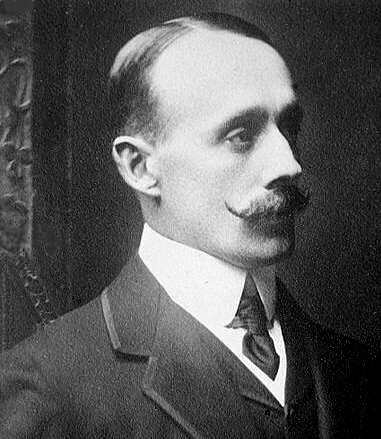
Arthur Du Cros, elected as MP March 1908.
1908 March 28 - The directors of the Hastings Football Club were fined and censured by the Football Association for disregarding FA rules. This followed a match between Hastings and Salisbury, the takings of which 'had not been loyally distributed between the two clubs and a certain sum that should have been handed over to the Salisbury Club had been withheld'. Each director was fined £2 and was severely censured. The FA also ruled that the club’s account books should be properly made up and audited, and submitted for inspection. The FA said some of the directors should resign. The FA had made orders on 6 October 1905 about the way in which the club should be managed, following an inquiry, and these had been broken.
1908 May 1 - At a time of great national demand for allotments, Hastings Council appointed a Small Holdings and Allotments Committee. This followed the passing of the Small Holdings and Allotments Act 1907 (revised 1908), which came into force on 1 January 1908 and required local authorities to provide them if demanded, and it gave them the legal power to compulsorily purchase suitable land. The benefits of the act had been explained to a large audience of working class people in the Silverhill Schools on 17 January, and it was agreed a borough-wide association should be set up. There were already many allotments in the town on privately-owned land, and in December 1908, the Hastings Smallholdings and Allotments Co-operative Society was formed, to take advantage of the beneficial new law. On 12 March 1909 the Council held a special meeting to discuss the committee's report, recommending the purchase of 86-acre Little Ridge Farm, on the Ridge, where the Conquest Hospital is today. Seventy seven acres would be small holdings and the remainder for allotments. But this was rejected, despite recommendations for it from the Board of Agriculture.
1908 June 20 - A subterranean passage or tunnel had been discovered, 71 feet in length, in a garden at 39 St Marys Terrace, West Hill, owing to the removal of a water tank. It extended towards Plynlimmon Road, but did not appear to have formed part of St Clements Caves.
1908 June 26 - Local builders Eldridge & Cruttenden started building the Convent of Our Lady on a large plot at the top of Filsham Road. The nuns took possession on 18 June 1909. From October 1914 to 1917 the Red Cross took some of the rooms for a hospital for wounded soldiers. The Roman Catholic convent and school closed on 10 July 1992, and much of it was demolished and replaced by housing. Actress Julie Christie attended the school.
1908 July 1 - Amongst the local women attending today’s women’s suffrage demonstrations in London were Mrs Harlow Phibbs, Mrs F Strickland, Mrs Darent Harrison, Miss Lettice MacMunn and Miss Beatrice Wilson.
1908 July 2 - The weekly newspaper Hastings Advertiser was relaunched as the Hastings Pictorial Advertiser, containing large numbers of photographs, and continuing doing so until it closed in March 1918. It was owned by Hastings Observer publisher FJ Parsons Ltd.
1908 July 9 - Twenty Hastings street hawkers were prosecuted for causing an obstruction. The Weekly Mail said that the determined efforts of the chief constable and Corporation to keep Hastings free from the obstruction of hawkers would meet with general approval from the tradesmen in the town centre. The prosecution of the hawkers was the direct outcome of a protest made to the Council by tradesmen who occupied highly-rated business premises round the Memorial.
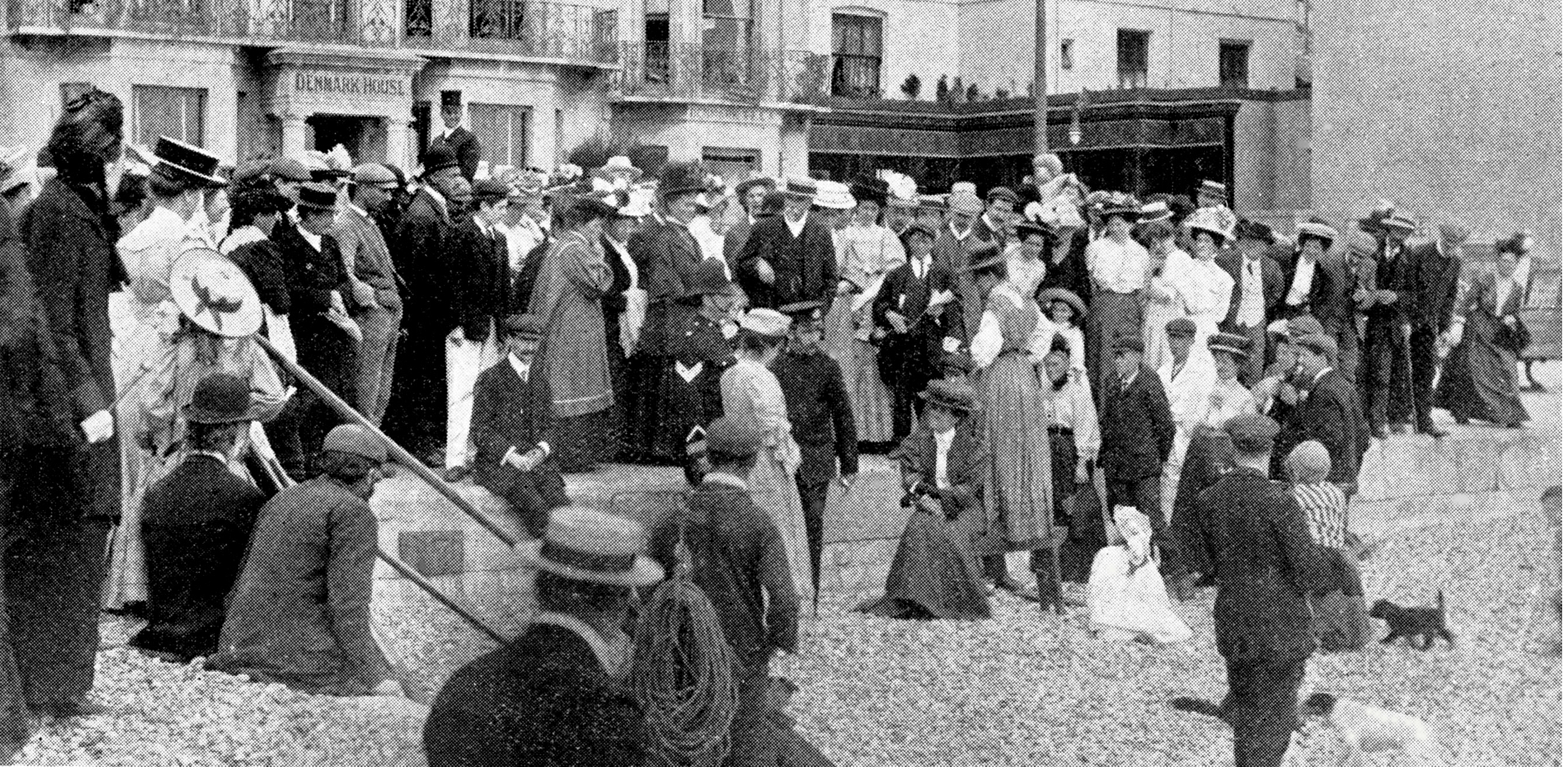
A suffragettes meeting on the beach at Denmark Place in mid-July being disrupted by the police.
1908 Mid July - There was a week’s open air campaign in Hastings by the Women's Freedom League (WFL), a moderate splinter group from the militant Women's Social and Political Union (WSPU), the 'suffragettes'. Using the WFL's Women’s Suffrage Van, the campaign began on Tuesday 14th, and the two orators were the Australian Miss Muriel Matters and Miss Eustace Smith. Miss Matters had moved to Hastings from Adelaide in 1905. A meeting was held at Wellington Square on the evening of 15 July, with no opposition offered. At an open air meeting at the Fishmarket on the evening of the 16th about 30 youngsters surrounded them, to some amusement. The Weekly Mail of 25 July said the campaign continued with a meeting on the 18th at the Market Hall, George Street, where Miss Muriel Matters and Miss Cowen again spoke. A socialist asked 'Why don’t you combine with the socialists and go for universal adult suffrage?' '’When we have the vote ourselves we will do your dirty work, but we have dirty enough work to do now,' Miss Matters replied. The socialist proclaimed 'I don’t believe it, you will get votes for your own class and let your poorer sister, the domestic servant, fight for her own cause.' (Applause) The campaigners concluded the week’s activity on Monday evening 20th by holding a lively open air meeting in Wellington Square. A crowd of several hundred gathered, attracted by a large red flag with ‘Women’s Suffrage’ in white lettering. The meeting had just assumed a lively character when the police intervened and stated that the meeting must be closed in accordance with the bye-law. One lad tried unsuccessfully to tear down the banner and received a reprimand from the Australian Miss Matters and several members of the crowd. Also in 1908 Miss Matters became the first woman to ever speak in the House of Commons after chaining herself to the grille of the Ladies Gallery. In 1924 she unsuccessfully stood in the general election as the Labour candidate for Hastings. She remained in Hastings until her death in 1969, aged 92. Hastings Council's main office building, Aquila House in Breeds Place, was renamed Muriel Matters House in 2016.
1908 July 23 - The leading socialist Alf Cobb was fined 2s 6d at Hastings magistrates court for causing an obstruction in the streets at a meeting of street hawkers he had organised in South Terrace on 10 July. Hastings Council was waging a campaign against hawkers (Cobb was one) because they were taking trade from shopkeepers, and 20 had been prosecuted on 9 July.
1908 Aug 2 - Normanhurst Court, Lord Brassey’s large mansion on a big estate north of Catsfield, was seriously damaged by fire. Lord Brassey’s 60 servants had been trained to serve as firemen if required, and they manned their 60 horsepower steamer, obtaining their water supply from a large reservoir near the covered tennis court. The Hastings, Bexhill and Battle fire brigades were summoned.
Lord Brassey's house after the fire.
1908 Aug 7 - A group of 40 hunger marchers reached Hastings from Bexhill, but the police stopped them proceeding along the seafront. Instead they were forced to go up Boscobel Road, where they stopped for a frugal meal of bread and cheese.
1908 Sept 24 - Old age pensions came into being for the deserving poor. In the following days there was a great demand for application forms, with a large number of them distributed at local Post Offices.
1908 Oct 16 - The Social Democratic Party staged a week’s events in the streets of Hastings and St Leonards in the run up to the Council meeting on Friday 16 October, protesting about the high unemployment. The chief speaker was Tom Kennedy, who addressed a meeting of the unemployed in Wellington Square in conjunction with Mr Cobb on Saturday afternoon 10th. Photos of that meeting show Robert Tressell addressing the crowd. A large audience at the Royal Concert Hall, Warrior Gardens, on 2 December heard the famous SDF founder Henry Hyndman give an address on ‘Socialism and Current Politics’ at a meeting organised by the SDF. The socialists at the end sang the Red Flag in opposition to the National Anthem.
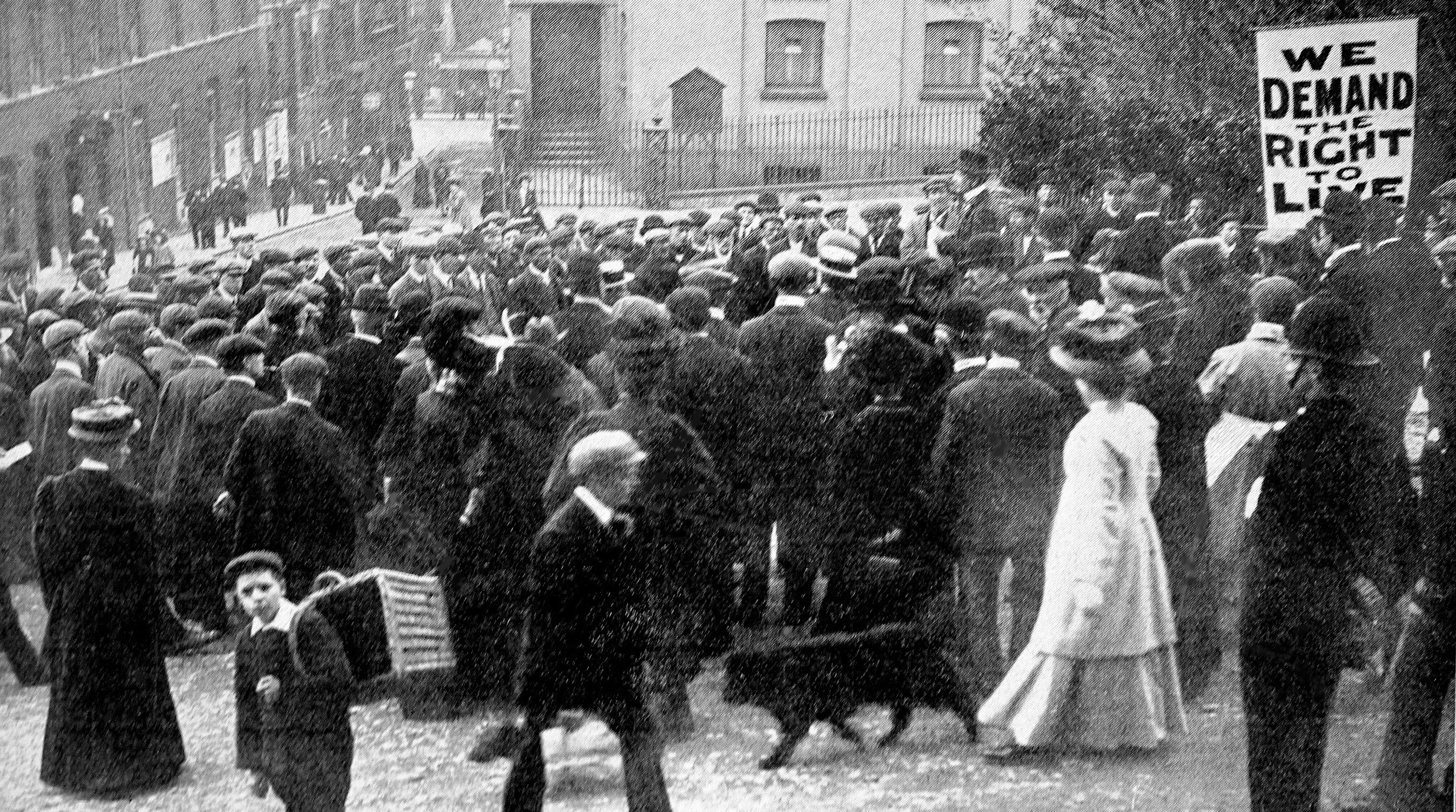
Robert Tressell (below the window on the right) addressing the Wellington Square meeting.
1908 Oct 21 - The Ore Cattle Market opened, next to the Kings Head pub on the Rye Road.
1908 Oct 24 - A new fire station opened in Shepherd Street, on the site originally filled by the Corporation yard. The Kings Road and Mercatoria fire premises had been closed as a result.
1908 Nov 7 - The Weekly Mail of this date reported that there was an early inauguration of this winter’s free breakfasts, with 180 children at the Sandown canteen on Monday 2nd, scantily clothed, pale faced and haggard. There was a diet variety. On Monday, Tuesday and Thursday: half a pint of oatmeal porridge, with a half pint of skimmed milk, an ounce of brown sugar and two slices of bread and butter. On Wednesday and Friday the oatmeal was replaced by bread and a half pint of skimmed milk boiled. An appeal for cast-off boots for school children was still very urgent and had met with but a poor response. The Mail of 28 November reported that on Monday 23rd a large number of poor children gathered at Sandown School in anticipation of the first Ore Penny Dinner, of soup, bread and jam.
1908 Nov 23 - The Hastings and St Leonards Women’s Suffrage Society held a meeting at the Royal Concert Hall.
1908 Dec 2 - A large audience at the Royal Concert Hall, Warrior Gardens, heard the famous socialist Mr HM Hyndham give an address on ‘Socialism and Current Politics’. The meeting was organised by the local Social Democratic Party and was presided over by the Rev TW Jamieson of Park Road Wesleyan Church. The socialists at the end sang the Red Flag in opposition to the National Anthem. The Rev Jamieson said the entire body of our land laws played into the hands of those who ground the faces of the poor, and still the monopoly in land continued.
1908 Dec 5 - An opening ceremony took place at the Buchanan Hospital, London Road, for the ‘new wing’, in a large marquee in the grounds.
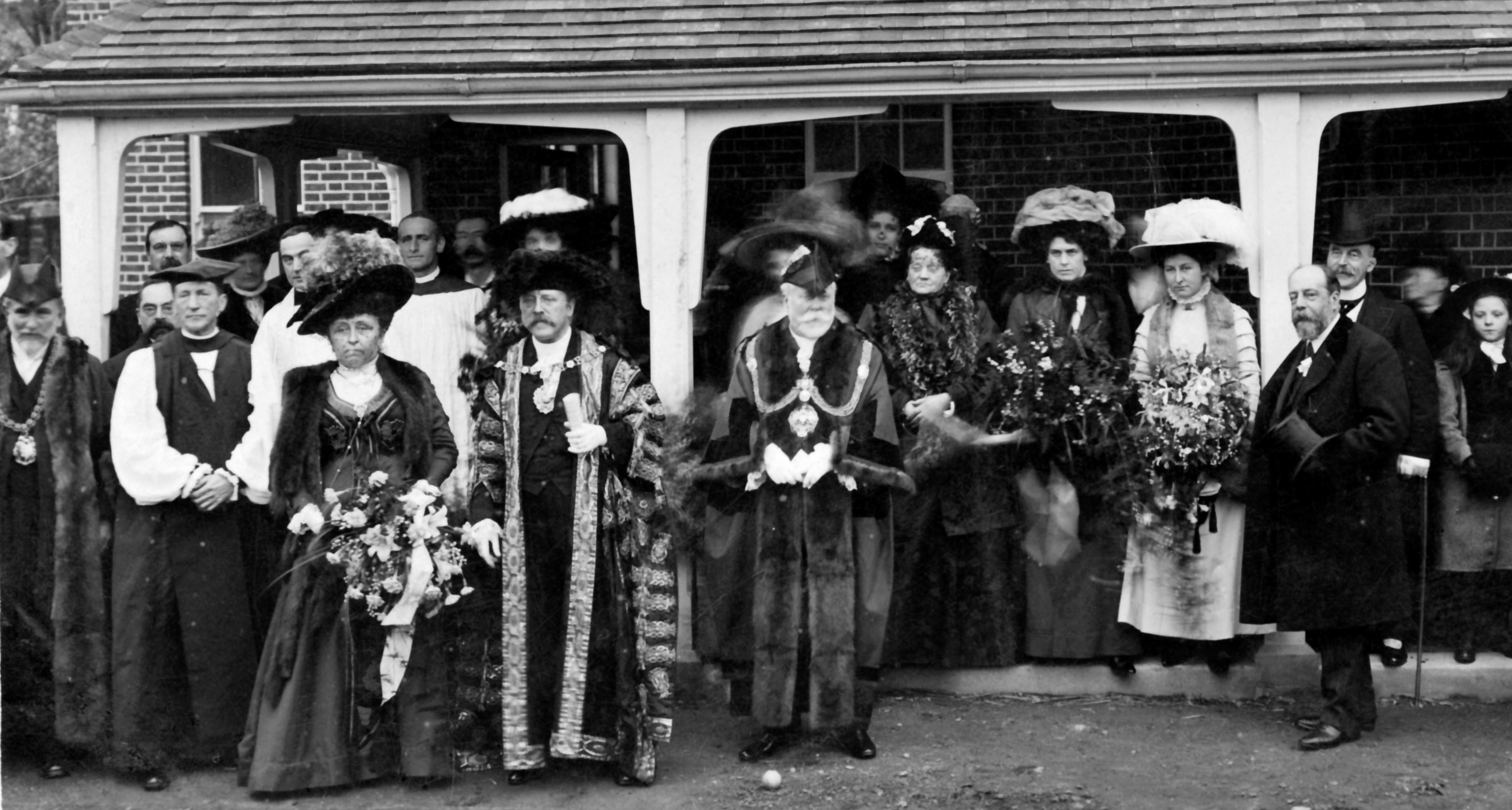
The ceremony at the Buchanan. Tressell is believed to have carried out painting work there.
1908 Dec 16 - The first Hastings Marathon Race was held, and was a great success. The 25 mile race started at the Central Cricket Ground and the 51 runners went via Battle and Sidley, returning along the seafront. Large crowds witnessed the start, with Arthur Du Cros MP firing a pistol. The runners were accompanied by doctors with cars, attendants on cycles and cars containing food and refreshments, including Oxo, who sponsored the event. A silver cup was presented to the winner, Mt WT Clarke, of the Sefton Harriers, who took two hours and 37 mintes.
1908 Dec 16 - An influential deputation of burgesses appeared at the Council Chamber to appeal for the unemployed 'in view of the very exceptional distress prevailing in the borough at the present time'. The deputation was received by less than half the members of the Council present – there was not even a quorum. Many retired from the Chamber on the entrance of the members of the deputation. Mr Boutwood said there were now 927 unemployed registered with the Distress Committee and only 356 had been given work, which, excluding those who had not registered, meant a thousand heads of families were without work, without money and without food. The Weekly Mail of 26 December said that the reception by less than half the councillors, 'whether through indifference or self-satisfied resentment, was nothing short of scandalous'.
1908 Dec 29 - What was thought to be the heaviest snowstorm since 1860 took place, lasting 15 hours. On the same day, a new soup kitchen opened for the first time, in the basement of the Priory Street Institute. It had been started by some ladies and gentlemen, with the help of the Robertson Street Congregational Church, which owned the Institute.
1908 Dec 30 - A Working Men’s Club and Institute was opened at 5 Silverlands Road, Silverhill.
1908 Dec 31 - The Observer of 2 January said: 'Quite a shadow of its former self was the New Year dinner of the Old Town Winkle Club on Thursday evening [31st]. Owing to bad times and lack of funds, the festive gathering merely sat down to an ordinary cold collation at the Prince Albert [pub, Rock-a-Nore Road], instead of assembling for a sumptuous banquet on a gigantic scale in the gaily-decorated Harbour Shed, as heretofore. The function, however, was a very merry and jovial one.' On New Years Day several hundred children from the east end were fed a repast. The Weekly Mail of 2 January said: 'Early in the new year Hastings was again reminded of the existence of a small community calling themselves ‘Winkleites’. They were members of the Prince Albert Winkle Club, which held its second annual dinner in the harbour shed, on December 31st. On the following day about 750 children were fed in the harbour shed, in fulfilment of the club’s chief object – to provide a meal for the poor children of the east end.
1908 Late - Robert Tressell probably began finishing his novel The Ragged Trousered Philanthropists in late 1908, while living on the top floor of 241 London Road, St Leonards. The 250,000 word manuscript was probably completed by the spring of 1910, but he could find no publisher, so he decided to emigrate to Canada. In late 1910 he went to Liverpool to earn money to pay for the trip, but he was struck down by tuberculosis, and he died in Liverpool hospital on 3 February 1911. His daughter Kathleen managed to get the book published on 23 April 1914.
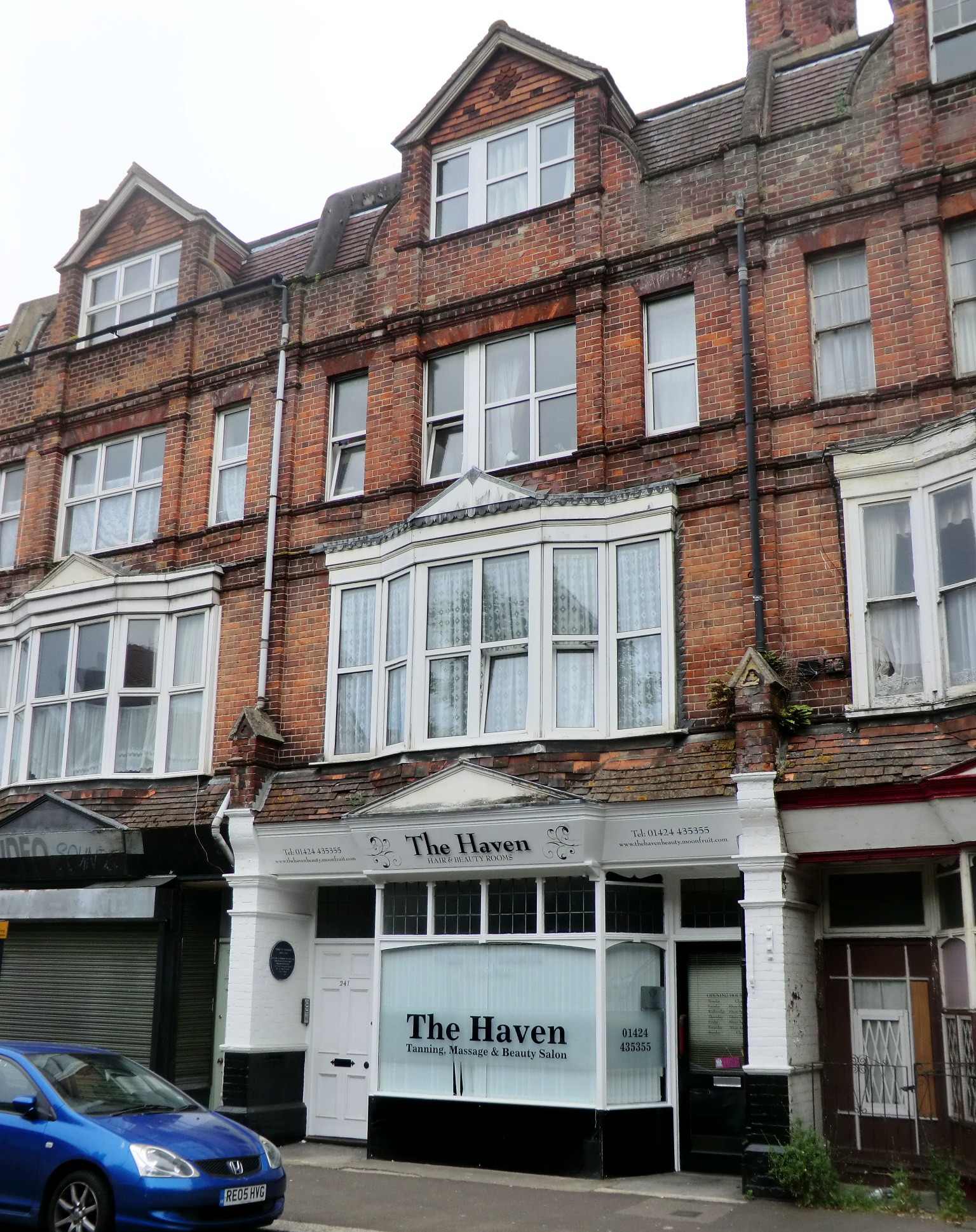
241 London Road, in 2013.
1909 Jan - The first Hastings branch of the new Boy Scouts was formed.
1909 Jan 1 - The Hastings Co-operative Society bakery started operations at 155 Queens Road. The premises, which some time before were occupied by a baker, were already fitted up with an oven and other plant necessary for the making of bread. By January 8 the daily bake had increased to about 200 and was still increasing.
1909 Jan 4 - One the town’s biggest-ever fires took place in the fiver-storey block of buildings occupied by Messrs Holdoway and Tapner, upholsterers, and Messrs Simmonds and Co, cabinet makers, builders and contractors, in Waterworks Road. The premises involved had a narrow frontage onto Waterworks Road, but extended to a considerable depth and were surrounded by shops on the Queens Road side, at the rear by Messrs Charles Crew and Co builders merchants shops, and on the gas works side by the same firm’s yard, stores and works. The front building was originally used as a flour mill. The fire took eight hours to control and caused £7,000 of damage. The blaze was said to be the biggest since the Jenkins fire 17 years before, though some said the Mastins fire in 1904 was bigger.
1909 Feb 11 - Fifty unemployed Ore men held a demonstration outside the workhouse in Frederick Road, and about six of them went inside, but the guardians told them that nothing could be done to help them.
1909 Feb 4 - The Socialists fielded their first-ever candidate in a Hastings municipal or parliamentary election. This was the St Clements and Halton ward by-election, following the death of Tory councillor Richard Idenden. The Conservative candidate, Mr AG Ginner, won with 285 votes; Liberal Benjamen Shoesmith had 272; and Socialist Mr EP Edwards, came third with 86 votes. The Mail said: 'The election, as indicated by the small poll, was a very quiet affair, the bad weather no doubt accounting for a great many of the absentees. … The election campaign has cause but little interest in the ward.'
1909 March 13 - In a big public meeting, the Hastings and St Leonards Women’s Suffrage Society (formed in 1883) affiliated itself to the moderate National Union of Women’s Suffrage Societies, the 'suffragists'. The well-attended event took place 'in a high state of excitement' at the Royal Concert Hall, Warrior Gardens, with Dr Flora Murray of the National Union as the main speaker. The campaign opened by passing a resolution that the borough MP would be asked to present a petition seeking votes for women to the Commons very shortly. One speaker urged the members to send a deputation to the MP’s house. Mrs Strickland chaired the meeting. Mrs Tubbs, the veteran president of the local society, was ill and apologised for her absence.
1909 March 13 - The Weekly Mail of this date reported that the American Roller Skating Syndicate had recently transformed the Royal Concert Hall in Warrior Gardens into a first class skating rink.
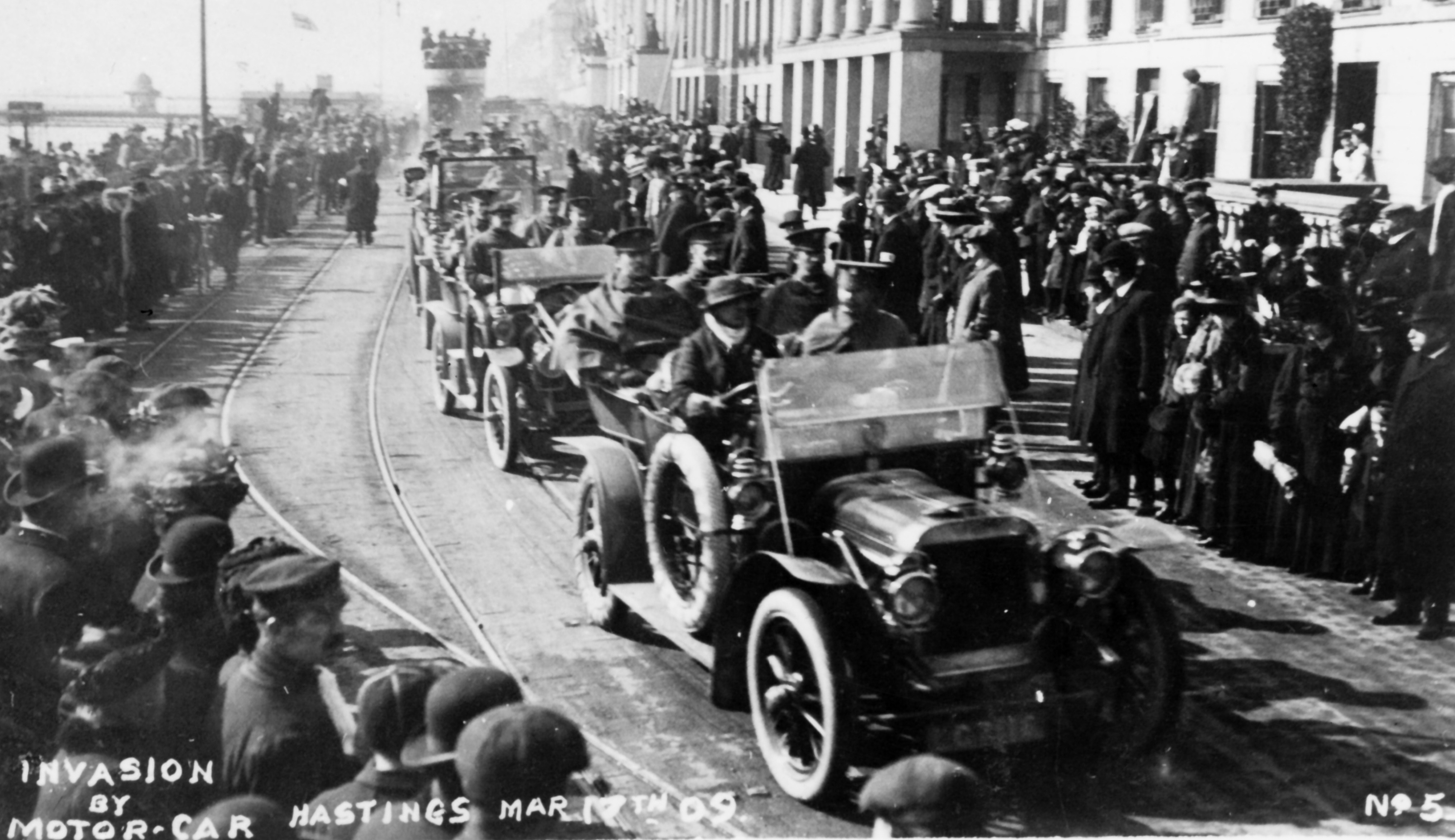
The 1909 invasion!
1909 March 17 - Hastings MP Arthur Du Cros organised a significant and successful experiment in the movement of troops. He, along with the Automobile Association, conveyed a thousand-strong battalion of armed and equipped Guards from London to Hastings in over 400 vehicles, in 3-4 hours. This was the first-ever large-scale mechanical transport of troops by anything other than trains, proving the potential of cars. War minister Mr Haldane had told the House of Commons on 4 March that Hastings had been chosen for the important exercise because 'the only successful invasion of this country has taken place at Hastings'. Du Cros had major investments in the motor business, from which he made his fortune. He entertained the officers at the Queens Hotel. The spectacular event brought international publicity to Hastings, the streets were thronged and many buildings were decorated.
1909 April 1 - The ‘American Syndicate’, also known as the Rinkeries, took out a lease on St Leonards Pier and carried out big improvements. It reopened on 23 May 1909 as the ‘American Palace Pier’ (but usually just called the ‘Palace Pier’). The whole pier was painted and decorated, a new restaurant was built on the south side of the pavilion and six ornamental kiosks were erected, each accommodating three shops. About 4,000 lamps were fixed all over the pier, making it a big attraction in the evenings. In July that year a new pavilion was built as a roller skating rink at the seaward end of the pier. But in the spring of 1911 the Rinkeries suddenly surrendered its lease, which was then taken over by a small group of local people, who ran the pier until 1917.
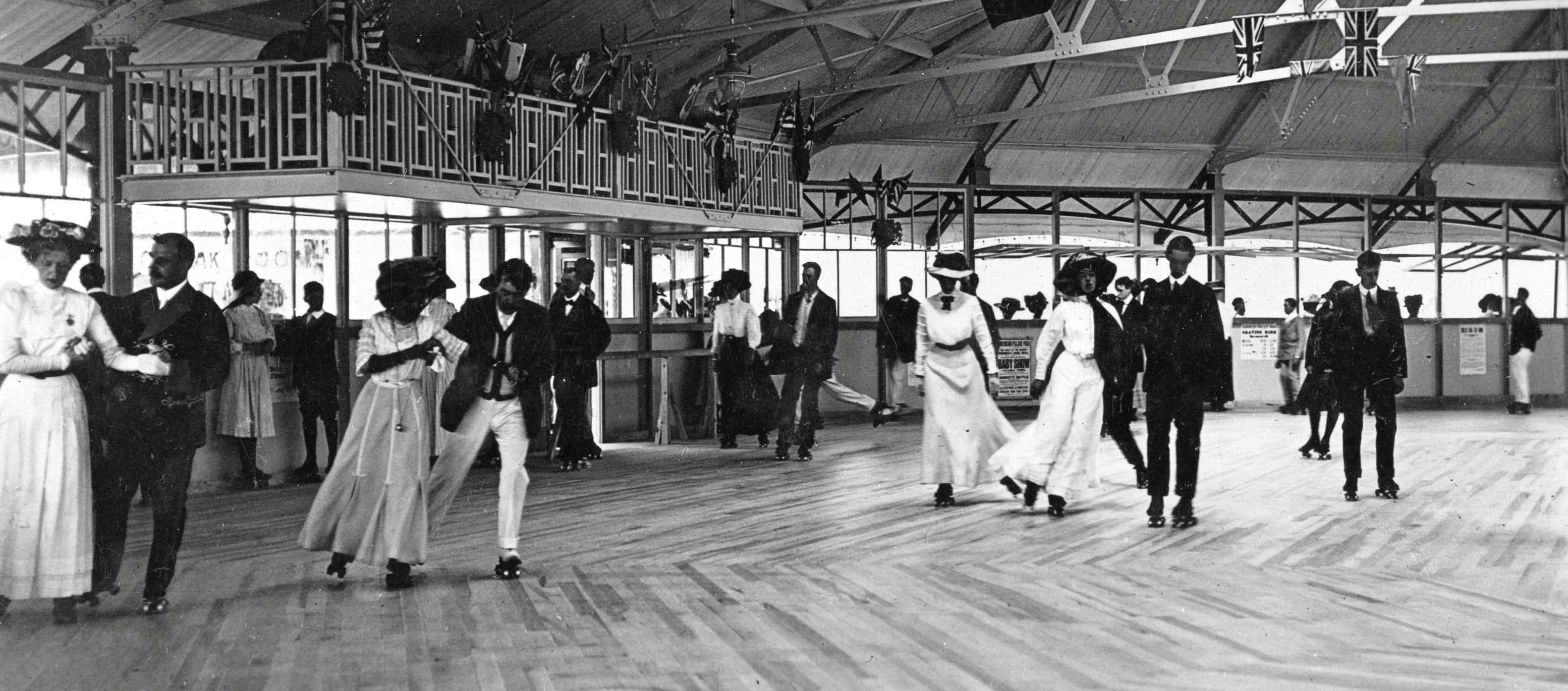
The new roller skating rink on St Leonards Pier.
1909 April 17 - The Weekly Mail of this date reported that a disappointed man had been living in solitude for some 12 or 14 years in a rock cavern on an allotment on the west side of Ecclesbourne Glen. He was a tall man with long grey hair, abundant side whiskers, a heavy grey beard and a moustache, and was clothed in the ordinary manner and not as had been said in ‘red-skins’. His allotment was the last but one of about five when walking inland through the glen in the direction of the little bridge and ascent, and it possessed a large rock cavern which was in grim reality ‘The Hermitage’. The other allotment gardens were worked by fishermen and others who were only occasionally in the glen.
1909 April 18 - A woman was killed in jumping from a moving tramcar, the first tramway death. Miss Annie Eliza Marchant, living at 22 Salisbury Road, Bohemia, struck her head on the stone curbing, by Grosvenor Gardens. She had jumped off the car while it was coming to a halt. She was a domestic servant at 141 Marina.
1909 April 19 - The local Women’s Suffrage Society held a mass meeting at the Public Hall, Robertson Street, on Monday 19 April, under the presidency of Mrs Strickland. Prior to the start of the speeches, the Women’s Suffrage Choir, under Mrs Harlow Phibbs, sang spirited suffrage songs. The main speaker was Mr Philip Snowden [he was the prominent Labour MP for Blackburn, who was the first Labour Chancellor of the Exchequer in 1924; her maiden name was Ethel Annakin]. Also on stage was Mr W Baillie-Weaver, a barrister, of the Men’s League of Women’s Suffrage. It was a lively, well-attended meeting, with only a few anti-suffrage interruptions.
1909 July 13 - FJ Parsons Ltd, owners of the Hastings Observer and many other publications, was fined £150 for putting in their Folkestone Directory material pinched from the Pike's Directory of Folkestone since 1899. Sunny South Press paublished many annual Pike's directories along the south coast, including the Hastings edition which started in 1876. The company's manager was Charles Mepham, who lived in Ore.
1909 Aug 30 - Ore Cemetery, in Winchelsea Road, closed because it was full, was in very poor condition and did not have funding for maintenance.
1909 Nov 27 - Mrs Stricklands explained the work of the local suffragists in a series of ‘At Homes’ arranged by the committee of the Hastings and St Leonards and East Sussex Women’s Suffrage Society, held on Saturday afternoons, starting this day, at their newly opened depot at 29 Havelock Road (the Misses Barrow and Field milliners shop). The president was Mrs Colonel Tubbs. The organiser of the society was Miss L Shrimpton (lately assistant secretary of the NUWSS), with the acting honorary secretary being Miss E Mary Young. There was a large attendance at the Havelock Road Depot on 21 December when Miss Ruth Kenyon gave a lecture on ‘Women’s Suffrage and Unemployment’.
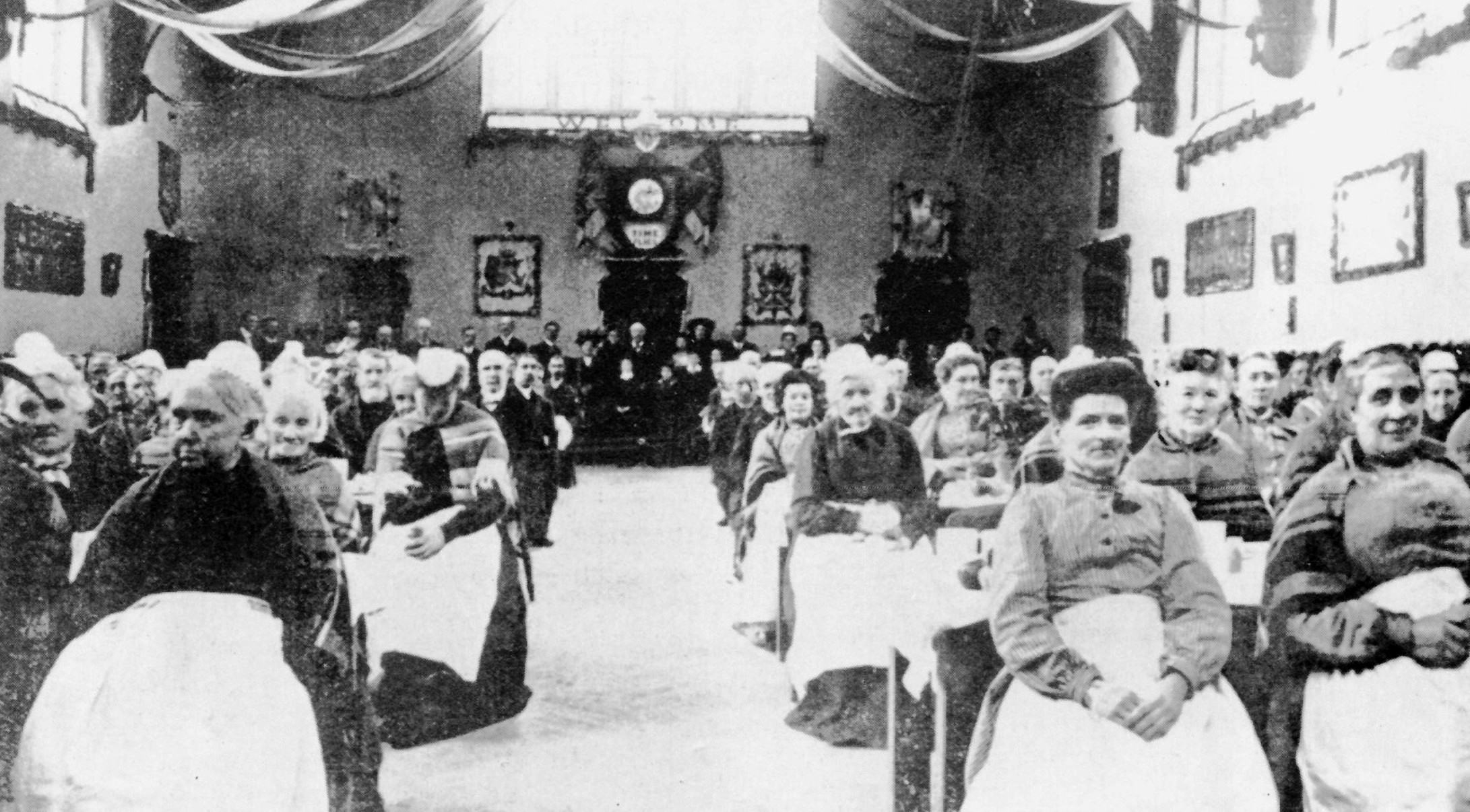
1909: Christmas Day at the workhouse, in Frederick Road, Ore.
1909 Dec 31 - A new act of Parliament required the medical inspection of schools, hand the first such inspection took place in 1909. Its report said that, of the 8,610 children in the borough's 23 schools, 1,881 (about 22%) had been examined. It found that 330 of these were below normal nutrition, and 12 showed signs of starvation. Over half had defective teeth, 765 had enlarged tonsils, 29% had adenoids, and one in six had nervous instability. Of 306 children whose eyesight was inspected, 44% were 'in urgent need of spectacles'. Schools had started giving children free breakfasts in February 1908, and Hastings Council's inspecting officer said that this had been a great success. In many cases children who had seemed to be mentally defective had 'become happy, intelligent beings'. Free breakfasts were necessary because in Hastings there was 'no staple industry for the employment of male labour, and also the very large number of unemployed.' The Ore Penny Dinner Fund gave free meals to children.
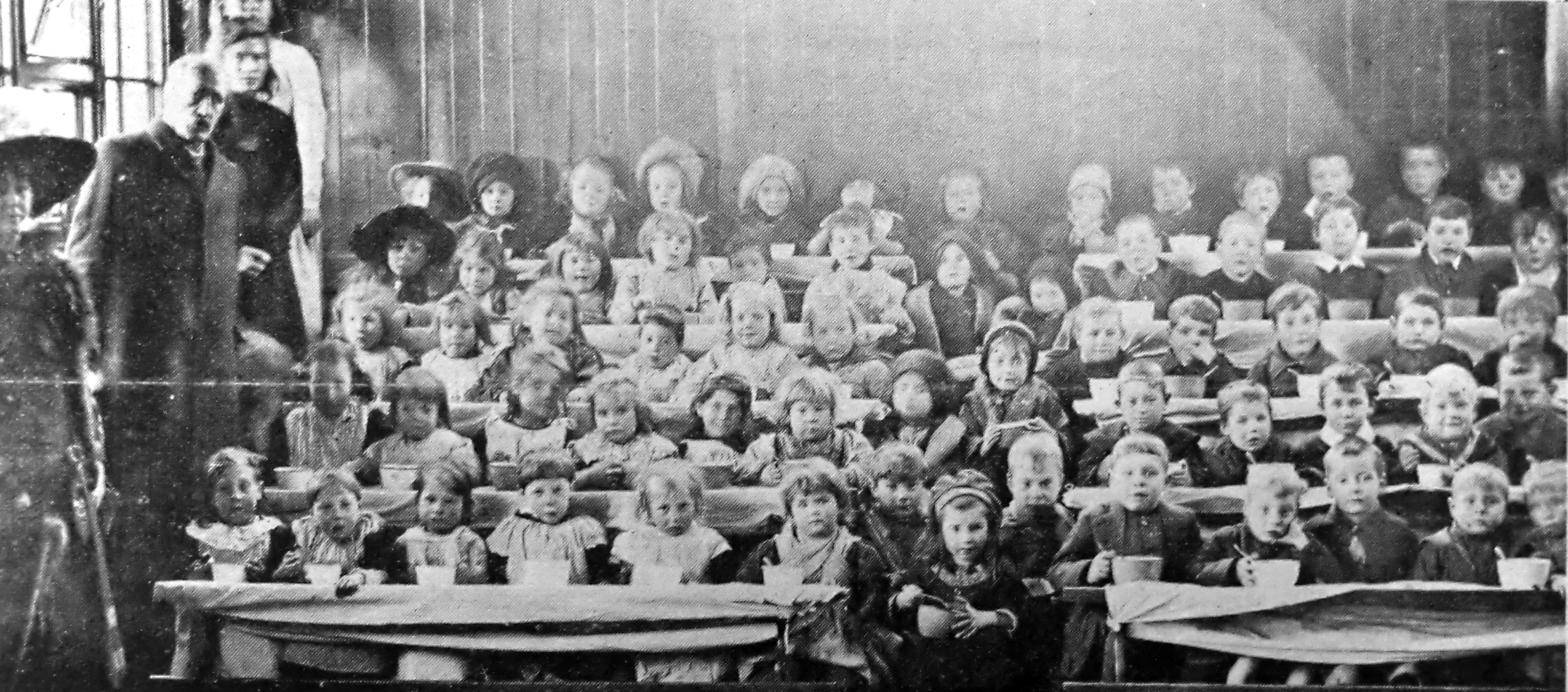
Arthur Du Cros MP at an Ore Penny Dinner Fund meal at Sandown School in early December.
1910 Jan 3 - The local Women’s Suffrage Society had an opponent of their own sex Miss Helen Boulnois to a debate with Miss Mildred Ransom, one of their own champions.
1910 Jan 15 - The general election polling day resulted in a Tory victory: Arthur du Cros 4,634; Liberal Ronald Tweedy-Smith 3,833. The majority was 801, a reduction of 217 from the by-election of 2008. There was no Labour or SDP candidate.
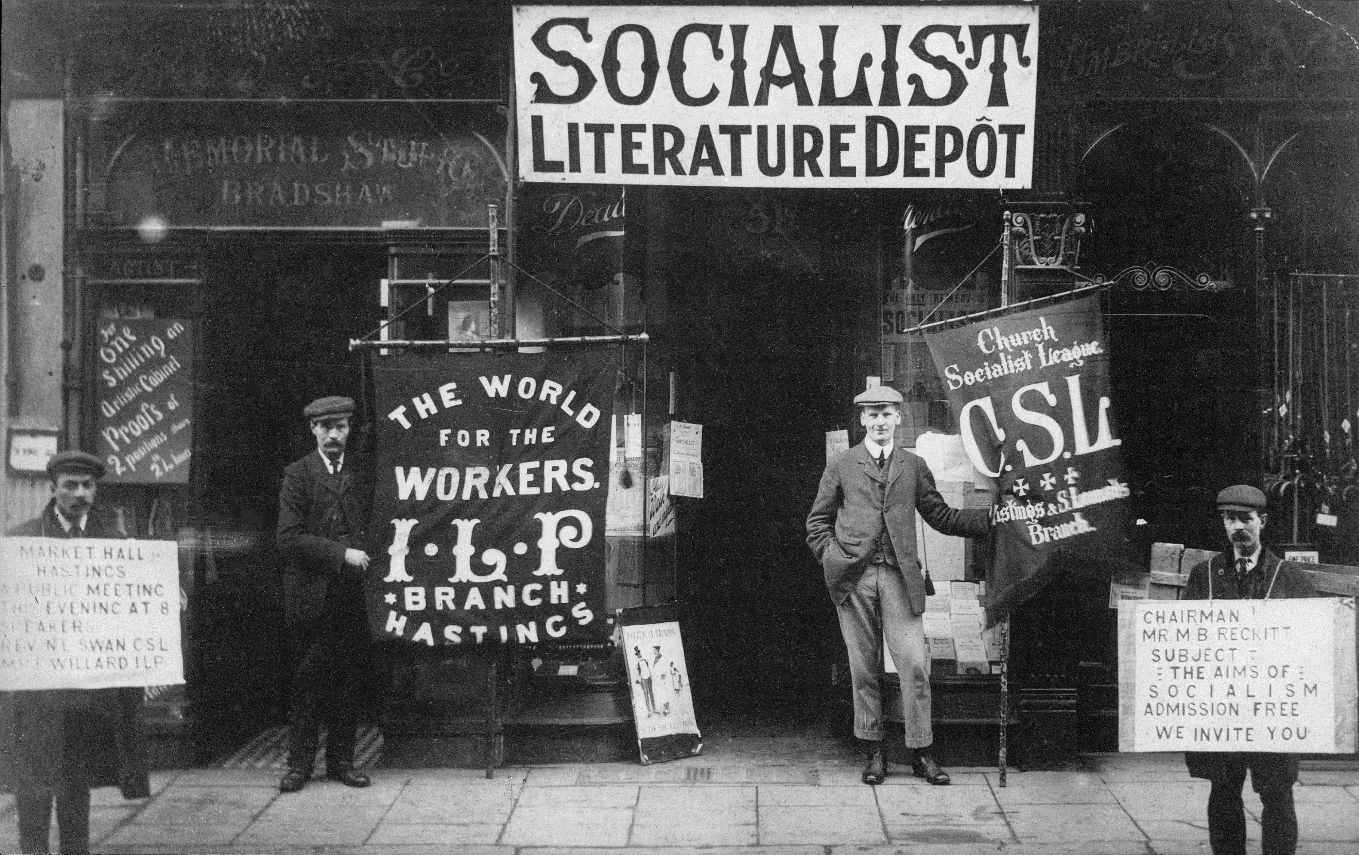
Campaigners just before the 1910 election, at 51c Robertson Street.
1910 Feb 1 - The town’s first Labour Exchange opened, at 37 Havelock Road. On the first day, about 170 unemployed people signed on, mostly men in the building trade. It was part of a new Board of Trade scheme.
1910 Feb 4 - Sir Ernest Shackleton RN gave two lectures about the South Pole in the Public Hall.
1910 Feb 28 - A men’s branch of the Hastings and St Leonards Women’s Suffrage Propaganda League was formed.
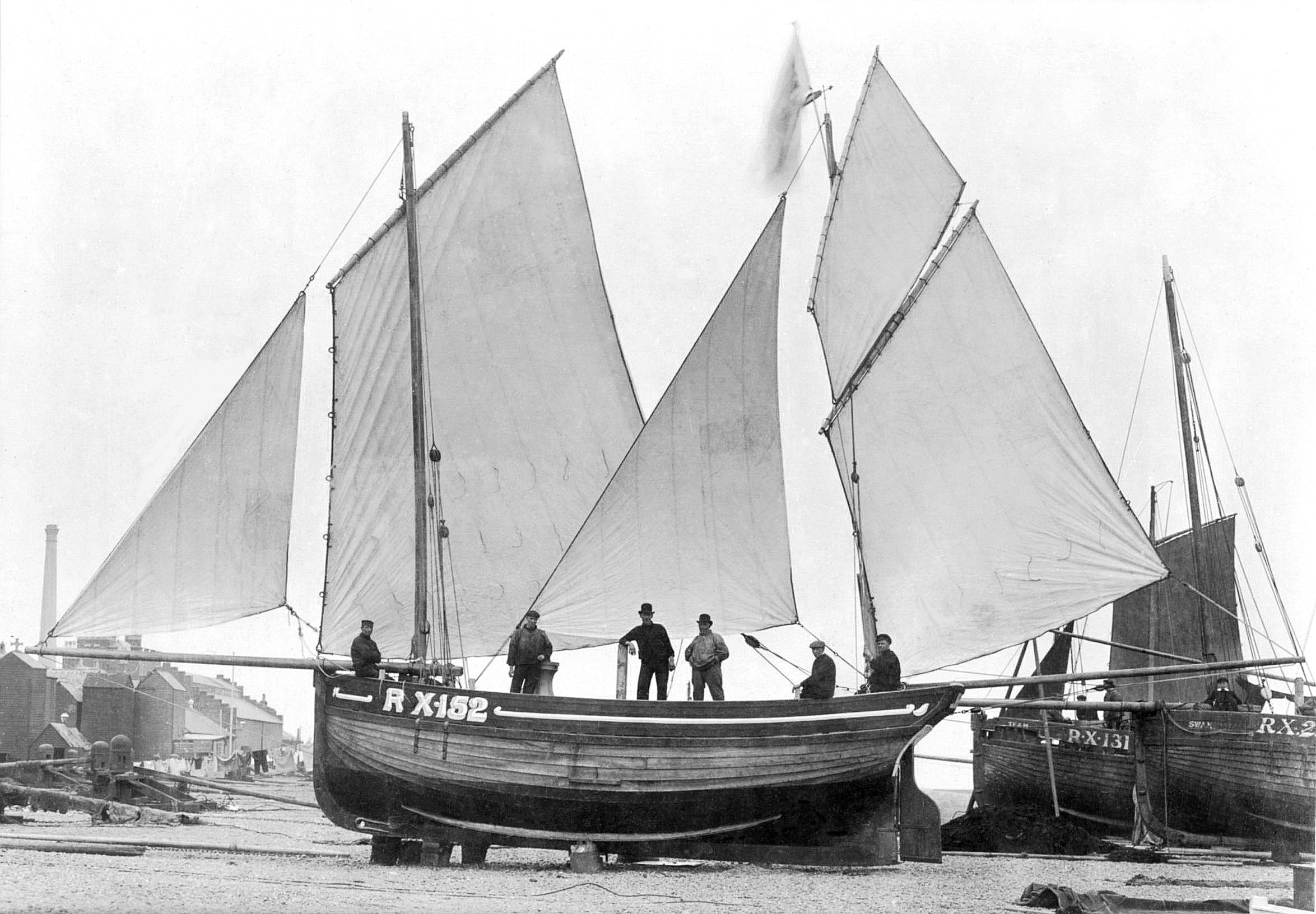
The EVG fully rigged.
1910 April 26 - The new fishing boat EVG RX 152, built at Hastings, was launched by Mrs Arthur du Cros at Rock-a-Nore. A thousand people watched the grand ceremony, the first of its kind since the launch of the Lady Brassey in June 1886. The skipper was 'Woolly' Tassell, who said the initials stood for Edward, Victor, Grace.
1910 May 7 - The Weekly Mail reported that there was 'a very decided wave of emigration passing over the community'. Many young men were going to Canada and some to Australia, but very few to South Africa or New Zealand.
1910 May 31 - Death at Rock House, Exmouth Place, of Dr Elizabeth Blackwell, the first woman ever to graduate in medicine (in 1849) and the first woman to be placed on the British Medical Register. She moved into Rock House in May 1879. She became well-known locally, but never loved Hastings, saying in 1885: 'In Hastings my work has hitherto been discouragingly checked by the coldness of the people - I suppose because I don’t go to their hypocritical churches and chapels.' She was buried near Glasgow.
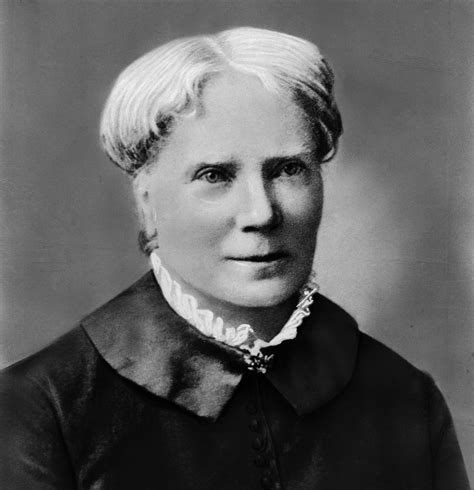
Dr Elizabeth Blackwell.
1910 June 18 - Mrs Elsie Mabel Picknell, a young married woman, whose husband was employed on the golf links, attempted to jump off Hastings Pier after the loss of two of her infant children. She was rescued and placed in the care of the police.
1910 June 25 - The Weekly Mail of this date reported that in April some concern was felt for the safety of the Lovers Seat at Fairlight Glen after a landslide, but the fallen cliff had since then been entirely rebuilt.
1910 June 30 - An aged fisherman was found hanged: Thomas Veness, who lived with his son and daughter-in-law at 37 North Terrace, Halton.
1910 Summer - The first significant new building to go up on Hastings Pier since it was built in 1872 was the American Bowling Alley, erected in the summer of 1910 roughly a third of the way along the pier. It was used as a cinema from November 1912 to December 1913, and then had a variety of uses. It was integrated in the major development all over the pier in the 1930s, but its roof, with a dome in the middle of it, survived until being destroyed in the 2010 fire. A large joywheel roundabout was put up next to the seafront promenade, opening on 12 November 1910. It was removed in the autumn of 1914. A shooting gallery, with ‘animated pictures’ (films) on show and amusement machines, was built near the pier's pavilion in the winter of 1910-11.
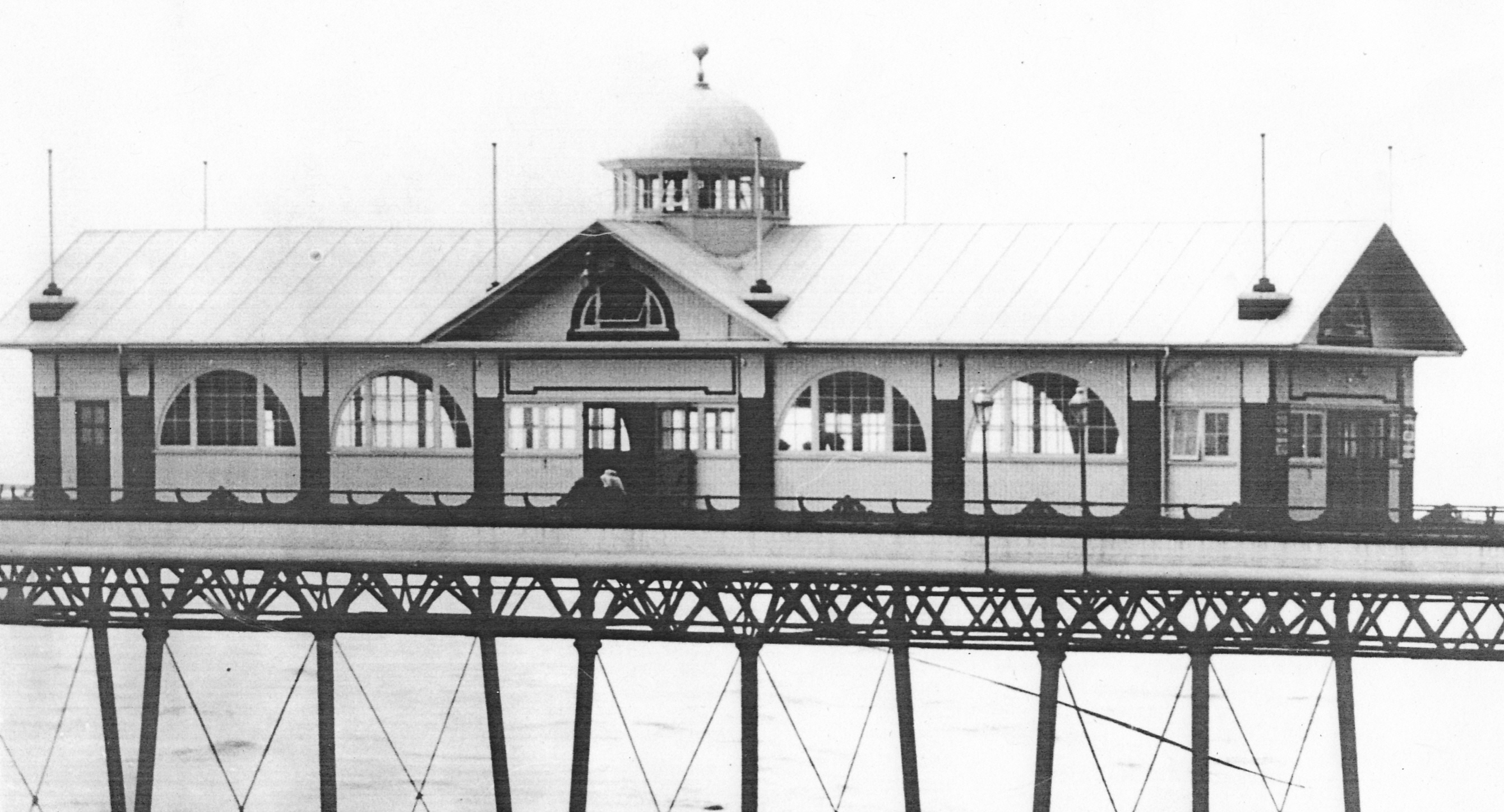
The new American Bowling Alley.
1910 Aug 20 - The Observer of this date reported that open air meetings had been held in Hastings by the women's suffrage movement.
1910 Sept 24 - A visit of the Women’s Social and Political Union began this day with the arrival of Mrs Mary Clarke, a sister of Mrs Pankhurst. A poster parade advertised the coming Wednesday (28th) meeting at the Royal Concert Hall, Warrior Gardens, with the chair taken by the Hon Mrs Haverfield, and Mrs Pethick Lawrence to be the principal speaker. Mrs Clarke was already well-known in Hastings as an able and effective speaker. She was expected to hold beach meetings at the Fishmarket and Warrior Square pitches. Her headquarters would be at 5 Grand Parade.
1910 Sept 29 - A horse attached to a laundry van was electrocuted by treading on one of the studs on the tramway surface contact system in Robertson Street. The van belonged to Albert Catt of 34 Bohemia Road.
1910 Oct 6 - A meeting of the tramway employees decided to oppose at the forthcoming municipal elections any candidate who was not in favour of the overhead power system for the seafront. Hastings Corporation was condemned for insisting on the Dolter system on the seafront. The Tramway Company were unable to pay a dividend owing simply to the losses incurred on the seafront system. It was a danger to the public and would never be a success, however much money was spent. One tram on the seafront cost as much as five fully loaded cars on any other line, even if they were going up the steepest hill.
1910 Oct 29 - The radical national magazine Justice, weekly journal of the Marixst-oriented Social Democratic Party, published a story saying Hastings councillor and caterer George Cox was selling butter, when actually it was margarine. Despite this being true, he successfully sued editor Henry Quelch for libel in November 1911, and the £200 damages bankrupted Quelch.
1910 Nov 1 - At the municipal elections, the leading Hastings socialist Alf Cobb was defeated by Mr FW Morgan in the St Clements Ward by just 31 votes (394 to 361). Cobb was lifted shoulder high by the crowd of supporters, waving a very crushed bowler hat. Then dramatically there appeared from nowhere a procession headed by a large white banner with the one word ‘Morgan’ and brought up by a brass band playing See, the Conquering Hero Comes. Cobb took advantage of the procession and joined in at the rear. He was followed by a large crowd and turning up Wellington Square he proceeded to climb the electric light standard in the centre of the road from which vantage point he proceeded to address the crowd. Holding onto the lamp standard with one hand and with a flushed face he called his opponent names and made reckless statements concerning him.
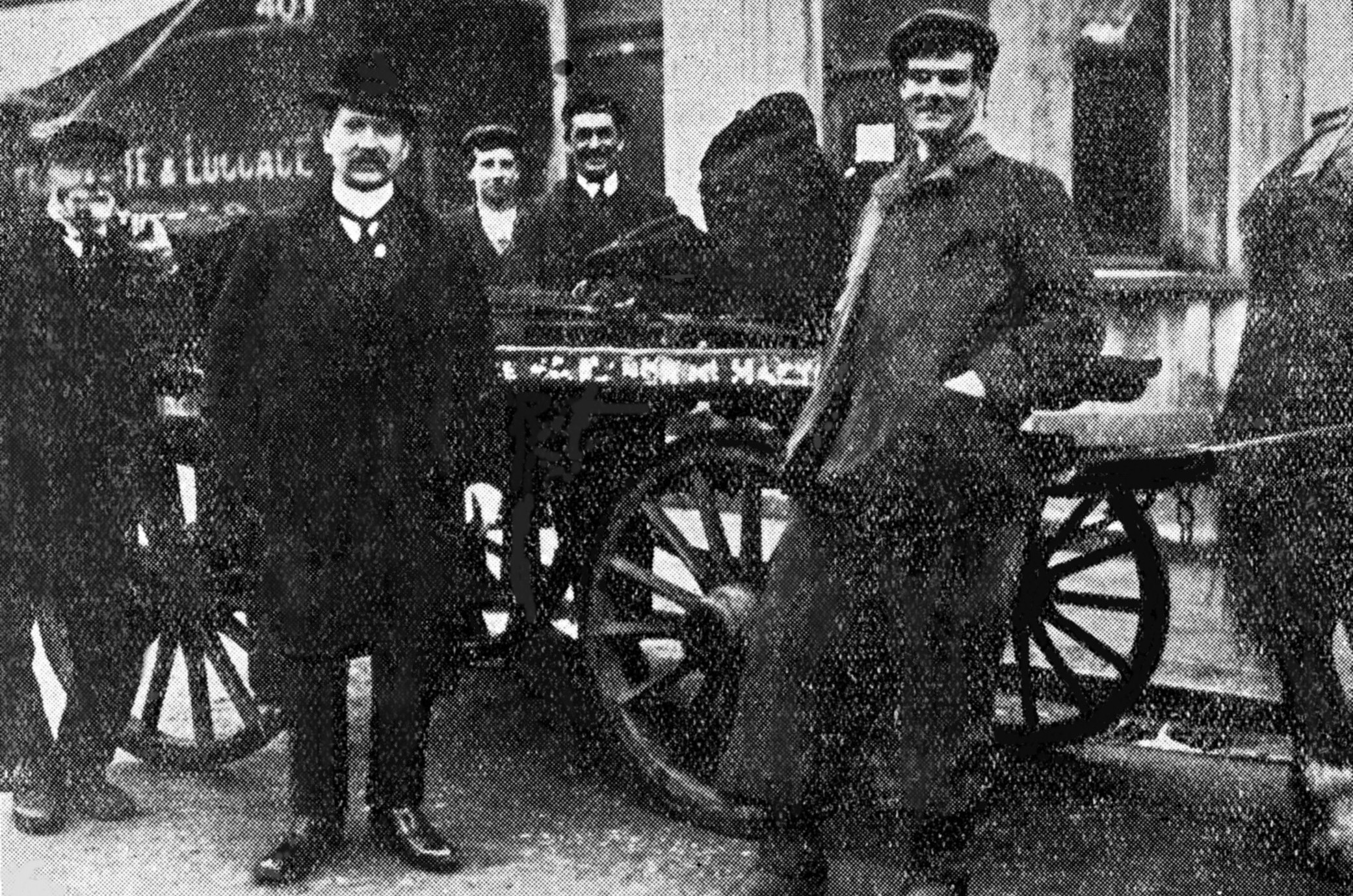
Alf Cobb seeking votes in the elction.
1910 Oct 31 - The Hastings and St Leonards Women's Suffrage Propaganda League held its first AGM at its headquarters, 5 Grand Parade. Lt-Col AR Savile was in the chair and there was a large attendance. The main concern was campaigning for the passage of the Women's Suffrage Bill, then before parliament, into law in the coming session. The Observer reported that 'The keynote of the meeting was of quiet confidence and steady determination.'
1910 Nov 1 & 3 -Lord and Lady Brassey held two women's suffrage meetings at their large London residence, 24 Park Lane. Many distinguished guests were at both meetings. On the 1st, the main speaker was Mrs Pankhurst, founder of the militant Women's Social and Political Union, who said that women had now travelled a long way on the road to complete emancipation. The speaker on the 3rd was Mrs Henry Fawcett, president of the moderate National Union of Women's Suffrage Societies. Lord Brassey spoke at both meetings, saying how he was very sympathetic to women's suffrage, and was encouraging it, but was still undecided about what should be the result of the movement. He suggested a referendum.
1910 Nov 19 - The Hippodrome music hall in Pelham Place, built 1899, became the Cinema de Luxe. The Weekly Mail said that as the Hippodrome it had seen days of the direst distress. Never since the late director-manager Mr Fisher died had it worn the prosperous glow of old, and the building had just been restored to a state of brilliance and comfort probably never known before - the palatial rendezvous, newly carpeted, fresh, bright and grandly illuminated, was to be conducted as a picture palace, such a one as Hastings had never seen. It was taken over by a powerful company on a long lease. Today it is the De Luxe Leisure Centre.
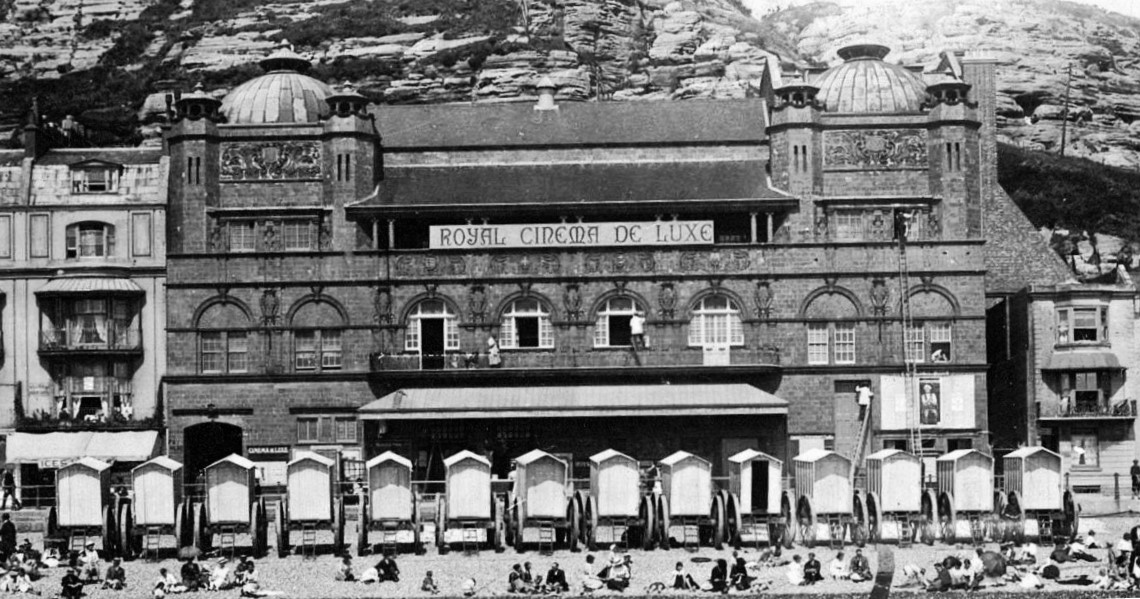
The Cinema De Luxe, c1911.
1910 Nov 28 - The Hastings Boy Scouts were inspected by General Sir Robert Baden-Powell in Alexandra Park.
1910 Dec 3 - Arthur du Cros won the Hastings Parliamentary election by a majority of 882 over his Liberal rival Arthur WF Johnson.
1910 Dec 6 - Socialist Alf Cobb failed by a small margin to win the Upper St Marys Ward in the municipal by-election. After the announcement of the result at the town hall, Cobb was lifted shoulder high by an enthusiastic crowd and proceeded to make a procession through the main streets, delivering numerous addresses at street corners.
1910 Dec 14 - Ben Tillett, secretary of the Dock, Wharf Riverside and General Workers Union, visited Hastings under the auspices of the Social Democratic Federation. He addressed a meeting at the Public Hall, speaking on the Atrocities of Modern Capitalism.
1910 Dec 17 - The Weekly Mail of this date published details of artist Holman Hunt at Fairlight in the summer of I852, painting his famous picture Strayed Sheep on the cliffs.
1911 Jan 10 - A large and influential meeting was held to consider the question of starting a branch of the National League for Opposing Women's Suffrage. A branch was subsequently formed and a committee appointed.
1911 Jan 21 - The Observer of this date reported that some workmen had banded themselves together under the mysterious name of The Nutmeg Club to provide hungry children with a tea once a year.
1911 Feb 11 - Hastings was visited by an Canadian Emigration Agent, describing the real prospects in living in Canada.
1911 March 22 - Lady Brassey became a member of the Hastings Women’s Suffrage Society. The Observer of 8 April reported that suffragists had 'nullified' the national ten-yearly census by spending the night in a shop and an empty house to avoid filling in the census form.
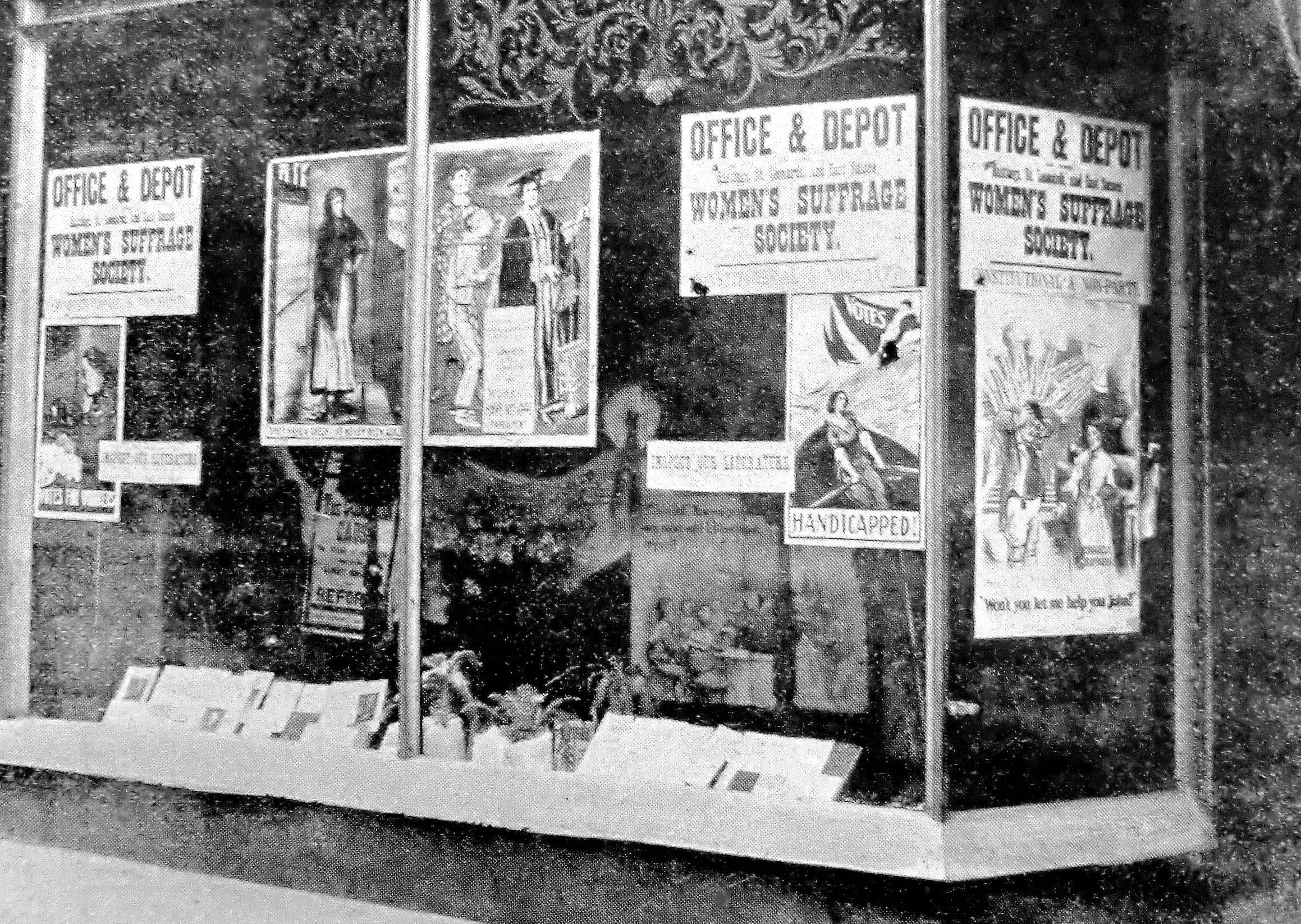
The Women's Suffrage Society base in Havelock Road.
1911 April 15 - The Weekly Mail of this date reported that emigration was becoming a serious problem. Hundreds more people were leaving Hastings each year and the total for last winter exceeded that of any other like period. The majority were going to Australia, with a few to Canada. Passages were assisted by the Central Aid Fund, the Distress Committee and the Workhouse Guardians.
1911 April 24 - The great Suffrage Campaign, organised by the Local Women’s Suffrage Propaganda League, opened at their headquarters, 5 Grand Parade.
1911 May 13 - The Observer of this date reported that Alf Cobb, leader of the Social Democratic Party, held a meeting on the seafront at Denmark Place in protest at a new bye-law being passed, preventing any such meetings being held there.
1911 May 20 - The Weekly Mail of this date reported that Hastings harbour was falling to pieces. The first slab of concrete in the harbour had cracked away and lurched heavily like a ship in a gale, to westward. 'Unless something is done it is probable that Hastings Harbour will not exist in its present state this time next year. Once this block of concrete has fallen the whole foundation of the structure will be undermined. … The fishermen are not viewing the prospect with pleasure - huge blocks of concrete lying about the coast will constitute a constant menace to their vessels.'
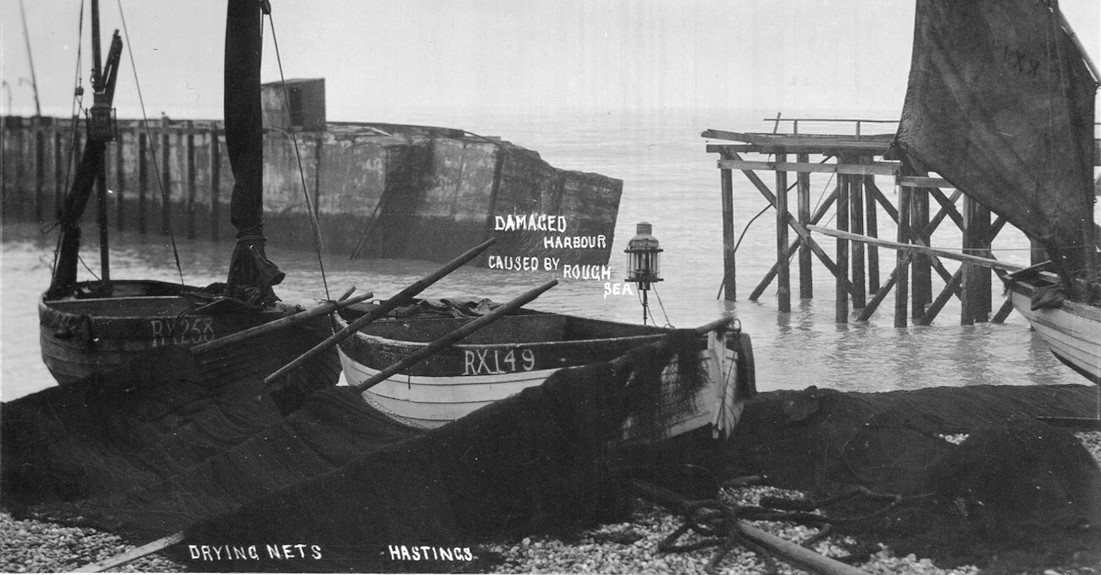
The storm damage to the harbour in 1911.
1911 May 20 - The Weekly Mail of this date reported that the 1911 census showed a reduction in population since 1901. 'Hastings is the only town of any importance on the South Coast that has suffered this reduction during the past ten years.'
1911 May 27 - The Observer of this date reported that Lord and Lady Brassey had supported the women suffragists in Hastings, and Lord Brassey also talked about national defence.
1911 June - The White Rock Baths were taken over by the Marine Baths and Recreation Company.
1911 June 17 - The Weekly Mail of this date reported that Adjutant Slee was arrested in Guildford on a commitment order from Hastings magistrates. Slee was in charge of the local Salvationists during the recent trouble over the new beach bye-law. He was jailed for three weeks. Alf Cobb continued his campaigning on this and other issues. He was freed from Lewes Gaol on June 24 and given a great reception at Hastings, where more Salvationists were in breach of the bye-law. The bandmaster of the Salvation Army, Calber Jeffery, was summonsed for giving an address at the prohibited part of the stade at Denmark Place on June 25. A fine of 30s plus costs was imposed on July 6, but he refused to pay.
1911 June 20 - Lord Brassey was given an earldom by the new king, George V.
1911 July 3 - It is believed that this is the first day on which a flying machine was seen over Hastings when many of them passed over the town to compete in the Great Race across Europe.
1911 July 8 - The Observer of this date reported that women suffragists had said that if they could not get the vote then they would pay no tax.
1911 July 16 - The largest gorse fire which had occurred in Hastings for many years broke out on the East Hill. In early August more gorse fires took place on the East Hill, between All Saints Church and High Wickham, and at a haystack belonging to Hickman Brothers standing in a field near Beaulieu.
1911 July 18 - A man claiming to be a personal friend of the late Cecil Rhodes, the founder of Rhodesia, was arrested in Hastings for begging. The respectably-dressed Frank WL Priestley said he was a 'pioneer of Rhodesia', and pleaded innocence because of unique, one-off circumstances that had left him temporarily without money. The chief constable said he appeared to be a man of considerable education. He was discharged.
1911 Aug - The great strike of the dockers, carmen, railway workers etc in mid-August affected Hastings seriously by cutting supplies to shops etc. On 18 August the members of the Hastings and St Leonards branch of the Amalgamated Society of Railway Servants held a meeting at the Beehive Dining Room to consider their position re the strike, but took no action. At the end of the month a fund was set up to reward the Hastings railway workers for not taking part.
1911 Sept 13 - The highly respected Hastings businessman Mr Frederick W Womersley, aged 72, was shot dead in his office at 56 Cambridge Road. He had been the secretary and general manager of the East Sussex Permanent Benefit Building Society for 22 years. He was shot in the head by Joseph James, a chemist of Nelson Road, in a dispute over items Womersley had sold at too low a price. He was charged with murder. On 20 September Detective Inspector Edward Orlando Chantler shot himself in the mouth with the same revolver used by the prisoner James in shooting Mr Womersley. Chantler was found dead in a cell at the Central Police Station, Town Hall. He was supposedly worried over the Womersley case. The funeral of Womersley took place on 25 September. There were new witnesses at the resumed inquest. The accused’s daughter gave evidence before the bench. Joseph James was committed for trial at Lewes Assizes in December, where he was found to be insane.
1911 Oct 13 - Three more arrests of Salvation Army officers took place for speaking at Denmark Place. There had been many arrests of Salvation officers for this offence in previous months, with several being jailed. The three were released from jail on 29 November and a welcome home demonstration was held in the Army’s Iron Fort in St Andrews Square, conducted by Commissioner Higgins, the Chief Officer of the Salvation Army throughout the UK.
1911 Oct 16 - The annual general meeting of the Women’s Suffrage Propaganda League took place at the Vita Studio, Royal Concert Hall, Warrior Gardens. On 15 November a Women’s Suffrage Rally took place in the Public Hall, Robertson Street, with an emphatic call for the vote.
1911 Late Oct - Ben Tillett, leader of the London Dock Strike, addressed an open-air meeting in Wellington Square organised by the Social Democratic Party in the run-up to the local elections on 1 November. Alf Cobb stood for a seat, but was soundly defeated.
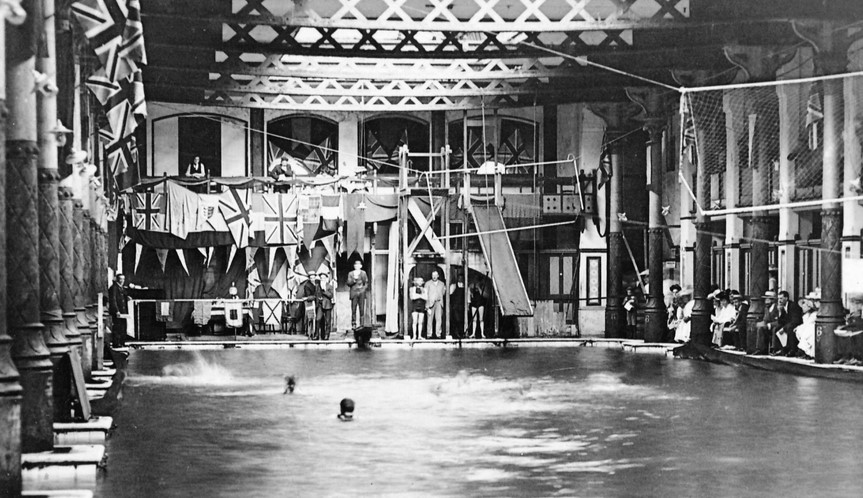
The White Rock Baths before the First World War.
1911 Nov 30 - The 35-year old Public Baths and Aquarium Company was wound up. The chairman Harry Northey reported that the company had built the White Rock Baths, which he believed was still the largest covered swimming bath of tepid water in the world. The company had recovered from the sea the promenade at White Rock, and had widened the road there. He said none of this would have happened without the support of Earl Brassey, who had donated almost half the capital.
1911 Dec 23 - The last issue of the Hastings Weekly Mail and Times was published on this day. The loss of this radical Liberal newspaper gave the Conservative Observer a virtual monopoly of the Hastings media until the Hastings News was launched in 1973.
1912 Jan 8 - There was a big suffragette rally at the Public Hall in Robertson Street, organised by the Hastings Branch of the Women's Social and Political Union (WSPU) and by the Women's Suffrage Propaganda League. The meeting voted to oppose the proposal to introduce a Manhood Suffrage Bill, and called on the government to carry next session a bill conferring equal voting rights on men and women. At the weekly WSPU meeting on 15 January at the Trinity Street HQ, the organiser, Miss Bowker, appealed for at least 20 suffragettes to take part in the next London demonstration, probably taking place in February. There was much pro and anti suffragette correspondence in the Observer at this time. The WSPU's headquarter from 1911-12 was 8 Trinity Street, but it was too small for the very busy party, so in 1912 the WSPU moved round the corner to 8a Claremont.
1912 March 4 - Severe gales struck Hastings, causing much damage to the promenade’s wall, and flooding shops and houses along the seafront.
1912 March 11 - The Observer of this date reported that the big bakery in Castle Hill Road, Messrs Feaist and Co, had modernized their bakery to make bread using electrical equipment.
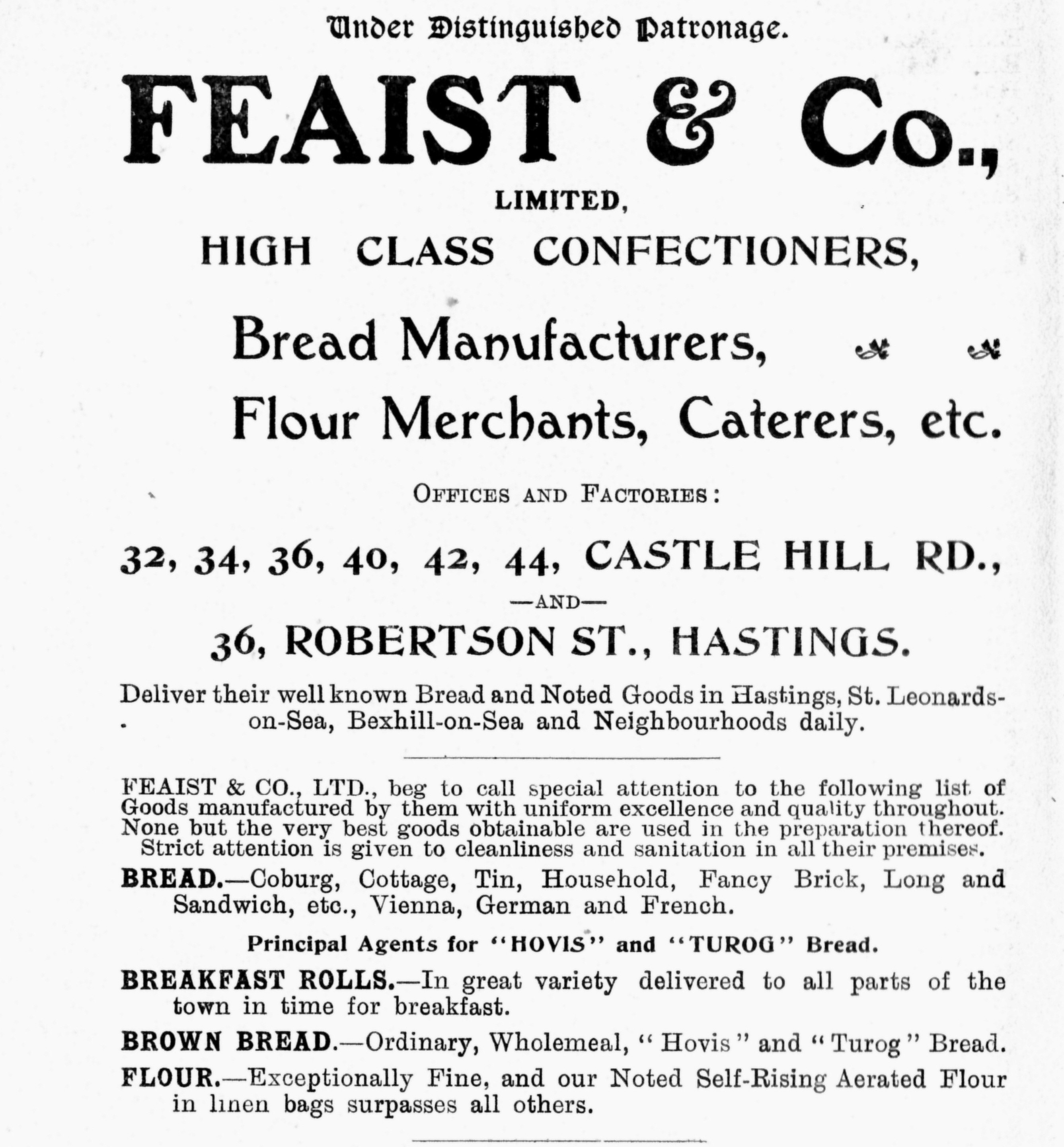
1912 March 16 -The big P&O liner Oceana sank a few miles off Hastings following a collision with the German barque Pisagua. Two days later eight bodies and much wreckage were washed up along the Hastings and St Leonards beach. Captain Hide, captain of the Oceana, had lived in De Cham Road, St Leonards, until mid-1910.
1912 April 6 - William Gower, a well-known clerk working for Hastings Council, was jailed for three months for embezzling £6 8 shillings from the rates section of the Council's accounts department. He was very drunk at the time, as he was suffering from rheumatism and stress .
1912 April 19 - The Council threw out a proposed scheme to repair and complete the harbour. The project was said to be financially and commercially unsound.
1912 July 13 - The Observer of this date reported that in the course of excavations on the East Hill near the lift, for drainage purposes, a number of human bones were discovered. This was near where possibly Saxon bones had been found some years before.
1912 Aug 24 - The Observer of this date reported that Arthur du Cros MP said he would be retiring and not seeking Parliamentary election because of his father’s ill health.
1912 Aug 27 -Council permission was given for the conversion of the Grand Hotel at Verulam Place into flats. The owners said 70-80 men would do the job over the next four months. It had been a first-class hotel from 1883 to 1907, when 'it fell into bad times. The furniture was sold and the premises dismantled.' Since then attempts had been made to get the hotel on its feet again. Mr Plummer and had taken the building on a lease and would convert it into residential flats.
1912 Sept 28 - The Observer published a report condemning the latest proposals for paying for the completion of the harbour. But in October a poll of the public voted in favour of it.
1912 Oct 14 - Charles Gray, who had just served two months hard labour for assaulting Lloyd George, came to Hastings and gave a talk to the Womans Social and Political Union (WSPU). He described how, at a meeting in London, he had attempted to ask Lloyd George to explain his views on women's suffrage, but was himself assaulted and then charged.
1912 Oct 17 - The fishing sailing lugger Enterprise RX 278 was launched, after being built on Hastings beach for Tom and Jack Adams. She is now the main exhibit in the Fishermen’s Museum in Rock-a-Nore Road.
1912 Nov - A big suffrage meeting was held in the Public Hall in Robertson Street, where the main speaker was Emmeline Pankhurst.
1913 March 19 - The Freemasons signed a contract to buy the St Leonards Assembly Rooms, behind the Royal Victoria Hotel, where they were to establish a Masonic Temple. The Freemasons had been seeking a Temple for many years, and the purchase would be completed in April. They intended to improve the building and make it widely available for social events, meetings etc.
1913 March 22 - The gales which hit the town were said to be the worst in 30 years. There had also been severe storms and flooding on 22 October 1911 and 16 December 1910.
1913 April 15 - Three weeks after Hastings MP Arthur Du Cros’ moved out of his former residence Levetleigh on the corner of Dane Road and Brittany Road, the large mansion was almost completely destroyed in a fire started by militant London suffragette Kitty Marion, aged 35. Arthur's father Harvey had moved in there in early 1906, soon after his first election as Hastings MP. The house, one of the largest in St Leonards, was built about 1890, and was empty at the time of the fire, which was started around 2am. It had been the scene of many large-scale Du Cros social functions. After the fire Du Cros said he had always been a convinced opponent of women's suffrage and would continue to be.
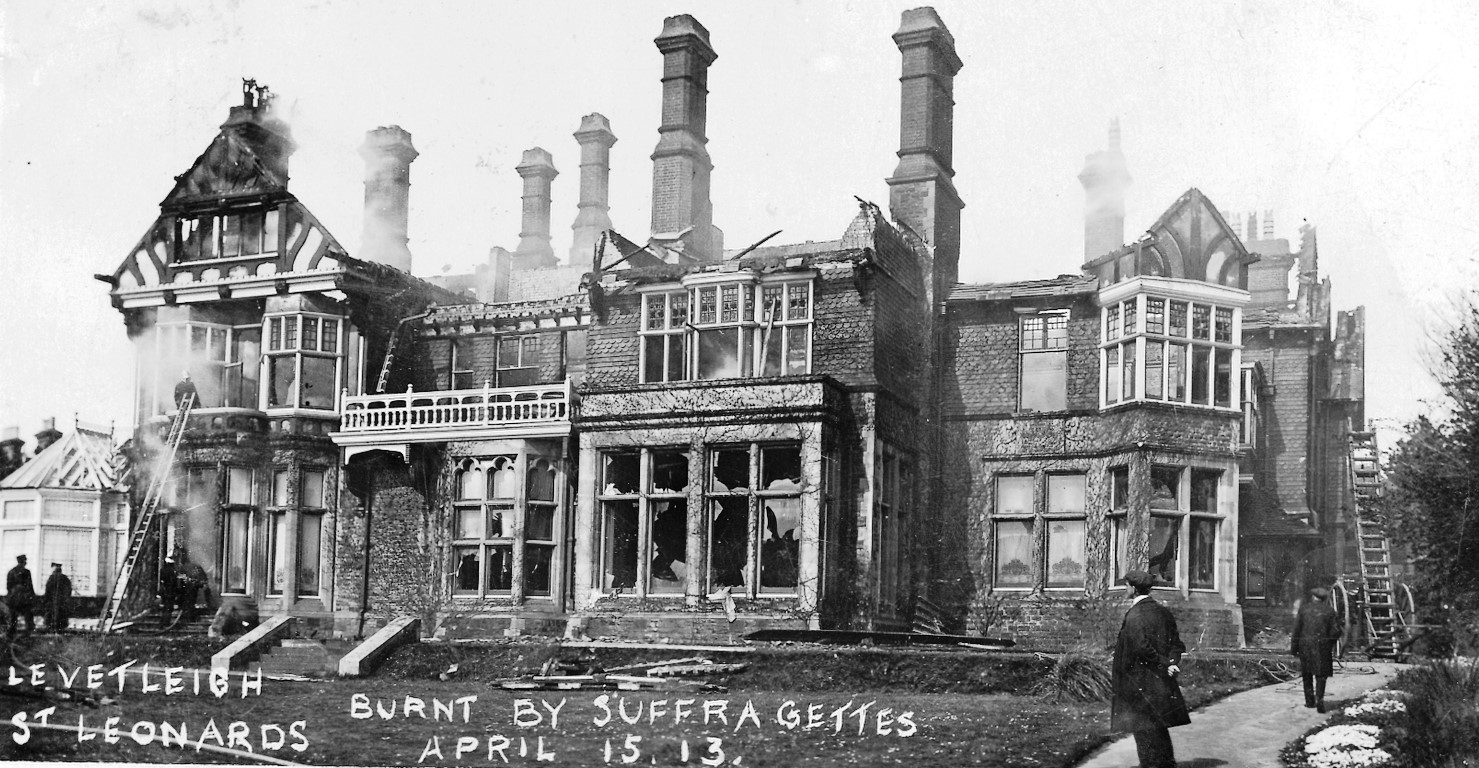
1913 May 13 - Hostile and violent crowds attacked a procession of suffragettes who were protesting at the sale of goods taken from women refusing to pay taxes without representation. A large crowd of anti-suffragettes tried to stop the Tax Resistance march, from the home of Mrs Darent Harrison at 1 St Paul's Road. Police forced a way through the aggressive opposition as the procession went along the seafront to the Memorial and then back to St Leonards. There many attacks on the women, with repeated attempts to tear off their hats and other clothing. Most of the banners were dragged away from them. The attitude of the anti crowds in the town centre was very threatening, and in Norman Road where the sale was due to take place, one of the women's carriages was overturned. A suffragettes meeting was scheduled to be held in the Royal Concert Hall in Warrior Gardens that evening, but had to be abandoned when violent crowds barred entrance to the building. The women inside could not leave safely until far into the night.
1913 May 20 -There were disorderly near-riot scenes around the town centre when it was thought there would be an open-air suffragettes meeting in Wellington Square. This did not happen, so many hundreds of anti-suffragettes surrounded the Suffrage Club in Havelock Road, where an ordinary meeting was taking place. When women tried to leave the club several of them were assaulted, one was robbed and the police had to battle with the violent crowd. A big public suffrage meeting, chaired by Earl Brassey, was scheduled for 12 June but was postponed on police advice because of the recent serious disorders. The Observer at this time was running a weekly column headed 'Women's Suffrage'. The Observer of 1st and 22nd November published a detailed report of the county court hearing on the 20 May disturbances, when the suffragettes successfully sued the Council for compensation to be paid to a pub landlord for damage caused by the rioters.
1913 July 24 - The Public Hall Cinema opened; prior to that, it was the multi-purpose Public Hall, between Robertson Street and Havelock Road. In 1930 it was renamed the Plaza, and then from 1948 the Orion (pronounced Oh-ryon). On 30 September 1940 it was hit by a bomb, killing 14 people and seriously injuring 12 others. It closed in 1979.
1913 Sept 24 - Death of Rev William Carlisle Sayer-Milward at Fairlight Place, born 7 August 1837. He had inherited the Sayer-Milward family estate when his brother Edward died in 1890. William moved to Hastings in 1891 and became associated with many charities in the Old Town, and showed great interest in the preservation of the East and West Hills and their use by the public. He frequently preached in local churches and had made a handsome donation towards the site of All Saints School [now Dudley Infants]. The school's foundation stone was laid on 6 March 1913, and the school was dedicated by the Bishop of Lewes in late September that year.
1913 Nov 5 - The mayor opened the town’s first purpose-built cinema, the Kinema Palace, in Norman Road, with seats for 650 people. The Observer said 'The new building embodies all the latest improvements in the matters of ventilation, lighting, furnishing, fitting etc.' A new departure was that auditorium was not the usual tunnel shape, but square. The mayor said that he 'strongly believed that pictures had come to stay and formed a harmless sort of environment'. The Kinema was enlarged and renamed the Curzon in 1952. It closed in January 1977. On 27 November 1913 the new 700-seat Silverhill Picture House opened on the corner of London Road and Beaufort Road. It had the 'latest devices of cinematograph art' and 'special heating apparatus'; tickets cost from 3d to a shilling. It was renamed the Roxy in 1930. It closed on 30 April 1960 and stood empty for the next nine years until demolished in September and replaced by what is now Fludes Carpets.
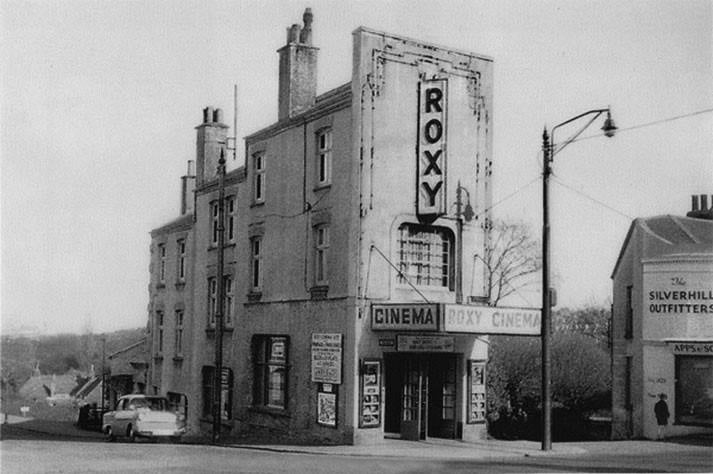
The Roxy at Silverhill in the late 1950s.
1914 Feb 5 - The well-known Australian suffrage campaigner Muriel Matters gave a speech at a public meeting in the Palacette organised by the NUWSS. On Sunday 8 February about a dozen local members of the Women's Social and Political Union (WSPU) interrupted the normal service at St Mary Maghdalen Church and recited a special women's prayer. This was repeated at St Mathew's Church on 15 March. Other churches had already agreed to include the prayer in their services.
1914 Feb 22 -Two children were killed in a fire in a small house at the rear of 7 Croft Road, accessible by a passage opposite St Clements Church. The children were in a cot in a small upstairs bedroom. Two firemen, Mr Burtenshaw and Mr HG Paine risked their lives trying to save them. On 28 May the men, members of No 1 Brigade based in the Old Town, were presented with special medals in recognition of their bravery.
1914 Early April - A new motorbus service started, between the station and the top of High Street. It was owned by Skinners.
1914 April 21 - The first trip of a motorised Hastings fishing vessel took place. The 21-feet long Boy Leslie RX 23 had had a 7hp petrol-paraffin engine installed and demonstrated that it worked. This showed that boats could go to sea in calm weather, greatly increasing their earning potential. Within months, most Hastings boats had had similar engines installed. The last Hastings boat to be built without an engine installed was the Mayflower RX 289, launched in late 1913. The first boat to be built with an engine was the Boy Jack RX 320, which started work in mid-May 1918.
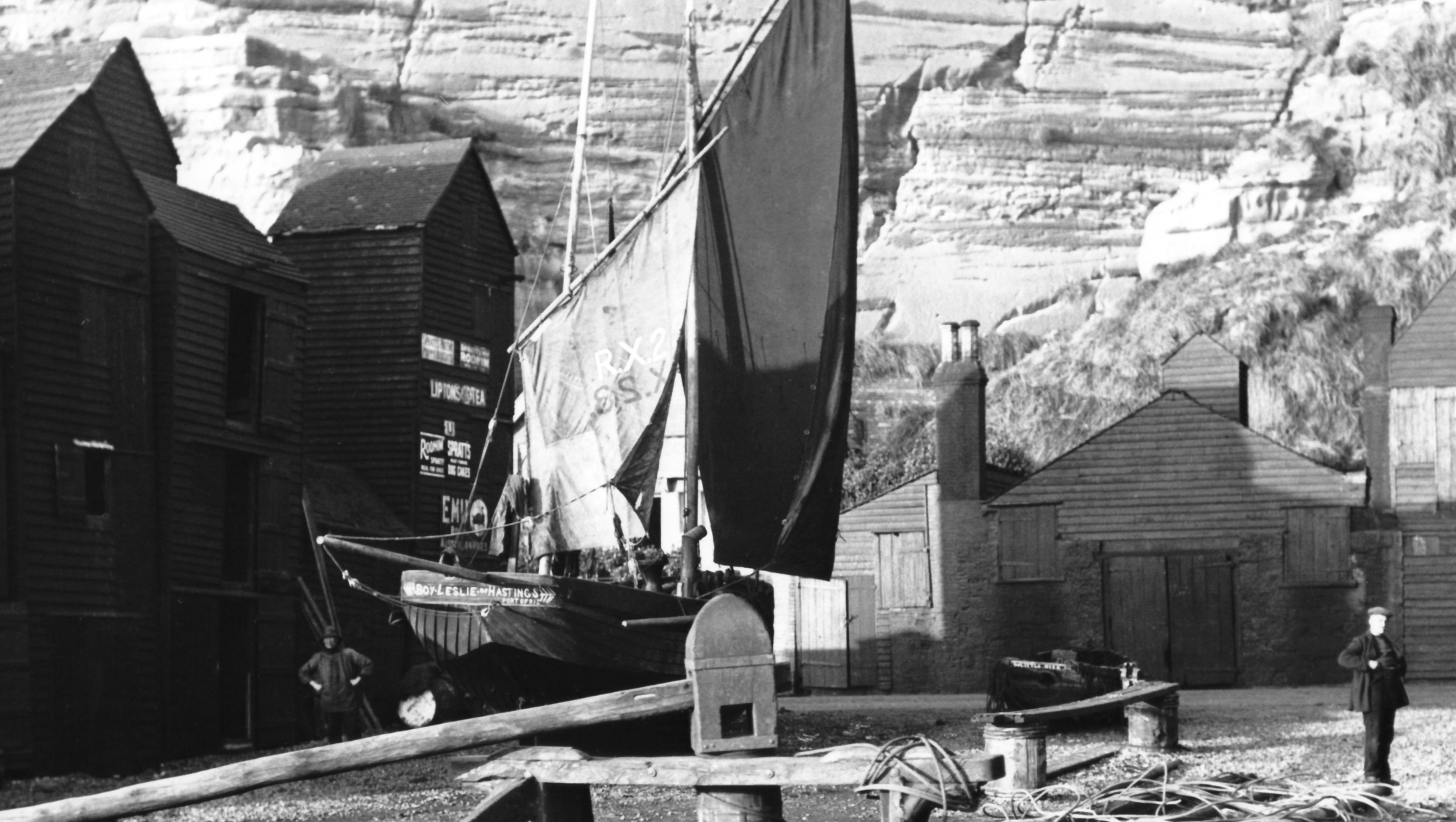
The Boy Leslie hauled up close to her net shop.
1914 June 13 - Intrepid young aviator Frank Goodden gave a sensational exhibition of flying at Fairlight. Large crowds of people gathered to watch Mr Goodden spend half an hour circling and looping the loop in very strong winds in a Morane monoplane.
1914 July 15 - In a major Freemason event, two important ceremonies took place, led by the Duke of Richmond and Gordon, a leading mason. First, 180 masons watched as he laid the foundation stone of the Royal East Sussex Hospital, Cambridge Road. After a large lunch in the Queens Hotel, about 80 masons then went to the new Masonic Hall in East Ascent. The hall had been built by James Burton, a Freemason, c1829 as the St Leonards Assembly Rooms until bought by the Hastings and St Leonards Masonic Hall Co Ltd in late 1913. The hall had always been a Freemason social centre, but it had become run down and 'dilapidated'. As the local masons had been hoping to acquire a 'Masonic Temple' for many years, they formed the company and spent £2,700 buying and improving the Assembly Rooms. It had a large hall, a dining hall, and a music room with a new floor for dancing. Only Freemasons were allowed to buy company shares. The Freemasons are still an influential (and semi-secret) lobbying organisation, and their building is still the Hastings-area Masonic headquarters. Many lodges meet in the large, decorated lower ground floor hall.
1914 Aug 5 - Following the declaration of war with Germany on this day, the mayor, Cllr E Hocking, received the colours of the 5th (Cinque Ports) Battalion Royal Sussex Regiment a few days later. The ceremony took place in front of a large crowd outside the town hall, with much cheering as the colour party and escort arrived. The battalion of local soldiers had been assembling in the Middle Street Drill Hall, behind the town hall, and later that day marched to the station and boarded trains for Dover, watched by many distressed wives, sisters, children and friends. Shortly after, a large number of horses were purchased and the local artillery group left the town with them.
1914 Sept - The 220 feet of Hastings Pier nearest the promenade were sold by the Pier Company to Hastings Council, just as the First World War broke out. Work began immediately on creating the ‘parade extension’ by widening that part of the pier to 220 feet. The tollgates and the four-year old joywheel were removed that autumn. On 19 April 1916 the official opening ceremony of the new extension took place in and around the new bandstand, which had just been finished. Over the following four months the two curved shelters (known as the ‘bandstand shelters’) were put up, along with a well-designed building which formed the Pier Company’s frontage onto the Council’s parade extension. By late summer all the new parade extension and pier frontage were in operation.
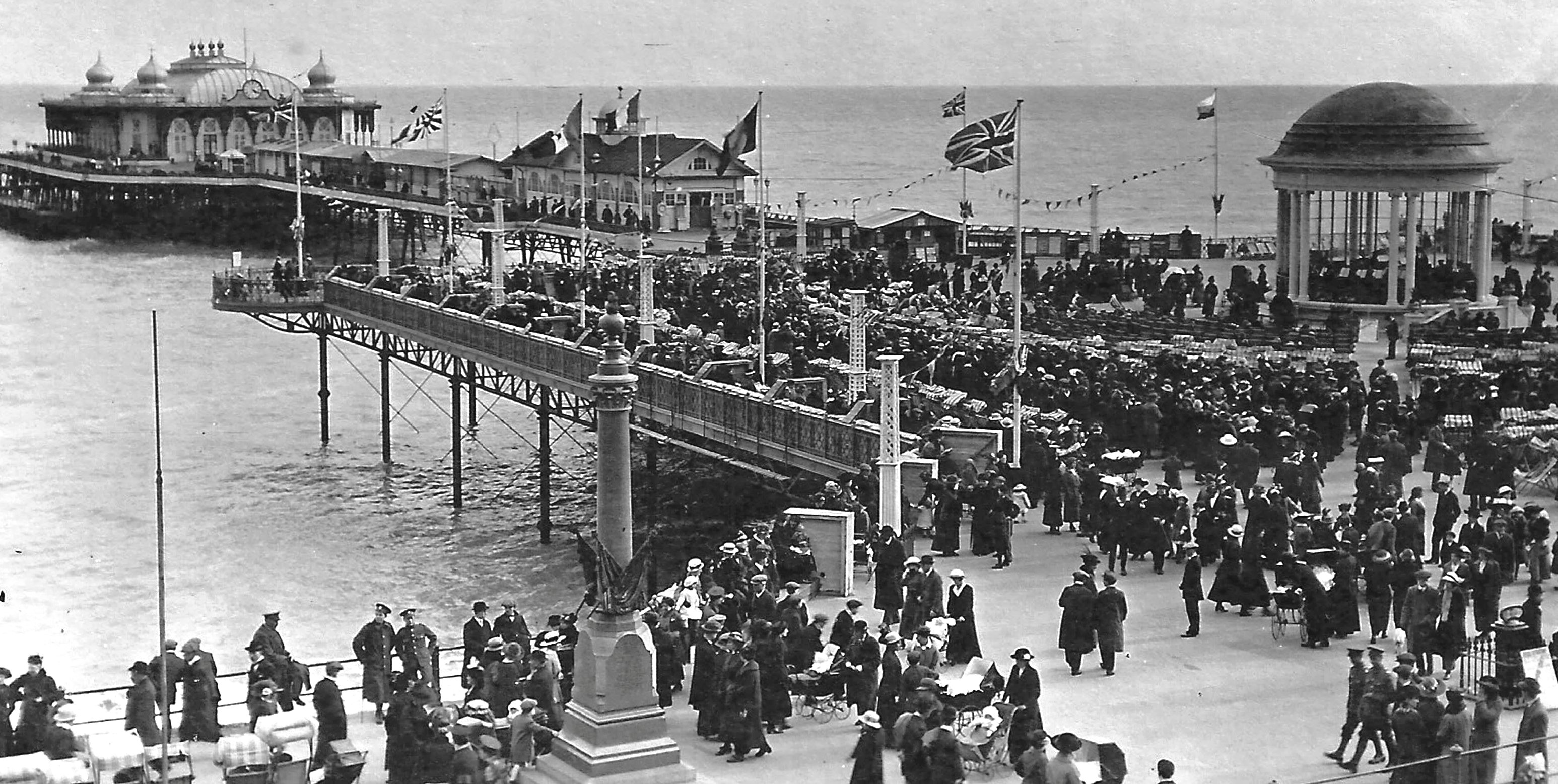
The opening of the partly-built parade extension on the pier in April 1916.
1914 Sept -Mrs Sayer-Milward, owner of Old Hastings House at the top of High Street, placed it at the disposal of the local Red Cross Detachment. During the war, several other premises were given over to helping war casualties, including: the Buchanan Hospital in London Road; the Hastings Union Workhouse Hospital in Frederick Road; the Eversfield Chest Hospital in West Hill Road; the Beau Site Convalescent Home in White Rock; the Convent in Filsham Road and the big houses West Dene in Hollington Park Road, Bannow in Quarry Hill, and the Hermitage and No 14 Holmesdale Gardens.
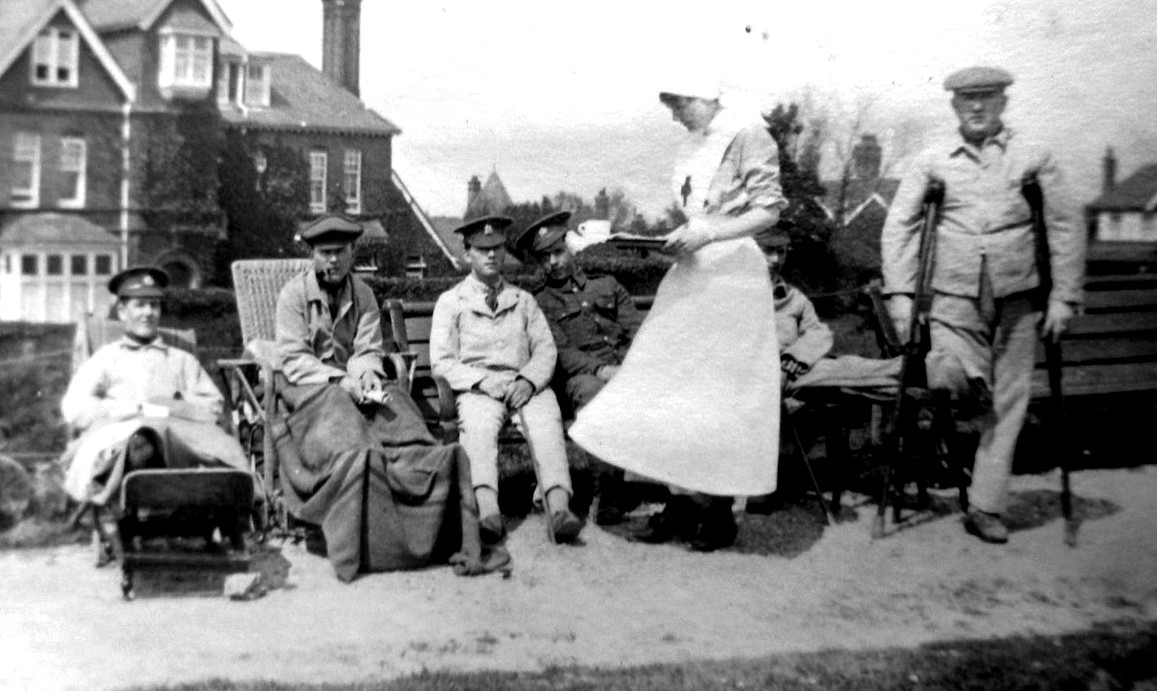
The Convent in Filsham Road became a hospital for wounded soldiers.
1914 Sept 10 - A meeting of the recently inaugurated Women's Emergency Corps of the National Union of Women's Suffrage Societies (NUWSS) was held at the Club, 7 Havelock Road. Mrs Strickland presided, saying that in view of the national crisis, the Hastings branch of the moderate NUWSS was temporarily abandoning its political propaganda and would devote all its energies to helping the sufferers.
1914 Oct 21 - The Home Office issued a nationwide order that all Germans, Austrians or Hungarians of a military age should be arrested. The Observer of 24 October reported that the Hastings Chief Constable had been 'busily engaged in rounding up enemy aliens.' Twenty had been arrested. Previously, 30 had been arrested under another order saying the detainees should have had military training. The new prisoners were sent to London in a large motor coach on 23 October. The Observer of 31 October thought the arrests were 'not a serious matter, because this town, being outside the zone of military operations, is very unlikely to be chosen as the site for any nefarious deeds of the enemy.'
1914 Dec 16 - A big recruiting parade took place, with between 6,000 and 7,000 men taking part. It started in Lower Park Road, beside Alexandra Park, and went through the town centre and along all the seafront.

A route march passing the Bull Inn in Bexhill Road.
1915 Jan 4 - The Picture Palace cinema in Wellington Place was gutted in a major fire. The fire began in the flat above the ground-floor cinema, eventually collapsing into the auditorium, causing £2,000 of damage. Large crowds gathered in Wellington Square to watch the spectacle, with the firemen being helped by many of the soldiers then stationed in Hastings. Adjoining buildings were damaged by both the fire and the fire brigade's water.
1915 July 7 - The renovated and redecorated White Rock Baths were ceremonially re-opened by the mayor at 3pm. The Hastings and St Leonards Amateur Swimming Club then held a 'grand swimming festival'.
1915 Oct 2 - A 'Grand Recruiting Rally and Military Parade' was held on 'Union Jack Flag Day'. Speakers on the programme included Sir Arthur Conan Doyle.
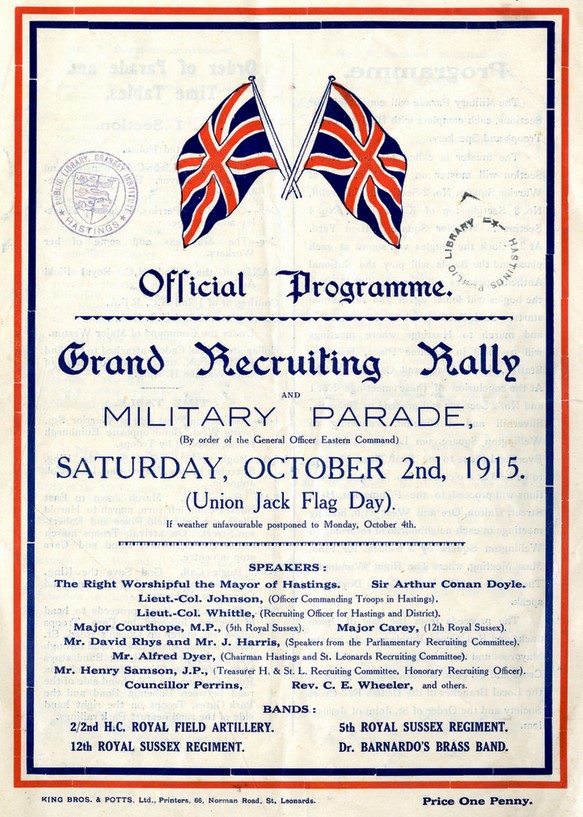
1915 Dec - Early in the month, about six thousand troops were billeted in Hastings
1916 March 17 - Earl Brassey gave his huge three-masted yacht Sunbeam to the Indian government in Bombay. She was to serve as a hospital ship. Since 1875 the Sunbeam had covered more than half a million miles. The Earl died on 23 February 1918 at his London residence, 24 Park Lane, at the age of 82.
1916 March 21 - At the annual meeting of the Hastings and District Electric Tramways Company, shareholders were told that 'they were amongst the first companies to introduce the female conductor, of whom they now had 45 to 50 in their service. There was no doubt the girls did their work thoroughly well, and were civil and attentive to the passengers' requirements; they were paid at the same rate as the company used to pay the men.
1916 March 24 - An aeroplane flying over Hastings developed engine trouble, and the aviator tried to land in a large field adjoining Hillside Road. But the field was in a sodden state, and on touching the ground the machine turned a complete somersault. The aviator was badly injured and he was taken to the nearby Grange preparatory school for 'the sons of gentlemen'. The Canadian motor ambulance then took him to the East Sussex Hospital.
1916 March 28 - The smock windmill at Baldslow was badly damaged in a gale, with its sweeps broken beyond repair. It would have cost £200 and taken six months to repair. Its base, lying on the north side of the Ridge at its summit just before Harrow Lane, is lived in.
1916 April 19 - The new Parade Extension and bandstand on the pier were officially declared open. Hastings Council had bought from the Pier Company the 220 feet of the pier nearest the promenade and had widened it to 220 feet, making the big square of decking called the Parade Extension. The bandstand had just been built on it. Over the summer the Council also built the two large curved shelters on the extension, giving protection from the weather to spectators of the bandstand. The western one of these shelters was to be the only building on all of the pier to survive the disastrous fire in October 2010.
1916 July 1 - The Battle of the Somme started on this day, with 60,000 casualties in the first 24 hours, 20,000 of whom died. It was the single worst day in the history of the British Army. The battle was filmed by Hastings photographer Geoffrey Malins, and his hour-long movie, The Battle of the Somme, was the most-watched film of the time. He was born Arthur Herbert Malins in Russell Street on 18 November 1886, the son of a Hastings hairdresser. He trained as a photographer and from 1908 ran a studio at 194 Queens Road, roughly where WH Smith is today. Around 1910 he moved to London and by 1914 was working as a newsreel cameraman. He and Mr JB McDowell were the two cameramen nominated to work alongside British forces, and their film of the Somme has some of the most iconic images of the First World War.
Wounded soldiers on Hastings Pier in October 1916.
1916 Nov - The Old Town Junior Club for boys was started by the new All Saints rector, the Reverend EA Penson. The club was based on the two floors of a former school hall in Tackleway (where number 18 is today) and initially suffered from vandalism and bad influences. But in the early 1920s it became a popular centre for athletics, football, gymnastics, boxing and other sports. Girls became eligible to join the club in the 1970s. The hall became dilapidated in the 1980s and had to be closed. In 1997 the Magdalen & Lasher charity gave the club use of a large field in Barley Lane, opposite Shearbarn Holiday Park, where the club laid out two football pitches and erected changing rooms.
1917 Feb 8 - A Hastings woman, Kathrina Chadwick, was fined £10 for concealing a Canadian army deserter in her house, 28 Devonshire Terrace.
1917 July 15 - A great fire destroyed the pavilion at the seaward end of Hastings Pier. The blaze was thought to have been caused by one of the Canadian soldiers stationed in the town discarding a cigarette. Much of the pier was damaged and it took until 1922 until a replacement pavilion was built.

The fire on the pier on 15 July 1917.
1917 August - The St Leonards Pier was bought by Mr John Henry Gardner, the owner of a Welsh coal-mining business.
1917 Nov 24 - The ownership of much of eastern Fairlight was changed when most of the Lucas-Shadwell family’s Fairlight Hall Estate was auctioned at the Castle Hotel, Hastings. This followed the death of William Lucas-Shadwell (1852-1915), Conservative MP for Hastings 1895-1900, the only son of William Drew Lucas-Shadwell who had built Fairlight Hall in 1850-51. A total of 3,680 acres was sold, covering an area from Fairlight Church along the coast to Rye Harbour, taking in most of Pett as far north as the Pannel Sewer.
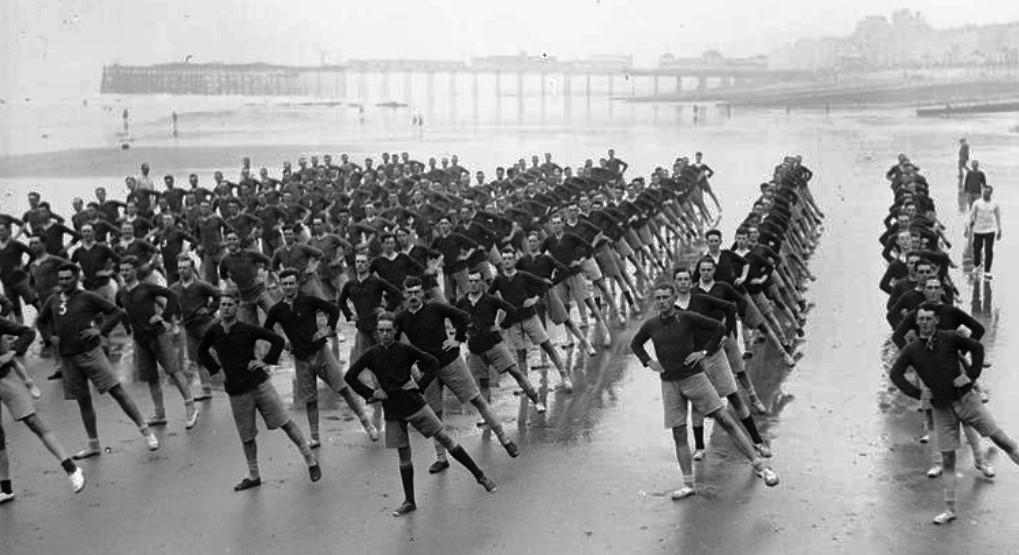
The RAF Cadet Brigade training on Hastings beach in early 1918.
1918 - Beaulieu House on the Ridge was taken over and turned into Hydneye House boys’ preparatory school. This became one of the country’s best-known such schools, until closing in 1969. In 1974 the beautiful large house was demolished and replaced by Maplehurst School.
1918 - King George V came to inspect the Royal Air Force Brigade, in which Prince Albert (later George VI) was a captain.
1918 Jan 4 - £7,000 worth of damage was caused by a big blaze on the premises of Messrs Daniel, stationers at 28 Kings Road. Five sections of the Fire Brigade had to be called out to control the fire.
1918 Feb - John Gardner, the owner of St Leonards Pier, donated an ambulance to the Hastings Red Cross in memory of his son Victor who was killed in action in Flanders in March 1917.
The ambulance donated to Hastings Red Cross in memory of Victor Gardner.
1918 April 29 - The 111-metre refrigerated steamship SS Broderick, en route from Dunkirk to Venezuela, was torpedoed and sunk by the German submarine UB 57 eight miles south of Hastings. All the 67 crew survived, some being landed at Hastings by the Hastings lifeboat. The Broderick sank close to the wreck of the 37-metre Hull-registered steam trawler Agate that had sunk on 14 March 1918 after hitting a mine while carrying out mine-sweeping operations for the Royal Navy. Four of the six crew died.
1918 May 18 - There was a one-day strike on the Hastings Tramways on Whit Sunday 18th, causing considerable public inconvenience. A union representative (a woman) said: 'The cause of the strike was occasioned through a certain ticket inspector having made herself so obnoxious and objectionable to the motormen that they finally decided to come out in order to prevent her dominating over them.' The management agreed to remove from her position. The strikers stressed they were not opposed to working with other women, just this one.
1918 June 30 - The 111-metre cargo ship SS Wilton was torpedoed off Hastings. She did not sink, and was towed onto Hastings beach. She was then towed towards the Thames, but sank on the way.
1918 July 6 - The Hastings War Weapons Campaign held ten days of fund-raising activities around the town, starting on the 6th. The highlight was a visit to the town on 15 and 16 July of a 'real Tank'. Excited large crowds watched the arrival of 'this great weapon of destruction' as it crawled 'like a caterpillar' from the station to Caroline Parade, where it was put on display. It had been in active service at the battle at Cambrai. The campaign also had a 'dummy Tank', made by order of the Council, which spent the first seven days on processions around the town. Tuesday the 9th was a special Women's Day. This was all aimed at persuading the public to subscribe to the War Loan; over £100,000 was raised.
1918 Nov 11 -The news that the war had ended on this day was greeted with big celebrations around the Memorial and on the Stade in front of the Old Town, where fishermen built a huge fire that continued burning through the night. On the 13th there was a big procession around the town, led by the local troops, with several military bands.
1918 Nov 11 - Death of the hermit John Hancox, the former London businessman who lived in the cave in Ecclesbourne Glen from the mid-1890s until he died. He had no friends but was said to be a very happy and intelligent man. He lived mainly from food he grew in front of the cave, and by searching waste tips and dustbins. The cave was about ten feet deep, with a door, with many books but no furniture.
1918 Dec 14 - In the general election, Laurance Lyon won Hastings as the Liberal/Conservative Coalition candidate, beating Labour's candidate, London trade union secretary Joseph Butler, by 11,210 to 3,556. Lyon, a Conservative, was declared bankrupt in late 1920, owing £21,400. He moved to France and resigned as MP in April 1921. The by-election on 4 May was won by Tory (and Coalition supporter) Lord Eustace Percy. Labour came second, Liberals third. The Conservatives won all forthcoming general elections until Michael Foster won for Labour in 1997. Harvey Du Cros, Hastings Tory MP from 1906 to 1908, died on 21 December 1918 at his home in County Dublin, Ireland, aged 73.
1919 March 27 - The new St Leonards National Kitchen was opened at 14 Silchester Road by the Rev C Sturges-Jones. The national kitchens, with restaurants, had been set up around the country during the war to help poorer people find good food. There had been one in Tower Road which had recently closed, but such a kitchen and restaurant was still needed. It was being funded by private donations.
1919 April 15 - A 267-feet long German submarine, the U-118, was swept ashore at Harold Place while under tow to France. The local Coastguards took control of the vessel, and two officers who spent some time below decks died several months later as a result of inhaling noxious gas from rotting food in water inside. The U-118 had a 150mm gun, four forward torpedo tubes and two mine chutes at the stern (for mine-laying). Built in Hamburg, the U 118 was launched in February 1918 and sank two British ships. It was found to be impossible to remove the vessel, so it was dismantled in the autumn of 1919. Some of the keel remained under the beach until June 1937, when Hastings Council removed what had been uncovered by the tide (but is some still there?).
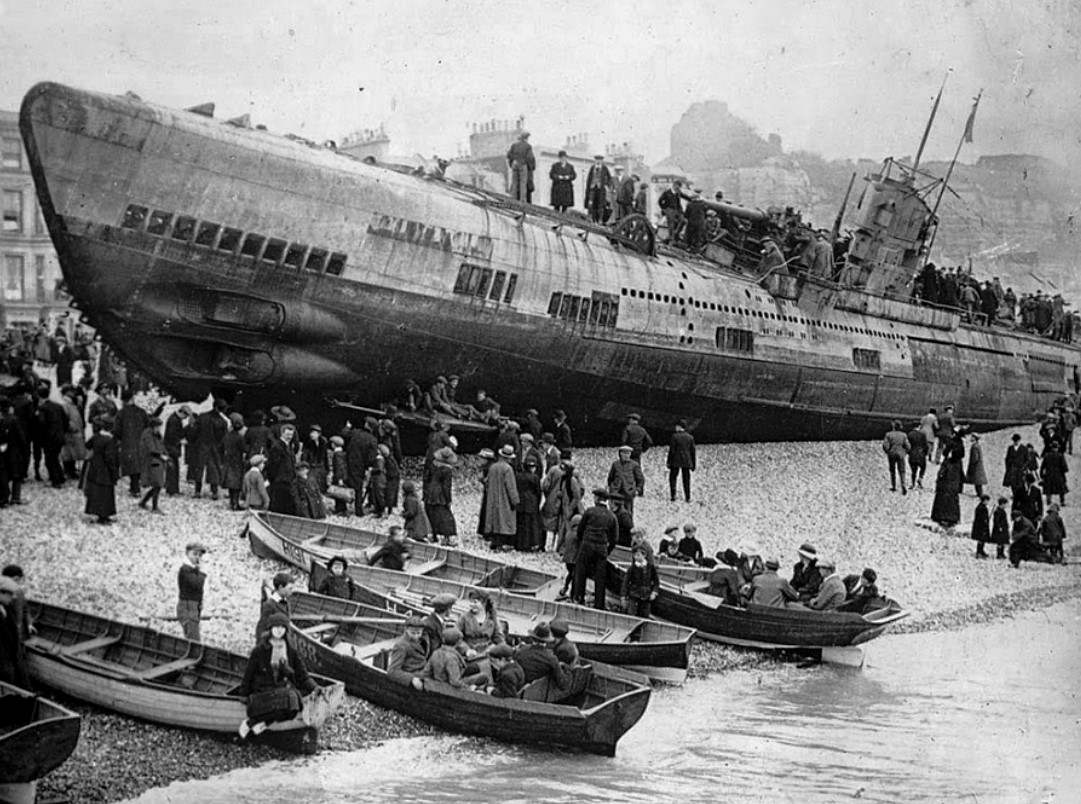
The U-118 ashore at Harold Place.
1919 May 21 - A 12-day strike by local building workers seeking a pay rise came to an end so that talks with the Conciliation Board could take place to try to resolve the issue. In June the Board awarded the workers a rise of 1d per hour, not the 2d they had been seeking. The strike came at a time of high unemployment in Hastings and nationwide, with the government fearing a national uprising of some sort, following the 1917 Russian Revolution.
1919 July - The passing of the 1919 Housing and Town Planning Act made local authorities responsible for supplying housing to people in need. Hastings Council were told in November 1919 that there were roughly 12,000 houses in the borough, and about another 500 were required to meet housing needs. It was decided to consider building in Barley Lane and the field adjoining All Saints Rectory.
1919 July 19 -Thousands of people took part in the widespread celebrations of Peace Day. The Old Towners started at 5am, and kept going in high spirits until 11pm. There were 'Early Morning Sports' all round the town, a parade of floral and flag-decorated cars along the seafront, a 'Great Peace Fete' in Alexandra Park, a fancy dress carnival at White Rock and a fireworks display on St Leonards Pier.
1919 July 28 - A First World War army tank was presented to Hastings by the National War Savings Committee in recognition of the services rendered by the town. It arrived by train and large crowds followed its journey to Wellington Square, where it was put on display. It later moved to a permanent site on the seafront opposite Breeds Place.
The tank in Wellington Square.
1919 Sept 26 - A national rail strike began, with support at Hastings. The rail companies managed to run a very limited service, but there was major disruption of travel and trade in the town. Emergency rationing of food was introduced. The mayor said it was a 'time of crisis. ... There is no need for panic, but we all need to be very careful.' Troops guarded some railway facilities. Motor charabanc owners ran services to London. The strike ended on 5 October, with victory for the unions.
1919 Nov - The first woman councillor in Hastings was elected. Miss Annie Lile of 13 Pevensey Road also had the largest majority on record. Credit went to the Hastings and St Leonards Women Citizens' Association. There was a Labour landslide nationally in the local elections, but not in Hastings, where Labour candidates were 'ignominiously defeated'. But there was triumph for women in Hastings, where one of the two candidates was victorious, and the other nearly so, only losing by nine votes.
1919 Nov 11 - Armistice Day was celebrated for the first time. The king had requested that there be two minutes' silence at 11 o'clock on the anniversary of the signing of armistice. A crowd gathered in the town centre, and as the clock in the Memorial struck, 'all traffic stopped, and the sudden quite had a most weird effect'.
1919 Nov 12 - The second Earl Brassey died, following a road accident in London on 7 November, when he was knocked down by a taxi-cab. Thomas Brassey was born 1863; his father was the wealthy Thomas Brassey jnr, who became a Hastings MP and a great local benefactor. In his will, he left estate valued at £845,000. The 3,400 acre Normanhurst estate near Catsfield was withdrawn from auction on 24 June 1920 after reaching £120,000. The estate was then split into 65 lots and auctioned on 9 July. Most was sold, but not the mansion, the Brassey residence.
1919 Late - The fishing boat Edward and Mary RX 74 was built in a shed on the beach. She was probably the first Hastings boat to be built with an engine installed, and today she stands next to the Fishermen’s Museum.
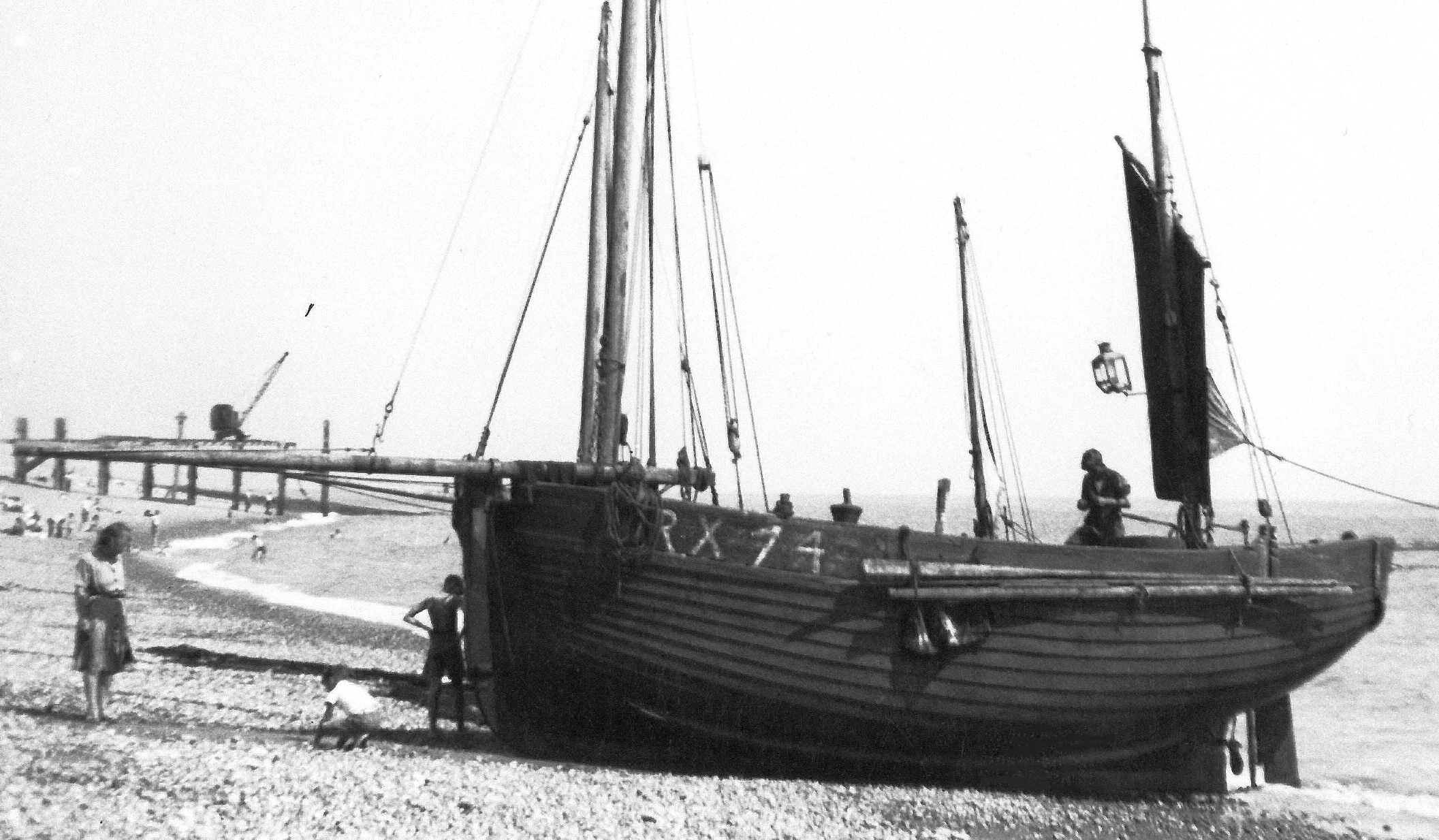
The Edward and Mary being pulled up the beach in July 1947.
1920 - Tennis courts were laid out in Alexandra Park. White Rock Pleasure Grounds were completed. Beach huts replaced bathing machines. A motorboat became a summer attraction on the pier.
1920 Jan 8 - Three hundred poor children were given a Christmas treat in the Hastings Pier Tea Rooms. They had cakes, nuts and fruit, plus games, balloons and presents.
1920 Jan 27 - The large Havenhurst flour mill in Bexhill Road (where Stamco was later located) was completely gutted by fire.
1920 Feb - The Council gave permission for up to 50 bathing huts to be sited on the beach at Grand Parade. These would be the first huts on the town's beach, where bathing machines on wheels had originally been used for many years, followed portable bathing tents in recent years. The seven feet long and eight feet high wooden huts would be moveable in emergencies.
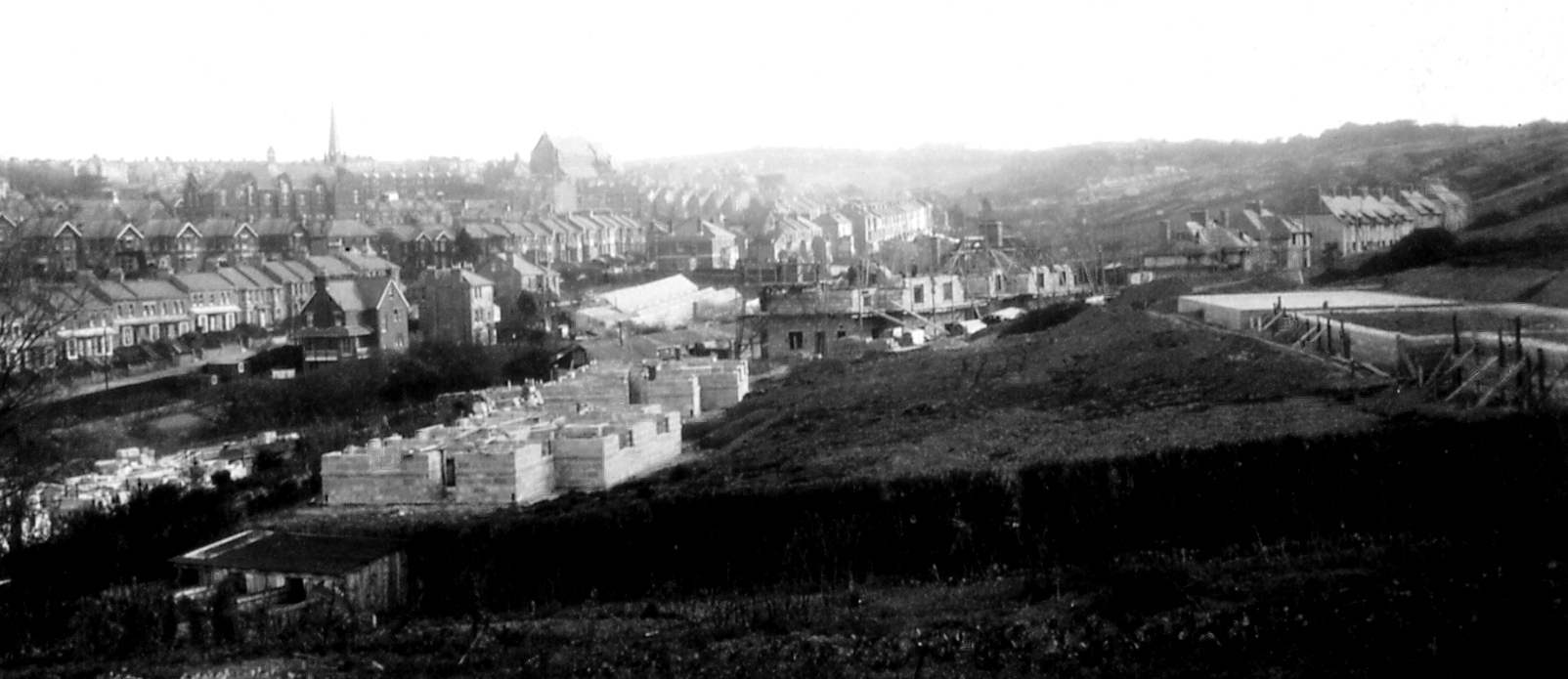
Council houses being built in Boyne Road in 1921.
1920 August - Hastings Council decided to acquire about 29 acres of land on which to build council houses: 72 houses at Barley Lane, 18 alongside All Saints Rectory, 62 beside Eversley Road, Silverhill and 84 off Old Church Road, Hollington. In mid-1921 the first houses became available, with All Saints Crescent finished in April 1922, and Barley Lane/Boyne Road/Gurth Road completed in July 1922. All these houses were built to a high standard. Work began on several other sites in the following years, and by October 1926 the Council had built 334 houses and 44 flats.
1920 Aug 21 - The new public bowling pavilion was opened in White Rock Gardens.
1920 Sept 25 - The Observer of this date carried a drawing of the Barley Lane Farm in Barley Lane, describing it as a disappearing landmark as it was being cleared away to make room for the Barley Lane council house estate. It stood a few yards uphill of Gurth Road. Houses became available in February 1921.
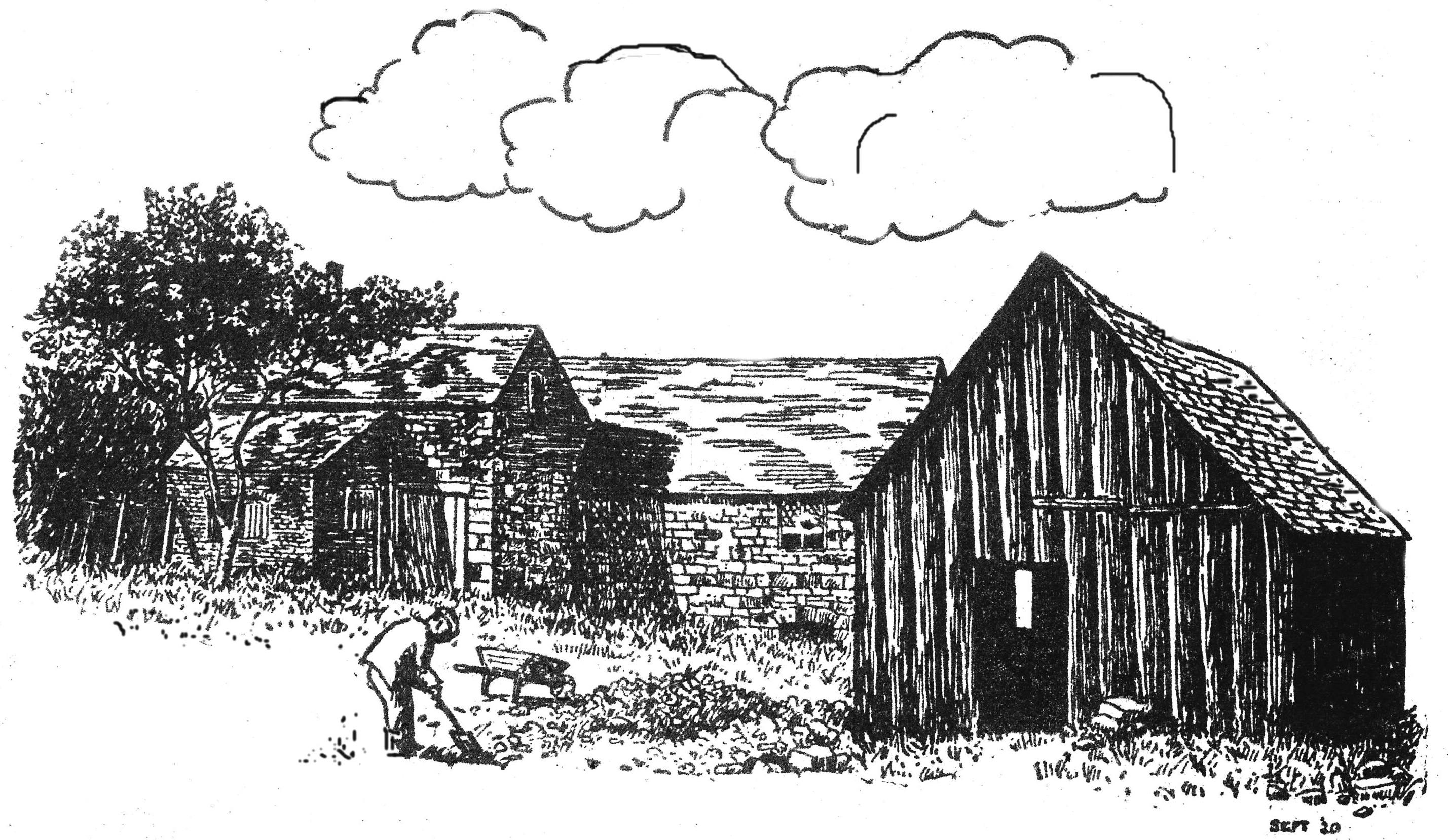
Barley Lane Farm in 1920.
1920 Oct 13 - Funeral of Frank Edward Philcox, aged 79, the pioneer of fare-paying yachting for pleasure purposes from the beach. He was the proprietor of the well-known and much-photographed large yachts Albertine and Lavonia, in which many thousands of holiday makers had trips under his care pre-war.
1920 Dec 14 - The first sod of turf was cut by the mayor, marking the start of work on building the new road which would connect the then-north end of St Helens Road (at the Buckshole pumping station) with Sedlescombe Road North at its junction with Old Roar Road. This three-quarters of a mile of road would include building a bridge over the Old Roar Stream. The Observer said that 'this new road will eventually become one of the most important in the neighbourhood', especially for traffic coming to Hastings from London. It would also open up the area to the north-east of it for development, including Parkstone Road. About 200 men would be employed on the work, all of them being discharged soldiers and sailors. It opened in September 1922.
1921-24 - The height of the dam of the Spoon reservoir in Ecclesbourne Glen was raised, and the reservoir’s inside slope was improved, doubling its capacity to 12 million gallons. To do this, an additional two acres of land was needed, to add to the existing area of just over three acres, so the Council in November 1924 bought all that land from Edith Sayer-Milward, ending its lease.
1921 Jan 9 - A second German submarine was washed up on Hastings beaches, this time at Bulverhythe. It was the 181-feet long UB-131, which broke loose from a tug in a gale. It was later sold and broken up. The UB-131 was one of 95 submarines in the UB III class: coastal torpedo attack vessels, 181 feet long, with 34 crew, an 88mm deck gun and five torpedo tubes, each with two torpedoes. It was launched in June 1918, but had no successes in combat.

The UB-131 ashore at Bulverhythe.
1921 March - It was announced that the Hastings Workhouse (built 1937) in Frederick Road was also to become a nurses' training school.
1921 March 20 - The trams’ new overhead power line along the seafront was switched on. Until March 1914 the trams had been using electric studs in the road, but this was unreliable, so petrol-electric motors were then installed, but these were also a failure. The Hastings Tramways Act 1920 had given the tram company the legal power to set up poles on the seafront.
1921 March 30 - About 400 acres of farmland in and around Fairlight Cove was auctioned at the Castle Hotel. This included Waites Farm of 226 acres, Wakehams Farm 40 acres and Lower Stonelink Farm 34 acres. It is believed that the sale of Waites Farm started the development of Fairlight Cove as a housing area.
1921 April 23 - Tramway workers went on strike over the unfair dismissal of a ticket inspector. The strike lasted seven days, until a compromise was reached.
1921 mid - On Hastings Pier, a wooden floor was laid on the site of the burnt-down pavilion, to be used in fine weather. That winter, a simple steel-framed sheltering pavilion was put over the top of the new floor, and the new building opened in July 1922. It quickly became clear that this frail and unattractive barn-like structure should have been built as a weather-proof replacement of the 1872 pavilion destroyed by fire in 1917. The 1922 structure was to form the basis of the pier’s main pavilion (from around 1960 often known as the ‘ballroom’) until destroyed in a major fire in 2010.
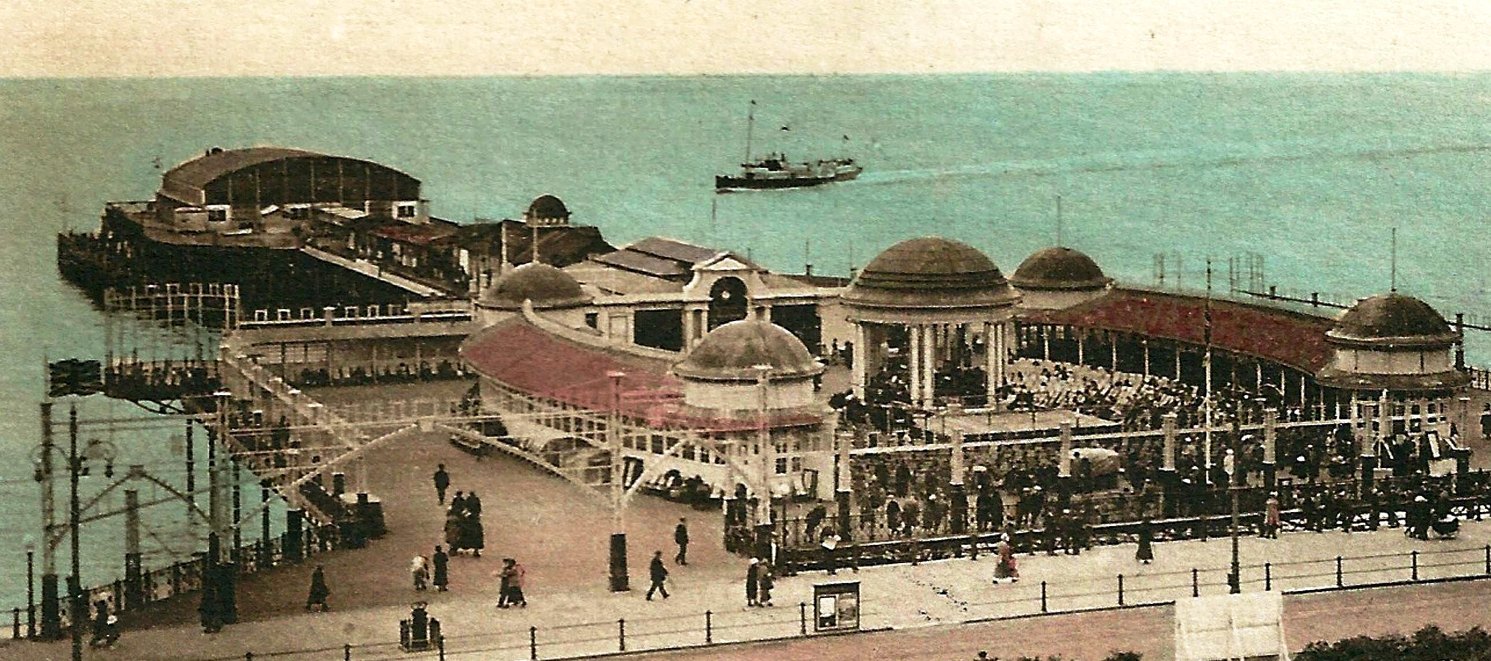
Hastings Pier with its new pavilion in c1924.
1921 Summer - The town’s first post-war council houses started becoming available at Barley Lane/Boyne Road and All Saints Crescent. This summer Hastings Council also bought seven acres at Eversley Road, Silverhill, and nine acres at Old Church Road, Hollington.
1921 Aug - The new census figures were released, showing the population of the County Borough of Hastings had risen from 61,145 in 1911 to 66,496, an increase of 5,351, or 8.8%. There were far more females in Hastings: 39,456, compared with 27,040, meaning 59.3% were female, 41.7% male.
1921 Aug 20 - Hastings Fire Brigade took delivery of its first motorised fire engine, a 60hp Leyland, equipped with a 65-feet escape ladder and a turbine pump, and running on solid tyres.
1922 Jan -Starborough House School, a gentleman's boarding school, at 30 Church Road, went bankrupt and closed down. It had been teaching over 100 pupils until 1920, but then numbers dropped dramatically.
1922 March 15 - A Royal Navy seaplane crashed into the sea about two miles off Marina. The plane's back was broken by the impact, but enough of the plane stayed above water for the three crew to cling to the tail until rescued by two men in a small rowing boat.
1922 March 26 - In a big ceremony witnessed by about 10,000 people. The War Memorial in Alexandra Park was unveiled by General the Earl of Cavan. It was erected in memory of the 1,250 Hastings and St Leonards men who had been killed in the war. Designed by Margaret Winser, the memorial was made of Portland stone, with bronze panels depicting soldiers in action and had bronze plaques with the names of those who died in action. On top is a bronze winged figure
1922 Sept 29 - The new northern half of St Helens Road, from the water pumping station to Sedlescombe Road North, was opened by the mayor Alderman Bill Fellows. This involved the new crucial bridge over Old Roar Stream. The new road prompted large-scale house building, creating a new suburb of the town. Until 1921 St Helens Road was a cul-de-sac, only going as far north as No 110, just up the road from the Ashford Road junction. Beyond No 110 was a track going to Buckshole Reservoir. In 1922 Ashford Road itself did not exist; instead there was a track to Hole Farm, where Hole Farm Close is today. At that time, the whole of the east side of today’s St Helens Road to Sedlescombe Road North was farmland, and this was opened up for development by the creation in 1921 and 1922 of the new arterial road and bridge. Hastings Council had built the new road, which had ‘green walks’ on both sides. All the work was carried out by unemployed discharged military labour. Each of the bridge’s two arches spanned 45 feet, with the stream 70 feet below. Many councilors wanted the new road to be called Old Roar Avenue, but their proposal was narrowly defeated. By 1938, all the housing now on the east side of the new part of St Helens Road had been built.
1922 Nov 15 - The existing Hastings MP Lord Eustace Percy, who had won the 1921 Hastings by-election, won the general election for the Tories. The party held the seat for the next 75 years.
1923 Feb - Hunger marchers arrived in Hastings from Eastbourne. They stayed in the workhouse and then went to Rye.
1923 April - Caple-le-Fern, the large house at the bottom of Albany Road, became a rest home for London busmen.
1923 May - The new Royal East Sussex Hospital, Cambridge Road, came into use. It was officially opened by Princess Alice on 22 October. Demolition then began of the East Sussex Hospital opposite the pier, to become the site of the White Rock Theatre which opened in April 1927.
1923 - In mid-1923 an expert town planner, Dr Thomas Adams, was appointed by Hastings Council to draw up a development plan to help turn Hastings into the 'City Beautiful'. His interim proposals of 1924 and 1926, involving many large-scale schemes, found overall favour, and either coincided with, or caused, the appointment of Sidney Little as Borough Engineer in July 1926 (cf). In the following years, Little carried out some of Adams's proposals and also implemented many of his own ideas, transforming the borough by the end of the 1930s.
1923 Summer - Beauport Park house on the Ridge was completely gutted by fire. It had been built by General Sir James Murray 1763-66, who had served in Canada and named the estate after Beauport in Canada. He subsequently added to the estate until it comprised about 5,000 acres. From 1860 it was owned by Sir Archibald Lamb, who leased it to the Brassey family for many years. It was rebuilt in 1926. In the Second World War Canadian troops built a network of underground tunnels and chambers. After the war it became a hotel and golf club.
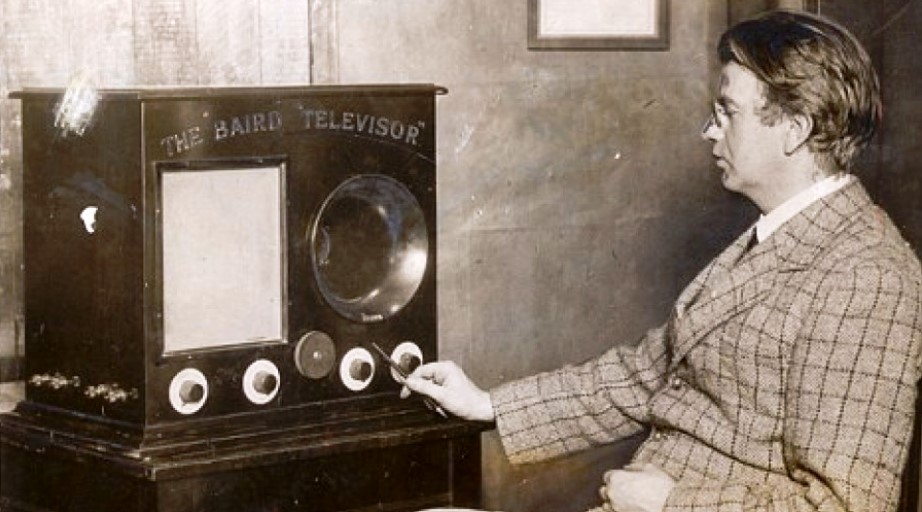
John Logie Baird inventing television.
1924 Jan - John Logie Baird (1888-1946) gave the world’s first demonstration of television, at his lodging house 21 Linton Crescent. A Scot, he had moved to Hastings in the autumn of 1922 to recover from illness. He used his time to carry out experiments on making television, and one day while out walking along the cliffs to Fairlight Glen he 'invented a means of seeing by wireless'. He rented a room above a Queens Arcade shop, where in early 1923 he made the first moving television picture in the world. After moving out of the Arcade, he carried on experimenting at his lodgings, and in January 1924 he showed the result to a newspaper reporter. Baird gave the first-ever public demonstration of television in Selfridges store in London in April 1925. His other firsts were video recording (1927), transatlantic television (1928) and the transmission of high definition colour pictures (1937).
1924 February - There was a fire at the East Hill Lift station. All the interior was burnt out.
1924 Summer - After four years building work, the town’s biggest printing firm FJ Parsons Ltd - publisher of the Hastings Observer - moved into its new headquarters, 53 Cambridge Road, where it stayed for 60 years.
1924 Summer - The Hastings Golf Club moved into Fishponds Farmhouse in Barley Lane, which was to be its base until 1958. Until then its clubhouse had been at the junction of Barley Lane and Rocklands Lane. The club leased Fishponds from the Milward estate, plus much of the surrounding farmland to create a quality 18-hole course.
1924 Sept - The round retail fishmarket at the bottom of High Street was closed by the Council, saying only four of its stalls were in use, and it needed £250 worth of repairs. It was demolished in March 1928 and its site was taken over as a turning circle for the new trolleybus system being installed around the town. The site is now a car park.
1924-25 - The group of buildings known as Reeves Corner, 1-3 Bank Buildings at the bottom of Havelock Road facing the Memorial clocktower, were demolished and replaced by the Westminster Bank (NatWest today) and a large shop. Remains of the early-19th century wooden bridge over the Priory Stream were found when digging the front foundations of the bank.
1925 - The first public telephone boxes were put up.
1925 May 22 - The town’s new electricity power station at Broomgrove opened, replacing the one in Earl Street (the chimney of which was demolished in mid-1926).
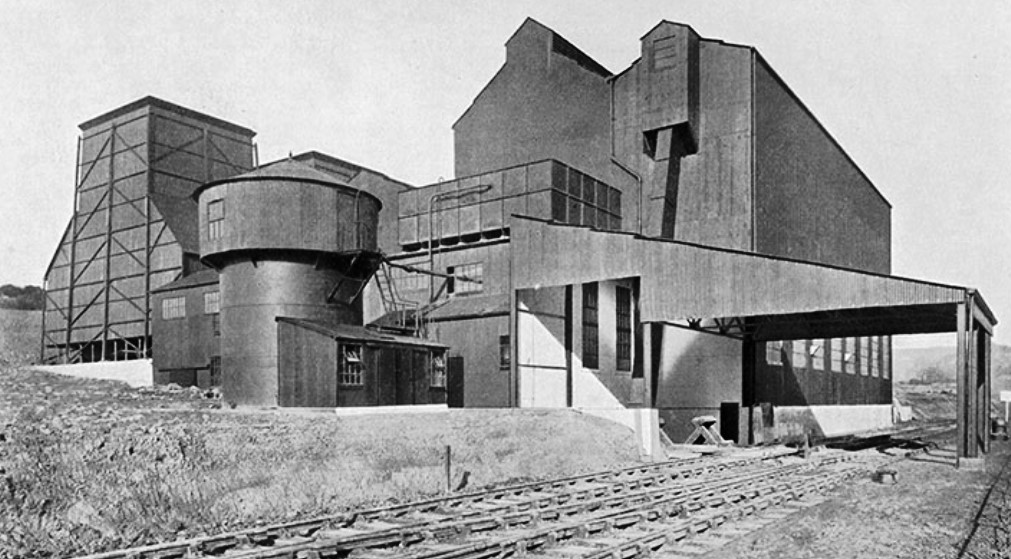
The new power station at Broomgrove in the Ore valley.
1926 - The Hastings Pier Company decided to carry out many major changes to the pier from this time onwards. It began in 1926 with a three-year programme of widening (from 45 feet to 90 feet) all of the company’s part of the pier as far south as the inland side of the pavilion, starting at the parade extension. In July 1926 a new ‘pavilion’, used as a theatre, opened on the west side of the newly widened part of the pier, close to the parade extension. Also that year, several buildings were attached to the north end of the main pavilion, including a refreshments saloon.
1926 - Early in the year a new road, called Rye Road, was built connecting Red Lake with northern Winchelsea Road.
1926 Jan - The Priory Road boys school re-opened as a selective central school for boys aged 11+, instead of from 7+ as previously. In 1944 it became the Hastings Secondary Modern School for Boys. It is now several flats/maisonettes.
1926 Jan - Work began on the removal of the large group of fishing-related buildings known as Mercers Bank, on the beach between the bottom of All Saints Street and Bourne Street. This was a mixture of net shops, store-rooms, blacksmiths and workshops that had grown up on this site since early in the 19th century. Hastings Council wanted to remove most, if not all, the buildings in order to tidy up the area, widen Rock-a-Nore Road and make more room for facilities for the tourist industry. The fishermen saw the scheme as part of the Council's semi-secret long-term policy to force them off the beach so it could be used by tourist businesses. The clearance was not finished until late 1929, leaving just three net shops in place (and still there today). The road was widened in the spring of 1930.
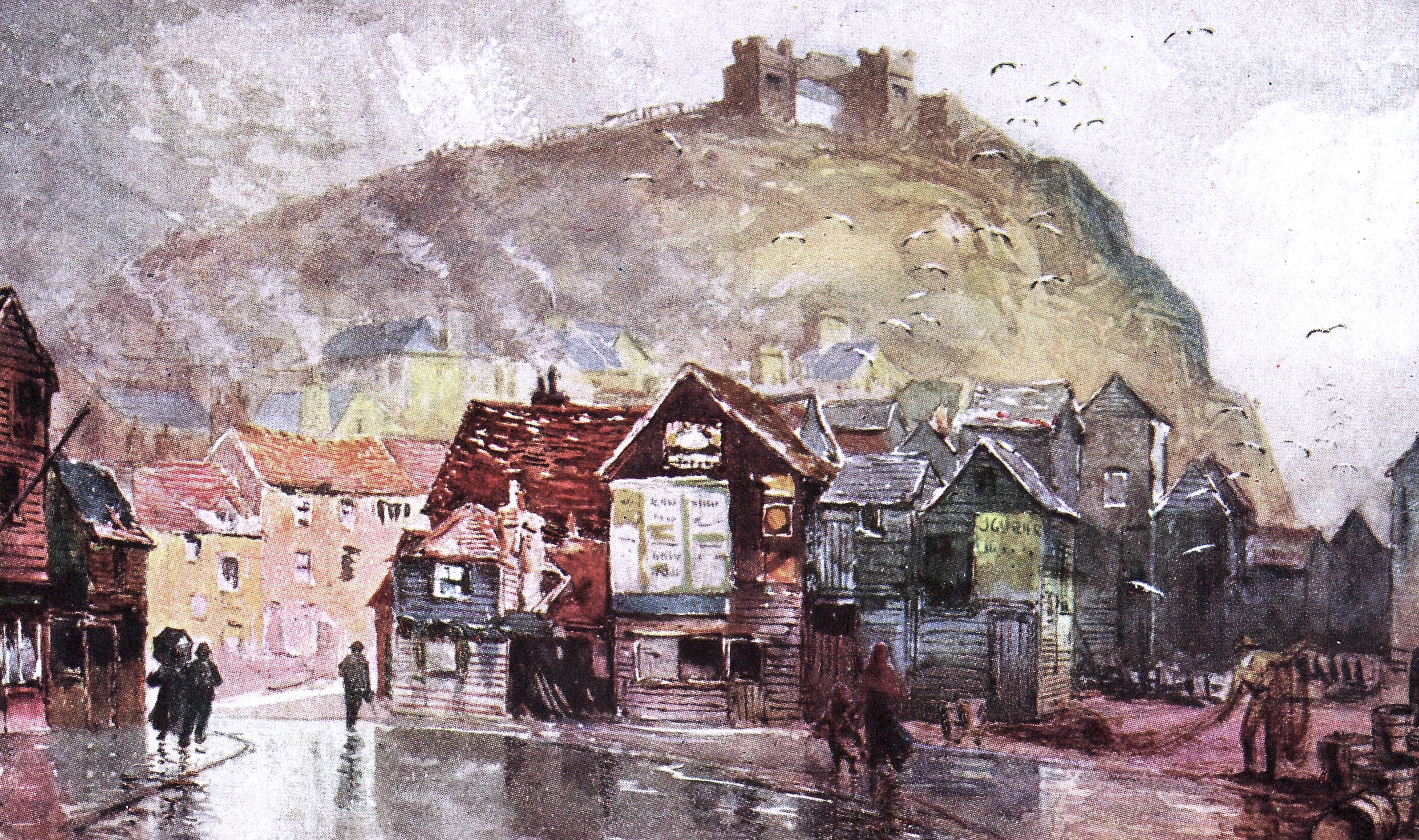
Mercers Bank before the First World War.
1926 Jan 26 - In London, John Logie Baird gave his first public demonstration of television, following his invention of it in Hastings in 1923-24.
1926 March 25 - Halton Baths were opened by the mayor.
1926 April - Work began on constructing the White Rock Pavilion.
1926 July - Messers Woolworth bought the block of 2-6 Wellington Place and 15-20 Pelham Street, which they soon demolished and replaced with the ‘threepenny and sixpenny’ store they ran until January 2009.
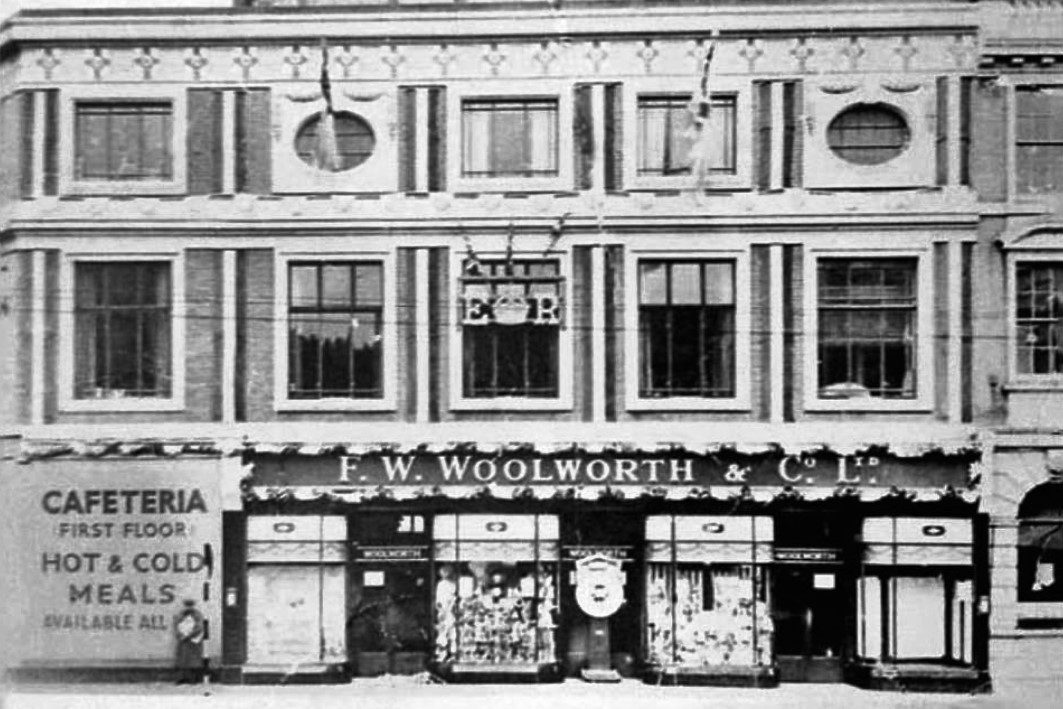
1926 Late July - Civil engineer Sidney Little (1885-1961) was appointed Hastings Council’s borough and water engineer to implement a large-scale redevelopment plan. This was to regenerate the town he described as 'Like some beauty-queen in decrepitude'. He became known as King Concrete for the many important schemes he initiated, and was probably the single most influential Council person up to the Second World War. A leading project was to rebuild many miles of the town's poor quality roadways, with all the seafront as the priority.
1927 - The Hastings Coastguard Station in Marine Parade closed, and Fairlight Station became the Hastings area headquarters. St Leonards Station, on the corner of Bexhill Road and Cinque Ports Way, also closed at this time, although the Rocket Apparatus Station remained there for many years. The west end of Marine Parade, between Pelham Place and George Street, containing the former Coastguard building, was renamed Sturdee Place in mid-1927 by Hastings Council, after Admiral Sir Doveton Sturdee.
1927 April - The large detached house called Johns Place off Cambridge Road was purchased for conversion into the town’s museum, as it is today.
1927 April 6 - Opening of the new White Rock Pavilion by the Prince of Wales (later King Edward VIII), on the site of the East Sussex Hospital. Prior to this the borough engineer Sidney Little had rebuilt part of the promenade and road at White Rock close to the east side of the pier. On this day the prince also witnessed the handing-over ceremony of 69 acres of the Firehills to the Council, which had bought them in order to stop the spread of housing development from the adjoining Fairlight Cove. In addition, the prince opened the newly-levelled recreation ground in Bexhill Road.
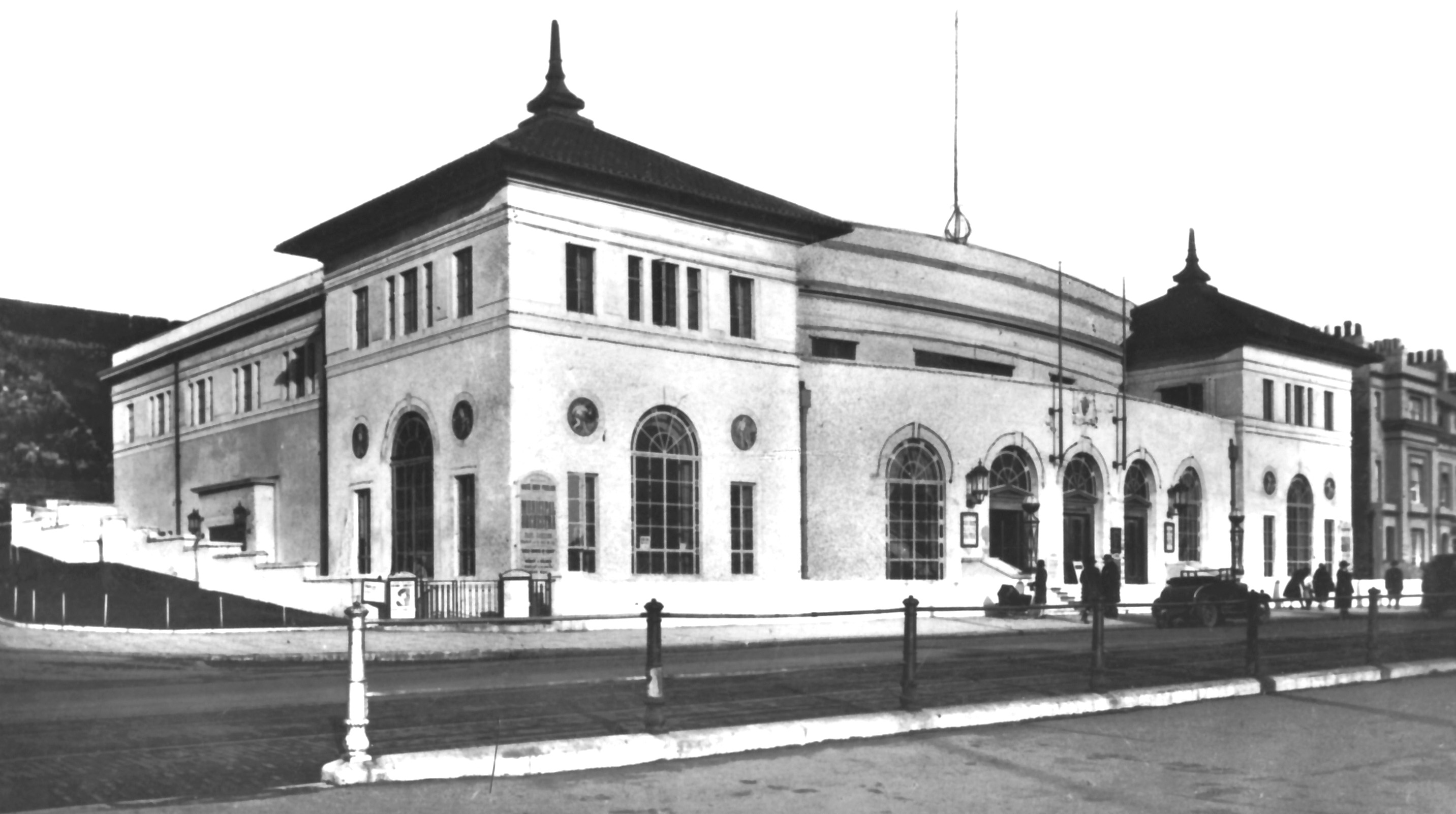
The White Rock Pavilion shortly after opening in 1927.
1927 Sept 26 - Opening of the rebuilt Plummers store in Robertson Street (later Debenhams).
1927 Oct - St Leonards Pier owner John Gardner offered to sell it to Hastings Council for £9,000, but they refused. In March 1928 Gardner rented the pier to a new company, who added many bright and attractive features to it, but then gave up in early 1929. Gardner subsequently ran the pier till 1933.
1927 Winter - Falaise Road was created, and Falaise Hall and the Bowls Pavilion in White Rock Gardens were built.
1928 - ‘Slum clearance’ started in the Old Town, the long-term project that ended with The Bourne being constructed in the early 1960s. The first people made homeless were re-housed in the new council housing in Hardwicke Road, Halton. The main clearance started in 1935.
1928 April 1 - The tram service started being replaced by trolleybuses. The transition took place gradually while overhead wiring was renewed and extended, and the tram rails were lifted and the road surface made good. The last tram ran on 13 March 1929. The retail fishmarket at the bottom of High Street (where the small car park is today) was demolished in March 1928, and this area became a turning circle for trolleybuses. The trams were never used elsewhere, but were sold off at scrap prices, and many became rural caravans or chicken sheds.
1928 June - A new open-air school for delicate children was opened, behind 150 Athelstan Road.
1928 June - Earl Jellicoe opened the large new British Legion headquarters building in a former warehouse in Devonshire Road, between Station Road and Middle Street.
1928 Sept - Hastings Police set up a ‘flying squad’, equipped with powerful motorbikes with sidecars.
1928 Sept 26 - Opening of the new Hastings Museum at Johns Place. The museum’s former space in the Brassey Institute was then available for the library to expand. In 1932 the Durbar Hall was added to Johns Place.
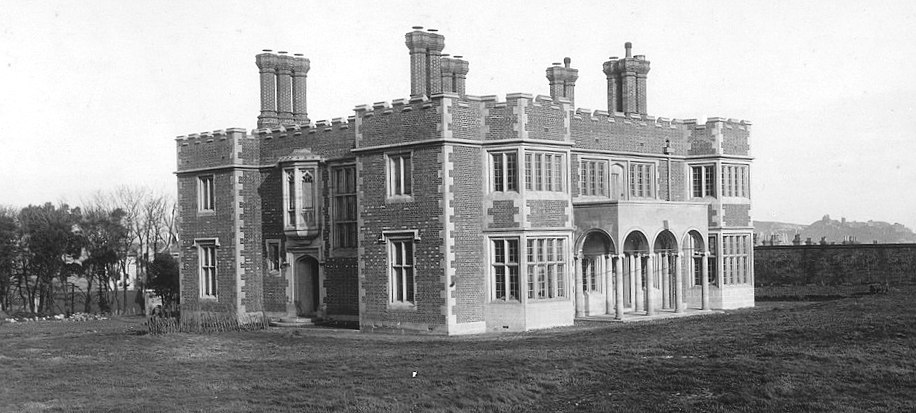
The Museum when it was a house, before 1928.
1928 Nov 12 - Death of Henry Cousins, well-known local historian and businessman, in his 86th year. He organised the first Hastings carnival, in 1895.
1929 Early - Baldslow Road was rebuilt.
1929 March - The Silverhill Picture House, on the corner of London Road and Beaufort Road, showed ‘talking pictures’, probably the first cinema in Hastings to have non-silent movies.
1929 March 11 - A major fire swept the Firehills and surrounding land to the north and west. The Observer reported there were 'four square miles of blackened countryside. … The fire raged all day and into the night.'
1929 March 13 - The last Hastings tram ran, between Silverhill and St Helens. The trams were replaced by eight open-top double-decker trolleybuses and 50 single-deckers. The Hastings Tramways Company ran the trolleybuses until late 1935, when the company was bought by Maidstone and District Motor Services Ltd. In 1936 the power station in Parker Road, set up in 1905 to run the trams, closed down and power was taken from the municipal service. In 1939 48 new double-decker trolleybuses were ordered, and remained in service until 1959, when diesel-powered buses replaced them.
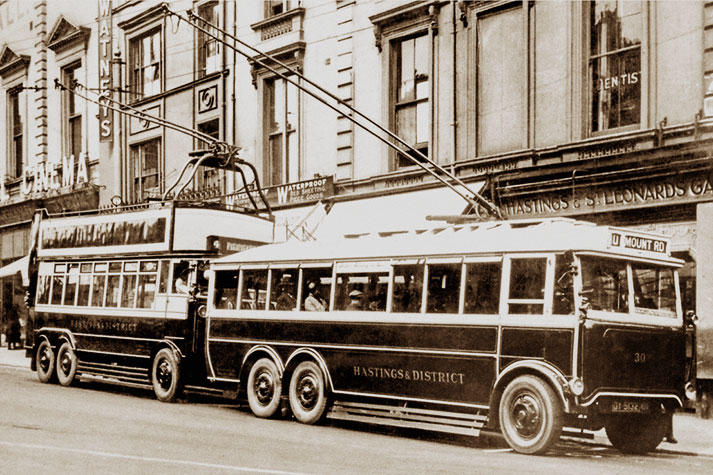
Two Hastings & District trolleybuses in Robertson Street in the early 1930s.
1929 Late May - The town’s first traffic lights were set up as an experiment, at the junction of Norman Road and London Road. This was successful and the first permanent lights were installed here and at White Rock-Robertson Street on 31 October 1934.
1929 May 6 - New public baths opened at Silverhill.
1929 June - Messrs Wilson & Sons large new café and bakery opened at Kings Road (and it is still there).
1929 June - The Public Library in Claremont had been extensively improved, following the Museum’s departure, and the lending library re-opened this month.
1929 Aug - Hastings Council gave the go-ahead to building a large new water reservoir at Great Sanders, Sedlescombe, as designed by Sidney Little.
1929 Nov 25 - The new St Ethelburga’s Church, at the bottom of Filsham Road, was dedicated. It replaced St Saviour’s mission church.
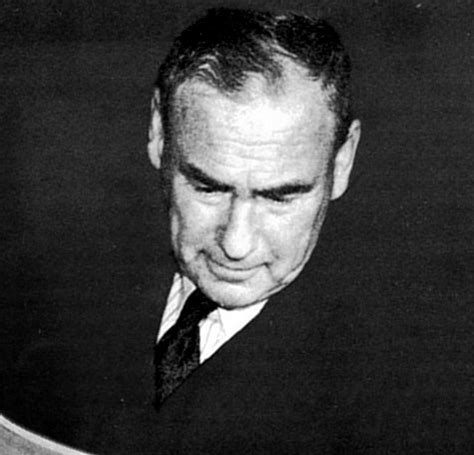
Sidney Little.
1929 Dec 13 - Hastings Council adopted Sydney Little’s Front Line Improvement Scheme, reclaiming land from the sea in order to build a new seafront. The first section was between Marine Parade and White Rock (there was no through road past the Queens Hotel prior to this). The £111,300 section included what was probably the UK’s first underground car park, 846 feet long by 60 feet wide, backed by sunken gardens in Robertson Terrace. Plus there was a new raised sea wall to protect against flooding. Work started in late March 1930 and was finished in December 1931.
1929-30 - All Hastings Pier’s substructure under the sea-end pavilion and to seaward of it was replaced as necessary, and the pier was widened on both sides of this pavilion. There were many other changes to the pier from this time onwards, including a small bandstand being built on the point at the sea-end of the pier; it opened in the spring of 1931. In 1931-32 the pier’s landing stage was doubled in width and extended 60 feet to the west.
1929-30 - Major improvements were carried out on Sedlescombe Road North, including road widening.
1930 Feb 3 - The 23-year old Katie McMullen started work as head laundress at Hastings Workhouse, having moved to Hastings from Tyneside . She married Hastings Grammar School teacher Tom Cookson in 1940, started writing books in 1946 and by the 1980s had become Britain’s top-selling novelist: Catherine Cookson. She was born on 20 June 1906 in East Jarrow.
1930 Feb 17 - The new main post office in Cambridge Road was opened, after three years construction. Prior to that it was at 1 Queens Road, where the Halifax Building Society is today. On 14 July a new telephone exchange opened upstairs at the post office (it had been at 47 Cambridge Road since 1894). The 1930 office closed in 2014 and moved into the WH Smith shop in the Priory Meadow shopping centre.
1930 Spring - Rock-a-Nore Road was widened as part of Old Town improvement scheme.
1930 May 24 - The new Salvation Army Hall in St Andrews Square was opened, replacing the old 'Iron Fort' with a brick-built structure.
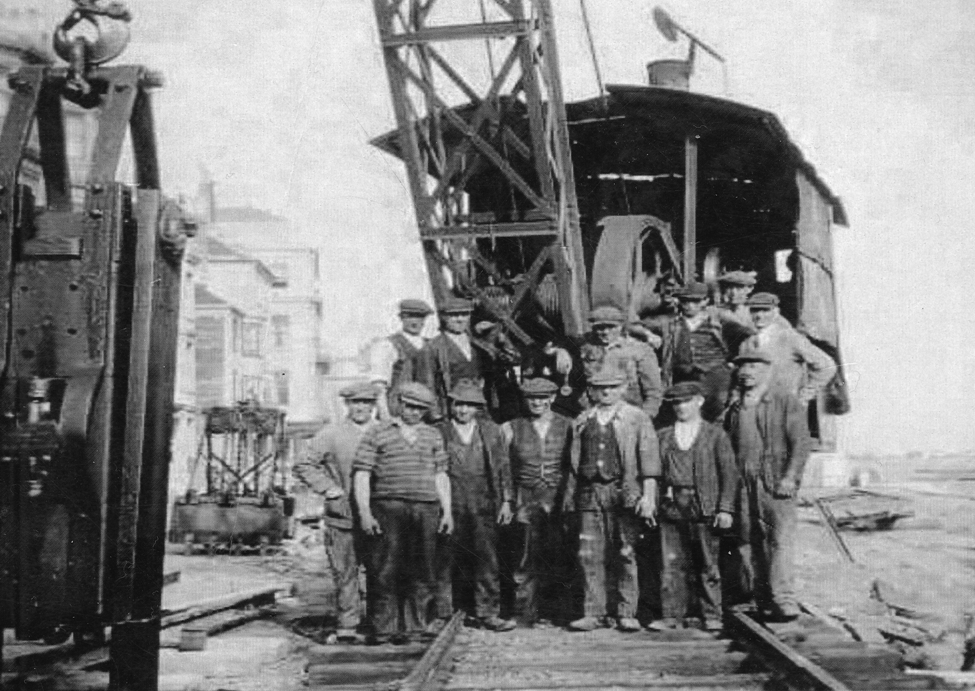
Improving the prom in the early 1930s.
1931 Feb 13 - Hastings Council agreed Sidney Little’s plan to spend £49,200 on improving the promenade between the west end of the White Rock Baths and London Road. This included building Bottle Alley, with its panels of recycled broken glass set in concrete, plus bastions, shelters and seats, and upgrading the sea wall. Work started in November 1933, and was completed with the opening of the Alley on 12 May 1934.
1931 Feb 28 - Lady Willingdon, accompanied by Lord Willingdon, Viceroy-Elect of India, laid the foundation stone of the Durbar Hall extension to Hastings Museum. This was to house the Indian collection left to the town by Lord Brassey, Lady Willingdon’s father.
1931 March 3 - There was a serious fire at Breeds’ Brewery, Bourne Street.
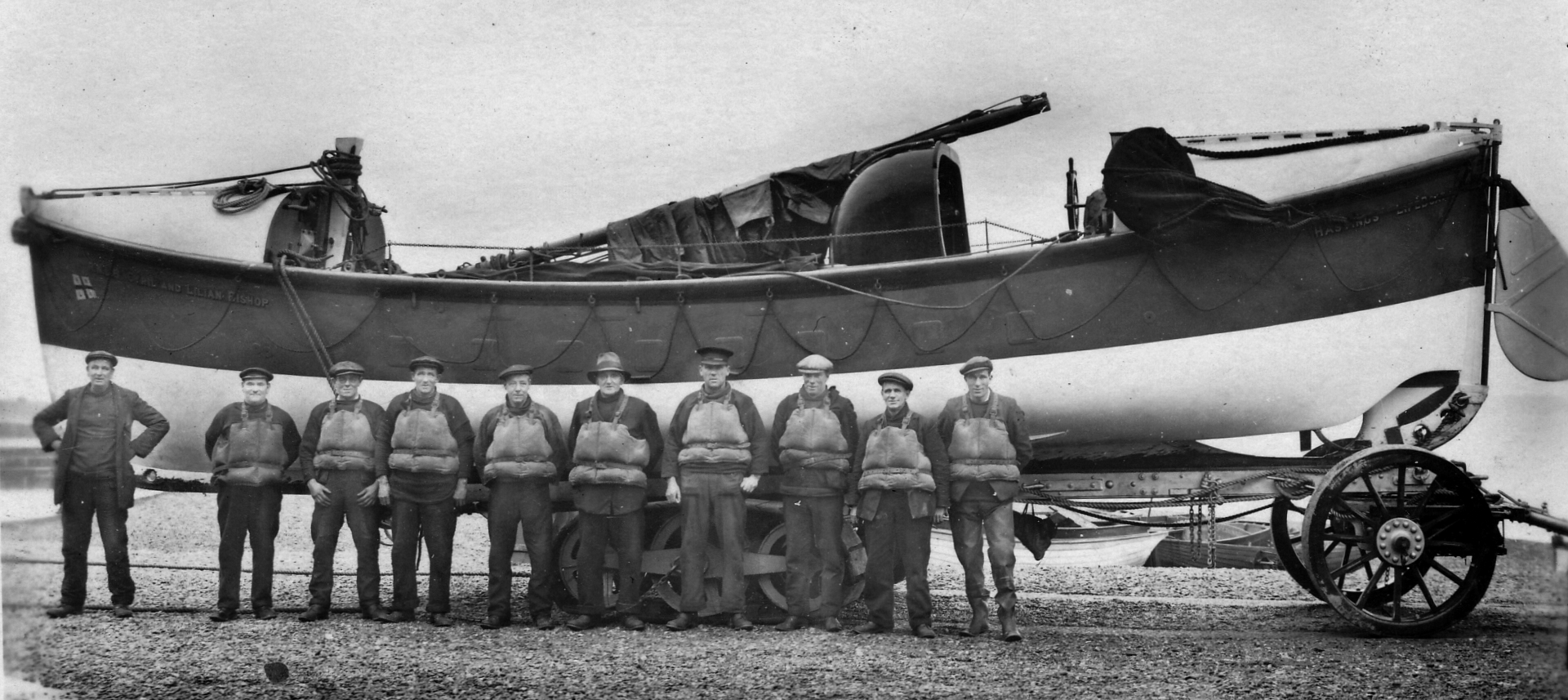
The Cyril and Lilian Bishop in the 1930s.
1931 April 29 - The first Hastings lifeboat to have an engine, the Cyril and Lilian Bishop, replaced the 30-year old rowing and sailing lifeboat Charles Arkcoll II. During her 19 years at Hastings she was launched 99 times and saved 34 lives. She also went to Dunkirk at the end of May 1940 and helped rescue an unknown number of troops, probably many hundreds. She was replaced in 1950 by the MTC.
1931 June 15 - The Upper Warrior Square Gardens, at the north end of the Square, had been privately owned since they were created. But in 1931 they were presented to the borough by their owner Major HC Holman, with a covenant dated on this day which said the Council had 'to maintain same as pleasure ground'.
1931 June 27 - The greatly improved White Rock Baths were opened by Earl Howe; £34,000 had been spent on them, one of Sidney Little’s proposals.
1931 July 6 - The new Hastings railway station was opened, following complete demolition and rebuilding of the original 1850 station, at a cost of £200,000. It was replaced by a 'modernist' glass-fronted building on a different site in 2004,
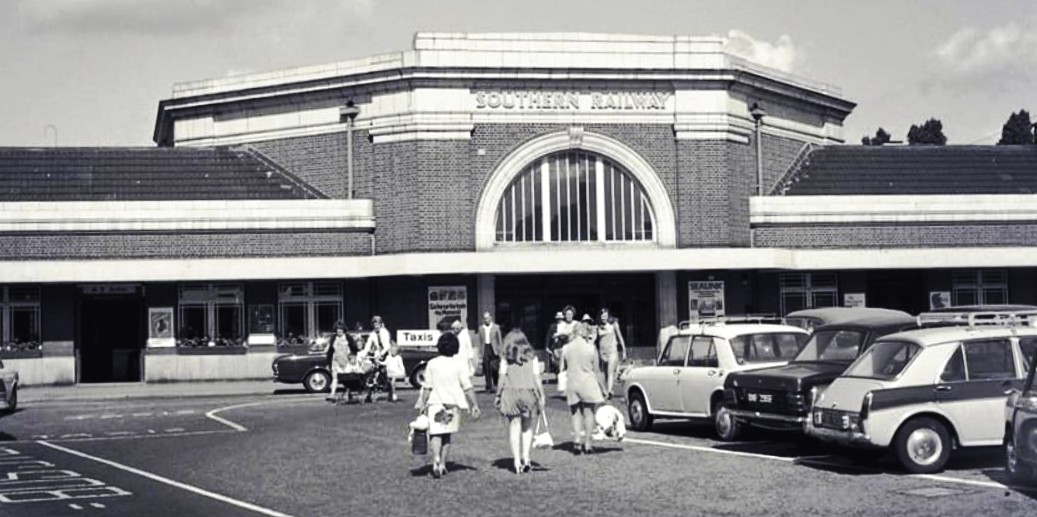
The 1931 station, seen here in the 1960s.
1931 July 2-8 - The famous aviator Amy Johnson took passengers on flights from a field by Fairlight Church in her Gypsy Moth two-seater biplane Jason III. In May 1930, aged 26, she had become the first woman to fly solo to Australia, using a very similar Gypsy Moth.
1931 Oct 13 - A large clubroom for the many unemployed people in the town was opened for the winter. It was above Central Hall, in Bank Buildings. On 26 November about 500 unemployed people marched from Silchester Road to the town hall. The clubroom closed on 25 March 1932.
1931 Nov 22 - A large and enthusiastic crowd packed the Cinema De Luxe to hear General Higgins, leader of the Salvation Army, give a stirring speech.
1931 Nov 26 - About 500 unemployed people marched from Silchester Road to the town hall, carrying red and white banners, and singing to tunes from an accordion.
1931 Dec - Hastings Council purchased from the Sayer family land on the east side of Rye Road on which to build council houses and a school. In 1937 the Council bought from the Sayers much more land for housing, north of Rock Lane and on both sides of Rye Road.
1931 Dec 8 - The new seafront between Marine Parade and White Rock was opened by the Minister of Health. This was called the Front Line Improvement Scheme (the 'front line' was the name then given to all of the town's border with the sea). The large terrace of Victorian houses and other buildings called Beach Terrace, opposite Pelham Place and at the west end of Marine Parade, had been demolished in mid-1931 to make way for the new seafront.
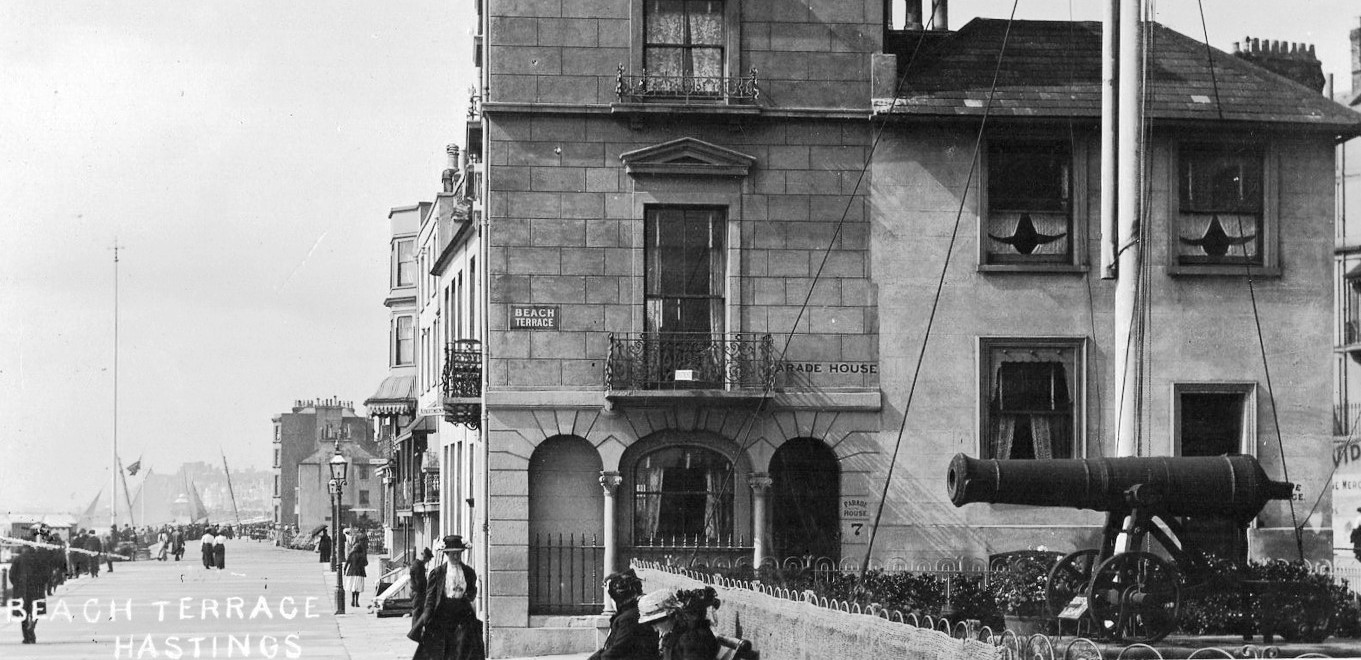
Beach Terrace opposite Pelham Crescent, demolished in 1930.
1932 - The Maidstone and District bus company leased the corner of the Central Cricket Ground nearest the town hall to use as a coach station.
1932 Jan 12 - The new Employment Exchange opened in Priory Street, on the corner of Cornwallis Terrace, having moved from 37 Havelock Road. I
1932 Feb - Lovers Seat was heavily vandalised and had to be replaced.
1932 April 29 - The Durbar Hall extension to the museum was opened.
1932 May 14 - The last theatrical production took place at the Gaiety Theatre, in Queens Road. It re-opened as the Gaiety Cinema on 12 December 1932.
1932 June - The former University School in Holmesdale Gardens was acquired by the hospital. It was demolished and a nurses’ home opened on its site in July 1934.
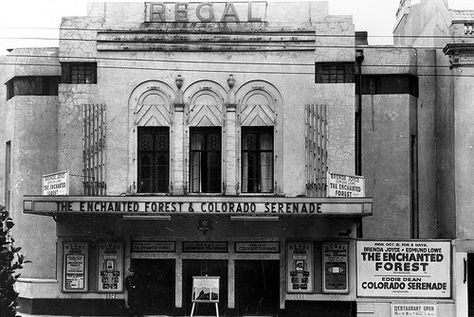
The Regal, showing The Enchanted Forest.
1932 Aug 8 - The new Regal Cinema, on the corner of London Road and Station Approach, was opened by the mayor. The 1,600 seat building was also a theatre, featuring well-known names like Duke Ellington and Louis Armstrong. It was renamed the ABC Regal in 1950 and closed on 8 September 1956. It remained empty until 1973 when it was demolished to make way for the 12-storey office block Ocean House.
1932-33 Winter - The whole frontage of Hastings Pier abutting the parade extension was rebuilt in the fashionable art-deco style. It survived, with some changes, until the 2010 fire.
The new frontage of the pier.
c1933 - Wards Shop, the outfitters, opened on the site of the old Post Office, on the corner of Queens Road and York Gardens.
1933 - A boating lake was built on the beach in front of the Old Town, with work beginning in early January. It was a time of increasing unemployment, so Hastings Council gave the job to men who were either on unemployment pay or Poor Law Relief. About a hundred men were employed in three-week sessions, giving considerable aid to a large number of people during the five months it took to build the lake. In late 1932 an Assistance Committee was set up to help as many of the unemployed and their families as possible, and the committee launched a special appeal for boots for the boating lake workers. The two-feet deep lake covered 7,900 square yards of what had been beach, and had a paddling pool at the west end. The lake opened in late May 1933 and was immediately a big attraction, with 30,500 people taking a ride during its first two months. In 1934 the Council erected 12 tall posts around the edge of the lake, which were linked together in pairs, with colourful light displays, which remained in use until the 1950s.
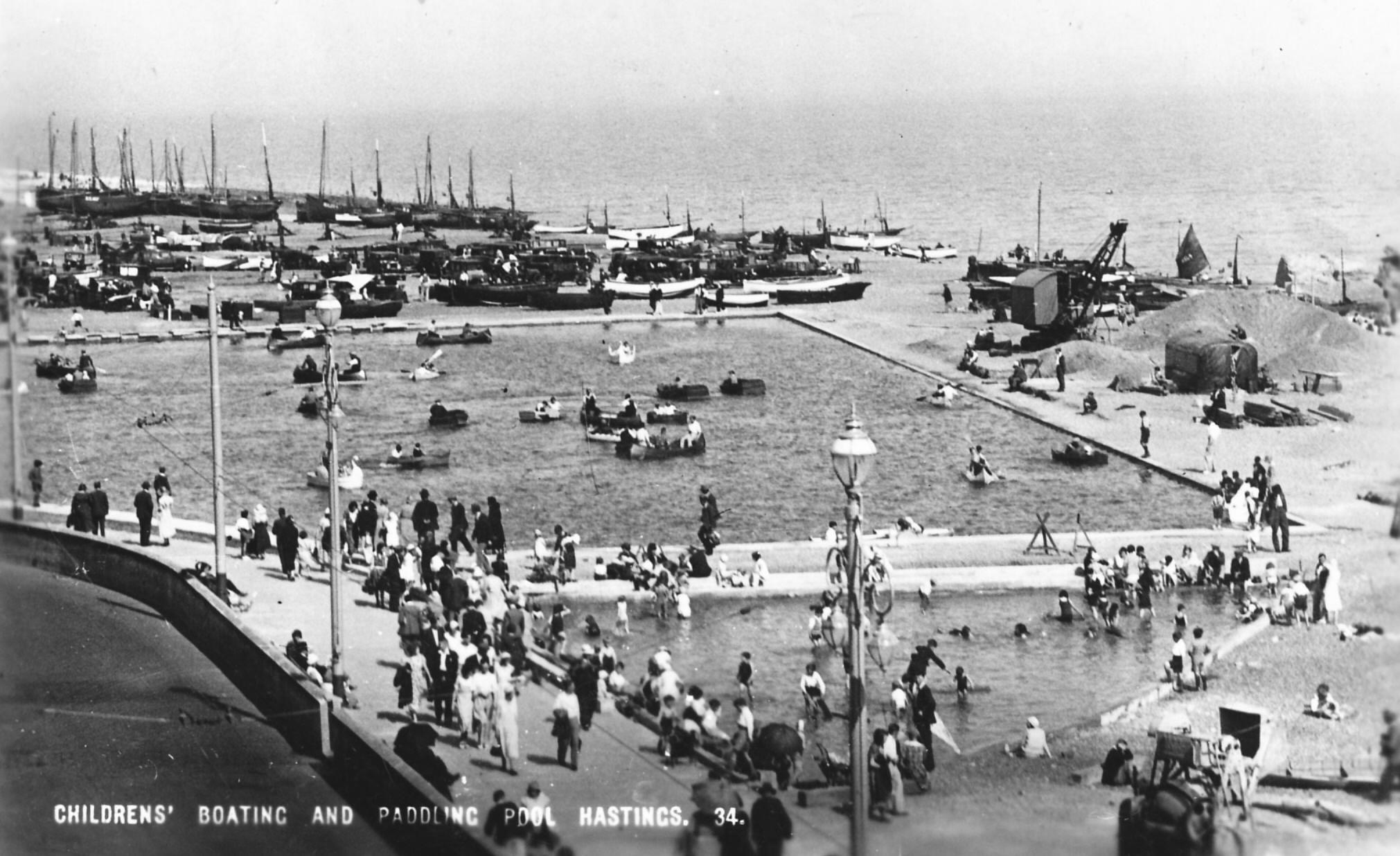
The boating lake in mid-1933, soon after completion by the machinery on the right.
1933 May 27 - The Bathing Pool at West St Leonards was officially opened, along with new facilities at White Rock Baths. The pool, created by Sidney Little, was said to be the largest in the UK (and possibly Europe), being 330 feet by 90 feet, with a capacity of at least 800,000 gallons and seating for 2,500 people. It had been created by the borough engineer Sidney Little, who was then building Bottle Alley and had already rebuilt the eastern end of the promenade c1930 and had constructed the Falaise Hall in 1928 and the Great Sanders dam in 1929. Work on the pool had started in January 1932 and it was an immediate great success, having 33,000 visitors in its first week. But it was not financially viable in the long term, and it closed in 1959. In 1960 it passed into the hands of Alderman Sid Withers, who converted it into a down-market holiday camp. It closed in 1986 and was demolished in May 1993.
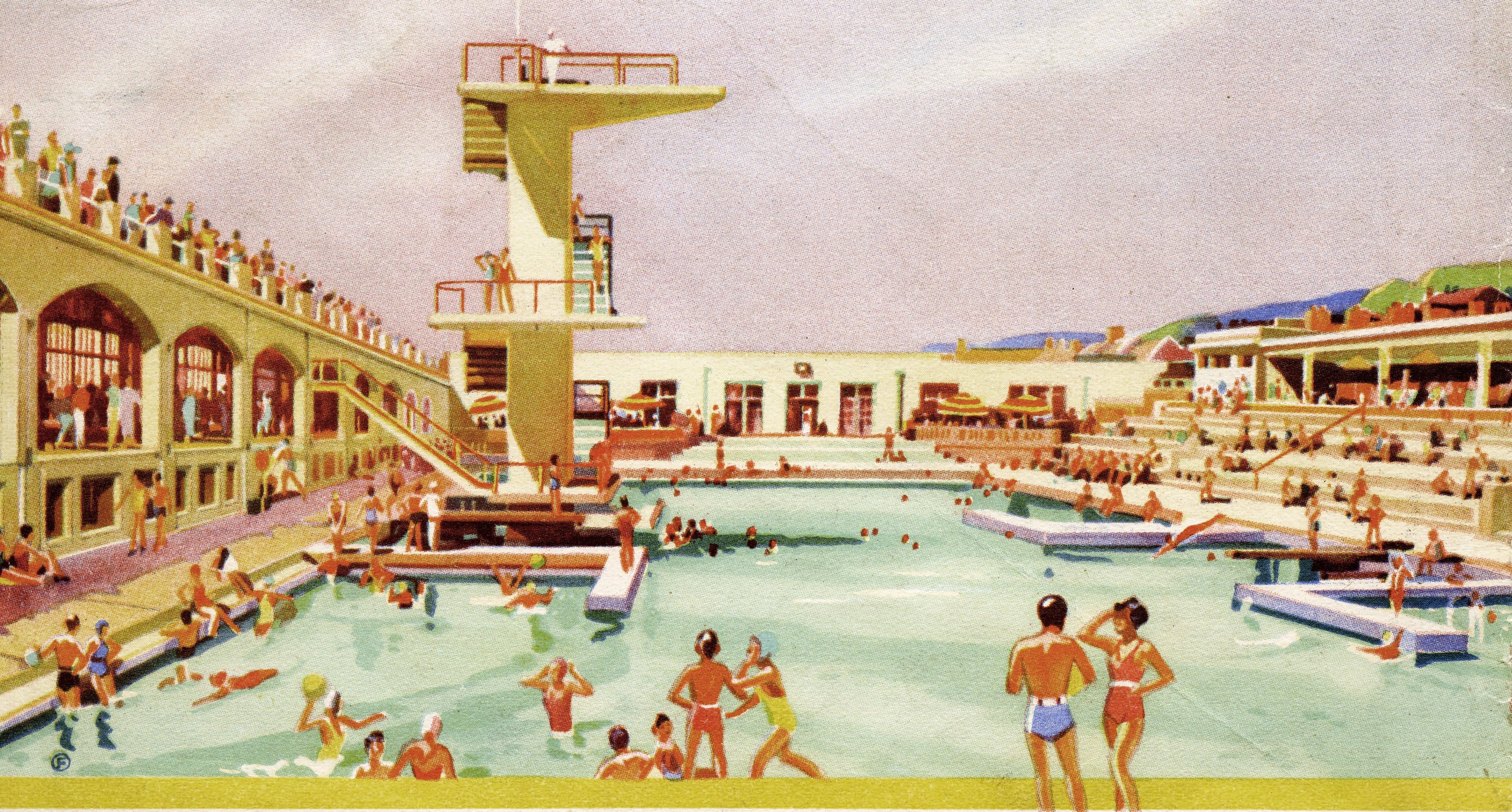
The colourful Bathing Pool.
1933 July 27 - Sainsbury opened a new Hastings store, at 14-16 Wellington Place, on land bought from Hastings Council.
1933 Aug - Hastings Council agreed to buy 17 acres of Pebsham Farm as the possible site of an aerodrome, but nothing much happened the scheme was put in abeyance in 1938 until the 'Official Opening of the Hastings Aerodrome' took place in July 1948.
1933 Sept - Following the collapse of John Gardner’s St Leonards Pier-owning company, he sold it to two London brothers, David and Philip Lannon. They carried out many major changes over the following winter, and in March 1934 it was relaunched as the ‘New Palace Pier’.
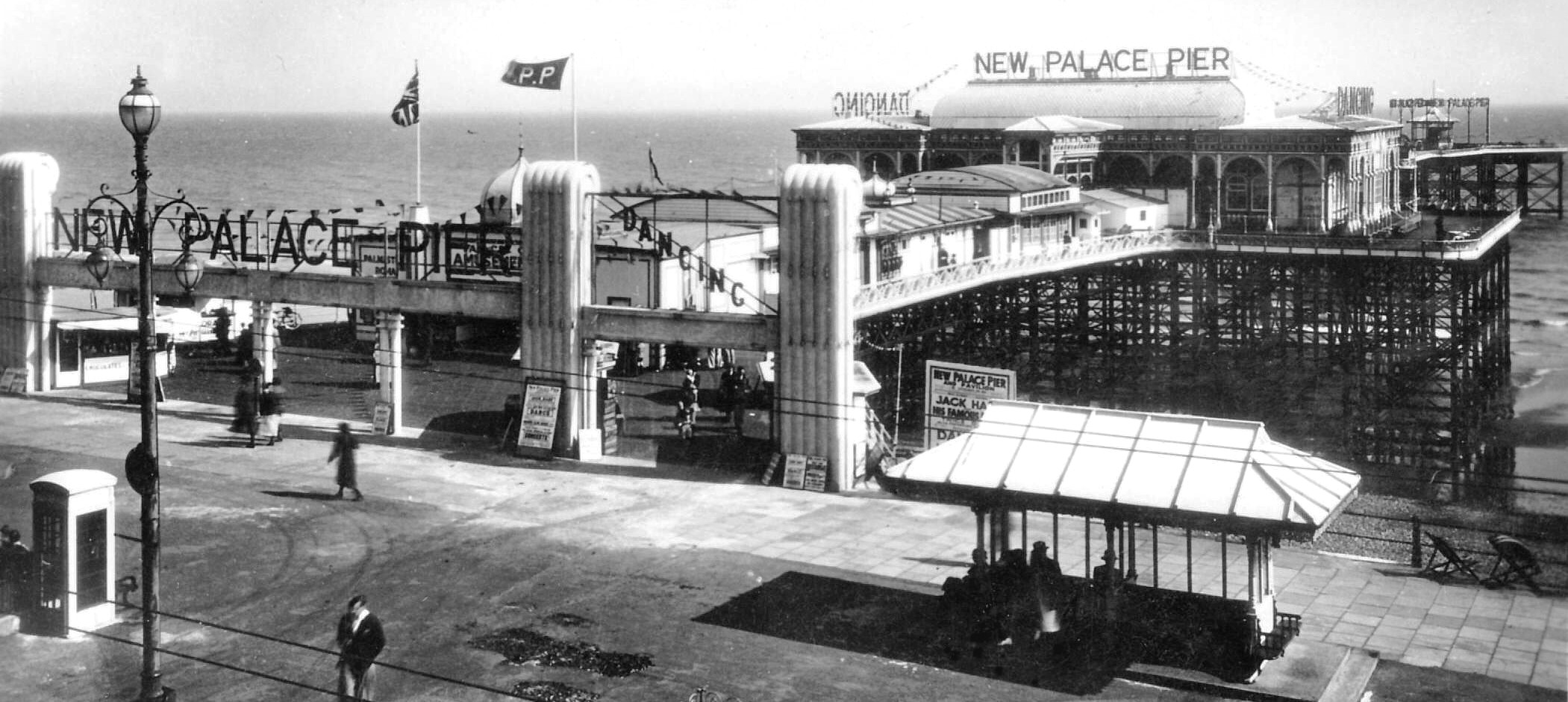
The St Leonards Pier becomes the New Palace Pier.
1934 - The large section of Old London Road between Clifton Road and Baldslow was given the new name of The Ridge.
1934 March 9 - Hastings Council agreed to buy 36 acres of Bembrook Farm for £10,000 from Major Carlisle Sayer for re-housing the dispossessed from the Old Town redevelopment. The sale took place in November 1934.
1934 April 14 - At a meeting held in the large house Varenna, on the corner of Filsham Road and The Green, a local branch of the British Union of Fascists was set up.
1934 May 12 - Bottle Alley, the new promenade linking White Rock and Warrior Square, was officially opened.
1934 July 14 - Lady Willingdon officially opened the new Nurses’ Home at the Royal East Sussex Hospital, Cambridge Road.
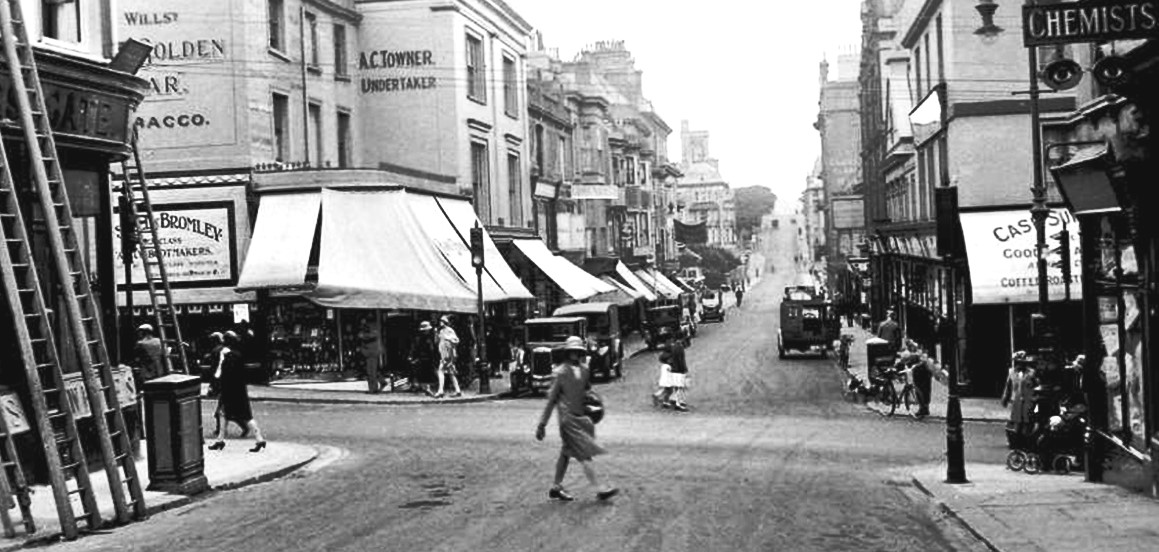
The town's first traffic lights, in the 1929 experiment at the junction of London Road and Norman Road.
1934 Oct 31 - The town’s first permanent traffic lights were set up at the junctions of Norman Road/London Road and White Rock/Robertson Street, following the May 1929 experiment at Norman Road/London Road.
1934 Nov - The Ministry of Health gave the go-ahead for a major ‘slum clearance’ project in the Old Town (actually a way of building a new road, The Bourne, without having to pay displaced home owners the true value of their 'slum' property). Over 600 people were to be re-housed in new council housing to be built at Bembrook, Ore and Hollington, despite much opposition. Work started early in 1935 and caused much distress over the following years. The scheme not only damaged the lives of hundreds of local people, but also destroyed much of the character of the Old Town. The Bourne opened in 1963.
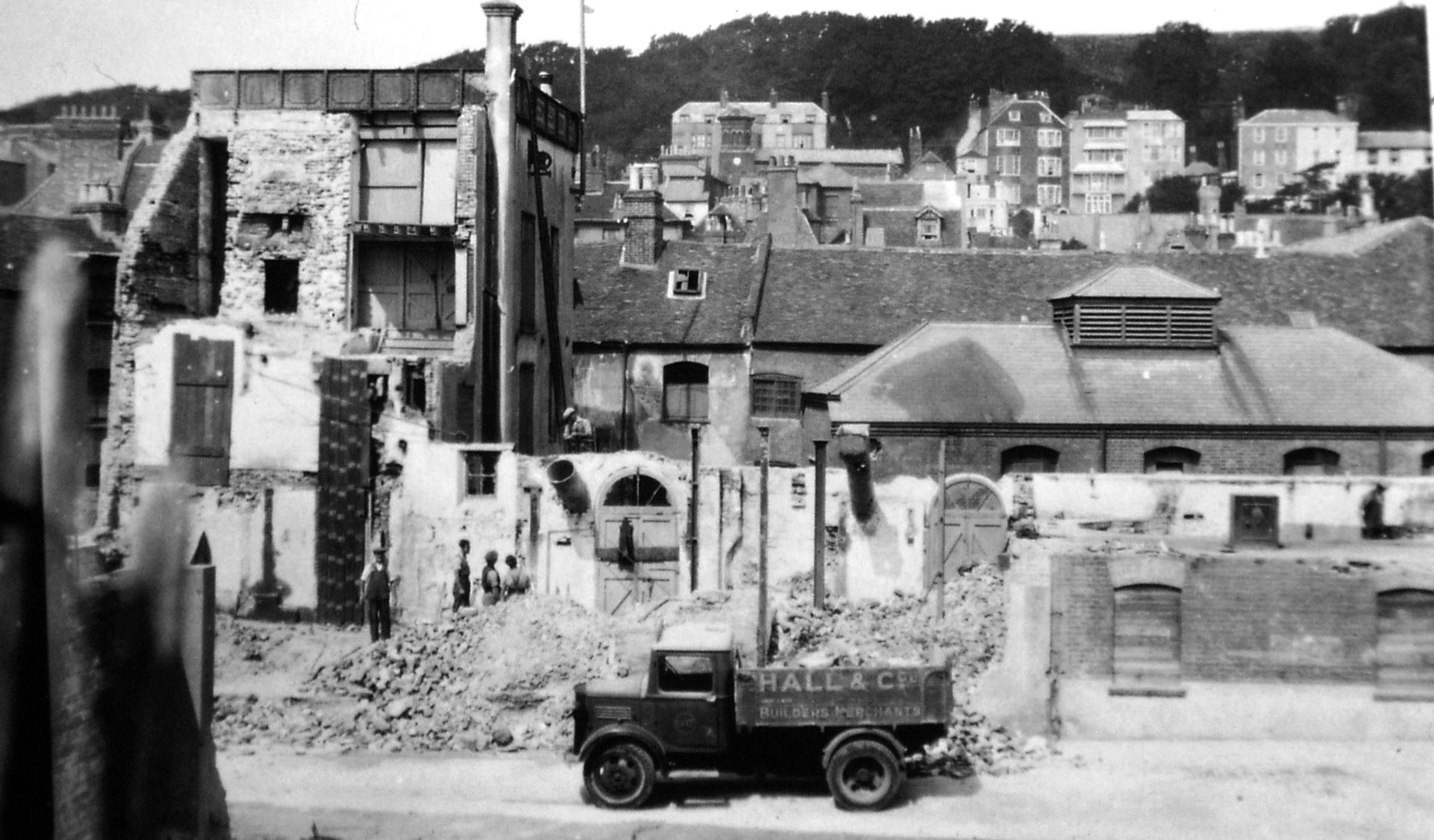
The demolition of Breeds Brewery in 1957 to make way for the Bourne.
1934 Dec 14 - Hastings Council agreed Sidney Little’s plan to rebuild the promenade and sea wall from London Road to the Bathing Pool. The work was completed by December 1938.
1935 - The 1935 edition of the Visitors’ Guide described Hastings as ‘The 1066 Town with the 1966 Outlook’.
1935 May 5 - Arrival of the first electric train to enter Hastings, on the newly-electrified Ore-Brighton line. It was inaugurated on 4 July.
1935 May 6 - The silver jubilee of King George V was celebrated around the borough, especially in the Old Town, where a big programme of events began at 4.30am and ended at midnight!
1935 May 10 - Amherst Gardens off Amherst Road were donated to the town by Alderman Thorpe as open space for perpetuity.
1935 May 18 - Death of Frederick Notley, founder of the Yelton Hotel (Notley backwards) in 1892. It was then just one house, 4 White Rock, but is now the much bigger White Rock Hotel.
1935 Aug 31 - John Manwaring Baines started work as Museum Curator. The first edition of his important book Historic Hastings was published in 1955. This was to be the seminal work on the town's history.
1935 Nov 11 - The Hastings Tramways Company, running the town’s trolleybus service, was taken over by its main rival, Maidstone and District Motor Services, part of the British Electric Traction group.
1936 - The Hastings Pier Company decided to greatly improve the pier's sea-end pavilion (then still looking like a barn) by removing all the buildings close to its northern end and extending it, to include two large pointed towers. Most of the work was completed by the summer of 1937, but there had been major problems with the pier’s substructure, which had to largely rebuilt underneath the pavilion, at a cost of over £20,000.

The plan for the new pavilion.
1936 Feb 12 - Sir Oswald Mosley, leader of the British Union of Fascists, addressed a fascist meeting at the White Rock Pavilion. Anti-fascists gave out leaflets outside the Pavilion.
1936 June - Alfred Dyer, editor of the Hastings Observer and a leading figure in the local Establishment, was knighted. In July 1946 he resigned as chairman of the Hastings Conservative Association, a position he had held for 25 years. The association thanked him for 'untiring and loyal work for the party'.
1936 June 15 - Opening of the new underground car parks between Hastings Pier and Grand Parade, St Leonards, by the Transport Minister, Hore-Belisha.
1936 Nov 30 - Laying of the foundation stone of Marine Court, on the site of 22-32 Marina. When it opened in 1938 the 14-storey, 170-feet high building was described as the highest dwelling place in Britain. It was modelled on the new ocean liner Queen Mary, launched in 1936. In the Second World War the whole building was requisitioned for service personnel. In the 1960s, the ballroom on the east end became the highly popular Witch Doctor Club, and later the Cobweb, where pop stars David Bowie, Status Quo, Geno Washington and Georgie Fame played.
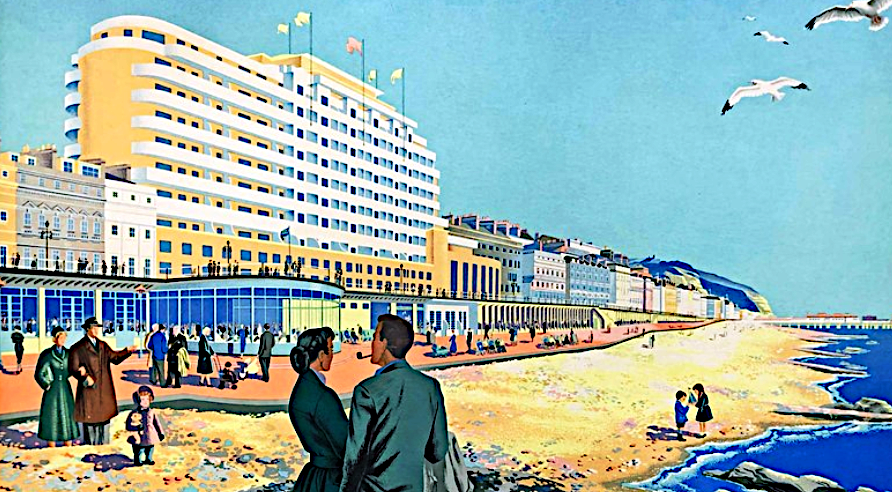
Marine Court just before the war.
1937 - The fishermen set up the Hastings Fishermen’s Protection Society to defend themselves against attempts by Hastings Council to force the fleet to move to Rye so that their beach could be used for amusements.
1937 Jan - The Hastings car registration letters DY were to have prefixes from this time, starting with ADY.
1937 Feb 18 - A huge fire destroyed the large agricultural warehouse in Earl Street, the Strickland family business.
1937 March - The new Dawn and Dorset Laundry opened in Elphinstone Road, on the corner of Hoads Wood Road. It was said to be representative of British Modernistic architecture, capturing the spirit of the age, and was designed by Kenneth Wray, an admirer of Frank Lloyd Wright. The laundry had begun life as the Cambridge Laundry at 8 Dorset Place, moving from there to Portland Place, then to new premises at Elphinstone Road. In 1937 there were 22 laundries in the town, but demand fell after the war as laundrettes opened and washing machines became popular. In 1982 they were the only lanudry in Hastings. The striking building was demolished in December 1995 and replaced by housing on the orders of the deeply criticised borough planner Tony Fry, who was said to be in the hands of developers.

1937 Dec - The fishermen began a legal action in the High Court to determine their rights over the Stade. Hastings Council was trying to force the fleet to leave the beach and go to Rye, so that the area could become a profitable tourist amenity. The Hastings Fishermens Protection Society was formed to pursue the case, but the Second World War put the matter on hold until May 1947 (cf).
1938 - Work began on building the massive new water reservoir at Darwell, near Mountfield. This was considered to be the peak of Sidney Little’s engineering achievements. The war halted the construction, which was completed in 1950.
1938 Feb - Southern Railway decided not to electrify the Sevenoaks to Hastings line, a move described as a 'bombshell' for Hastings and Bexhill.
1938 Feb - Hastings Council started a new travelling library service.
1938 March 19 - Opening of the magnificent Ritz Cinema (later called the ABC) in Cambridge Road. It was the biggest and best cinema in the town, with a beautiful Wurlitzer organ and 1,984 seats. It became one of the town's main live venues, with stars such as Cliff Richard, The Shadows and Billy Fury appearing on stage. Remains of the medieval priory that stood on the site were found while digging the foundations. The last film shop was on 6 October 1971 and it was demolished soon after. A Sainsburys supermarket opened there in 1974, and ESK took over the building when Sainsburys moved to Sedlescombe Road North.
The demolition of the ABC soon after it closed in 1971.
1938 April 1 - The borough boundary was extended by the 1937 Hastings Extension Act. The new land included parts of Ore and Fairlight.
1938 April 19 - The true identity of native Canadian wilderness campaigner Grey Owl was revealed in the Evening Argus as being Archie Belaney, who was born in Hastings in 1888. He had set sail for Canada in 1906, where he converted himself into the indigenous Grey Owl, and achieved world-wide fame as an ecological conservationist. It was only after his death in 1938 that it was revealed that his Canadian life-story had been fictional, and that he was Hastings born and bred. He had an unhappy childhood, and while at Hastings Grammar School he developed a love of natural life, especially animals, and often explored what is now the Hastings Country Park Nature Reserve. He published several books in the 1930s, the first being The Men of the Last Frontier (1931).
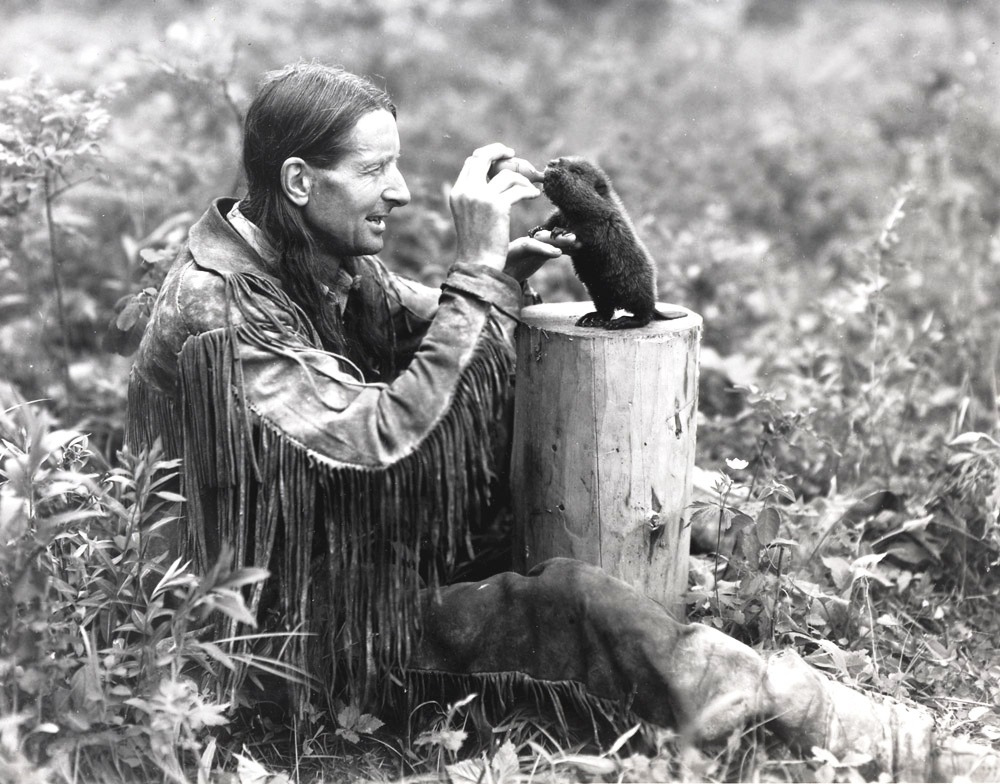
Archie Belaney as Grey Owl.
1938 July - Hastings Council accepted Major Sayer’s generous offer of selling North’s Seat and the acre of surrounding land to the Council for £100. The seat had been replaced by a large viewing platform in 1930, which was to be used as a look-out during World War Two. But this was vandalised in 1982 and so was demolished and replaced by two seats, with a large round direction plaque, which is still there. Much of the rest of Fairlight Down was acquired by Hastings Council in following years.
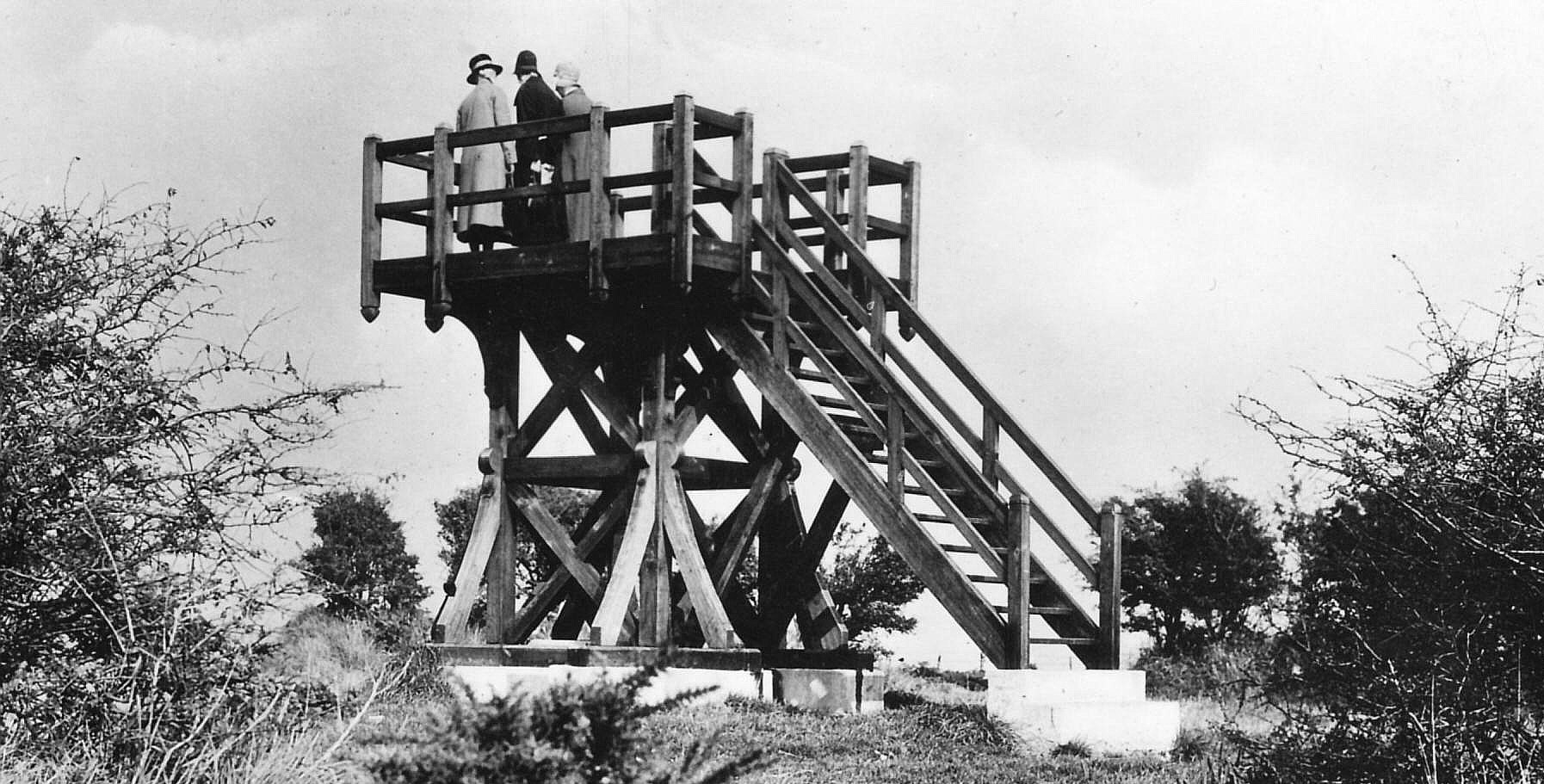
North's Seat in the 1920s.
1938 Sept 28 - The ‘New Palace Pier’ (St Leonards Pier) was put up for auction, but the highest bid was £34,750, which was insufficient, so it was withdrawn.
1938 Sept 30 - The large Dengate’s furniture store in Queens Road was gutted by fire. This was the last day for the volunteer fire brigade, the last such brigade in the country (and the first to be formed), being replaced by professionals from 1 October.
1938 Late - The Hastings branch of the Communist Party published a pamphlet called The Other Hastings, saying that there were 'two boroughs of Hastings, that of the rich and that of the poor'. Working people received 'low wages, bad housing conditions, long hours of work,' and were unable in many cases unable to buy even sufficient food for their families.
1938 Dec 17 - Opening of the Sun Lounge (later called the Marina Pavilion, and now Azure), opposite Marine Court.
The Sun Lounge.
1939 - A row of 20 semi-detached houses was built at the bottom of Harold Road with bomb shelters included.
1939 Jan - The Bourne Street Wesleyan Chapel closed and was then demolished and rebuilt, opening 20 March 1940.
1939 May - Laying of the foundation stone of Red Lake infants’ school, on the east side of Rye Road, the town’s first new school for 40 years.
1939 May - A new company, the Fairlight Mining Company, leased land from Major Sayer between the top of Warren Glen and Fairlight Church to dig for sand. It created the large quarry at the top of the glen, and a smaller one nearer the church which is today’s Country Park car park.
1939 May 7 - A large demonstration took place along the seafront by members of the labour movement in protest against unemployment and the forthcoming war.
1939 Sept 1 - In a three-day evacuation of London on 1-3 September, about 7,000 people were brought to stay in Hastings.
1939 Sept 3 - The Second World War started on this day, but little happened locally before the early summer of 1940. Hastings Pier remained open initially, although with scaled-down operations, but St Leonards Pier closed in September 1939 and never reopened to the public. The first bombs fell on the town on 26 July 1940 and the last flying bomb incident was reported locally on 8 August 1944. During the war the town experienced 85 enemy air attacks of various kinds. A total of 550 high explosive bombs fell in the borough, including 27 which failed to explode, plus about 750 small incendiaries and 15 flying bombs. These attacks killed 154 people, seriously injured 260 and slightly injured 439 people. 463 houses and other buildings were demolished and 14,818 were damaged.

Sea defences being put up on the St Leonards promenade.
1939 Oct 14 - Heavy rain and high spring tides brought the worst town centre flooding since before the First World War.
1940 Jan - Railings were put up on the high pavements in the Old Town, as protection for pedestrians in the blackout. They were left in place after the war.
1940 March 29 - The Hastings fishing boat Happy Return RX 198 was blown up by a mine off Rye Harbour and her two crewmen killed.
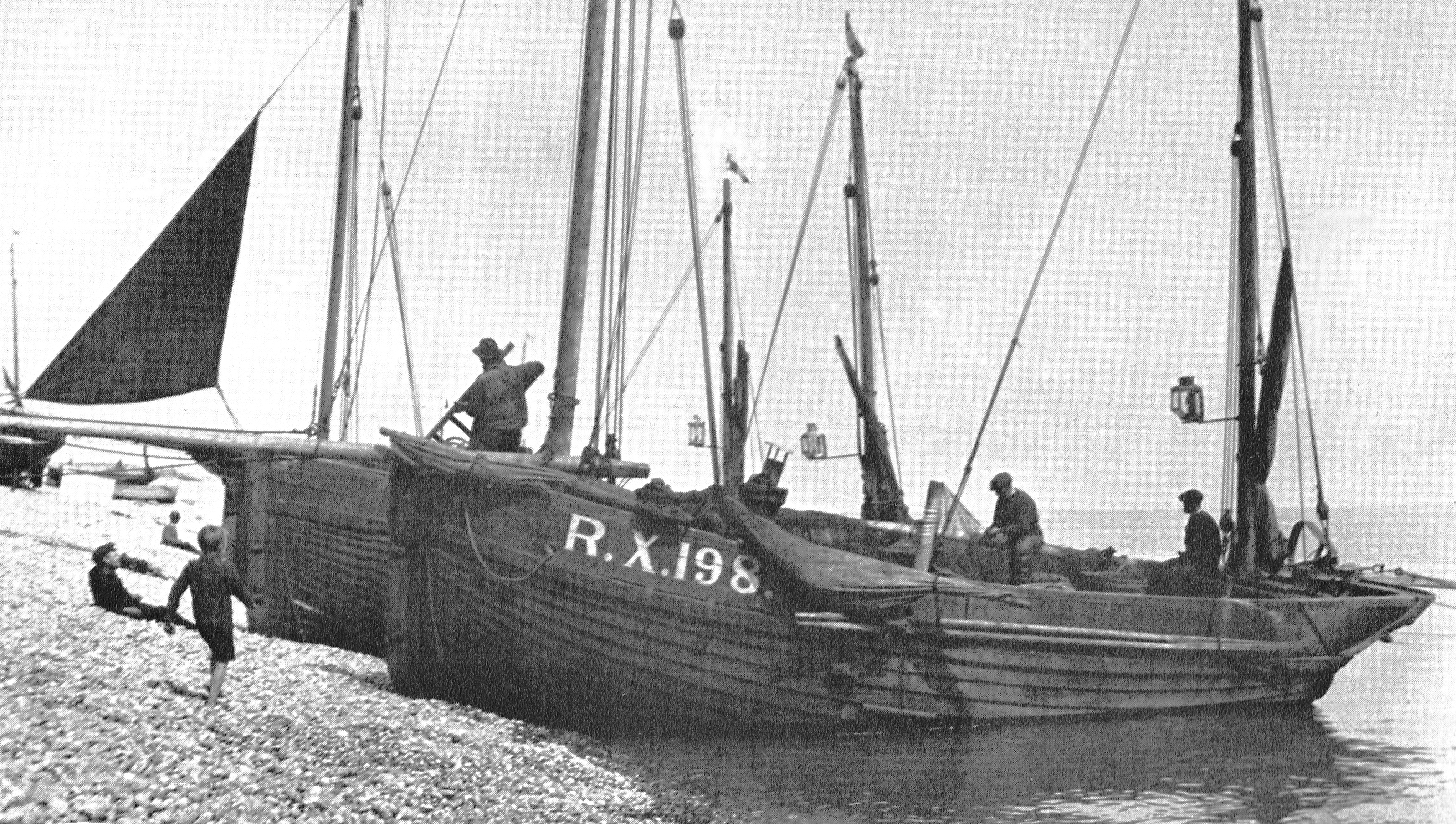
The Happy Return before the war.
1940 May 22 - Refugees from France and Belgium were landed on Hastings Pier by a Belgian tug. Two men were carrying 13 million Belgian francs, the funds of the Belgian railway.
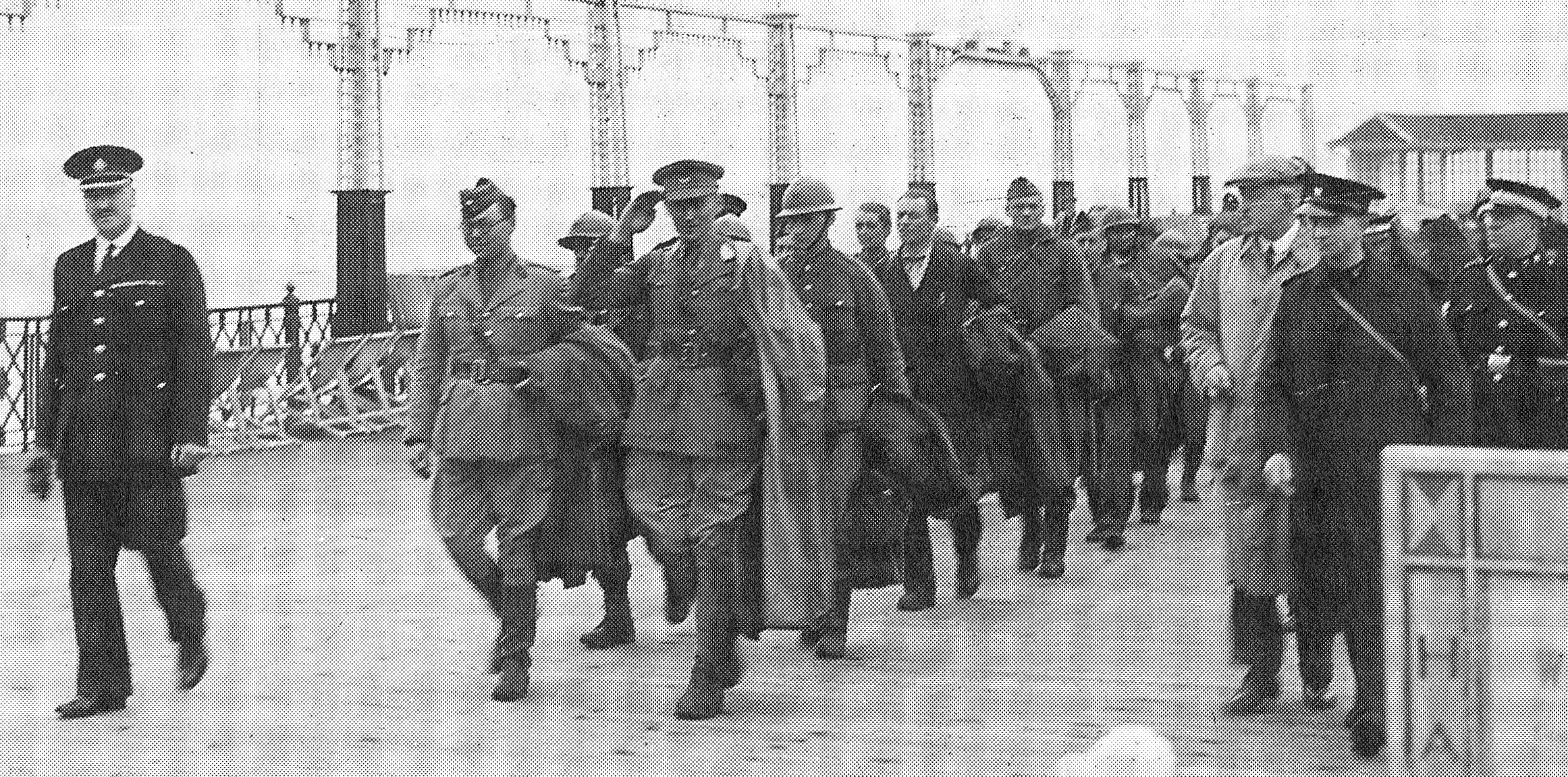
The Belgian refugees on Hastings Pier.
1940 Late May - The Hastings lifeboat Cyril and Lilian Bishop took part in the evacuation of British troops from Dunkirk. The larger Hastings fishing boats went to Dover, as requested by the Navy, but were not used. The Cyril and Lilian Bishop probably rescued hundreds of soldiers at Dunkirk, and returned to Hastings with damage to her hull, which was quickly repaired so that she could continue in service at Hastings throughout the war.
1940 June - Foreigners were forced to move inland at least 20 miles from the coast, affecting many local businesses. Hastings was included in the ‘defence area’ so no one could enter except on business. All local direction signs were taken down. A house-to-house collection of all scrap metal started. Many London evacuees were moved to Wales. Both Hastings Pier and St Leonards Pier had been requisitioned by military authorities by early 1940, and early that summer each had two sections removed, one near the middle of the pier, and the other adjoining the promenade, in order to stop invading Germans using the piers as landing stages. Summerfields school became the temporary town hall.
1940 July - A night-time curfew was imposed.
1940 July 21 - Three thousand Hastings children were evacuated to Hertfordshire and Bedfordshire.
1940 July 26 - The first bombs fell on the town, many on the West Hill, when a single raider swept across the town early in the morning and dropped 11 high explosives. There was then a lull, until the 'Battle of Britain' started on 14 August, and there were many attacks through to November. The mayor set up the Air Raid Distress Fund.
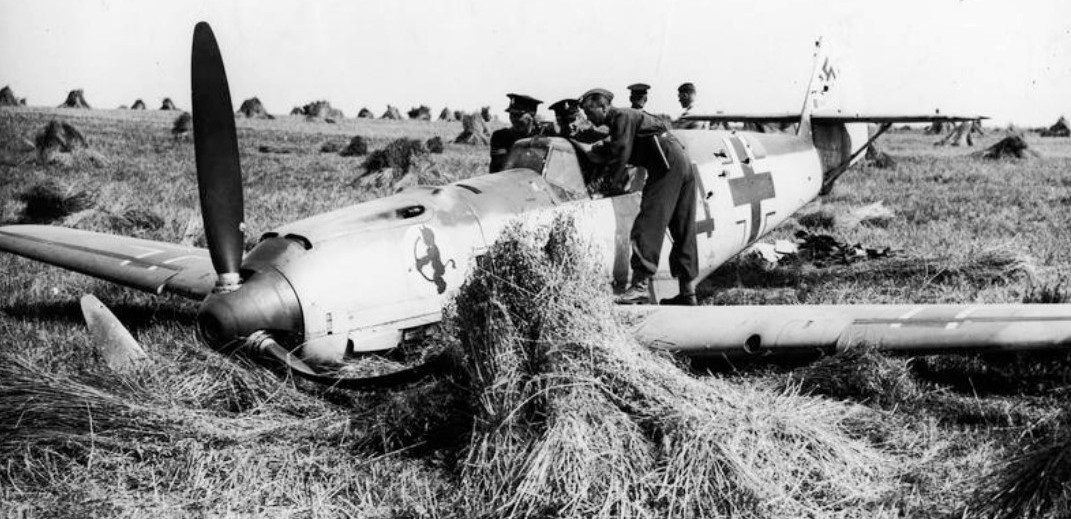
A Messerschmitt 109E shot down in mid-August while in combat over Hastings.
1940 Aug - The Hastings Observer launched an appeal to raise £5,000 to buy a Spitfire; the money was donated within a month.
1940 Sept - The RAF Fairlight radar station became operational. It was located at today’s picnic site, on the north side of Fairlight Road, adjoining Martineau Lane. It was to remain an RAF Domestic Camp (living base) for many years.
1940 Sept 11 - Voluntary evacuation of the town began, and over 20,000 people went. Within days, the population of Hastings had fallen to 22,000 (pre-war it had been 65,000).
1940 Oct 14 - The first anti-aircraft guns were set up in the town.
1941 Dec 8-13 - A Dig for Victory Week exhibition was held at the White Rock Pavilion by Hastings Council in co-operation with the Ministry of Agriculture to encourage all garden holders to grow food and to recruit an extra allotmenteers in the borough. Similar exhibitions were held each autumn for the next three years, with the 3-day event in 1944 attracting 5,000 people. By June 1942 there were about 500 wartime allotments.
1942 Sept 22 - By this day 2,714 Morrison steel table air raid shelters had been issued to local houses, nearly all of them free of charge.
1943 March 11 - The heaviest attack of the war took place, with much destruction over a wide area caused by about 20 aircraft using machine guns and dropping 25 bombs. There were 39 deaths and 90 people injured. On this day Hastings councillors were told that between 230 and 250 people had slept in St Clements Caves over the last month, but no one was 'residing' there.
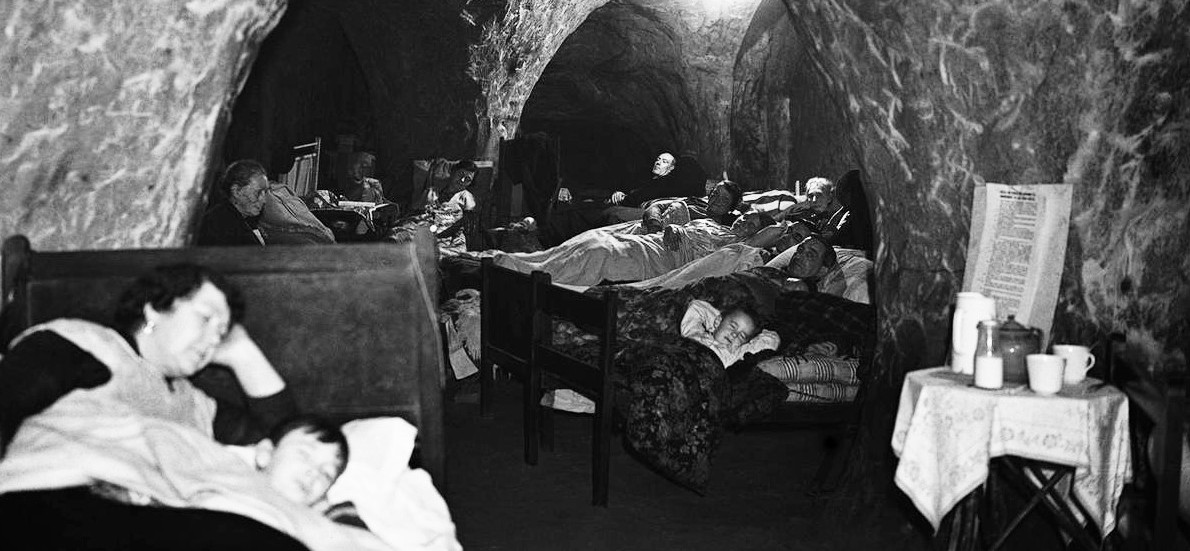
St Clements Caves being used as a bomb shelter.
1943 March 17 - The Hastings fishing boat EVG RX 152 was blown up by a mine picked up in her trawl in Rye Bay. Her crew survived. But the three crew of the Boy Billie RX 61 were killed in the fishing fleet’s worst tragedy of the war when the boat was hit by a mine on 10 April 1943. The crew were lifeboat coxswain Ned Muggridge, Dave Coussens and Charles Page.
1943 March 31 - The Hastings lifeboat the Cyril and Lilian Bishop performed probably the most difficult rescue in her career, apart from Dunkirk, when 296 ton minesweeper HMS Caulonia ran ashore in a gale at Jurys Gap, on the Kent/Sussex border. The seven crew were rescued in a difficult and dangerous operation by the Hastings crew. The Caulonia rescue brought RNLI bronze medals for gallantry to Coxswain Ned Muggridge and mechanic Bill Hilder, thanks-on-vellum to second coxswain Ned Adams, bowman Fred White and lifeboat secretary Commander Highfield. Tragically, neither Muggridge nor Hilder lived to receive their medals. Muggridge and another lifeboatman, Dave Coussens, were killed with Charles Page when their fishing boat the Boy Billie RX 61 was blown up by a mine on 10 April 1943, just 11 days after the Caulonia rescue. This was the fishing fleet’s worst tragedy of the war. Caulonia was Muggridge's first and only trip as coxswain. Ned Adams succeeded him as coxswain. Bill Hilder, widely known for the very high quality model boats that he made, was killed on 23 May 1943 when an air-raid bomb destroyed the Swan Hotel in High Street.
1943 April - Hastings Council decided to lay on a water supply to all allotment fields to help grow food.
1943 May 23 - In the second heaviest wartime attack, at least 25 people were killed and 85 injured. The Swan Hotel in the High Street and the Albany Hotel in Robertson Terrace were both destroyed.
1944 Feb 4 - Field Marshal Montgomery inspected troops at the Pilot Field in preparation for the D-Day invasion of Europe.
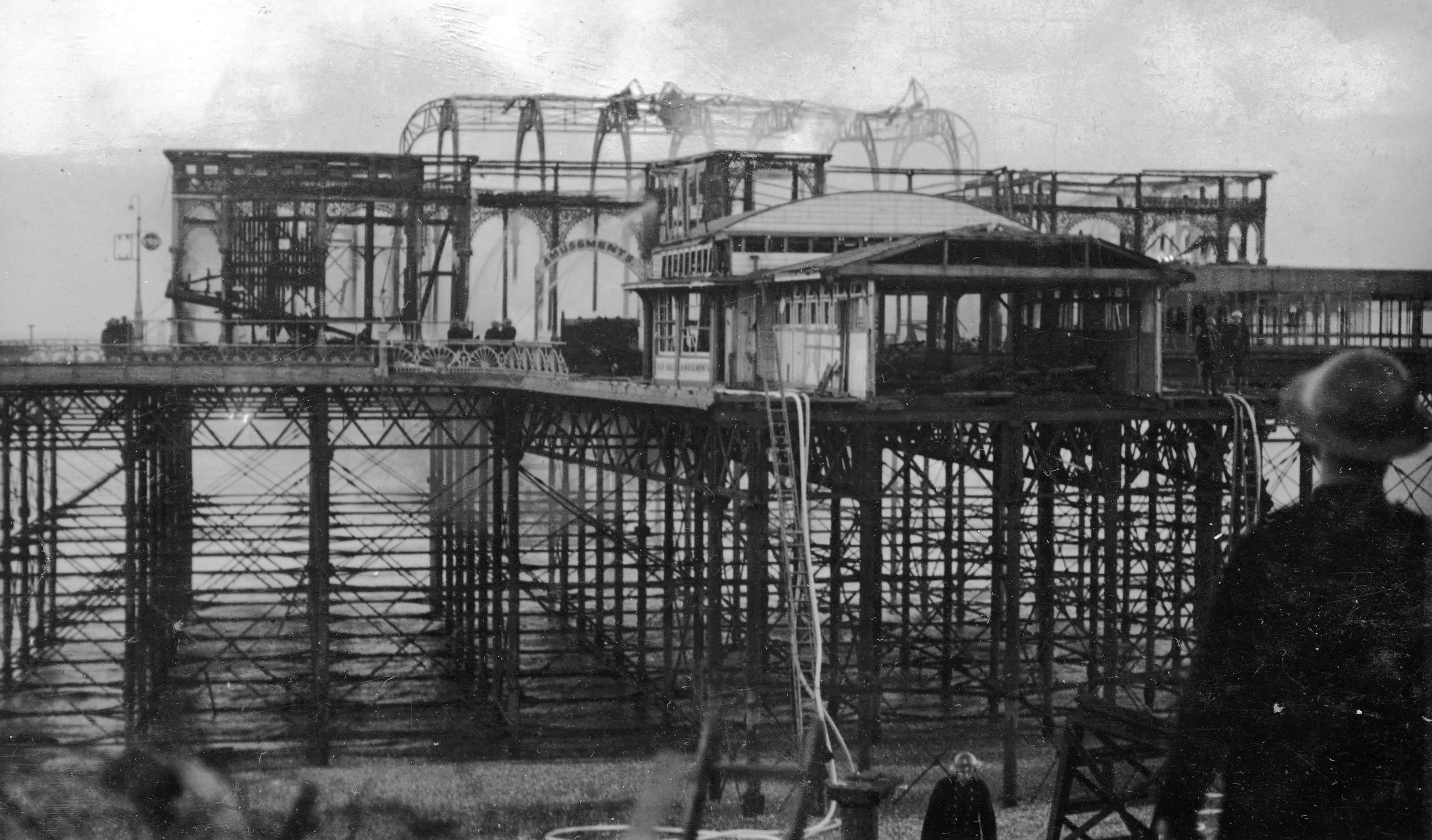
St Leonards Pier on 7 March 1944.
1944 March 7 - The shore-end of St Leonards Pier was seriously damaged by fire, destroying its pavilion and surrounding buildings. It had also suffered gale damage in early February 1943 and was hit by bombs earlier in the war. The pier owners never attempted to restore it and It never re-opened after the war.
1944 March 12 - The highly respected local artist E Lelsie Badham was killed when his house in Priory Road, opposite Emmanuel Church, was hit by a high explosive bomb. The last bomb to fall in the town was on 27 March 1944, landing at the bottom of Filsham Road.
1944 June 15 - The first flying bomb was brought down in the Hastings area, east of Glyne Gap. Another 14 flying bombs came down in the area in the following weeks, the last being on 2 August. Most fell on open ground. Five batteries of heavy anti-aircraft guns were set up, including at Sea Road, the Oval and the East and West Hills. One of the Auxiliary Territorial Service officers at the West Hill battery was Mary Churchill, daughter of the prime minister Winston. St Leonards Parish Church was destroyed on 29 July. One fell on Shearbarn Farm on 20 July, killing the occupant, Miss Ethel Maria Barnes, the last person in the borough to die as a result of enemy action. The last flying bomb incident was on 2 August. The last alert was sounded at 7.15pm on 9 November 1944.
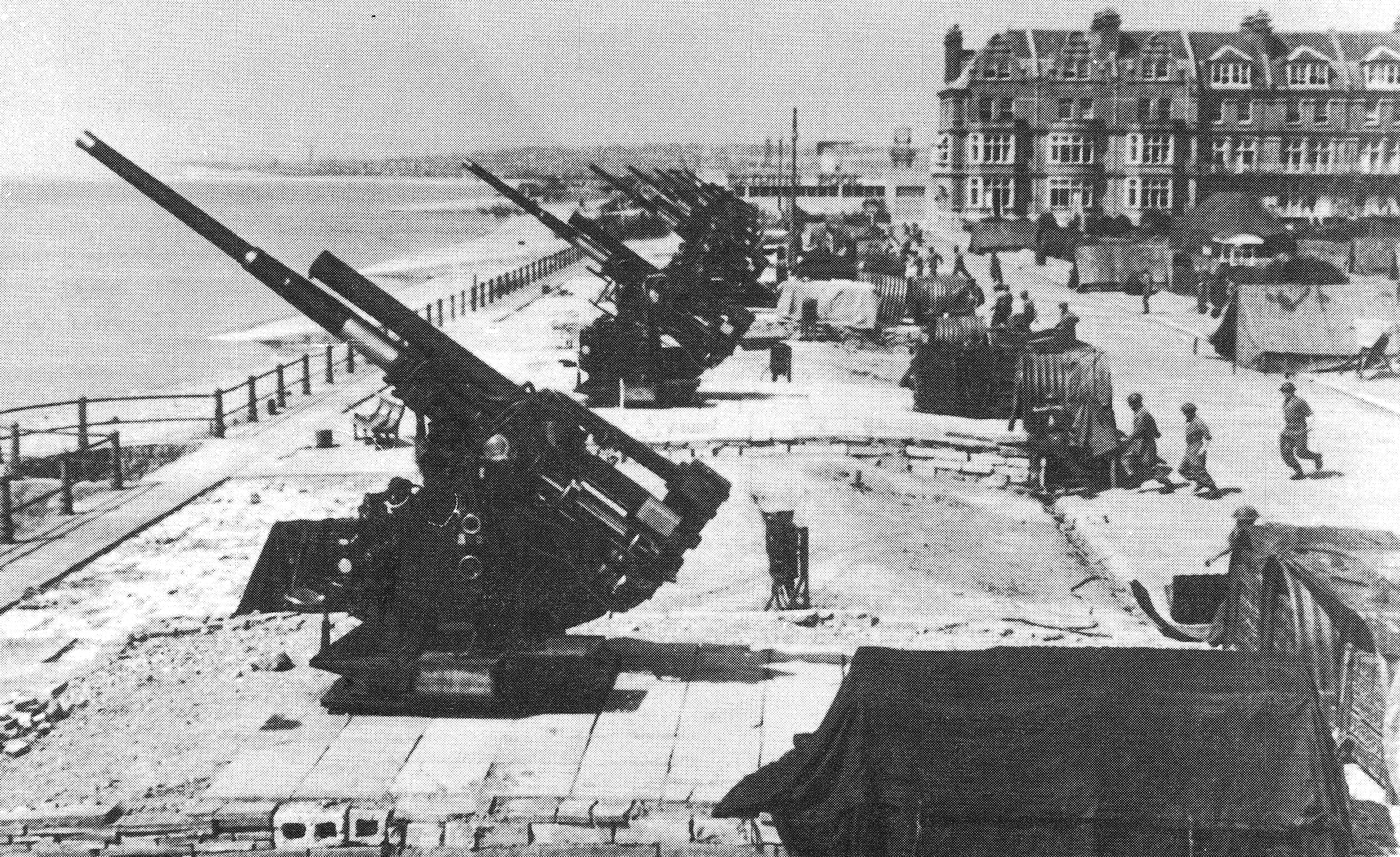
Anti-aircraft guns set up in Sea Road in July 1944.
1944 Autumn - Many of the wartime restrictions were lifted. The last alert was sounded on 9 November.
1946 Early - The Royal Victoria Buildings, the row of shops on the promenade opposite the Royal Victoria Hotel, were demolished.
1946 June 8 - The inland end of Hastings Pier reopened for the first time since 1940, following the replacement of the 10 yards of the parade extension’s decking which was removed in that year. The sea-end of of the pier reopened in the summer of 1947 following the rebuilding of the 25 yards of the mid-pier which had been taken away in 1940.
1946 Nov - A large part of the harbour arm collapsed, leaving a 36 feet wide gap in it close to the seaward end.
1947 May 9 - A legal agreement - called the ‘Deed of Compromise’ - was signed by Hastings Council and the Hastings Fishermen’s Society giving the fishermen certain limited rights to occupy some of the Stade, but in return they allowed the Council to do what it wanted on the rest of the beach. The east end of the Stade became Rock-a-Nore car park, and an open-air amusements centre opened near the Lifeboat House.
1947 June 23 - Fire destroyed the large Elite Cinema (the former Royal Concert Hall) in Warrior Gardens, in one of the biggest and most spectacular fires in the history of the town. Flats were later built on the site.
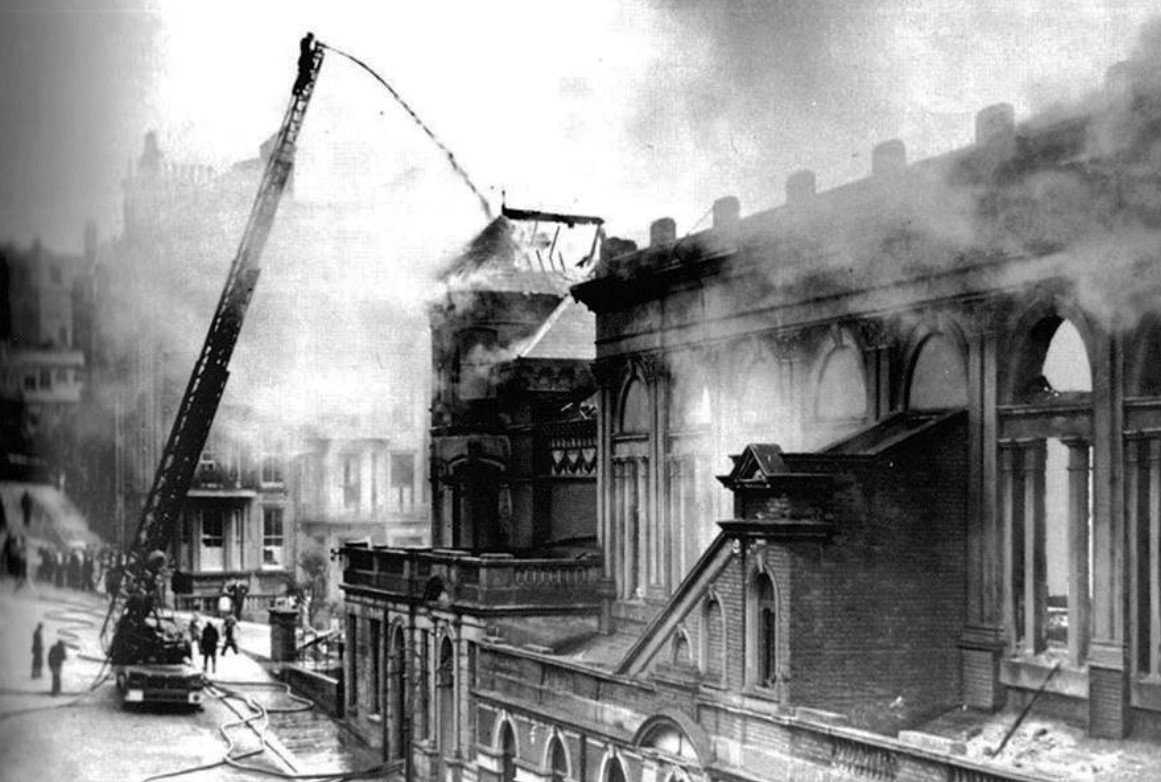
The fire at the Elite Cinema.
1947 Oct 14 - A wartime underground resistance HQ was found in Beauport Park after some ground subsided.
1947 Dec 1 - Death of the sinister character Aleister Crowley at Netherwood, on the Ridge.
1947-48 - A large estate of council houses was built in Rock Lane, using prisoners of war as labourers.
1948 June 5 - Opening of the Hastings Miniature Railway line along on the beach by the Fishmarket. The HMR is one of the oldest 10¼-inch gauge railways in Britain. It was set up by the railway entrepreneur Captain John ‘Jack’ Howey who built the 15-inch gauge Romney, Hythe and Dymchurch Railway in 1927. He also had a great interest in miniature railways and in 1947 he opened a short track at Grosvenor Gardens in West St Leonards. But there were complaints from local residents, so Howey moved the line to an unused piece of beach at Rock-a-Nore, where it is based today. There he built a station, plus a tunnel where he could store the train. Initially the track only went to where the lifeboat barrier is today, but by the mid-1950’s it had been extended a hundred yards west, where a mini-station with a turntable was built (its platform still exists). In 1959 the line was extended again, along the beach to a new station at the west end of the boating lake.
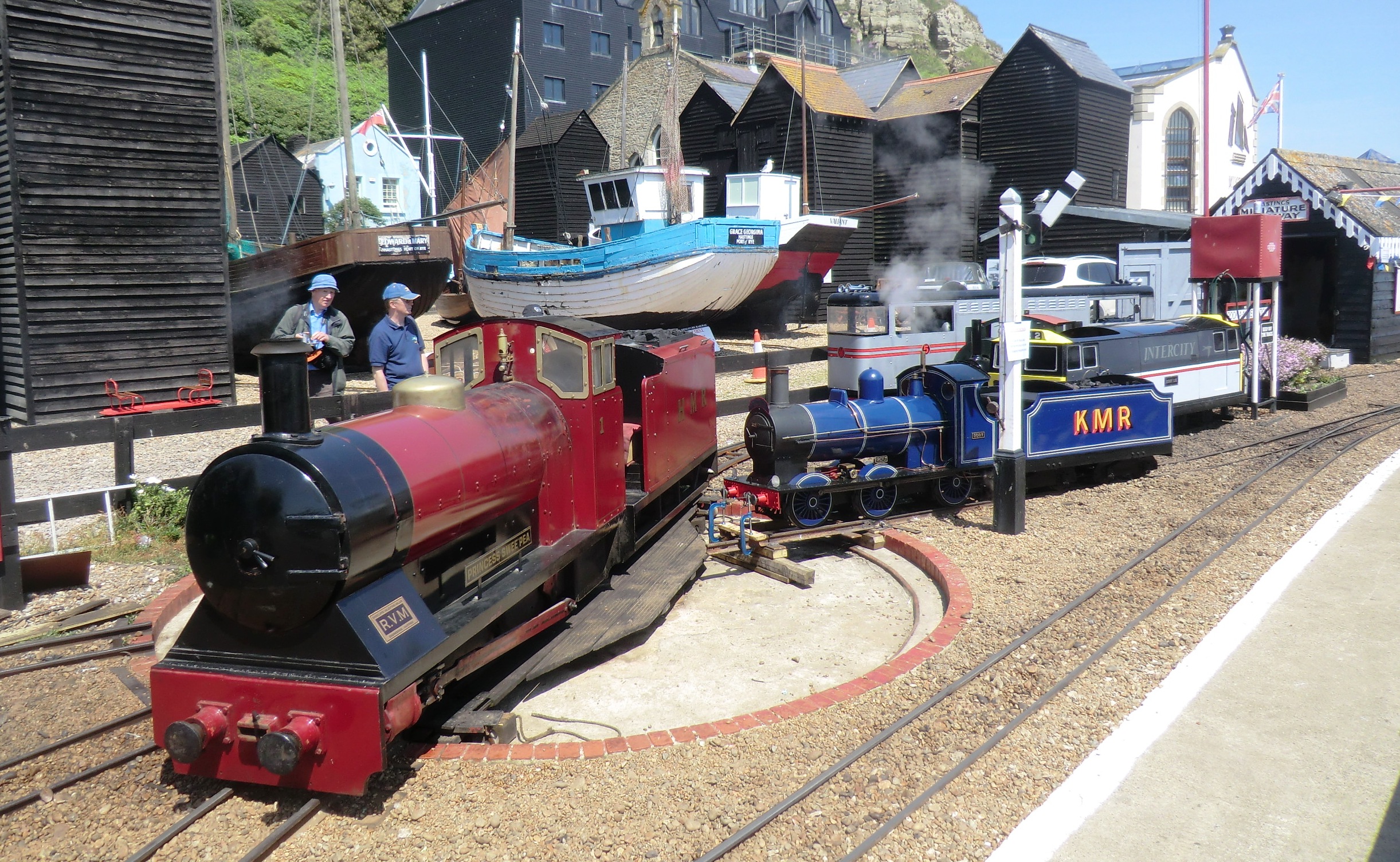
The Hastings miniature Railway in 2013.
1948 April 21 - A motorcycle speedway track opened at the Pilot Field. The racing immediately became the most popular sport in the town, attracting up to 10,000 fans at a time. But the noise and dust from the cinder track annoyed nearby residents, and Sussex Assizes granted them an injunction banning Hastings Council from running the speedway. Its last meeting was held on 5 October 1949.
1948 July 14 - The mayor officially opened the Hastings Aerodrome laid out by Hastings Council at Pebsham, where the football pitches are today next to Pebsham tip. The first take-off was an Auster Autocrat. It had been an aerodrome site, used occasionally, since the 1930s. A 14-year lease was granted to the Hastings and East Sussex Air Service on the understanding that it would be a small-scale airfield capable of being used by aircraft carrying eight passengers. But the company went bust in July 1950, and the airfield was used by a succession of operators until it closed in 1959.
1948 Aug 27 - The Poor Law Institution and Municipal Hospital in Frederick Road were renamed St Helens Hospital, under the control of the Ministry of Health, following the creation of the National Health Service on 5 July 1948. St Helens, and other local hospitals, was replaced by the Conquest in 1992, with the last patients moving out in March 1994. By early 1998 all the hospital on the west side of Frederick Road had been demolished, save for the two gateposts. Much of the 1837 workhouse on the east side has survived and is now housing.
1949 Feb 8 - Mrs Annabel Farnfield MBE became the first-ever female mayor of Hastings. She was a councillor from 1938-63. She died on 4 April 1970, aged 81.
1949 March 2 - The former Town Hall in the High Street, which for many years had been a second-hand furniture store, re-opened as the Museum of Local History on the ground floor and a branch of the Claremont public library on the upper floor. The museum took over the whole building in July 1959, but it was closed by the Council in 2014.
1949 March 31 - The Hastings fishing boat Pioneer RX 255 ran on to the Hooks Ledge rocks under the cliff at Fairlight in a thick fog. The lifeboat Cyril and Lilian Bishop and the Coastguards were unable to find the vessel, even though the three crewmen could be heard, and they all drowned. This was the biggest tragedy to hit the local fishing community for many years.
1949 May 9 - The 1,000th council house was opened by the mayor, on the Rock Lane estate.
1949 June 6 - A border of smelly flowers for blind people was opened in St Leonards Gardens. A railing alongside the border had Braille messages on it describing each flower. The Quarry Hill Blind Home, next to the Gardens, had re-opened in July 1948 after being bombed on 24 September 1942.
1949 July - Work started on building the new Lifeboat House, an unattractive shed on the beach near the harbour arm. It was completed in December 1949, after which the well-designed 1882 house opposite the Cutter pub was let to sea scouts until 1959, when it was demolished as part of a road widening scheme.
1949 July 12 - Hastings Council gave planning permission for farmer Frederick (‘Freddy’) Funnell to use some of his land at Shearbarn Farm in Barley Lane for camping for three years. This was the beginning of his conversion of the farm into a major caravan and camping site over the following years.
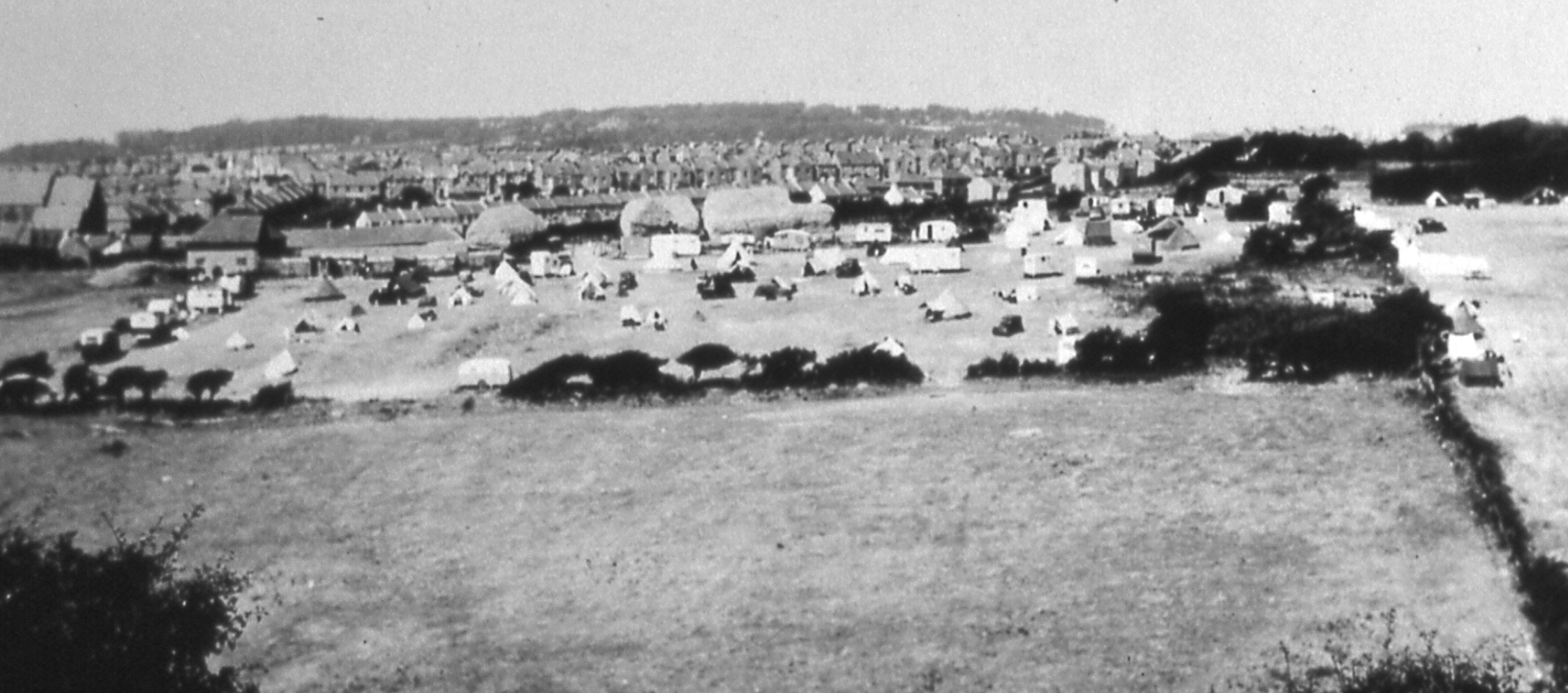
Freddy Funnell's camp site in August 1949.
1949 Oct 20 - The heaviest storm for many years caused major flooding in the town centre.
1949 Dec 7 - The new Fairlight Village Hall, at Fairlight Cove, was officially opened
